

10 Epic Spain Road Trips - Maps, Itineraries and Tips
Want to experience an amazing Spain road trip but not sure where to go? Choose from these 10 stunning routes for your road trip in Spain with our guides, detailed itineraries and insider tips.
Whether you're looking to relax in the mountains off the Costa del Sol, navigate the narrow streets of Toledo or take a stroll down Barcelona's Las Ramblas, we can help you plan the perfect Spanish road trip for you.
Best Spain road trips comparison
We have driven up and down and across Spain a lot of times over the past 15 years. Before we dive into the ideas, here's the complete list of the best road trip routes with key information. Scroll down to see more detail on each one.
Whether you want a relaxing drive along the coast or drive around the entire country of Spain, here are the 10 amazing options for a Spain road trip to pick from.
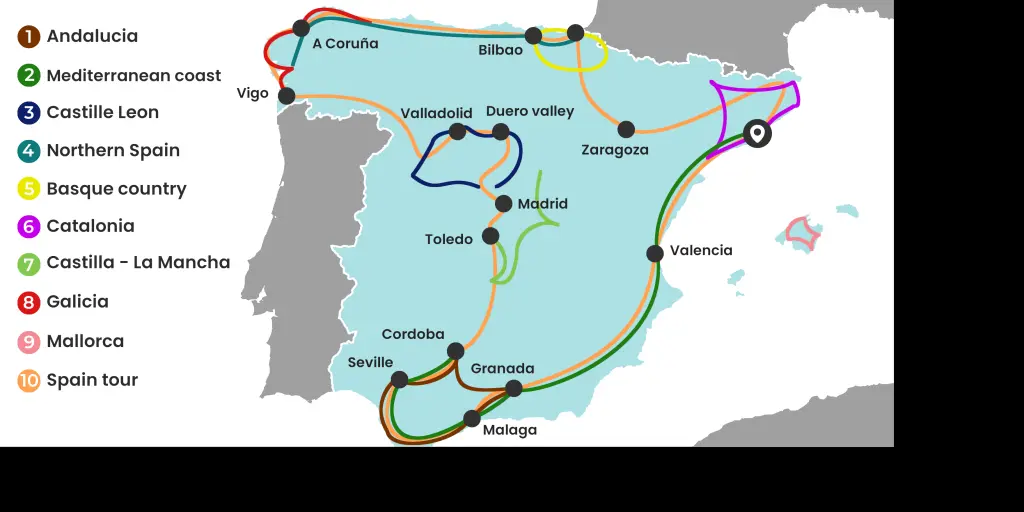
1. Andalucia road trip
A perfect way to explore Spain is to drive around Andalucia . If you love the sun, beaches and perfect mountain hideaways overlooking the sea, Andalucia is the place for you.

If you are more into culture and love grandiose cathedrals, medieval fortresses and jaw dropping architecture, Andalucia is also a place for you.
If, however, you just want to walk around historic towns and love traditional hearty Spanish food, you guessed it - Andalucia is your perfect destination.
The perfect Andalucia road trip will take you on a loop including coastal destinations such as Nerja, Malaga, Marbella, Gibraltar and Cadiz before going inland to discover Ronda, Seville, Cordoba and Granada.

This drive will scale mountains with breathtaking views and take you to the mesmerising Mezquita cathedral in Cordoba and the unique Moorish Alhambra complex in Granada.
You'll relax in the world famous Andalucian white villages of Mijas, Benahavis and Casares and mingle with new money in Puerto Banus' marina full of expensive supercars, people with too much plastic surgery and the world's biggest yachts.
Road trip length: 11 days
Total distance: 518 miles
2. Drive Spain's Mediterranean coast
Spain's Mediterranean coast is perfect for a Spanish road trip - just make sure you put sun screen on your left arm if you're driving - the sun gets hot!

Start your road trip with a mini-break in Barcelona where you can visit sights such as La Sagrada Familia, Las Ramblas and unique buildings designed by Gaudi. There are few cities that offer as much as Barcelona so it's a perfect start to the Mediterranean coast trip.
Next leg takes you south to Valencia - a seriously underrated Spanish city that offers culture, food and sunshine aplenty with an amazing historical centre.
Once you've crossed over the Sierra Nevada mountains, your trip continues to Granada, Costa del Sol, Seville and Cordoba.
You will do an abridged version of the Andalucia road trip above, but get a much broader view of Spain having driven from one corner to another.
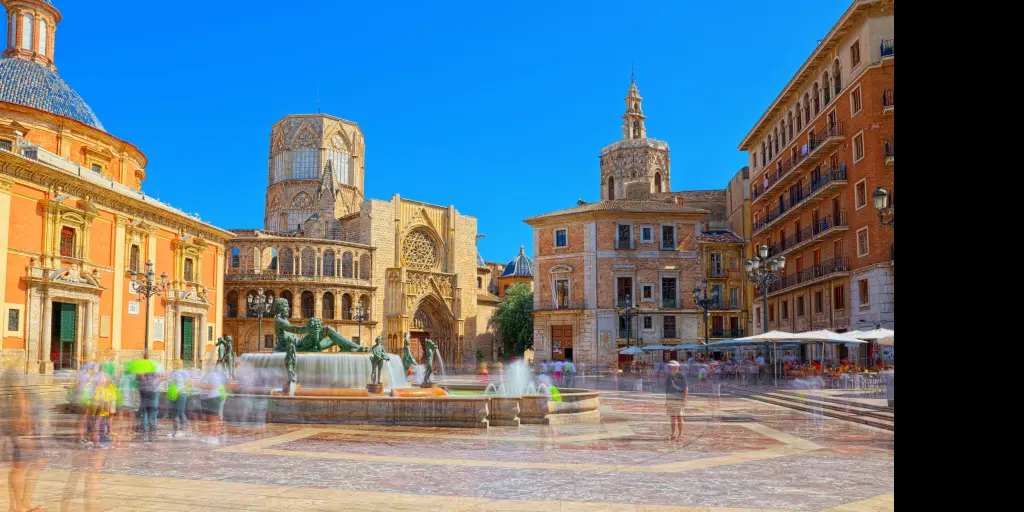
Hugging the coast for virtually the entire trip means that you are always a few minutes away from a beach - something that can provide welcome distractions on your way.
This road trip is a perfect mix of culture and relaxation so if you want to blend the two, give it a go. You will see the world's finest architecture in Barcelona, La Mezquita in Cordoba, the Seville Cathedral and Granada's Alhambra fortress but have time to relax in Puerto Banus, lay on the beach in Nerja and roam the narrow streets of Andalucian white villages.
Road trip length: 14 days
Total distance: 1,385 miles
3. Castille Leon - visit the heart of Spain
If you're flying in and out of Madrid, the Castille and Leon road trip can be an amazing way to explore Spain without having to drive all the way to the coast or spend weeks on the road.

This road trip through Spain's heartland comes in a loop that starts and ends in the Segovia province.
You will start in the historic city of Segovia itself - famous for some of Spain's best architecture and declared a UNESCO World Heritage site.
After a day of exploring, the route heads west towards Salamanca via Arévalo. Arévalo is a small historic town famous for its Mudejar architecture and art giving it a special protected status in Spain and Salamanca is an ancient city with two cathedrals - the New one (it is actually called that) began construction in 1513!
From Salamanca, you can check out other beautiful historic towns of Ledesma and Zamora before a stop in Valladolid - the assumed capital of the Castille and Leon province. Its medieval history can be seen throughout the city - the Spanish Monarchy even made Valladolid their home in the 17th century!
After a visit to the city that shares its name with the Castile and Leon region, the trip ends with a drive through the Ribera del Duero wine region - hugely underrated relative to Rioja and the Portuguese Douro wine further down the same river valley.
The end of the trip gets you to Pedraza back in the Segovia province before taking a short drive back to Madrid's airport.
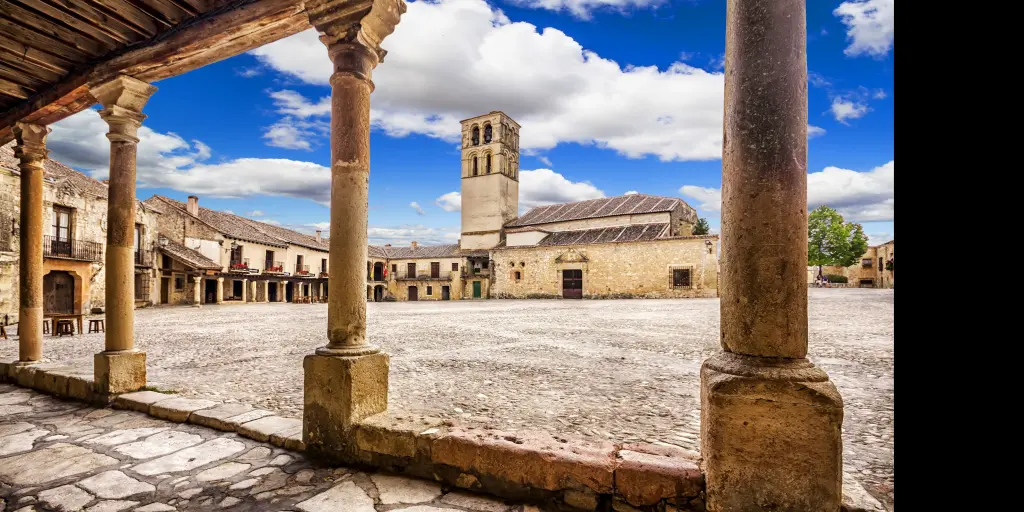
You can extend this road trip to include the historic Spanish cities of Leon and Burgos in the north of the province, but that will add a lot of mileage and time to your trip and southern Castille and Leon has a huge amount to see already - you can easily spend 2 weeks exploring this part of Spain and see new places every day.
Road trip length: 7 days
Total distance: 345 miles
4. Northern Spain road trip
So often overlooked in favour of Costa Brava, Costa del Sol or Costa Blanca, Spain's northern coast makes for an amazing road trip exploring the mix of cultures, fantastic food and rocky shore scenery.
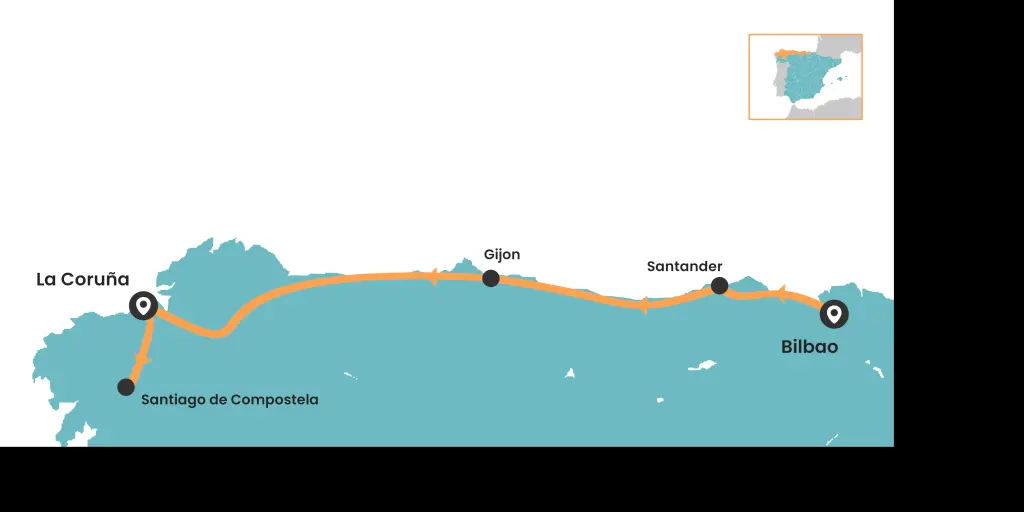
The road trip starts in the capital of Spain's Basque country - Bilbao. This is a place worth spending a couple of days in to explore its old historic centre, the surrounding mountains and the spectacular world-famous Guggenheim museum.
There is something for everybody in Bilbao with superb pintxos in street bars and michelin-starred restaurants, medieval streets and modern boulevards.
The road trip then moves west along the coast to Santander, before further stops in Santillana del Mar, the Picos de Europa national park and Gijon.
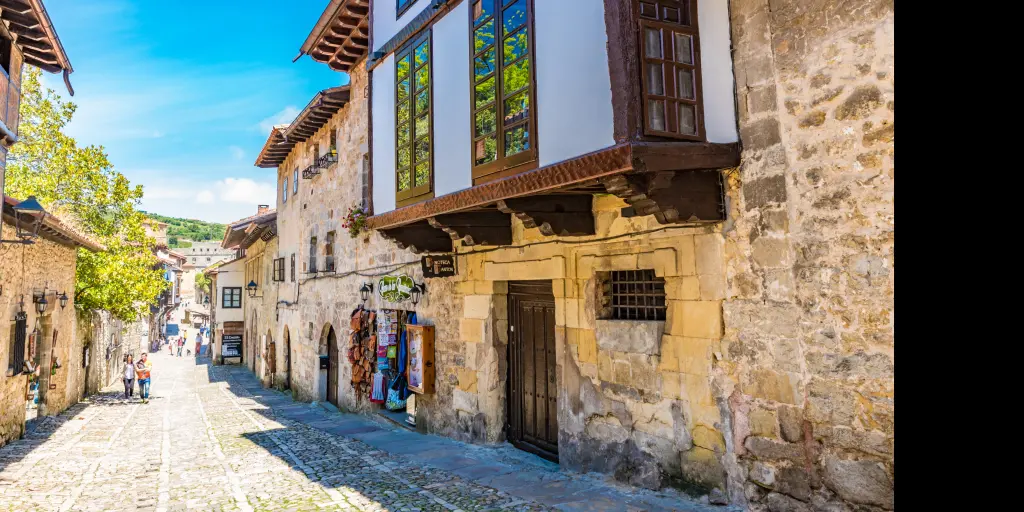
This trip includes a mix of beaches, historic Spanish cities and exploring nature - a perfect mix for a Spanish road trip!
Once you've hiked amazing gorges and filled yourself with pastries, it's time to hit the road and drive on to Oviedo and La Coruna.
Finishing off with a day trip inland to Santiago de Compostela, you will travel the entire length of Spain's Bay of Biscay coastline with everything to see along the way.
Depending on your flights, you might have to do a drive back along the coast to Bilbao or down to Porto or Madrid - this is one heck of a trip that you won't find in many recommendations or guides!
Road trip length: 10 days
Total distance: 737 miles
5. Basque country and Pyrenees
Spain's north-west corner lying on the Bay of Biscay and bordering France is full of history, tradition and... mountains.
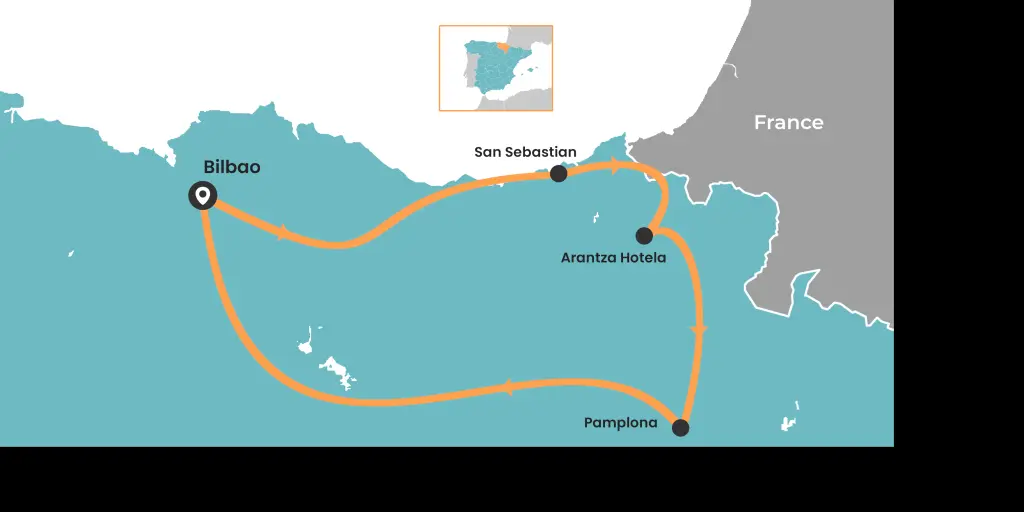
The Basque country is a unique part of Spain - they have a prominent local language, cities that make up two prominent medieval kingdoms (Basque and Navarre) and a unique link to the Pyrenees. In medieval times, Basque country spanned the mountain range, including parts of France on the other side.
Today the region fervently focuses on its culture. As you travel in major cities such as Bilbao, San Sebastian and Pamplona, you will get to try the local pintxos tradition. In some ways similar to tapas popular in the rest of Spain, pintxos are smaller bite-size snacks served in bars and charged by number or by plate.
If you get out of the tourist areas, you will find local pintxo bars where the snacks are free as long as you keep buying the drinks!

The Pyrenees are an amazing mountain range that is not high on many tourists' radars.
Often overlooked in favour of trips to the Alps or even Sierra Nevada further south in Spain, the Pyrenees are an older mountain range with a lot of peaks over 3,000m above sea level.
The roads through the Pyrenees are fantastic and can make for really great road trips with the added bonus of hardly any other cars as you drive around. There are some fantastic hotels if you want to really relax and go off the grid for a few days - we have stayed at The Arantza Hotela in the foothills of Pyrenees and cannot recommend it highly enough - it is expensive but super luxurious and worth it!
A small number of rooms have stunning views of the surrounding hills with morning fog climbing towards the peaks and you can relax in a jacuzzi looking out over the landscape before having an amazing dinner in the hotel's gastro restaurant.
After a few days of luxuriating, it's time to drive down from the mountainside and make your way to Pamplona - a historic city famous for its July bull running festival has far more to offer than the medieval tradition. Narrow streets, beautiful stone buildings and fantastic local coffee shops are great for unwinding in late morning.
The drive back to Bilbao airport is a little under 2 hours to get you back home!
Total distance: 240 miles
6. Driving tour of Catalonia
There is a whole lot more to Spain's Catalonia region than Barcelona. You can spend weeks travelling around the area and still not see dozens of amazing villages, secret beaches, mountain waterfalls or quirky museums.
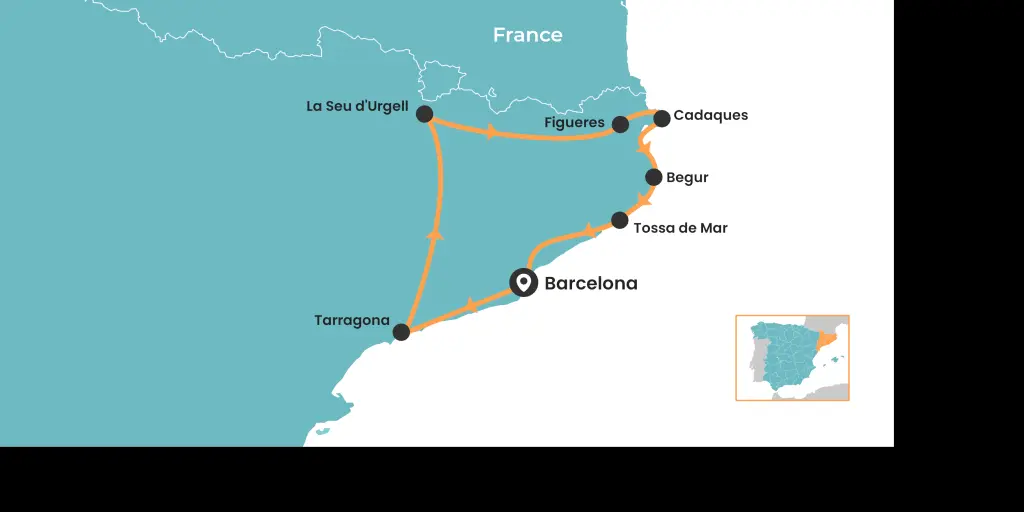
If you want to base yourself in Barcelona, instead of going on a road trip, check out our 40 day trips from Barcelona for inspiration on where you can get to!
A great route around the region can start and end in Barcelona to make it easy with flights.
From Barcelona, head south along the coast to Tarragona with a stop in Sitges and the option of relaxing in one of a few great beaches along the way.
From Tarragona, this trip goes inland towards Montblanc and all the way to La Seu d'Urgell in the Pyrenees via Solsona.
On your route across the north of Catalonia, you are spoilt for choice with the Garrotxa volcanic national park and the village of Santa Pau worth visiting, a detour into Andorra and towns like Besalu and Castellfollit de la Roca all great options before you arrive in Figueres.
After some cultural sightseeing, head on to Cadaques on the coast - there are some great beaches and a Salvador Dali House Museum.
The rest of the road trip follows the Costa Brava back down to Barcelona. There are tonnes of great places to stop including Roses resort, the canals of Empuriabrava, L'Escala and Begur. A drive inland to Girona is optional before you make it down to the relaxation end of the journey with beach stops in Tossa de Mar and Lloret de Mar on the menu.

There are few parts of the world which have so much to see in such a compact region both culturally and in nature. If you love the mountains, hiking and being off the beaten track, a road trip around Catalonia is definitely the best choice in Spain.
Road trip length: 9 days
Total distance: 520 miles
7. Historic central Spain - Castilla-La Mancha
Castilla - La Mancha is one of the largest regions of Spain and also one of the least well known by tourists.
Hidden away in plain sight right next to Madrid, it stretches almost as far as Valencia and Murcia in Spain's south east.
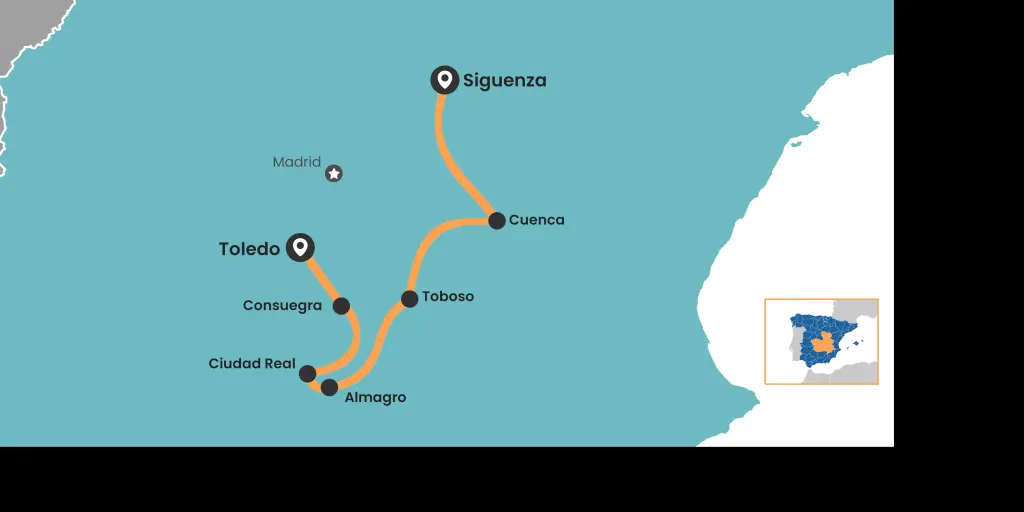
Exploring this region brings a mix of natural sights and beautiful historic Spanish cities. As with the Castille Leon trip, it's easy to start and finish in Madrid if that's where you can get easy flights to.
This Spain road trip starts in the most famous city in the La Mancha region - Toledo. Toledo is famous as a blend of Christian, Muslim and Jewish religions and cultures. It was the capital city of the Visigoth Empire, Spanish Moors and later of Spain at some points during the course of history.
After a couple days of sightseeing, it's time to hit the road and head on south to Ciudad Real via Consuegra and Daimiel.
There is a lot to see in this part of Spain including the infamous windmills made famous by Miguel de Cervantes' Don Quixote. The majority of the region is set on a plateau with occasional barren hills.
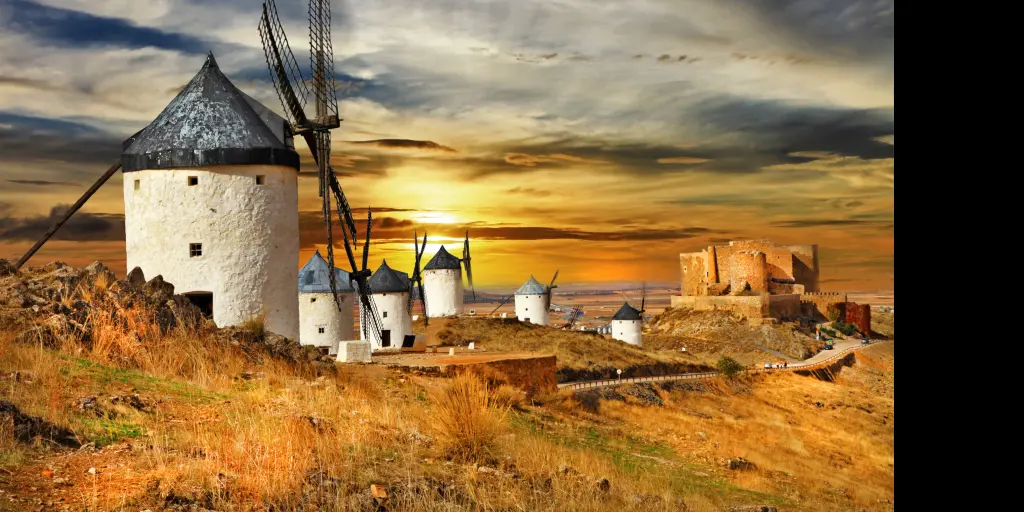
The trip continues east to Cuenca and Siguenza - both stunning towns but in completely different ways and both very different from a lot of typical Spanish destinations.
If you're feeling adventurous, there are a number of national parks on the way where you can stretch your legs on a hike or just take a scenic detour.
Total distance: 380 miles
8. Galicia road trip
Getting to and from the region can be tough so you might have to adjust the route depending on where you're travelling from.

The plan with this road trip is to go all the way round the Galician coastline starting from As Catedrais beach. If you don't know it by name, you've definitely seen pictures of giant rocks and archways on the sandy beach before.
Although this trip is only 5 days long, you'll spend a few of these driving along small coastal roads. Our tip is to ignore the navigator which will send you inland along faster roads. Keep the sea to your right as you go and you're unlikely to go too far wrong.
After passing the Vixia Herbeira cliffs, you'll arrive in A Coruña. Other than the Hercules Tower, the main sight here is the light house. Naturally.
Take a day to see the city and its surroundings - seafood here is amazing as it's a functioning port supplying much of the region and beyond.
The trip then continues around the coast to Santiago de Compostela. You can take the direct short cut but you will miss out on a whole lot of stunning scenery, ocean-facing cliffs and spectacular locations for light houses - on the shoreline, on cliffs and even on their own islands.
After exploring the historic and religiously important city, the route goes back towards the coast and passes Pontevedra on the way to the pretty town of Vigo.

This might not be so much of a Spanish road trip as a gentle breeze along the coast (and there will be a lot of breeze!), but it's definitely one to keep in mind if you want to unwind and keep yourself away from the tourist traps around Spain.
Road trip length: 5 days
Total distance: 322 miles
9. Road trip around Mallorca
Many don't associate Mallorca with a road trip, but the island has a huge amount to offer beside the beaches and clubs.
Flying in and out of Palma means that's a great place to start and finish your trip.
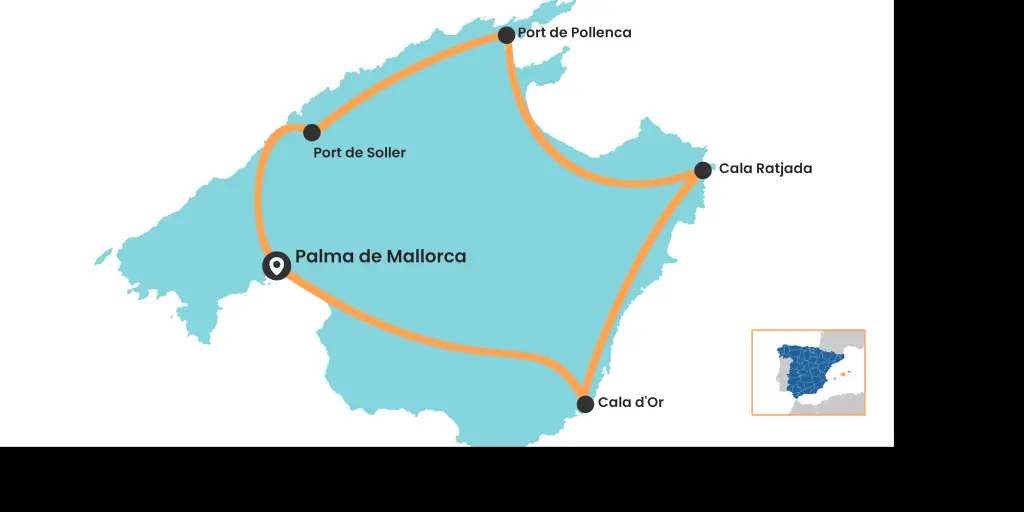
Palma is the capital and often overlooked by visitors who go straight from airport to their preferred corner of the island. The city actually has a lot to offer so it's great to spend the first or last night here depending on your flight times.
Make sure you check out the huge Cathedral (you really can't miss it) and the part of the city around the market (only open in the morning).
Once you set off, the best way to see the island is to drive all the way around.
Start by heading along the narrow cliff roads along the coast to Valdemossa and Soler - the two very popular destinations to the north of Palma. After that the road trip continues all the way to Port de Pollença before heading across the island to Cala Mesquida.
Once you've navigated the tourists, a short drive down the coast takes you to Cala Agulla where the beaches are empty and the sun is just as hot for some relaxation.
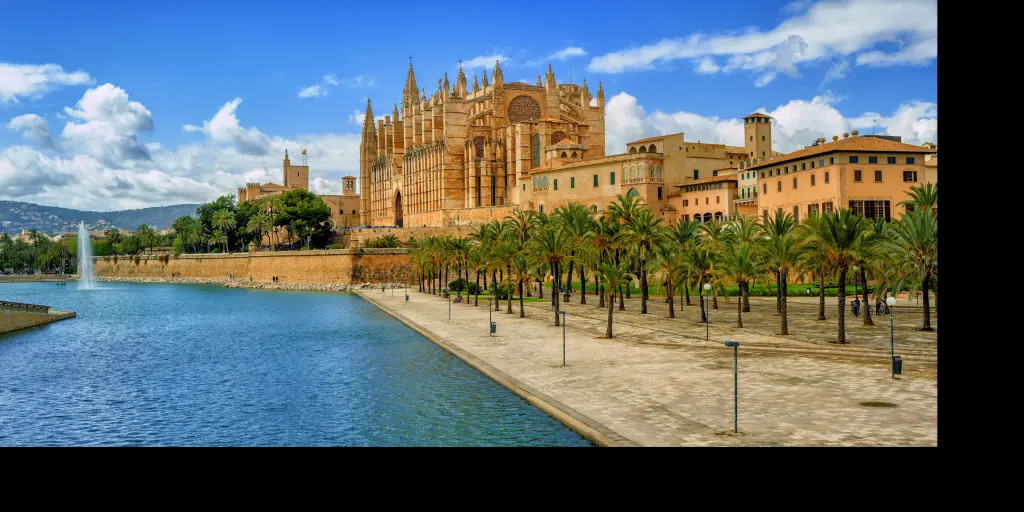
To wrap up the trip, you've got to stop off at the resort town of Cala d'Or before making your way back to Palma.
A short trip with a lot of breathtaking views and cliffs in the north and resorts with fantastic beaches on the south can be the perfect way to unwind on a short break!
Total distance: 175 miles
10. The full circle - A complete road trip around Spain
If you have time on your hands and feel adventurous, a road trip around the entirety of Spain can be an amazing way to delve into the culture, see all the corners of this amazing country and really get immersed.

One key disclaimer is that while this one sits high on our list of bucket list trips, we haven't actually done the full trip - it's a long drive!
But if you're brave enough, you can start wherever along the route you like as you it goes in a loop.
Barcelona and Madrid are likely to be the best hubs for getting in and out of Spain and the route cycles down through Valencia to an Andalucian tour before heading back north from Cordoba.
After exploring central Spain with stops in Toledo and surrounding towns and a tour of Madrid, the drive continues into Spain's Duero valley, Valladolid and on to Galicia's Vigo, Santiago de Compostela and A Coruna while taking in breathtaking views of ocean-facing cliffs and huge waves.
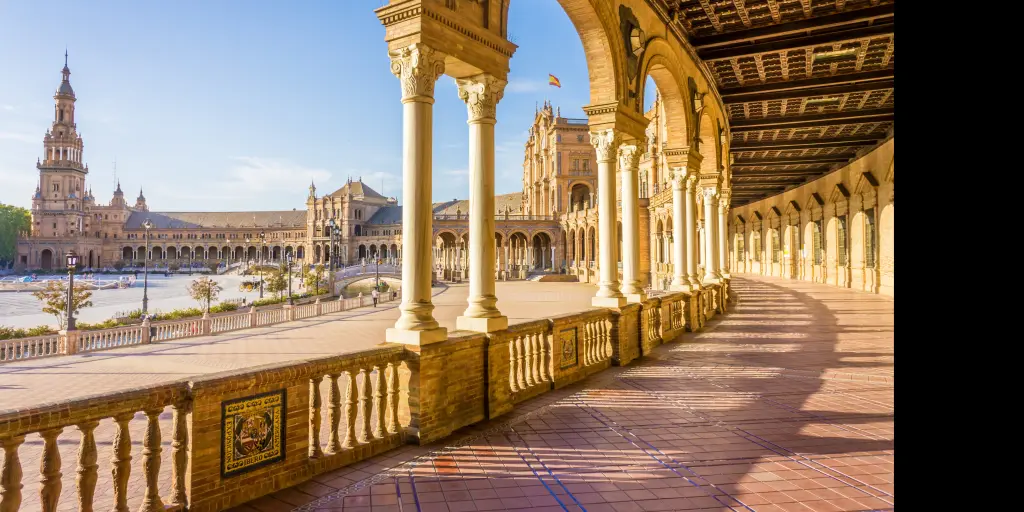
The trip continues along the north coast stopping off at Santander, Bilbao and San Sebastian before detouring off into the Pyrenees and the historic cities of Pamplona and Zaragoza. A mini Catalonia tour to end the trip wraps up the route that will take at least a month to complete if you want to do things other than driving.
If you do end up doing this one, please let us know! We'd love to see how you get on!
Road trip length: 35 days
Total distance: 2,800 miles
Join our email list!
By joining our email list, you give LazyTrips permission to use your email for sending you newsletters, emails and updates including for marketing purposes. Your email will not be provided to third parties.
Related posts
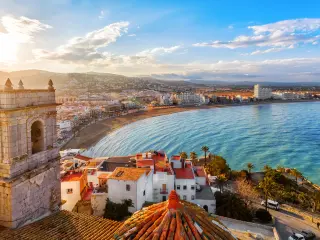
Wander-Lush
The Ultimate Spanish Road Trip Itinerary: Barcelona to Seville
Plan your dream road trip through Spain with this epic Spanish road trip itinerary! I’ll show you how to spend a perfect 3 weeks in Spain travelling from Barcelona to Seville, plus everything you need to know about renting a car to self drive in Spain.
I was part-way through planning a six-week Eurotrip with my partner when I became fixated on visiting Spain.
Spain had never really factored into my travel plans. But as soon as I realised just how much variety the country has to offer – from majestic mountain villages and enthralling cities to romantic small towns and a postcard-perfect coastline – not to mention the sheer number of historical and UNESCO sites held within its borders – I decided we should spend a whole three weeks in Spain.
Wanting to pack as much into our short stay as possible, we thought renting a car for a Spanish road trip would be the best way to see the main sights plus a few smaller towns.
We were right – the action-packed Spain itinerary we devised saw us criss-cross the country from north to south, taking in most of the country’s top attractions .

Spain is one of the top places for a self drive holiday in Europe. Both rental cars and petrol are relatively affordable. Travelling in shoulder season (November), we were often the only car on the road. For the most part, parking is cheap, even in hot spots like San Sebastian.
Best of all, having our own transport opened up a lot of opportunities to visit smaller towns and squeeze more into each day than our slow travel style would normally permit. Our trip was certainly fast-paced, but it was worth it to get a good overview of Spain in a short period.
This tried-and-tested itinerary for a three week self drive road trip across Spain includes my top recommended activities for key cities, ideas for where to break the journey, some handy Spain driving tips, and much more.
Please note: This post contains affiliate links, meaning I may earn a commission if you make a purchase by clicking a link (at no extra cost to you). Learn more.
Where to hire a car in Spain
Hiring a car in Spain is an efficient and affordable way to see a large part of the country in a short period of time. Since a lot of visitors drive in Spain, the market for rental cars is competitive, meaning you can usually get a pretty good deal.
We planned our Spain road trip from Barcelona, so we decided to rent our car on our last day in the city. I recommend collecting your car from Barcelona-Sants train station because it’s easy to get to using public transport, and easy to leave from to get to the highway.
There are two main things to consider when choosing a hire car: transmission type, and size of the vehicle. Manual cars are much more ubiquitous in Spain so it can be harder to find an automatic car to rent. In addition, you should prioritise hiring a small car that will be easier to park on the street and can better navigate narrow village roads (these were our two biggest qualms about driving in Spain!).
Discover Cars lets you easily browse and compare different rentals cars from a variety of international and local agents. It lets you choose the exact features you want, and offers a full range of price and date options so you can find the best value for money. Visit Discover Cars and plug in your dates to see what’s available .
At the end of the itinerary, I’ve included a few driving tips for Spain.
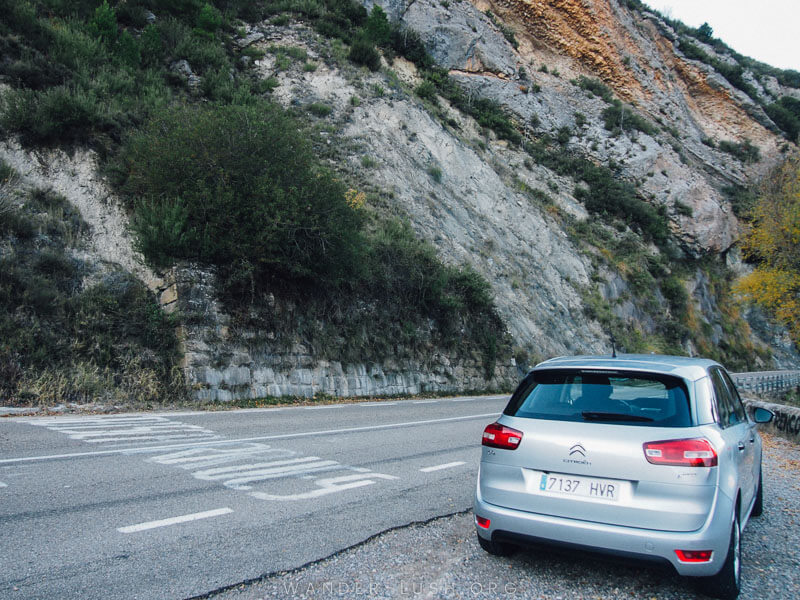
About this Spain itinerary
Looking back over our itinerary makes my head spin a little! We drove almost every day and covered a lot of ground, but by splitting the long drives up into smaller journeys, we still got to visit some interesting local towns.
Spanish highways are incredibly easy to drive on and the scenery is invariably stunning no matter where in the country you are. Because of this, driving never really feels like a drag – it’s all part of the experience.
We started our road trip in Spain from Barcelona and finished up in Seville. From there, we continued on to Tarifa by bus and caught the ferry to Tangier, Morocco. You can adapt this itinerary to create a loop, but I recommend paying the one-way car rental fee so you don’t have to backtrack. If your Spain trip ends there and you’re not continuing on to Morocco , you can fly straight out of Seville.
There are endless options and itinerary combinations for seeing Spain by car. I’m not saying mine is the best road trip in Spain – but I can tell you that it’s tried and tested. Of course there are some things missing (you can’t possibly see all of Spain in 3 weeks), but after I did this road trip, I felt like I’d seen the main highlights.
If I had my time again, I would extend our stay in Madrid by a few days.
A good way to save time is by taking advantage of the Spain day trips and tours mentioned in this itinerary. If you think there’s too much packed in, you can easily take out a few places and stay in certain locations for longer (Madrid and Granada would both be ideal places to extend your time).
How much time do you need to drive across Spain?
A Spain road trip can be as long or as short as you want it to be. As you’ll see from the map, we covered most of the country (apart from the north-west) in 21 days touring Spain by car.
Remember you don’t want to rush driving across Spain too much. Three weeks is the absolute minimum amount of time you need for a Spain road trip like this one – unless you’re prepared to seriously cut down on the number of places you visit.
This 3-week self drive Spain itinerary is fast-paced, but if it’s a once-in-a-lifetime trip to Spain that you’re planning, you probably won’t mind hustling to see as much of this beautiful country as humanly possible.
If you have less time in Spain, you can do a shorter itinerary that focuses on the North of Spain (Basque Country) or the South of Spain (Andalusia).
Spanish road trip route overview & drive times
Let’s start with a basic overview of our Spain road trip itinerary and the 17 cities, towns and villages we visited in Spain in 3 weeks.
Remember you don’t have to follow this itinerary exactly – you can use it as a Spanish road trip planner to pick and choose the destinations that most appeal to you.
- Days 1-3: Barcelona
- Day 4: Barcelona to Sos del Rey Católico via Zaragoza (400km; 4.5 hours of driving)
- Day 5: Sos del Rey Católico to Bilbao via Pamplona and San Sebastián (217km; 2 hours of driving)
- Day 6: Bilbao
- Day 7: Bilbao to Madrid via Segovia (400km; 4 hours of driving)
- Day 8: Madrid
- Day 9: Madrid to Toledo (72km; 1 hour of driving)
- Day 10: Toledo to Valencia via La Mancha (270km; 4 hours of driving)
- Day 11: Valencia
- Day 12: Valencia to Cartagena (270km; 3 hours of driving)
- Day 13: Cartagena to Lanjarón (330km; 3.5 hours of driving)
- Day 14: White Villages and the Sierra Nevada
- Day 15: Lanjarón to Granada (46km; 45 minutes of driving)
- Day 16: Granada to Córdoba (200km; 2.5 hours of driving)
- Day 17: Córdoba
- Day 18: Córdoba to Seville (145km; 1.75 hours of driving)
- Days 19-20: Seville
- Day 21: Depart Seville – or Seville to Tangier via Tarifa
This Spain itinerary covers a whopping 2,450km (1,523 miles). Remember that not all the driving is back-to-back, there are some rest days in between!
Spanish road trip map
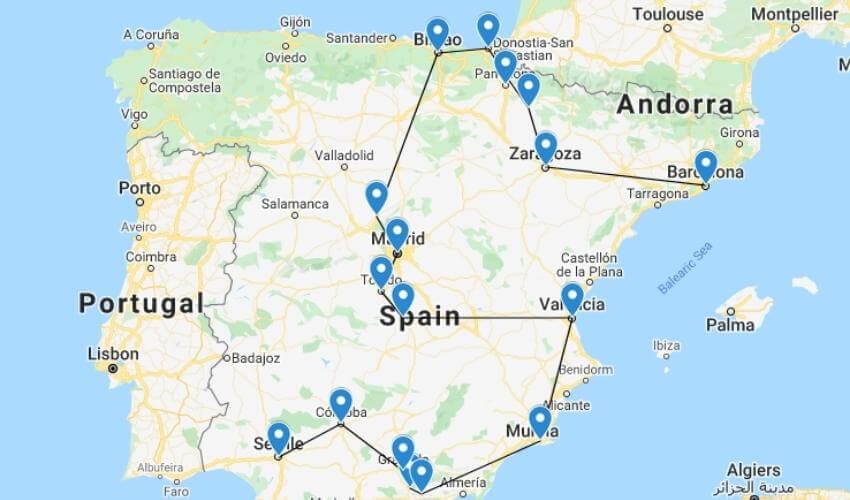
Detailed self drive Spain itinerary
This section includes a detailed day-by-day breakdown of our 3 weeks in Spain, including the best things to do in each city, where to stay, and where to break up longer drives.
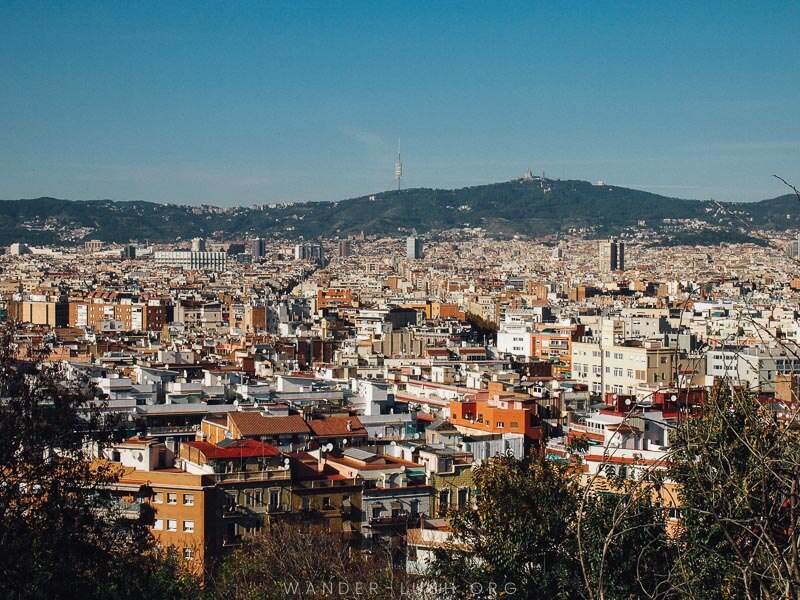
Vivacious Barcelona is the perfect place to start your Spain road trip itinerary. Capital of the autonomous Catalonia region and the second-largest city behind Madrid, Barcelona is quintessentially Spanish and offers a perfect introduction to many of the things that make Spain so great – incredible architecture, beautiful beaches, and fabulous cuisine.
On top of that, Barcelona is logistically the best place to start a trip through Spain. It’s home to an international airport, a train station with services from most other countries in the region (we arrived by night train from Geneva), and a ferry terminal.
I recommend spending at least 3 days in Barcelona to get a good feel for the city and see the main highlights. The city has a great public transport system, so you don’t need a car here – in fact, it would be a major burden.
I highly recommend picking your car up on the day you leave Barcelona. Most rental companies have offices at Barcelona-Sants, the city’s main train station. This is a good place to start as the traffic isn’t too hectic and you can easily get to the highway.
Where to stay in Barcelona
Barcelona is huge – where you stay can make or break your trip. Take some time to familiarise yourself with Barcelona’s inner-city neighbourhoods so you can make an informed decision.
Here are a few recommendations for where to stay in Barcelona – car or no car.
- Ayre Hotel Rosellón . Located in the shadow of the Sagrada Familia, you won’t find a better patio view anywhere else in Barcelona (just look at the pictures if you don’t believe me!). Parking at the hotel is guaranteed and only costs a modest 16 Euros extra per night.
- Barcelona Catedral Hotel . This modern boutique hotel has light-filled, spacious suites, a rooftop pool and patio, and offers free walking tours for guests. Note that secure parking costs a bit extra, and you’ll need to reserve a spot in advance.
- Motel One Barcelona-Ciutadella . Don’t let the name ‘motel’ fool you – this is a boutique hotel through and through. If you can tear yourself away from the trendy lounge-bar and rooftop terrace overlooking the city, it’s a short 20-minute walk to Las Ramblas. Private parking is offered at a nearby location and costs an extra 20 Euros.
- Unite Hostel Barcelona . My top budget choice in Barcelona, this boutique hostel offers dorms and private rooms, all bright, clean and minimally furnished. The yoga studio and co-working spaces are the cherry on top. Reserve on-site parking in advance for 18 Euros/night.
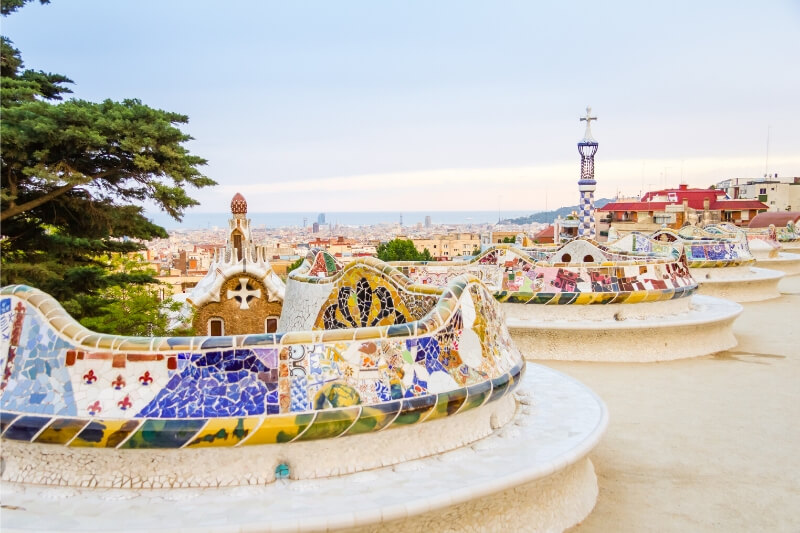
Things to do in Barcelona
In all honesty, planning a Barcelona itinerary can be a bit overwhelming. There’s just so much to see and do. I’m only recommending a few select activities and restaurants that we really enjoyed – know that there is a lot more out there!
Start by pounding the pavement on Sandeman ‘s free city walking tour . This will help you get your bearings while introducing you to some of Barcelona’s must-sees, including the Gothic Quarter and Barcelona Cathedral.
La Sagrada Familia , the grand cathedral designed by Gaudi, is the symbol of Barcelona. You should prioritise visiting on your first or second morning. Skip-the-queue tickets are essential – or else you risk spending hours waiting in line. Pre-buy your skip-the-line tickets for the Sagrada Familia online.
Gaudi’s other works in Barcelona, including the iconic Park Güell Monumental Zone (buy fast-track tickets here ) and Casa Batlló are absolutely worth a visit as well. Even if you’re not that interested in architecture, these buildings all capture the spirit of Barcelona and tell a fascinating story of Spanish and Catalonian history. The experience is even richer if you’re accompanied by a guide who can illuminate the symbology.

Ride an e-bike around the gorgeous Gothic Quarter to explore one of Barcelona’s most charming neighbourhoods. For a break from the hubbub, head for the hills and spend an afternoon wandering around the cactus gardens at Montjuïc . Take the cable car over La Barceloneta beach for fantastic views, and visit the beach itself if the weather is right.
Don’t skimp on the food, either! Barcelona is packed with incredible restaurants . We especially loved eating Spanish ‘ hamburguesas ‘ at Hamburguesería Bacoa and pigging out on homemade churros at Bar Churrería Layetana . If you’re a foodie, this market to table tour of Mercado de La Boqueria , Barcelona’s biggest produce market, is a must-do.
Take advantage of the free entry to Museu Picasso every Friday night – it’s busy, but it’s a wonderful experience. And for something truly memorable, try to see a gig at the Palau de la Música Catalana (we watched an unforgettable performance by the late, great Sharon Jones). If there’s nothing on, I highly recommend booking in for a short guided tour – it’s truly one of the most majestic buildings I’ve ever been in (aside from Sagrada Familia!).
Recommended day trips from Barcelona
If you decide to extend your stay in Barcelona, there are lots of fantastic day trip opportunities within a few hours’ drive of the city.
- Get your Game of Thrones on in charming Girona
- Visit family run wineries and taste tapas in the Penedès region
- Discover the mysteries of Montserrat solo or with a guide
No car? This 12-day journey around Spain by train , starting from Barcelona, takes in some of the country’s best cities and beaches.

It’s time to hit the road! After collecting your car in Barcelona, start heading due west towards the Bay of Biscay. The drive to Zaragoza takes 3 hours. If you want to make it in time for lunch, try to leave the city as early as possible (by 8am at the latest). That way you’ll also beat most of the traffic.
Zaragoza lies smack-bang in the middle of northern Spain. Capital of the autonomous Aragon region, it’s one of the country’s most underrated cities and an ideal place to break for lunch and a short walk.
On reaching Zaragoza, we stopped at a small tavern in the shadow of the Aljafería Palace and ate a bowl of fideos negros (black noodles simmered in fish stock). There are plenty of restaurants and gastrobars around the river, close to the historic centre. However, it might be tricky to find a car park, so I recommend heading to the city’s western fringe like we did.
Sos del Rey Católico

When I picture an archetypal Spanish town, the Sos is what comes to mind. This little village on the frontier of the Pyrenees is located another 1.5 hours’ drive north of Zaragoza, so I recommend leaving after lunch no later than 1pm to maximise your time in Sos.
Ferdinand II of Aragón, husband of Isabel I of Castilla and one-half of the most influential royal couple in Spanish history, was born here in Sos. The little town is loaded with history and packed with charm.
The town is petite and easily navigated during an evening or early morning stroll ; admire the flower boxes, pop in and out of charcuterie shops, and listen to the church bells toll.
We stayed a night at the Parador de Sos del Rey , which sits on a low rise overlooking the Sos’ ancient cobbled streets (you might recognise it from the 2017 film The Trip to Spain ) and had a very memorable meal at the Parador’s Cinco Villas-themed restaurant.
Where to stay in Sos del Rey: Hotels with parking
- Parador de Sos del Rey Catolico . It’s honestly worth the splurge to stay at this Parador. Set in a historic Aragonese mansion that overhangs Sos’s winding streets, it’s one of the most romantic hotels I’ve ever had the pleasure of spending a night in. Rooms are plush as, and the set dinner at the on-site restaurant is a must-try (I’ve never eaten so much food in my life). Parking on the grounds is free and easy.
- El Peiron . For a budget-friendly alternative, this hotel has a similar 17th century ambiance. Cozy rooms feature large beds and exposed stone walls. The location on Sos’s main street, close to some of the village’s best tapas bars, will make you feel like you’re part of the city (unlike the Parador, which makes you feel like absolute royalty). Free street parking is available near the hotel.

On your next full day of driving, break the 2-hour journey to the Bay of Biscay by stopping off in Pamplona for lunch. This will be your first taste of Basque Country tapas ! Pamplona is the perfect place to practice the art of ordering ahead of your arrival in San Sebastián.
Outside of the famous San Fermin (Running of the Bulls) cultural festival , which takes place in Pamplona every July, the streets are surprisingly peaceful and sparse. Bakeries and boutiques run the length of the main pedestrian drag and are well worth a browse.
San Sebastián

Most people head straight for San Sebastián’s pintxos bars , but don’t forget to take a stroll along the waterfront promenade , too. After a day’s drive, this is exactly what you need to stretch your legs and re-fuel.
We spent a few early evening hours in San Sebastián, and while I didn’t really fall head over heels for the town like I’ve known other people to do, it’s a worthwhile stopover on the way to Bilbao. If food is in your wheelhouse, you can easily switch your itinerary and stay in San Sebastián instead of Bilbao.

Bilbao and San Sebastián are only an hour’s drive apart, so you can plausibly stay in one city and visit the other as a day trip. If I had my time again, I would probably stay in San Sebastián instead.
The futuristic Guggenheim Museum is Bilbao’s main attraction, but I found the rest of the city a little bland. One full day is ample time to see the museum and explore Bilbao’s riverfront.
In 24 hours, you can discover the city by bicycle and tour a few of the key Game of Thrones filming locations around Bilbao. An in-depth Basque County gastronomy tour is worth considering if you’re particularly interested in food and wine (let’s face it, if you’re planning a trip around Spain, you probably are!).
Where to stay in Bilbao: Hotels with parking
- Hesperia Bilbao . These trendy self-contained apartments are a 10-minute walk from the city centre (just across the river from the Guggenheim) and feature everything you need for a comfortable stay in Bilbao. There’s even a Japanese restaurant and a rooftop terrace bar – because both those things are basically travel essentials nowadays. Secure parking can’t be reserved but is available at an extra charge.
- Ercilla Hotel . For something with a touch more old-world charm, this boutique hotel offers pretty rooms with herringbone floors and chequerboard tiles. The restaurant serves traditional Basque food, and there’s a panoramic bar here as well. Park on-site for 20 Euros (reservations essential).
- Parador de Limpias . If you don’t mind staying outside the city, this Parador is a 50-minute drive from Bilbao. The former summer residence of King Alfonso, the setting amongst private gardens and a protected woodland is just divine. Free parking is plentiful.

After a short but sweet introduction to Basque Country, it’s time to leave the coast and start driving inland towards Madrid.
Segovia is 100km shy of Spain’s capital city. Coming from Bilbao, you’ll naturally pass through it – so there’s no reason not to stop off and check out two of Central Spain’s most impressive historical sights.

Aqueduct versus alcazar – when an urban landscape is a battle between the most important Roman civil engineering work in Spain and a Moorish palace so beautiful that it’s instantly recognisable from pop-culture, you know you’re in for a treat.
Segovia is a complete contrast to Madrid. Park your car on the hill leading up to the aqueduct and ease your way into the capital by wandering around this charming town for a few hours first.

Climb the concealed staircase to the right of Segovia’s UNESCO-listed aqueduct for a different perspective on this feat of engineering. Visit The Alcazar , apparently Walt Disney’s architectural inspiration when creating Cinderella’s castle.
Between 10.30am and 4.30pm you can join a 60-minute guided tour of Segovia Cathedral , another of the city’s landmarks. This particular tour also allows you to climb the 500-year-old bell tower for a panoramic view of Segovia.
And as a reward for all that walking, treat yourself to a Pasteleria Limon y Menta , Segovia’s signature pastry. It’s lemony, it’s minty, and it’s wrapped in caramelised marzipan. Yum!
If you opt to drive straight into Madrid, you can always visit Segovia on a day trip.

Our first experience of Madrid was the nightmarish drive through the city at peak hour. Don’t make the same mistake we did – try to arrive in Madrid before nightfall!
Where to stay in Madrid: Hotels with parking
- Only YOU Hotel Atocha . The design of this jaw-droppingly beautiful hotel draws on the 19th-century building its housed inside. Deluxe rooms face onto an inner courtyard and are bright and airy as a result while still feeling private. There’s a cafe, bakery and lounge, and breakfast is served on the 7th floor with city views. The Prado Museum is only 900m away, making this a great choice for museum and culture lovers. Parking on-site is guaranteed and costs extra.
- Hostal Patria Madrid . Coming in at under $100 a night, this hotel is excellent value for money in Madrid. Rooms are basic but comfortable with Scandi-style furnishings, and the location on a popular cafe strip is perfect for hungry travellers. Parking (reservation required) costs a very reasonable 17 Euros.
- Parador de Alcala de Henares . If you want to avoid driving into Madrid (smart choice!), this Parador is 45 minutes outside of Madrid. The 16th-century convent building reminds me of a Silk Road Caravanserai. There’s an outdoor pool, and parking on the grounds costs a little bit extra.
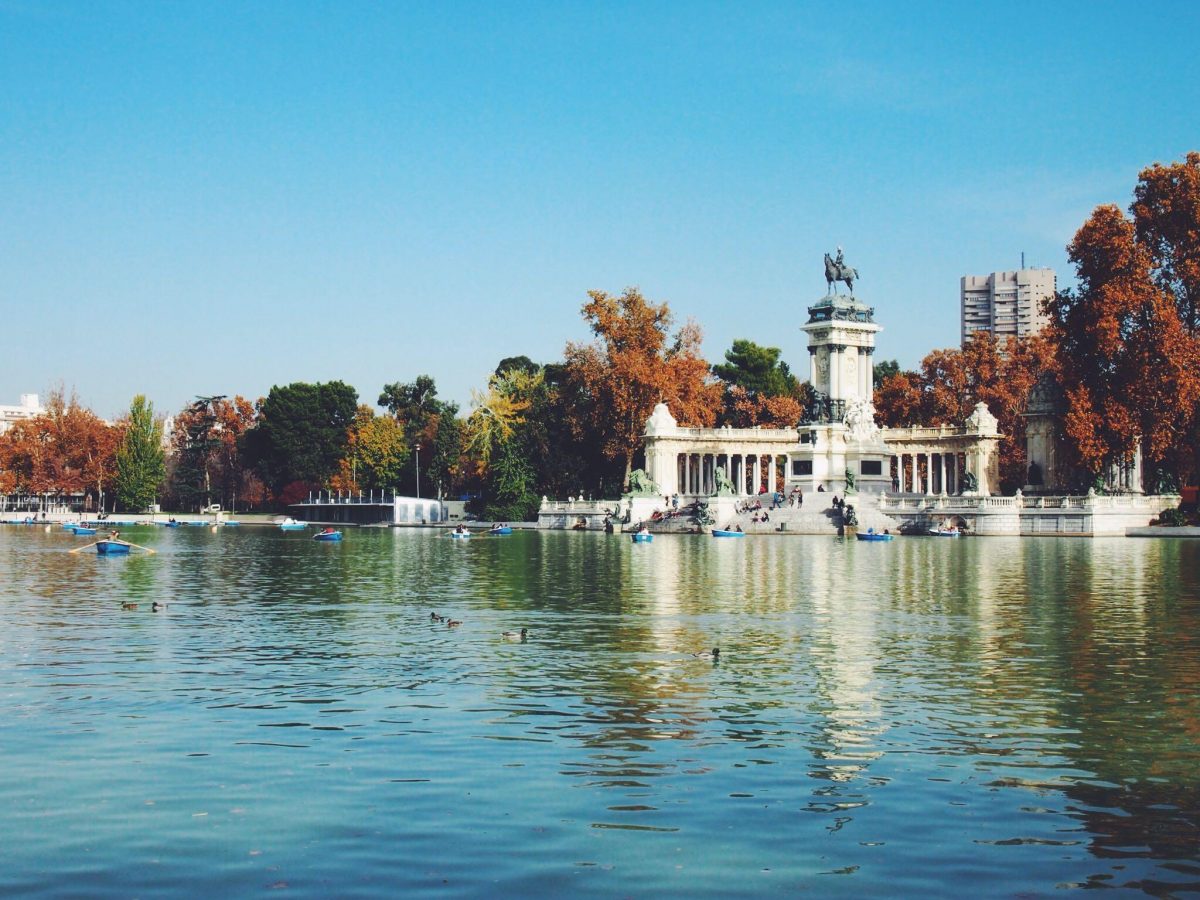
Things to do in Madrid
An easy walk or cycling tour through the city is the best way to see central Madrid. Make sure you explore the gorgeous Real Jardín Botánico , wander through the bookstalls that line Cuesta del Moyano , and top it off with sunset at the Temple of Debod , an ancient Egyptian temple that was dismantled, shipped to Spain, and reassembled in all its glory on a hill in the city centre. A live flamenco performance is the perfect way to end your first day in Spain’s capital.
For a dose of history and culture, visit Madrid’s four most iconic landmarks: The Plaza de Toros de Las Ventas , the Royal Palace , the Plaza Major , and of course the Prado Museum .
Here are my top tips for exploring historic Madrid:
- Join a tour of Las Ventas to access some of the building’s hidden nooks and crannies.
- Take in the scale of the magnificent Plaza Major on a bicycle. This 3-hour small group tour takes in many of the city’s highlights.
- Let a professional guide show you around the Throne Room, Banquet Hall and Private Royal Apartments inside the Royal Palace. This 2-hour tour is excellent value for money.
- Skip the line by buying your Prado tickets online in advance through Get Your Guide .
Recommended day trips from Madrid
- Visit the UNESCO World Heritage Site, Cuenca , and its amazing ‘hanging houses’
- See the ‘three cities’, Segovia, Avila and Toledo, on a day trip (a good option if you want to condense your Spain road trip itinerary and stay longer in Madrid)
- Tour the wineries around Madrid and taste the local drop
- Cast your eyes on the surreal landscape of El Escorial and the Valley of the Fallen

Leaving Madrid, start your journey to Southern Spain’s enchanting Andalusia region. Over the next 12 days, you’ll be driving from Madrid to Granada and Cordoba via some of the loveliest small towns and historical villages in the country.
The first of these, Toledo , is just an hour outside Madrid. After the chaos of the capital, it’s a salve. Toledo’s mix of old-world charm, literary heritage and multicultural influences makes it one of my favourite places in all of Spain. I highly recommend staying for at least one night.
Toledo is the first place where you can see, hear and smell the Middle Eastern/North African influence that becomes more and more pronounced the further south you travel. We had a wonderful introduction to Syrian and Turkish food in Toledo, which became our go-to cuisine for the remainder of our trip.
Where to stay in Toledo: Hotels with parking
- Hotel Santa Isabel . A great budget choice at under $40 per night, this charming guesthouse is right in the heart of Toledo. Private balconies overlooking the town rooftops and a central courtyard are terribly quaint. Rooms are a bit boxy, but nicely finished and clean. Reserve parking in advance for 12 Euros per night.
- Parador de Toledo . This is another great candidate for a little splurge. Set 4km from the centre of Toledo in a low-set historic building, rooms here are a bit more outdated than at other Paradors, but the outdoor pool and panoramic terrace are lovely. Parking is free.

Toledo is the spiritual home of Don Quixote , Spain’s literary legend. A great way to see the old town is by walking the Don Quixote Trail . Alternatively, let a Toledo local show you around on a private walking tour .
Fall in love with Syrian food at Posada El Cristo de la Luz , then down a sampler box of marzipan from Santo Tome (the signature sweets of Toledo).
For more Toledo inspiration, see this list of the top 10 things to do in Toledo .
Consuegra, La Mancha

I’m a huge fan of Miguel de Cervantes’ Don Quixote , but even if you’ve never read the book, a quick detour through Spain’s iconic La Mancha landscape, with its towering windmills and patchwork fields, is an absolute delight.
Leaving Toledo and driving east, aim to arrive in the small town of Consuegra in the early morning before the tour buses pull in at around 10am.
Stop at one of the provincial bakeries for a quick bite. You can then drive all the way to the top of the hill and explore the windmills on foot.

Spain’s third-largest city, Valencia has all the charm of Barcelona and all the amenities of Madrid with a laid back, beach-town feel. This is the Orange Blossom Coast , and the streets of Valencia are lined with citrus trees (which you must pick and sample – luckily our Airbnb came with a juicer!).
Valencia is also the traditional home of paella and Spain’s signature beverage, horchata. While we weren’t all that impressed with the City of Arts and Sciences , we loved cycling through the elongated Cabecera Park that runs through the heart of the city. (Perhaps we should have opted for the rooftop wine and tapas tour instead!) If you’re an outdoorsy type, you’ll adore Valencia.
Driving in Valencia is relatively easy compared to Barcelona or Madrid, so you can stay in the city centre without having to worry too much about traffic or navigating the roads.
Where to stay in Valencia: Hotels with parking
- HQ Rooms Apartments San Vincente . Spacious and featuring all the mod-cons, this self-containted apartment sleeps up to 8 people and comes with a large private balcony. It’s 1.5km from the centre of the city, and there are bicycles available to rent for a small fee. Parking costs an extra 15 Euros.
- Palacio de Rojas . 350m from Valencia’s Central Market, it doesn’t get much more inner-city than this. The canary yellow facade, the indoor-outdoor living spaces, the high ceilings and the heavy doors… This must be one of the most beautiful hotels in all of Spain. Seriously. Palacial apartments sleep up to 9 people and all feature a full kitchenette. Underground parking is available for an additional 15 Euros.
Things to do in Valencia
You’ll probably be quite content hiring a bicycle and exploring Valencia at your own pace. If you want a deeper look, try joining a private walking tour with a local .
For a hands-on activity, I highly recommend taking a paella cooking class and learning just why Valencia is the birthplace of Spain’s most famous dish. Head to the Plaça de Santa Caterina to try a glass or horchata (or two) at one of the open-air cafes. Horchateria Santa Catalina is my personal favourite.
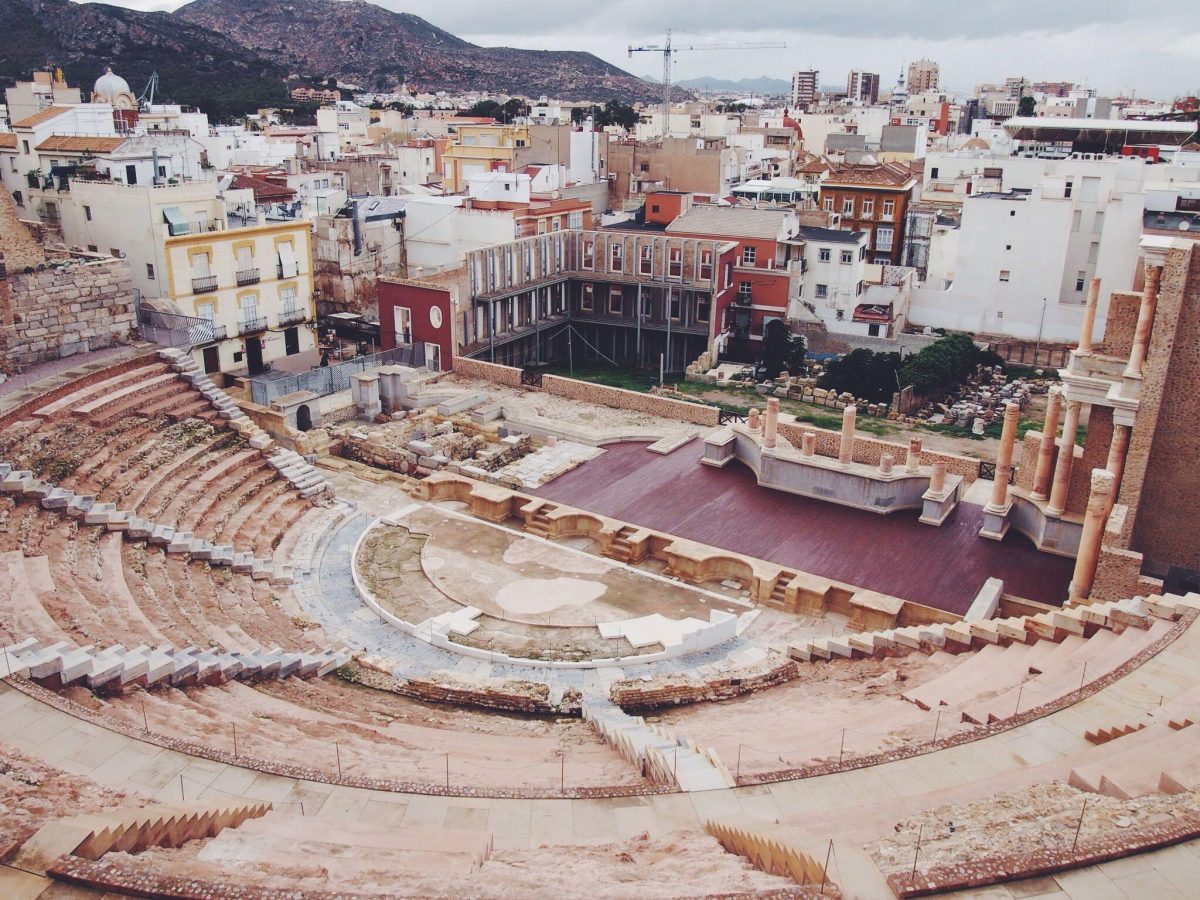
Three hours’ drive down the coast from Valencia, Cartagena is another of Spain’s most underrated cities. We rolled into the sleepy historic centre in the early afternoon and were greeted by a medieval festival, the annual Mercado Medieval (how’s that for timing!).
Catagena’s Roman amphitheater is one of the best-preserved in all of Europe, and exploring the state-of-the-art museum was honestly one of the most enjoyable ‘historical’ experiences I had in Spain. It’s fascinating to see how the city has been built-up around the ruins.
Cartagena is small so you only need a day or two at the most. Start by getting your bearings with a walk around the inner city. The food scene here is great, so I also recommend doing a gourmet tapas tour .
Where to stay in Cartagena: Hotels with parking
- NH Cartagena . Elegant rooms with a view of Cartagena port are the stand-out feature of this efficient hotel. It’s only 200m from the Roman Theatre but in a quiet corner of town, so you can still get a good night’s sleep. Reserve paid on-site parking at the time of booking.
The Sierra Nevada: Lanjarón and the White Villages

Leaving Cartagena behind, you’ll next be driving the coast of Spain (at least a portion of it) and dipping inland to visit one of Spain’s most beautiful natural landscapes, the Sierra Nevada.
Once you hit the mountainous Las Alpujarras region, you’ll realise what a blessing your hire car truly is. Navigating the windy, steep, narrow roads around the white villages was nail-biting at times, but I can’t imagine trying to get around any other way.
Base yourself in Lanjarón , the area’s most populous village and home to a number of quirky accommodations, including the healing retreat/yurt we stayed in.
Once a hippie mecca and still famed for its spring water and olives , Lanjarón is a gateway to the smaller villages of Pampaneira, Bubio and Capileira . If you can brave the altitude, add Trevélez (Spain’s highest settlement) to your driving itinerary.
Some of the villages take a good few hours to get between, especially in inclement weather, so I recommend setting aside at least two days to explore the area, more if you intend on hiking between the villages .

Where to stay in Sierra Nevada: Hotels with parking
- Hotel Alcadima (Lanjarón). Homely suites at this quaint little hotel are excellent value for money. Indoor and outdoor pools, plus a kids’ play area, make it a great choice for families. The restaurant specialises in roast lamb with cinnamon. Need I say more? Parking costs an extra 10 Euros.
- Enchanting Yurt (Lanjarón). One of the coolest Airbnbs we’ve ever stayed at, this whimsical yurt is set in an olive grove at the foot of the mountains. It’s absolutely magical, and the Israeli hosts are very kind and welcoming. Free parking is plentiful.
- Parador de Nerja (Nerja). Another town, another Parador! This one is a bit different because it’s set inside a modern building on a cliff top overlooking the ocean. An elevator ferries guests down to the nearby beach (how cool!). Private parking is available for an additional charge. Note that it’s a 60-minute drive to Lanjarón.

Granada boats a quixotic mix of Spanish and Moorish cultures. The Alhambra is an architectural triumph – if it’s not on your itinerary, you’re doing Spain wrong!
You need to buy tickets to the Alhambra and Generalife Palace and Gardens a day or two ahead of your visit (or a week in advance if you’re travelling in summer). The easiest way to do that is by booking online through Get Your Guide .
On the day of your visit, make sure you leave early to account for the time it takes to access the complex (which includes a long, beautiful walk through the forest if you’re using public transport).
Where to stay: Granada hotels with parking
- Eurostars Catedral . The exception location 70m from Granada Cathedral is only topped by the traditional coffered wooden ceilings inside some of the suites. Rooms are otherwise modern and luxurious with more subtle nods to the building’s history sprinkled throughout. Parking costs an extra 22 Euros per day.
- Anacapri . This 18th-century house turned boutique hotel wears its heart (and its history) on its sleeve. The inner courtyard is outstanding, and rooms are very comfortable. It’s even closer to the cathedral and just 20 minutes’ walk from the Alhambra, right next to the start of the pathway. No reservation is required for the off-site parking (an extra 20 Euros per day).
- Alhambra Palace . Just shy of the city walls to Granada’s iconic UNESCO attraction, this hillside hotel has spectacular views, Moorish-inspired decor, and of course, quick access to the Alhambra. Secure parking is off-site and costs 22 Euros.
Things to do in Granada
After the once-in-a-lifetime experience of The Alhambra, everything else pales in comparison! However, Granada has a lot more to offer, which is why I suggest staying an extra night (or even longer, if you can).
Discover the city’s most charming neighbourhoods , Albaicín and Sacromonte, on foot with a walking tour. Watch a traditional flamenco performance inside Albaycin, and treat yourself to an authentic Arabian hammam bath .
There is a secret sunset spot in the hills above Granada where you can watch the warm light bathe the entire Alhambra complex before someone flicks the switch and it lights up like a beacon on the hill. Don’t miss it!

From The Alhambra to Códoba’s Mezquita, a fascinating mosque-cum-church that is home to a set of much-photographed candy cane archways. Córdoba is an archetypal Andalusian city (my favourite in the region) and has many other offerings, including a pleasant waterfront and some incredible vegetarian restaurants.
Every year, Córdoba hosts the Patio Festival , which showcases the amazing indoor gardens that are a traditional part of every home here. Make sure you peek inside a few doorways as you’re wandering the town’s lanes. This is also a good place to catch a Flamenco/equestrian show – our pick is the Royal Stables of Córdoba .

Where to stay: Córdoba hotels with parking
- Hotel Boutique Patio del Posadero . This intriguing little hotel features bespoke rooms and a beautiful patio (as is the style in Cordoba). The outdoor swimming pool and terrace lounge are perfect for summer. Reserved parking costs extra.
- Hotel Cordoba Center . A bit further from the mosque, this ultra modern hotel sits on the city’s Golden Block next to the AVE Train Station. The 7th floor pool and Jacuzzi are particularly noteworthy, but it lacks the charm of some other Cordoba hotels. Non-reserved parking is located on site.
- Parador de Cordoba . It’s almost your last chance to stay in a Parador! Cordoba’s is a fine choice – another renovated summer palace, it’s located north of the centre and boasts a massive pool plus sprawling gardens (the grounds, Los Naranjos, are where the first palms brought to Europe were planted.) Rooms are extremely spacious and well-appointed. Parking is free.

Things to do in Córdoba
Join the official Mezquita tour (price includes entry) and see this incredible UNESCO mosque-cathedral up close. In the summer, cycle the waterfront on a bicycle tour , or visit seven of Cordoba’s most impressive patio gardens and learn about the history of the city’s courtyard tradition.
If you have an extra day, venture outside the city to see the impressive Azahara Medina .

An entire day can easily be spent inside Seville’s Alcazar complex , another incredible palace – this time in the Andalucian style – that mirrors The Alhambra in its layout and design. GoT fans will recognise the Alcazar as the setting for the Water Gardens of Dorne.
Seville is a sun-bathed walking city, and the Plaza de Espana , Barrio Santa Cruz and Parque de Maria Luisa are all worth a wander.
I found Seville a lot grungier than other places in Spain. The streets are filled with cool v intage stores and hip cafes , and the city has a great vibe.
We returned our rental car in Seville and got around the city very easily using public transport. I recommend you do the same.
Where to stay in Seville: Hotels with parking
- Hotel Las Casas de la Judería . If it’s atmosphere you want, look no further. This charming hotel is set with 27 traditional houses (yes, it’s big), all connected by courtyards and internal passageways. Traditional decor including antique furniture and French windows is straight from the history books, while the rooftop pool brings the property up to date. Some of the rooms are just spectacular – I couldn’t imagine a better way to end your Spain road trip than with a few nights here. The location in the old Jewish Quarter means there’s lots to be explored nearby, including the cathedral, which is just a 7-minute walk away. Off-site parking costs 24 Euros.
- Melia Sevilla . Modern, minimal and a complete contrast to the previous property, this hotel is centrally positioned off Plaza España. Twin hot tubs and a hamman round-out the ample services. Public parking near the hotel costs 24 Euro. Staff can help you coordinate, but I recommend you return your hire car before you check in.
- Hotel Rey Alfonso X . This trendy hotel features a summer pool that overlooks Seville’s oldest church. Business-like rooms are smart if not a little soulless. On-site parking costs extra (enquire at the time of booking).

Things to do in Seville
The Alcazar should be top of your list for things to do in Seville. This skip-the-line ticket includes a guided tour.
Marvel at Seville’s Cathedral and Giralda Tower , watch a flamenco show at Museo del Baile Flamenco (the birthplace of this Intangible Heritage icon), and walk through the gorgeous Santa Cruz Jewish Quarter (don’t forget your camera!).
If you want to get even further off the beaten path in Seville , I highly recommend this alternative market and walking tour .
Seville is a great place for a Spanish cooking class . This one shows you how to prep several popular Seville-style tapas , and includes bottomless sangria.

Recommended day trips from Seville
- The British Overseas Territory of Gibraltar is just a short drive from Seville
- See Ronda , a small town set on a dramatic gorge
- Village hop through the Andalusian countryside
- Visit the port city of Cadiz and the Moorish Jerez, two of Southern Spain’s most stunning cities
- Get another stamp in that passport! – take a full day trip from Seville to Tangier, Morocco
Quick tips for driving in Spain
Here are a few pointers to make your Spain road trip as smooth as possible.
Things to remember when renting a car in Spain
Obtain an International Driving Permit before you leave home. Most rental car companies require an IDP by law (you also have to carry your regular driver’s license).
Book your rental car well ahead of time , especially if you want an automatic transmission as they are in short supply. We could only find a few automatic cars available in Barcelona, and they were more expensive than manual. I highly recommend using Discover Cars to compare rental prices and reserve your car in advance .
Choose the smallest car possible. In between the narrow village streets and tight street parking spaces, you’ll want to go with the smallest car you feel comfortable with. Driving around Spain in a small car (a Hyundai or a Corolla, for example) is perfectly safe provided you stick to the highways and don’t go off-road.
Bring your own GPS (with maps for Spain and Portugal pre-loaded) to avoid the GPS rental fee. Alternatively, use your phone to navigate with Google Maps or Maps.Me – it works just fine, provided you have the map pre-downloaded for offline use or you have a Spanish sim card with plenty of data.
General driving tips & Spain road rules
Plan your route to avoid toll roads. Some tolls are very expensive – up to 20 Euros – but we managed to avoid most of these by taking indirect roads and alternate highways.
Avoid driving in the bigger cities , especially Madrid. Pick up and drop off your hire car from an office in the outer suburbs or the airport to avoid inner-city congestion.
Note the blood alcohol limit. If you plan on visiting any wineries while you’re driving across Spain, remember that the blood alcohol limit in Spain is 0.05% (or 0.01% if you’ve had your license for 24 months or less).

Tips for parking in Spain
Look for ‘Blue Zones’. If you’re visiting cities and towns for the day and need a place to leave your car away from your accommodation, you’ll need to get a grasp on how the street parking works in Spain. Blue Zones (portions of curb marked with a blue line) designate paid parking spots. Wherever you see Blue Zones, you’ll see a meter or automatic machine nearby where you need to register your car. Take the ticket and display it prominently on the dash, with the date and times face-up.
Yellow lines designate disable parking spots. You’ll need a displayed permit to park here. Other coloured zones vary from city to city but usually indicate Resident Zones. If you’re not registered to a nearby address, you obviously can’t park here.
Park during siesta hours. Depending on the city, metered parking is sometimes free between 2pm and 4pm Monday to Friday and after 2pm on Saturdays. If you want to save a buck, try finding a car park during siesta hours.
What to pack for your Spain road trip
A few of my favourite must-pack essentials to make your road trip around Spain comfortable, safe and hassle-free.
Travel insurance for Spain
The one thing I never travel without. When it comes to medical expenses, accidents, travel delays and the like, preferred partner for long-term travel insurance is SafetyWing .
When renting a car, make sure you read the PDS to see what you’re already covered for. I always recommend purchasing extra insurance just in case, either via the rental agent or through a provider such as Insurance4CarHire.
Handy gadgets
Travel adapters. If you carry a universal adapter, you’ll never get caught out with the wrong plug. This portable travel plug works in more than 150 countries (including Spain and the rest of the EU) and features 4 USB ports for charging multiple phones/iPads at once.
USB phone charger. Don’t let your phone run flat while you’re in the car. You can plug your regular charging cable directly into this Anker USB car charger . It works with most phones and iPads.
Car mount phone holder. Using a phone while driving is illegal in Spain. If you plan on using your phone to navigate around, you’ll need to use a mobile phone mount. This travel-friendly phone holder fits any phone or phone case, and has a 360-degree rotating cradle.
Lightweight cooler bag. An insulated bag to keep your drinks and road trip snacks cool is especially useful in summer. This simple family-size cool bag packs down into a neat, flat little bundle that you can easily squeeze into your suitcase.
Wine Wings. Whether you’re road tripping or not, these handy non-leak wine bottle protectors are one of my favourite travel items for Europe. Essential if you want to bring a few bottles of Spanish vino home with you!
Eco travel essentials
Refillable water bottle. It’s crucial to stay hydrated in Spain, especially in the warmer months. Tap water in most cities and towns is potable. As you drive through the mountains around the Sierra Nevada you’ll see fresh-water springs by the side of the road where you can fill up your water bottle (this was one of my favourite things about road tripping in Spain!). I highly recommend S’Well insulated bottles because they look good, stay cool for up to 12 hours, and they don’t sweat.
Reusable coffee cup. You’ll probably be drinking a lot of coffee in Spain. It’s always a good idea to bring a reusable cup that you can take with you in the car. This gorgeous gold barista-friendly travel mug is vacuum sealed (zero chance of a spill!) and will allow you to cut down on plastic and paper waste.
What to wear in Spain
Good walking shoes. Even if you’re on a Spain road trip, you’re still going to be spending a lot of time pounding the pavement (and cobblestone streets!). Comfortable walking shoes are absolutely essential. To cut down on luggage, we carry ‘stylish’ walking shoes in Europe that we can also wear out at night.
Sunglasses. Some highways in Spain are quite exposed – I guarantee you’ll be reaching for your sunglasses on the first day. Bring your favourite pair of polarized lenses, or pick up a pair of foldable travel sunglasses .
Loose, comfortable clothing. There’s nothing worse than feeling uncomfortable in the car. Pack a pair of travel leggings or yoga pants plus a few comfy t-shirts for longer driving days. A comfy travel cardigan like this one is a must-pack for winter in Spain.
Essential reading
A copy of Lonely Planet Spain. This essential guidebook for Spain is the perfect Spain road trip companion. As well as planning and logistics, it includes useful Spanish phrases and detailed information about Spain’s top tourist sites.
A copy of Back Roads Spain. This little book is a bit light on practical information, but it does contain some beautiful photos. Great inspiration for getting off the beaten track in Spain.
Spain paper map. Good for peace of mind if your sat nav fails you. Even if you don’t use it for navigating, you can still plot out your route and hold onto the map for a nice souvenir! This map is current for this year and covers both Spain and Portugal.
I hope you’ll agree that this is one of the best routes through Spain by car for first-time visitors who want to pack everything in. Are you planning a self drive Spain itinerary for your next road trip? Leave your questions in the comments!
Spanish road trip itinerary: Pin it!

50 Comments
This is such a great post, we did a very similar route over three months! We didn’t realise just how much we would fall in love with Spain.
Whilst in Spain, we were crashed into TWICE!!! both times when we were parked!! Although there is nothing we could have done to prevent this – I thought I would let you guys know! Spanish drivers can be crazy – even in a parking lot!!
Sorry to hear that Christie! Hope you still had a fun time!
Really love your post on spain. Just wondering if this will work also in winter in dec?
Hi Jaime, I don’t see why not – I was there at the start of winter and the weather was nice, roads quiet, etc. You might have to make some small adjustments for the mountain roads. Happy travels!
I travelled around Spain in a campervan from January to March this year and the weather was great. Even on the coldest days, the temperature was really mild and completely manageable. Bilbao was the only place that even felt remotely “wintery”, but with that being said, I’d take a Spanish winter over a Scottish winter any day!! I would 100% recommend visiting Spain over winter as it is not overcrowded with tourists and the weather is still good enough to do most outdoor excursions!
Looks wonderful! I recommend renting a car and driving off the road to get to know the culture and customs of people in the provinces. It is such a cultural and spiritual journey.
Amazing road trip! In Spain there is so many places to visit from the north with beautiful nature to the south with cultural impact. Love your style of writing.
Dear Emily, thanks for sharing your invaluable experience and tips. I’ve never been to Spain (but I will soon), except for the Canary Islands, so this thorough guide is just priceless while planning a trip. After seeing the super narrow streets on Tenerife, I can totally vouch for hiring the smallest car. We were lucky enough to hire a really small one while traveling around Tenerife. Otherwise, it would have been impossible to pass some of the roads, especially when there was a bus in our way.
Absolutely! We had a terrible (but also hilarious) experience with our car in Bilbao… Smaller is definitely the way to go in Spain!
Enjoy your trip!
Dear Emily, Thank you so much for sharing with us your great experience in spain, I’m very glad to read your trip report and happy to hear that you enjoyed it.
Regards, Hamid
Hey Emily, Love your travel blog. I was just wondering about the language barrier? My partner and I only speak English. Was it hard to communicate with people? Thanks!
You have nothing to worry about – English is widely spoken, even in small towns. For extra peace of mind, you could download Google Translate’s Spain module to use offline when you’re travelling.
I hope you have a wonderful trip!
Oh & We are planning to spend 2 days in Madrid and 2 in barcelona , which leaves us with 5 days for driving and moving around from madrid , throughout these Andalusian cities and reacb to barcelona. At what point do u think a train would be more convenient? Thanks again Emily 🙂
Wow your post was so helpful and informative! We are planning a 9-day trip to Spain. We will arrive in madrid and depart from barcelona. Starting in madrid , driving south (rent Car) to Toledo , Cordoba , Seville , Granada. We are not sure if we should continue driving from Granada towards Valencia then off to barcelona for the last 2 days. OR skip Valnecia all together, drop the car in granada and take a train to Barcelona. Do you habe any advice as to the best way to accommodate this itinerary? (In terms of making use of the beautiful towns and scenary, but not waste too much time on tje road!) thanks a lot , your input is appreciated.
Hi Marco, sorry for the late reply. I really enjoyed Valencia – don’t skip it! You can easily do the whole route by car and drop off your rental in Barcelona.
Enjoy Spain!
Your post information is very unique and useful for all readers.
Hi Emily! This is great! Thanks for putting so much effort !! What was you guys process for mapping the road and avoiding the tolls?
Hi John—if you Google ‘Spain toll map’ you’ll find a good road map with no toll roads marked out. We just planned our route according to that!
Hope that helps!
Great thank you! We have been traveling Europe for a little over a month now and going to finish the trip with a 10 day drive from Seville to Barcelona stopping a lot along the way! Will definitely use your post to help!
Sounds incredible! I’m very jealous. Enjoy—and please don’t hesitate to reach out if there’s anything else I can help with.
Great article! Thank you for sharing!
Hi Emily – thanks for this super helpful feature ! Just wondering what car hire company you used and if you have any recommendations on type of car Thanks 🙂
Hi Jess! Thanks so much for reading. I’m glad you found the itinerary helpful.
We were advised to go through Sixt—but unfortunately they didn’t have an automatic car available for our dates. We used Hertz in the end. We rented a regular sedan—we didn’t go off road at all, so it was fine. Even in the Sierra Nevada, you won’t need a 4WD as long as you’re sticking to the path.
I hope this helps! Emily
Thank you for your suggestion Emily!
Wonderful!road trip advice for Spain. Would you suggest me how much total cost to travel so that I would manage my budget accordingly. I would be grateful.
Depending on your travel style, I would recommend budgeting 50-120 USD/day.
I love your blog, I am traveling to Spain early May and currently preparing itinerary for a 16 day road trip. I will be travelling with my husband, we love to explore culture, local food and love nature and seneic places. As we will be little tight on schedule, we want to plan properly so that we can cover the most in 16 days. Please help me with your suggestions on the itinerary, we were planning to spend 5 days in San Sebastian + Bilbao. I am having second thoughts after reading your blog. We will fly in at Barcelona and fly out from Madrid. Below is the itinerary, let me know your thoughts
Night 1 : Barcelona – we will fly in late so not planing anything Day 1 : Roam around Barcelona Day 2: Leave for San Sebastein – stop over at Pamplona – night at San Sebstein Day 3: Explore San sebastein Day 4 : Leave for Bilbao, night at Bilbao Day 5 – Day 6 : Explore Bilbao and nearby. Is this too much for Bilbao? I found POIs that appeared seneic.. I am unsure if 3 nights is way too much for Bilbao Day 7 : Leave for Leon and stay there for a night Day 8 : Plan to spend 5 days in south to cover Seville, Gibraltar, Granda and fly out from Madrid
We are not very keen on Barcelona and Madrid. After reading your blog I am tempted to add Cordoba and Lanjaron to our plan..
I will be glad if you can help me here .. 🙂
Hi Namrata! Thanks so much for your message. Your trip sounds wonderful!
I personally thought Bilbao and SS were overrated—I much preferred Cordoba, and Lanjaron was absolutely beautiful. If you like scenery, you will love Lanjaron. I am less of a foodie so you will probably appreciate San Sebastian more than I did! I would spend less time in Bilbao, but that would just be my personal preference. I really encourage you to check out Cordoba—it was definitely a highlight of Spain for me.
I hope this helps! Have a wonderful time in Spain!
Wow! What a nice roadtrip, Emily. You did covered a large area of Spain and included areas that many travellers overlook. If you ever decide to do another Spanish roadtrip, I would recommend including Extremadura in your trip. It is the most unknown of all Spanish regions, totally overlooked by most foreign tourist, yet a fascinating area full of history, Unesco sites, the best ‘jamón’, castles, vast open spaces and empty roads. Cheers, Irene
Thanks, Irene! I just did a quick Google and Extremadura looks gorgeous! I will definitely keep it in mind for next time.
Cheers, Emily
We’re planning a 3-week trip to Spain this summer probably starting in early June. We are thinking of “winging it”. Flying into Barcelona, renting a car and just driving with an itinerary similar to yours. Do you think winging will be OK? We don’t want to plan staying in any one place for a specific number of days. If we come across a place we like we want to be able to stay there for as long as we want without affecting any reservations that otherwise would have been had. Do you think booking AirBnB’s on the fly will be an issue? With respect to car rentals, are we able to rent in Barcelona and return in Malaga for example? Thank you for posting your article. It’s a great help.
Hi Richard,
Thanks very much for your comment! Your trip sounds great. I wish we had more flexibility with our itinerary as there are spots we would have spent less time (Bilbao) and places where we would have loved to stay longer (Valencia, Granada).
I haven’t travelled in Spain during summer, but I would guess that things are a tad busier! With Airbnb, you should always be able to find something, even at short notice. The only restrictions will be your budget and the availability of car parking. We were on a tight budget, which is why we preferred to book in advance and secure rooms at a lower price. I have booked Airbnbs on the fly in other countries before without any issue—so it’s definitely possible. You may have to compromise on price and location, though.
We rented our car in Barcelona and dropped it off in Seville. There was no issue. We just had to pay a small premium for returning it in a different city, as is standard with most rental places around the world. So you shouldn’t have any problem with returning the car in Malaga.
I hope you have a wonderful trip! Please do let me know if there’s anything else I can help with.
Oh I keep rereading your report and seeing more each time. Thank you so much! We are going to Spain from 21st Sept until 17th Oct and driving three weeks of that. We’ve been to the major cities before (Madrid, Barcelona, Seville, Granada) so we are concentrating on smaller places, Jerez, Cordoba, Toledo, Salamanca, Zaragoza (where we’ll catch the annual festival!) etc. Still a little concerned about parking though. How did you manage? We also love apartments so we can visit the local markets and cook some of our meals at home so we’d love you to share your advice about really good airbnb’s. We have one in Jerez so far – haven’t got very far as you can see – and have fortunately found a hotel in Zaragoza with free parking during the festival. We’d really appreciate any other advice along the way. Here’s the general order: start Jerez, check out the white villages from there, Cordoba, Ubeda, Toledo, Salamanca, Burgos, Zaragoza… then somewhere in between and end at Barcelona airport to fly home. Lots of other little places to check out close to these towns but I think they will be our main stops (think…). Would LOVE your comments.
Hi Kathryn, your trip sounds great! We had a few parking dramas in the bigger cities but nothing too bad. I’ve just posted a list of the Airbnbs/hotels we chose to stay at in Spain – some are no longer listed, but there are a few still going. I hope this helps!
https://wander-lush.org/spain-best-airbnb-where-to-stay-road-trip/
Safe travels! Emily
Hey Emily, I plan to make the same road trip you have done in Spain with my wife in January. In which month you did yours ? I am not sure if the weather January is not very convenient for such trip !?
thank you so much in advance
BR Redouane
Hi Redouane! Thanks for your comment. That’s very exciting – I hope you love it as much as we did!
We did our road trip in November. I’ve never been to Western Europe in January, but I can’t imagine the weather would be too drastically different. We prefer the cooler weather, which is why we chose that month. Everything was a touch cheaper as well given that it’s shoulder season.
I hope this helps with your planning! Enjoy!
Hi there! Thanks for a great blog! This is what I love – discovering places off the beaten track. We are doing a 5 week trip with 3 kids taking our own car by ferry in July! The only thing I have planned as yet is that we arrive in Santander….! Would welcome air bnb recommendations but will touch base wth you as I get planning to see what you recommend. Have noted your recommendation for Córdoba. X
Thanks Aabida! Your trip sounds great. Please do get in touch if you want specific recommendations for Airbnb – we stayed at some great places.
Hi Emily, I’m traveling in southern Spain at the end of July and have booked a rental car. I’m concerned about parking in Granada and Cordoba (Granada especially as I’ll be there for a few nights. Any parking recommendations? Thank you!
Thanks so much for your comment. Your trip sounds wonderful!
We stayed at Airbnb apartments with private parking in both Granada and Cordoba. From memory, Cordoba was a bit tricky because the streets there are quite narrow so I would definitely check with your accommodation in advance.
Granada, however, had plenty of street parking. We parked and took public transport to/from town and the Alhambra. I dug up the link to the Airbnb apartment we rented – there was a lot of street parking in this part of town: https://www.airbnb.com.au/rooms/726540
Best of luck with the rest of your planning! Please let me know if there’s anything else I can help with.
wow amazing road trip! and the photos you’ve taken are really incredible.
Hello Emily I’m thinking of travelling to Spain in May 2017. Thanks for all your information. I like your intinery and will probably follow some of your guides. Did you book your airbnb before you commenced your trip and further did you do it online? Any tips or websites would help? Thanks for any help. Peter
Hi Peter! Thanks for reading.
Yes, we booked all our Airbnb accommodation online before we started the drive. Some places were excellent – others weren’t so good. If you go to Cordoba (which you absolutely should), please stay with Maria and Xavier. They are probably the best hosts we’ve ever had, and their place is incredible: https://www.airbnb.com/rooms/929791
We also stayed in one Paradore, which I highly recommend!
Have fun planning your trip and please let me know if there’s anything else I can help with!
Hi Emily We tried to contact these people on the AirBNB link and it says no longer available. do you know what happened ? Is there a way to contact then direct?
Hi Tom, which listing was it? I’ve recommended a few. If it’s not available, they may have taken the listing down. I don’t have direct contacts but if you let me know which one you were after, I can tell you the area and you can try searching for other properties nearby.
Oh my God! Spain is my dream. Soon I’ll visit this country. I’m really grateful for all this information. Unfortunately, I can’t be there all 21 days to explore everything you’ve write. But it’s an awesome purpose to return as soon as possible again. Thanks for sharing
Lovely photos. I stumbled upon your blog while researching itineraries for my next trip to Spain. My boyfriend is a huge fan of road trips and would very much like to drive down the coast, starting Barcelona and ending in Lisbon. I was just wondering whether or not you felt there was a significance cost difference between renting a car and taking local trains. Can you share your main reasons for choosing to drive through Spain? Also, I guess you were able to leave the car in a different city from where you began? Thanks 🙂
Thanks so much for your comment. I’m a huge fan of both trains and road trips – but I felt that having a car would be better for us because we wanted to check out some of the smaller towns and travel at our own pace. Spain is a perfect place to drive since the roads are very well kept and safe, and hiring a car was within our budget. I definitely recommend it!
Have an awesome trip, Emily
What a whirlwind trip to Spain. I’ve been to Madrid/Toledo/Segovia and Sevilla a couple of times. My husband and I are heading to Barcelona then Girona and small towns along the coast. I’m hoping to rent a car outside of Barcelona but am having a difficult time finding a reputable car rental company. Do you remember which one you used and were you happy with it? I’ve come across many complaints/scams.
Toledo is my favorite so far. Can you recommend any towns similar (southeastern Spain)? Thank you.
Hi Cindy, thanks so much for your comment!
A friend recommended Sixt – they have good rates and are reliable. But we had a bit of trouble finding a car at Sixt, because neither of us have a manual license (it’s difficult and more expensive to get an auto). So if you need auto, book ahead of time online. We went with Hertz in the end, and they were fantastic. We took our own GPS but the car had a built-in system as well.
As for towns in the southeast, Cordoba was my personal favourite. Don’t miss it! I would also recommend spending a night in Cartagena. There is plenty to do in Valencia – it’s a little bigger, but also lovely – and of course Granada.
Happy travels!
Leave a Reply Cancel reply
Your email address will not be published. Required fields are marked *
- Subscribe to future posts

Spain Road Trip: 8 Amazing Routes for an Epic Trip
This post may contain affiliate links, from which we earn an income.
Our Pick of the Best Road Trips in Spain
Amongst the beautiful landscapes of Spain, in the mountainous interior and along the gorgeous coasts, you’ll find fascinating history, vibrant culture, and incredible cuisine. One of the best ways to experience Spain is by taking a road trip.
With the lively attractions of Barcelona, UNESCO World Heritage Sites, the historic medieval cities of the interior, and endless summer days in Andalucia, Spain is an eclectic place to take a road trip.
We base ourselves in Spain when not traveling and have explored much of the country on four wheels and two! Whether you want historic cities, gorgeous landscapes, beaches and sun, or something a bit different, our detailed guide has the best Spanish road trip routes plus itineraries and travel tips, to help you plan the perfect trip.
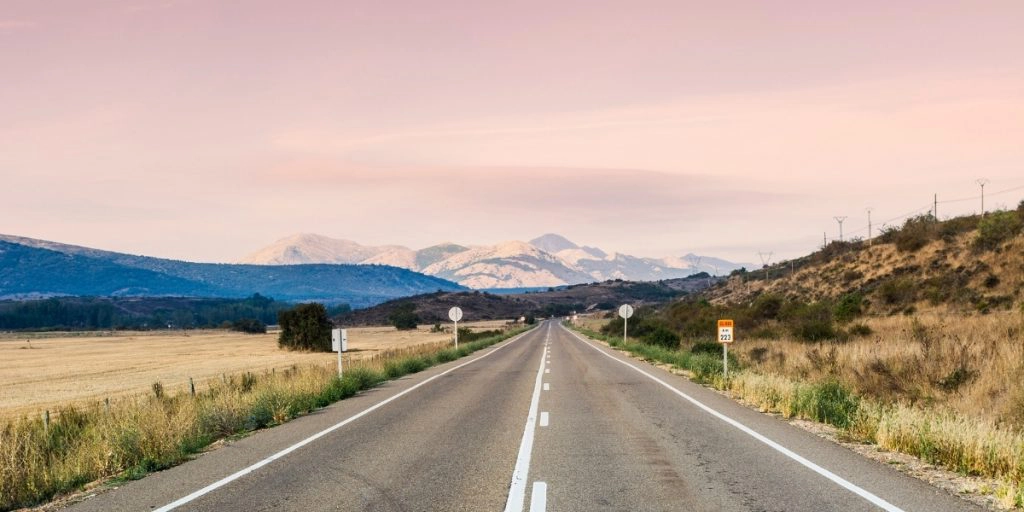
Getting to Spain
Whether you’re taking a Spain road trip in a car, motorcycle, campervan, or motorhome, self-driving is absolutely the best way to explore this spectacular part of the Iberian Peninsula.
When you road trip Spain you can stop whenever you want, try new activities, visit places you see along the route, and have the freedom to change plans at the last minute.
Spain is an easily accessible country from the UK and most of Europe, with a direct ferry route from England to Santander or Bilbao, and an established network of autovias to help your road trip across the country. Plan on getting to Spain as part of your trip and enjoy an epic road trip to Spain, followed by one in the country itself!
RELATED POST: Driving from UK to Spain – Routes & Tips
Book with Skyscanner and fly into the well-located international airports of Madrid , Malaga , and Barcelona are ideal starting points your Spanish road trip – you can be anywhere in the country within a day and that’s the beauty of a viaje por carretera , or road trip in Spanish!
Are you planning to rent a car in Spain? As one of the largest car hire aggregator companies in the world, we recommend Rentalcars.com because they have massive purchasing power which enables them to secure the best car rental prices, which benefits you when you’re planning a roadtrip in Spain.
For a real adventure , hire a motorhome or campervan in Spain. We recommend Motorhome Republic , an aggregate booking site who pull together all the best deals from a number of rental agencies, to offer you a wide choice of options alongside an excellent English speaking expert motorhome Concierge Team.
Best Spanish Road Trips Map
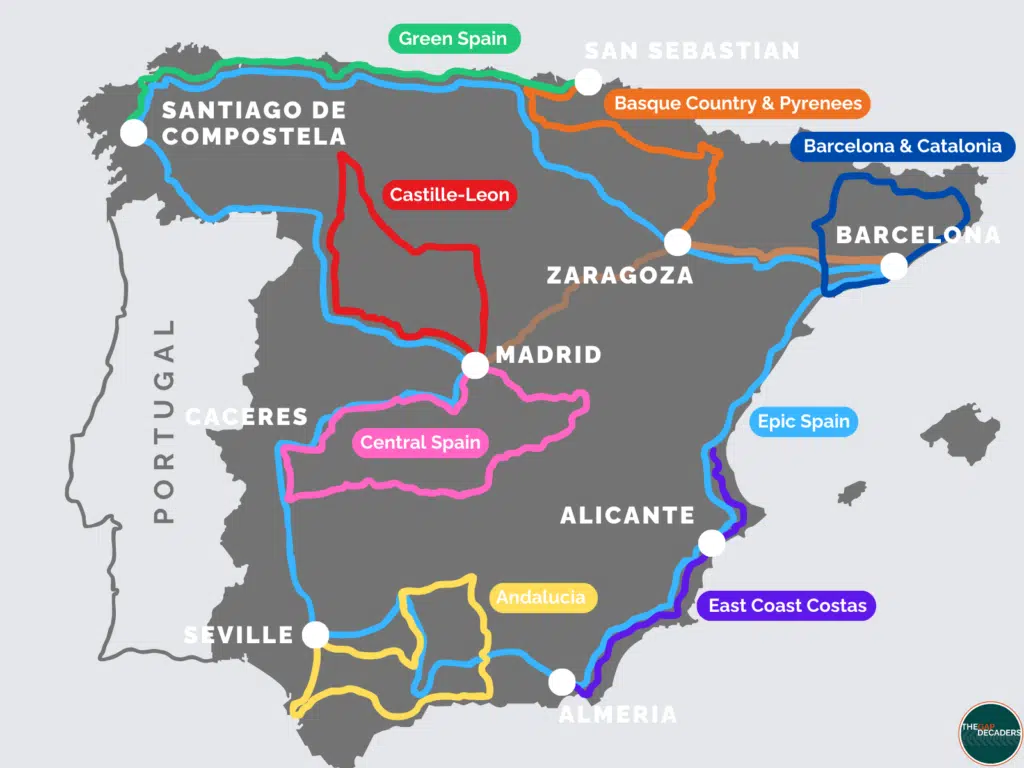
Which is the best road trip in Spain?
- Castille-Leon for historic cities, vineyards, and empty roads.
- Barcelona and Catalonia for beautiful beaches and lively party vibes.
- The Basque County and Pyrenees road trip is perfect for foodies and hikers.
- Andalucia for gorgeous Moorish cities, flamenco, and fantastic beaches.
- East Coast Costas for vibrant seaside resorts and sunny days year round.
- Central Spain for wild natural landscapes and off-the-beaten-path towns.
- Green Spain for quiet beaches, mountain hiking, and fab food.
- Epic Spain for an amazing journey through the best of Spain.
Is this your first time visiting Spain? Get all the information you need in our Spain Travel Guide , including what to pack, the best time of year to go, getting there, and practical tips to help you have the best trip!
Castille-Leon
Madrid – segovia – salamanca – zamora – león – valladolid – penaranda del duero – madrid.
- Distance: 915km
- Duration: 7-10 days
- Drive Time: 11 hours
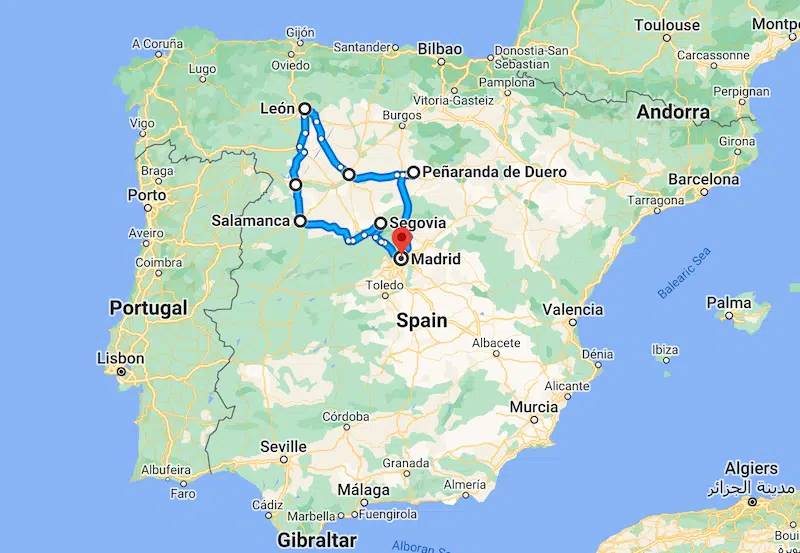
This fantastic seven to ten day Spain road trip itinerary through the land of frontier castillos and roads that stretch into the distance for miles will take you across the high plateaus and rugged mountains of central Spain. This is a road trip for those who want the real Spain.
It will be unbearably hot in summer and bitterly cold in winter in this part of Spain. This road trip in Spain should be taken in spring when the fields are carpeted with colorful wildflowers, or in autumn/fall for the late summer sun and the beautiful ochre and red of the Duero vines.
Pick up your hire car at Madrid airport and spend a day in Madrid , the largest city in Spain, seeing the most important attractions, including Plaza de España, the Prado Museum, Plaza Mayor, and the nearby Baroque Royal Palace before heading to the UNESCO World Heritage Site of Segovia, a walled city with grand squares and mansions from its days as a royal holiday resort, and one of the most distinctive medieval castles in Europe.
Next up, visit Salamanca , known as the Golden City because of the prolific use of honey-colored sandstone in the civic and religious buildings of the city. Salamanca is beautifully graceful, with learning at its heart, and the most elegant Plaza Mayor in Spain.
Zamora is your next destination. With its Romanesque churches and charming streets and squares of the old town, this makes a great stop for an overnight stay. Onwards to Leon, a sociable city with a fabulous casco antiguo, packed with great architecture and atmosphere, and a notable Gothic cathedral.
Valladolid, your next stop is high on the mesta (plateau) and has been lived in by many of Spain’s famous historical figures. Despite that, it is a more modern town than its neighbors. You’ll find restored plazas and churches along with some excellent museums.
To the east, the small town of Penaranda del Duero is deep in the lush rolling vineyards of La Rioja, where some of the best wines in Spain are produced. This gorgeous town, on the Ribera del Duero Wine Route, sits beneath an impressive castle and is a popular weekend getaway for Madrilenos .
Spain is famous for its history and if you have an extra day at the start or end of your road trip, visit Toledo , an hour’s drive to the south of Madrid. Known as the Imperial City, this UNESCO World Heritage Site has one of the most well-preserved old towns in Spain and more historical sites per square meter than Rome!
- Eat suckling pig in Segovia, a truly delicious local specialty.
- Head for the tapas bars of the cathedral quarter in Leon. Order a small beer and get a complimentary tapa!
- Visit a bodega along the glorious Ribera del Duero and enjoy a wine tasting.
Where to Stay
Madrid ⇒ Only You Hotel Atocha for its hip vibe, contemporary luxe decor, and fantastic public spaces.
Leon ⇒ Hotel Real Colegiata San Isidoro for its superb location, complete uniqueness, and fabulous history.
Valladolid ⇒ Abadia Retuerta LeDomaine for sheer luxury, fabulous restaurants, and an incredible spa. A fabulous hotel for the perfect end to your road trip.
RELATED POST: Madrid in One Day – Itinerary, Map, Tips & Guide
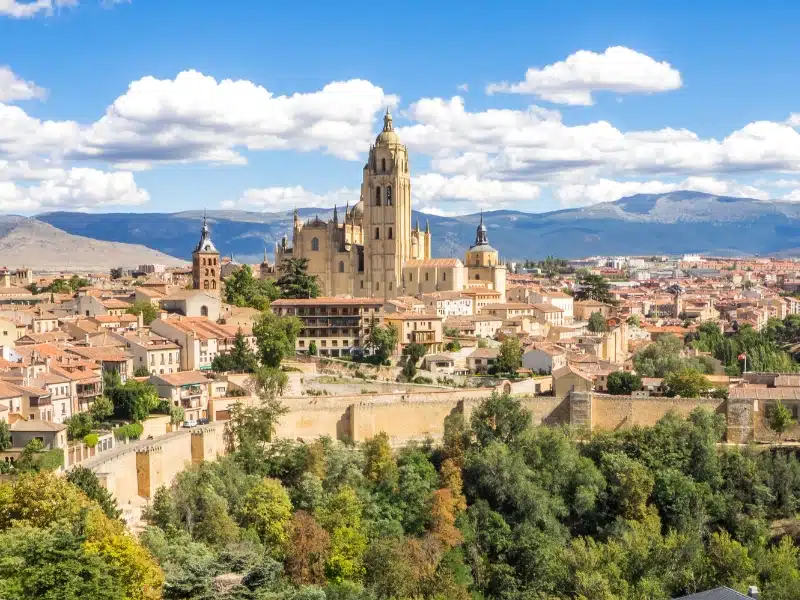
Make sure you have travel insurance you can trust when visiting Spain . We recommend True Traveller for their excellent TrustPilot reviews, variety of cover options, best activities cover as standard, great prices, and excellent service.
Barcelona & Catalonia
Barcelona – sitges – tarragona – la seu d’urgell – figueres – calella de palafrugell – tossa de mar – barcelona.
- Distance: 642km
- Drive Time: 10 hours
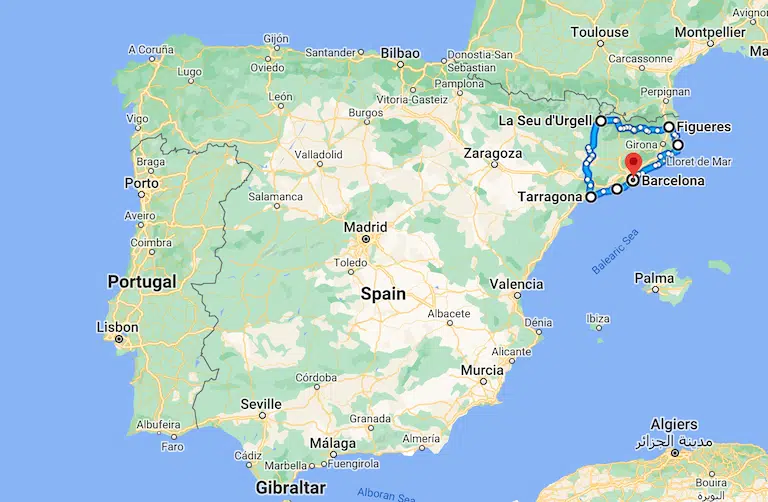
This seven day Costa Brava road trip from Barcelona takes you through one of Spain’s most distinctive regions. Catalunya is fiercely independent with a unique identity, and like nowhere else in the country. With its own language, Catalan, the region has long been an intersection of cultures and influences.
We start on the Costa Brava in the second biggest city in Spain, Barcelona. This is Gaudi’s city and home to the sublime but unfinished La Sagrada Familia cathedral. Once you’re done admiring his masterpiece, head for the Gothic Quarter, a great spot to while away an evening bar hopping in this most lively of cities.
If you have enough time, try hiking in Montserrat , just a short drive from the city. Famous for the cliff-hugging monastery and distinctive serrated rocks, you don’t even have to hike, you can get a cable car to the top!
Head south along the coast to beautiful Tarragona, stopping at Sitges if partying is your thing …but be prepared to party hard, the town is famous for its nightlife.
Tarragona is situated on a rocky hill above the sparkling Mediterranean Sea. With a fine historic center and a scattering of Roman ruins, this is a great place to spend the day visiting the must-see 2nd century Amfiteatre Romà, Necropolis, and Forum before wandering the Passeig Arqueològic for sweeping views of the city. Or you could just relax on one of the many beaches.
From here it’s inland and north to the Pyrenean medieval town of La Seu d’Urgell, overlooked by the Sierra de Cadí mountains. Replete with the Romanesque style architecture of Catalonia in the 11th and 12th centuries, this is a town for meandering.
From La Seu d’Urgell, it’s a hop and skip to Andorra, the sovereign landlocked country that crowns the Pyrenees. We’re on the fence about this tiny microstate, which we thought was a little… odd. But, if you want to tick another European country off your list, now is the time!
From here, a spectacular drive through the foothills of the Pyrenees takes you to Figueres, via La Garrotxa Natural Park, known for its many extinguished volcanoes. Figueres, the birthplace of artist Salvador Dalí, houses the Teatre-Museu Gala Salvador Dalí, which is worth a visit if you like Surrealism.
You’re heading south now, bypassing Girona (which is worthy of a visit all of its’ own if you have time) in favor of the Costa Dorada beach resorts of Calella de Palafrugell and Tossa de Mar.
Calella de Palafrugell is one of the most beautiful coastal villages in Spain, with cute white houses, colorful wooden boats on the beach, and rocky inlets and hidden coves, and makes a perfect spot to stop and relax for a couple of days.
Tossa de Mar has a beautifully preserved old town, complete with cobblestone streets and fortifications and a fine beach, at total odds with its near neighbor, Lloret de Mar, which was one of the first places to Spain offer package holidays in the post-Franco tourist boom in the 1970s and has the highest concentration of hotels in the Mediterranean.
- The works of Gaudi define Barcelona and the Sagrada Familia and La Pedrera are must-sees.
- Bar hop and eat pintxos, delicious small snacks on sticks, local to Catalonia and the Basque region.
- Take out a kayak or paddleboard from El Golfet Beach to enjoy a different perspective of the coast, and the clear turquoise waters.
Barcelona ⇒ B Hotel for its handy location between the airport and the city, glitzy rooftop terrace with pool, and welcoming staff.
Tarragona ⇒ Plaça De La Font for its excellent old town location, lively vibe, and superb breakfast.
Tossa de Mar ⇒ The Hotel Delfín for its beachside location, supremely stylish decor, and pool with a view.
RELATED POST: One Day in Barcelona – Itinerary, Map, Tips & Guide
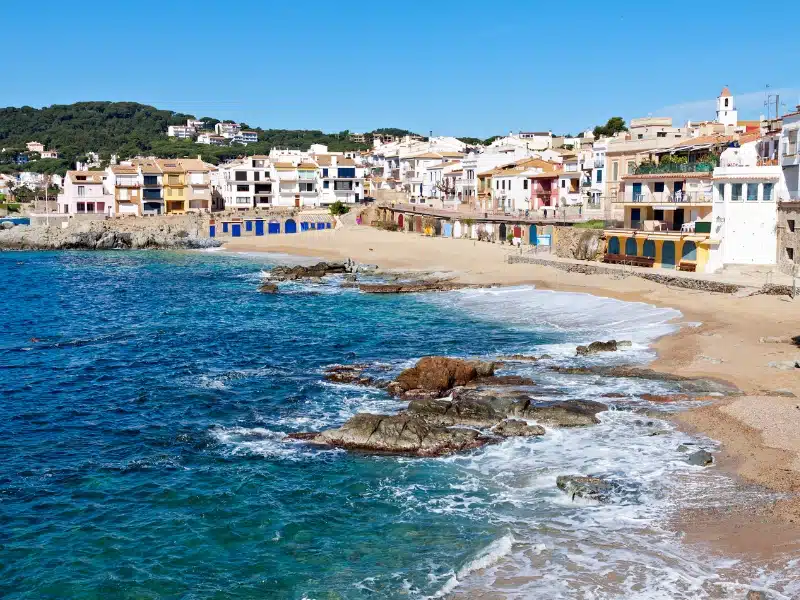
Don’t forget your road trip essentials! Our free road trip checklists help you remember everything, including road trip snacks , podcasts , and road trip songs for the journey!
Basque Country & Pyrenees
San Sebastián – Bilbao – Pamplona – Torla Ordesa – Ainsa – Zaragoza – Barcelona or Madrid
- Distance: 962km
- Drive Time: 12 hours
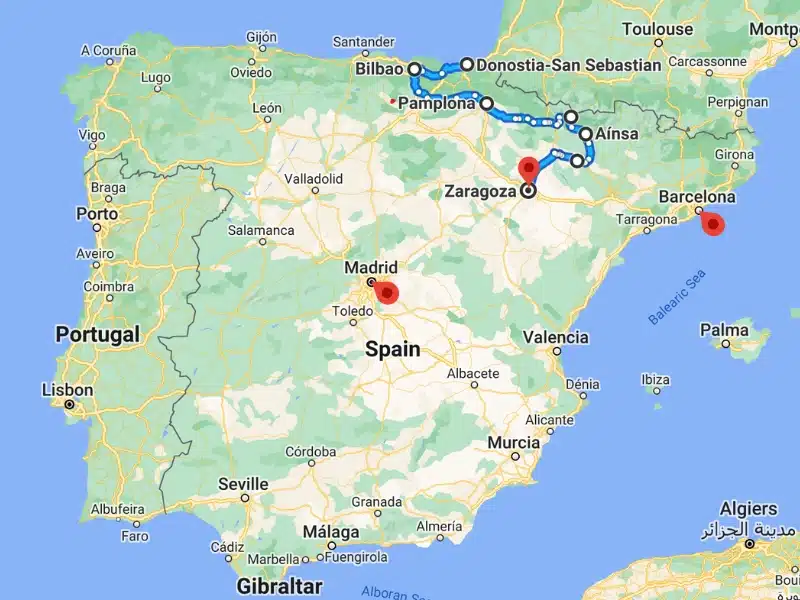
This northern Spain itinerary takes in the cities and coasts of the Basque Country, and the magnificent Pyrenees mountains that extend for more than 400 kilometers between Navarre, Aragon, and Catalonia, and create a natural barrier between the Iberian Peninsula and the rest of continental Europe.
Start in Donastia-San Sebastian, the jewel in the crown of the Basque resorts. A picturesque city with fabulous beaches, San Sebastian is perhaps best known as a foodie town, with some of the finest restaurants in Spain gracing its leafy boulevards and squares of the city center.
Bilbao makes a natural next stop and now rivals Donosti, as it’s known locally, as one of the top coastal cities in Spain. The beautifully curved and sweeping architecture of Museo Guggenheim and the fine Basque cuisine and freshly caught seafood served in its lively restaurants and bars make Bilbao a worthy stop.
In the northern Spain foothills of the Pyrenees, Pamplona is a town with a compact and enticing casco antiguo and a hulk of a citadel to visit. From its powerful fortress city history to the modern-day Fiestas de San Fermin (Running of the Bulls festival), this city is as swashbuckling and red-blooded as they come.
Visit in early July for the festival and nine days of riotous partying and entertainment, but book early as thousands of visitors descend and everything gets booked up at least nine months in advance.
From Pamplona, the mountains are enticingly close. Torla-Ordesa is the nearest village to the breathtaking Ordesa y Monte Perdido National Park where you can explore lush meadows, gushing waterfalls, and incredible gorges formed by glaciers millions of years ago.
The best way to see all this natural beauty is to hike the Circo do Soaso, a Pyrenean cirque that surrounds the vast Ordesa Valley. With sheer walls stretching up the 3,355m peak of Monte Perdido looking down, and over twenty cascades along the tumbling Rio Arazes to accompany your hike, this will undoubtedly be the highlight of your Pyrenees road trip.
Capital of the old kingdom of Sobrarbe, which became part of the kingdom of Aragon in the 11th century, Ainsa is a fantastic example of medieval city design and has the best views back to Monte Perdido from the preserved citadel.
From here, it’s south to Zaragoza, famous for the Baroque Nuestra Señora del Pilar basilica, a pilgrimage site with a shrine to the Virgin Mary and the Mudéjar-style Aljafería Palace, an 11th-century Moorish palacio. Together with La Seo Cathedral, the Mudéjar architecture of Aragon forms a UNESCO World Heritage Site.
And now you have a choice! From Zaragoza, it’s almost equidistant to Madrid or Barcelona, give or take 10km. So, Spain is now your oyster and you can go south for the museums and classical architecture of Madrid, or east for the laid-back vibes of Barcelona.
- Arriving at the Cola de Caballo horsetail waterfall at the far end of the Ordesa Valley, and having lunch under the mist.
- Sample the Basque seafood cuisine, like baked spider crab and clams marinière in the old town of San Sebastian.
- Watch the bulls (from a distance!) get a fair chance at Pamplona’s Fiestas de San Fermin.
San Sebastian ⇒ Zenit Convento San Martin for its central location, stylish decor, and rooftop pool.
Pamplona ⇒ Pamplona Catedral Hotel for its beautiful design, friendly customer service, and very comfy beds.
Zaragoza ⇒ Hotel Sauce for cozy rooms, great location, and exceptional homemade breakfast in their bakery.
RELATED POST: How to Hike the Circo de Soaso and Ordesa Valley
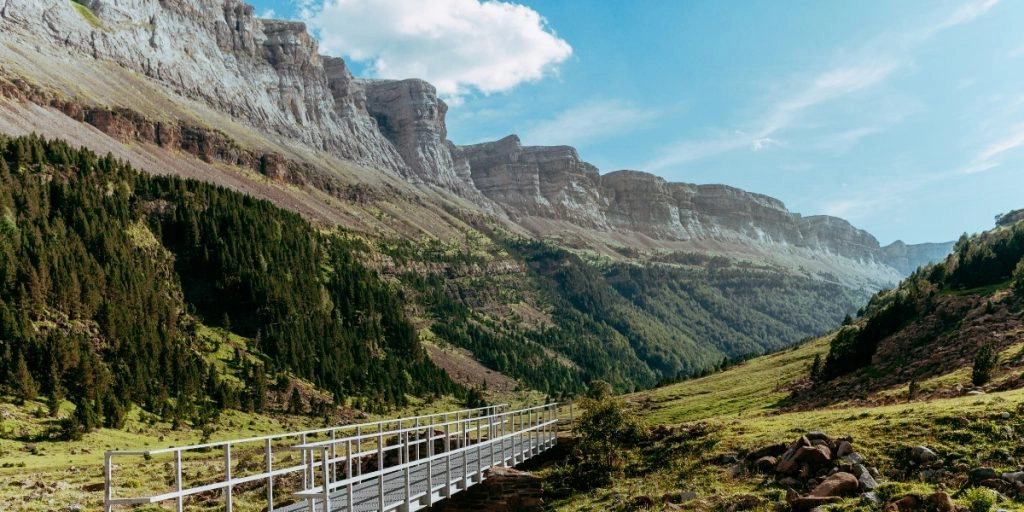
Malaga – Marbella – Ronda – Cadiz – Jerez de la Frontera – Seville – Antequera – Cordoba – Granada – Malaga
- Distance: 1041km
- Duration: 10-14 days
- Drive Time: 13 hours
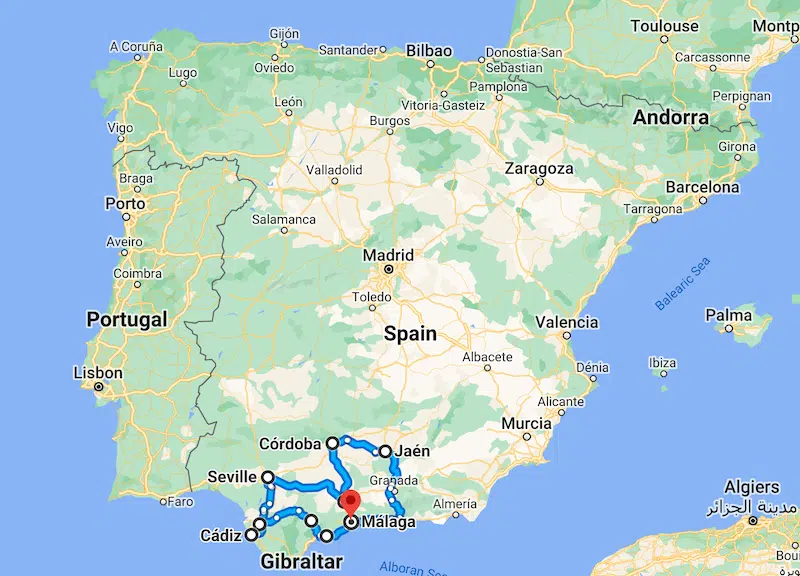
Andalucia in the south of Spain is the quintessential Spanish region and is home to some of the most colorful and vibrant cities in the whole of the country. Heavy with Moorish influence, evident in the fantastic food and historic architecture, the cities of Andalucia are a feast for the senses.
This south Spain road trip starts on the Costa del Sol, in the lively coastal city of Malaga , which comes to life on the seafront. A favorite place for Malaguenos to go for a stroll post siesta , a fiercely protected custom in the south of Spain, the seafront comes alive after 5pm. You’ll find whole families out, enjoying the sunshine and stopping for a beer and tapa along the paseo .
From Malaga, the seaside resort of Marbella beckons, where you can spend a day soaking up the sun on one of the three immaculately kept sandy beaches and enjoying the people-watching before visiting the charming old town. Head for Plaza de los Naranjos at the center of the Casco Antiguo and enjoy a coffee whilst watching the world go by. For lunch, find Taberna Casa Curro Marbella where you’ll enjoy great tapas and fruity Spanish wine.
Up next is beautiful Ronda, surrounded by the dramatic mountains of Sierra de Grazalema and Sierra de las Nieves. The drive from Marbella to Ronda is simply stunning, with white villages on every hillside and spectacular views as the road dips and swoops between lakes, valleys, and peaks.
Known for its Ronda its arched bridge of Puente Nuevo which spans the 120m deep river gorge of El Tajo, the bridge is best seen from the beautiful La Casa del Rey Moro , where you’ll find lush and fragrant gardens and a spectacular view. There’s also a spectacular bullring here, and whatever your views about the divisive sport of bullfighting, you should visit Plaza de Toros.
Just north of Ronda are the Pueblo Blancos of Zahara de la Sierra and Setenil de las Bodegas. Both are worth visiting, and the latter is known for its whitewashed houses built into the surrounding cliffs and that image, the one with the rock covering half the narrow street and its houses.
The faded splendor of the sea city of Cadiz , one of the oldest cities in Europe, will beguile you. Just across the water in the famed sherry triangle is Jerez de la Frontera, the home of sherry since the 14th century. The nearby towns of Sanlúcar de Barrameda and El Puerto de Santa María are the other points of the triangle.
Make sure to stop for a tour of a sherry bodega for a taste of Spain’s most famous alcoholic drink. Whatever you think you know about sherry, think again!
As well as sherry, Jerez is also famous for its flamenco tradition and is one of the best places to watch the steamy and seductive dance whose name literally means ‘hell-raising’!
Next is hot and steamy Seville, one of the most popular places in Andalucia, if not Spain! Seville boasts the Gothic Seville Cathedral, the imposing Giralda Tower, and the stunning Alcazar, all conveniently clustered together in the historic center, and located right next to the narrow streets of the Barrio Santa Cruz, the heart of Seville’s lively tapas culture offering some of the best plates in Andalucia.
Past the ancient dolmens and lover’s rock of Antequera is Cordoba, known for the UNESCO Mezquita mosque cathedral, which will take your breath away when you step inside for the first time. Meander through the nearby Jewish quarter where you’ll find narrow lanes and pretty squares where many of the whitewashed houses are covered in blooms from window boxes providing the perfect images of this gorgeous city.
Next up is one of Spain’s most underrated cities. Well off the beaten path, Jaén is known for its olive oil production, and its medieval fortresses, including Santa Catalina Castle. The Renaissance Jaén Cathedral houses the Holy Veil which is said to have been used to wash Christ’s face.
From Jaén, it’s a beautiful drive south to Granada, in the Sierra Nevada mountains and very possibly Spain’s most romantic city. The Alhambra, the spectacular Moorish palace sits high on a hill overlooking Albaicin, the old town of Granada, and is the jewel in Andalucia’s crown.
Finish this southern Spain road trip by hitting the Costa Tropical and the seaside resorts of Almuñécar, Salobreña, La Herradura, and Nerja.
- Watching live Flamenco in Seville , passionate, sensual, and a true art form.
- The Alhambra Palace is the most exciting and romantic of all of Europe’s ancient palaces.
- The Mezquita in Cordoba is one of the most spectacular mosque cathedrals in the world.
Malaga ⇒ Hotel Molina Lario for its perfect location, buzzy rooftop bar, and incredible cathedral views.
Seville ⇒ Case del Poeta for its perfect Santa Cruz location, live Spanish guitar gigs, and stunning roof terrace views.
Granada ⇒ the Hotel Santa Isabel la Real for cozy rooms, spectacular Alhambra views, and an exceptional cooked breakfast.
RELATED POST: The Perfect Andalucia Road Trip: Itinerary, Map & Tips
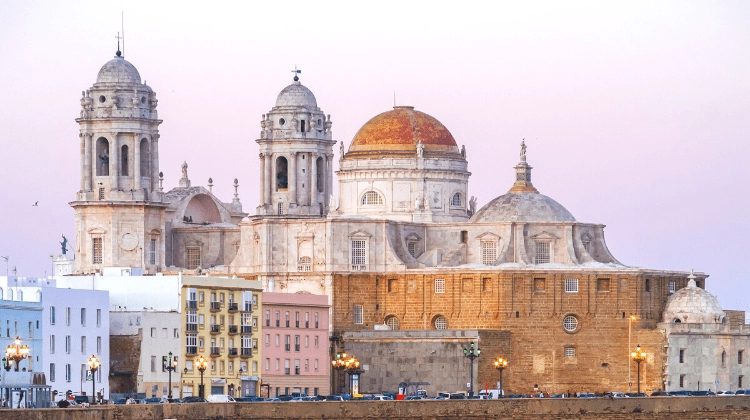
Looking for the best SIM card deals in Europe for your trip? Check out our guide to the best data SIMs in Europe and get the best deal for your trip to Spain.
East Coast Costas
Valencia – denia – xabia – altea – alicante – cartagena – almeria.
- Distance: 553km
- Drive Time: 8 hours
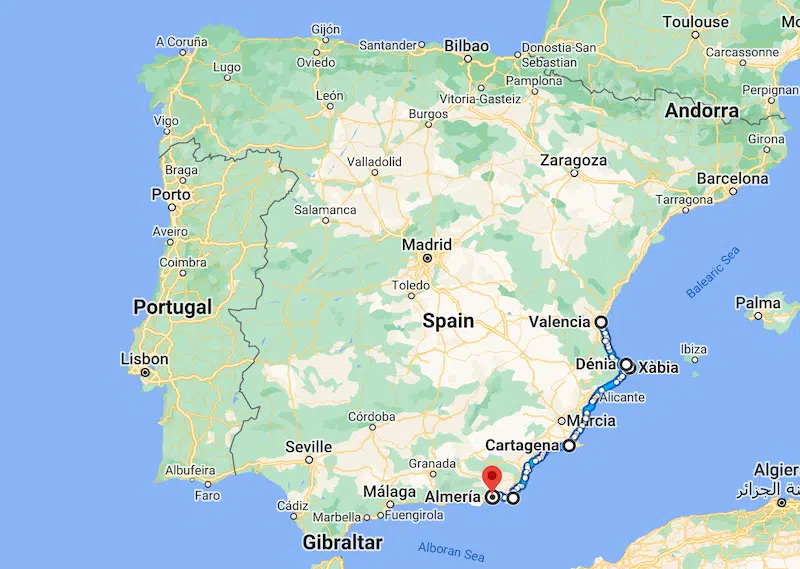
This delightful and easy seven day trip down Spain’s eastern Mediterranean coast bypasses the worst of the high-rise excesses and explores the best of the Spanish Costas, including some you’ve never heard of! Costa de Valencia, Costa Blanca, Costa Calida and Costa de Almeria.
Valencia is a seriously underrated city and is preferred by many Spaniards to Barcelona. The city is much less touristy than Barcelona but has the cultural variety of Madrid and the charm of Seville. Alive with noise and color, the city will surprise and delight you.
Visit Valencia during the fabulous Las Fallas when the city erupts with bonfires, music, and life. Don’t forget to sample a traditional drink of horchata (made from tiger nuts) when you’re in Valencia, it’s not to be missed!
Head south and make for La Albufera, a huge lagoon separated from the sea by a sandbank and surrounded by rice paddy fields, still irrigated by systems installed by the Moors.
An important wetland and the stopping-off point for thousands of migratory birds, the area is also where paella originated, due to the perfect growing conditions for rice. You can take a guided tour through the lagoon on a boat trip, and check out the ‘paella’ villages, including Perel-Lonet, the best place to get a taste of the real thing, not with seafood but with chicken, rabbit, and snails.
Next up is the old port town of Denia, less touristy and ex-pat, and the closest departure point in Spain for the Balearic Islands. From here, you can sail to Ibiza, Formentera, and Palma, to start your Mallorca road trip (if you have a few extra days!).
There’s more to Denia than the port though. Home to a modern marina surrounded by cool bars and an old town lined with fish restaurants and Spanish fusion food, this is a wonderful place for an overnight stop. Check out our favorite, Els Magazinos, for street food Spanish style.
Javea, or Xabia in the local dialect of Valenciano, is a pretty seaside resort close to Cabo de la Nao, a beautiful rocky promontory where you’ll find hidden coves and beaches. Lively in the evenings in summer, you’ll also find a beautiful sandy beach and a pretty old town.
For the best beach in the area, head south by around 5km to Playa la Barraca, a shingle beach with perfect turquoise water and a fantastic seafood restaurant.
Altea is your next stop, a small resort that sits below a historic hilltop village, which has incredible views. The old village is gorgeous with bougainvillea and jasmine in bloom, alongside alleys lined with alfresco dining and interesting boutiques and gift shops.
Bypass built-up Benidorm and head for the very Spanish city of Alicante, with its wide and spacious esplanades and seafront paseo. The renovated old town is a perfect place to stroll and people-watch, especially in the early evenings. You’ll also find good tapas restaurants and bars in this area.
Swing by the pink lake at Torrevieja . Las Salinas Torrevieja is a real sight, with its bubblegum pink water and fascinating history of salt production.
Head south, ignoring the outskirts of Cartagena, and make for the medieval narrow and twisting streets of the old town. The city will surprise you with its eclectic architecture, historic sites, and modern feel.
It’s quite a long drive down this part of the coast but the unspoiled and undeveloped resorts of Aguilas and El Puerto de Mazarron make good stopping points before arriving in the wild and beautiful region of Almeria , one of the driest places in Europe and home to some weird and wonderful landscapes and coastal rock formations, both on dry land and in the surrounding sea.
The Cabo de Gata particularly is a scuba diving hotspot and a kayaker’s and hiker’s paradise, and whales are sometimes spotted along these shores.
- The authentic and vibrant city of Valencia, where there are more Spanish than visitors.
- Exploring the gorgeous Mediterranean beaches of the Cabo de la Nao that are perfect for snorkeling.
- The sheer exuberance of Alicante, with its magnificent beaches and atmospheric old town.
Valencia ⇒ One Shot Mercat 09 for its historic location, rooftop pool, and hip vibe.
Alicante ⇒ Melia Alicante for its stunning views, casual style, and excellent service.
Cartagena ⇒ NH Cartagena for its central location, contemporary style, and welcoming feel.
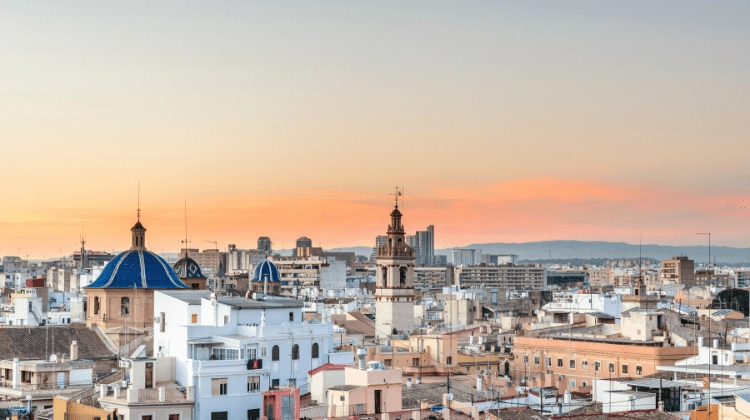
More Spanish Travel Inspiration
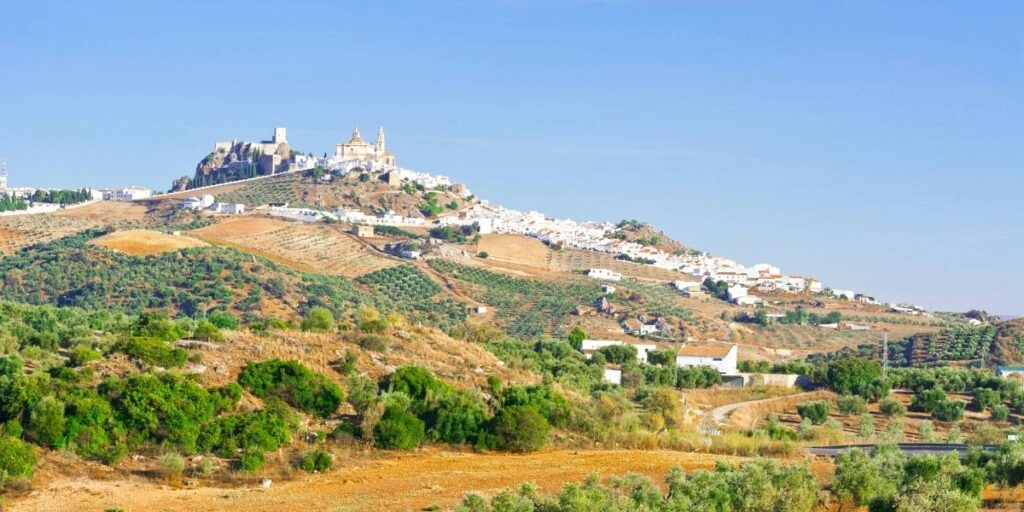
The Perfect Andalucia Road Trip: Itinerary, Map & Tips
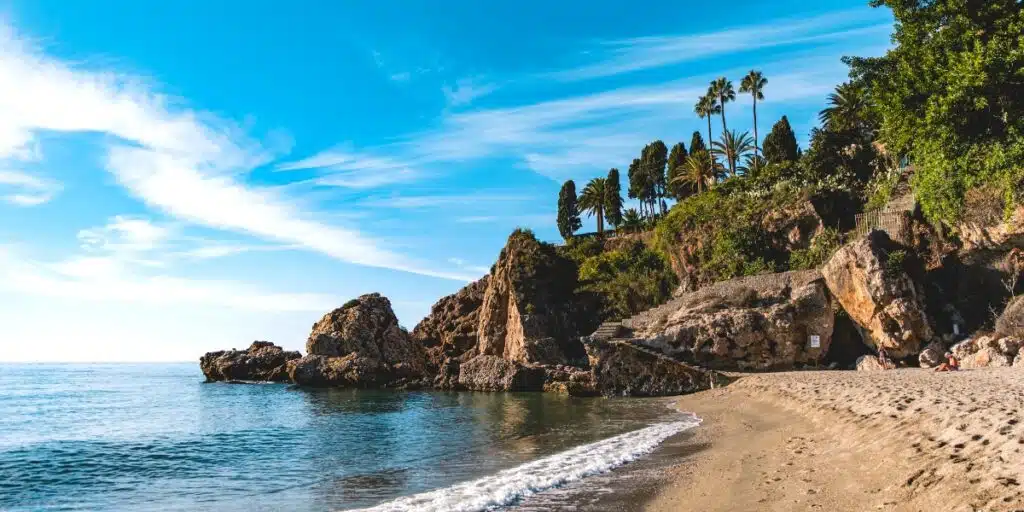
Wintering in Spain: Best Winter Destinations in Spain
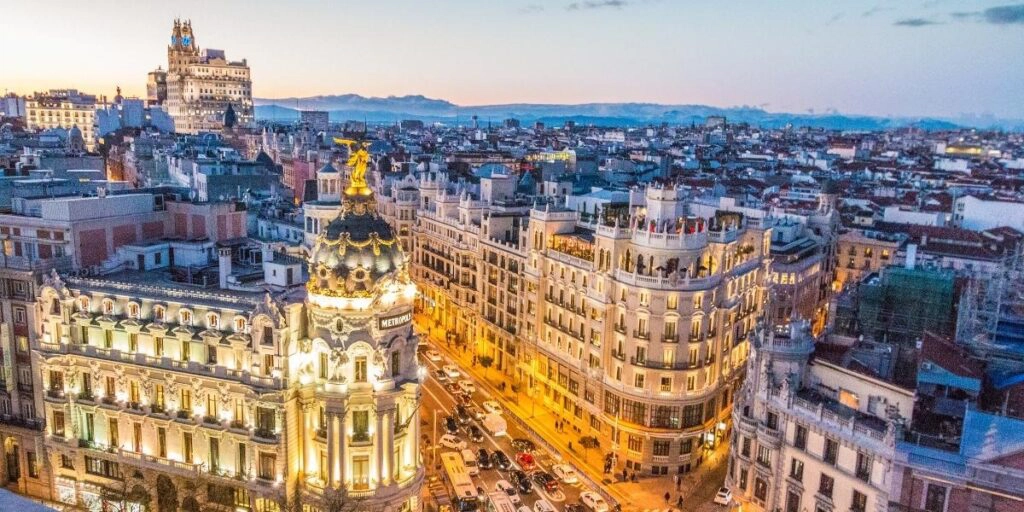
Madrid in One Day: The Best Itinerary, Map, Tips & Guide
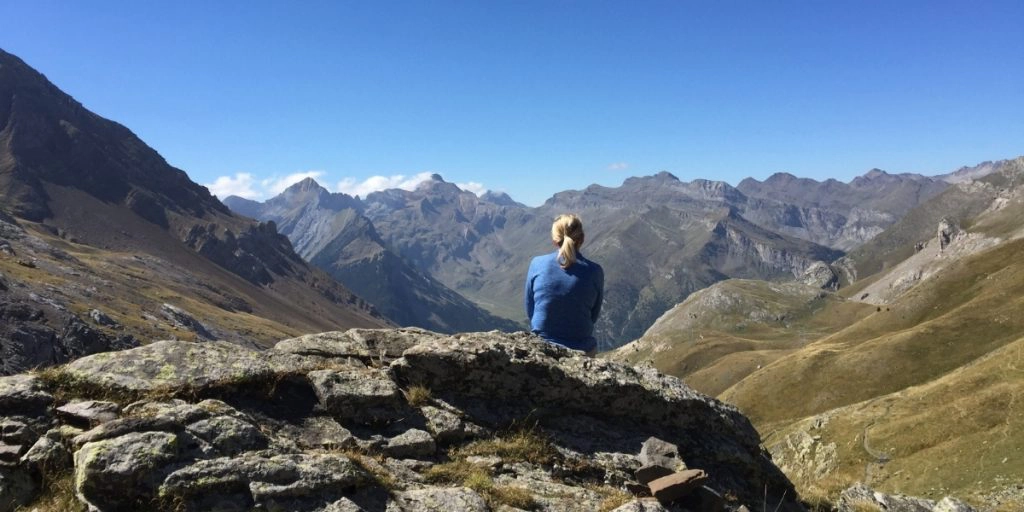
A Seven Day Pyrenees Hiking Tour
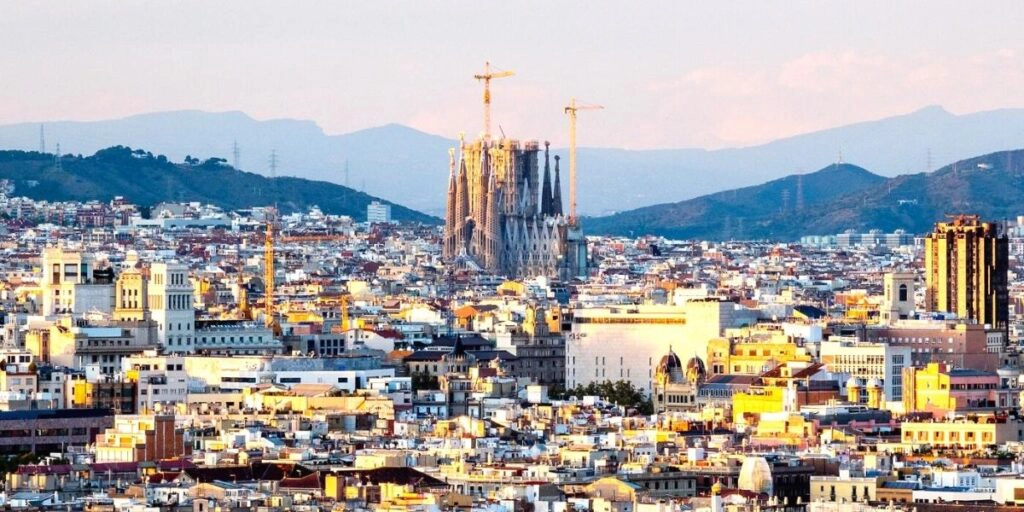
One Day in Barcelona – Itinerary, Map, Tips & Guide
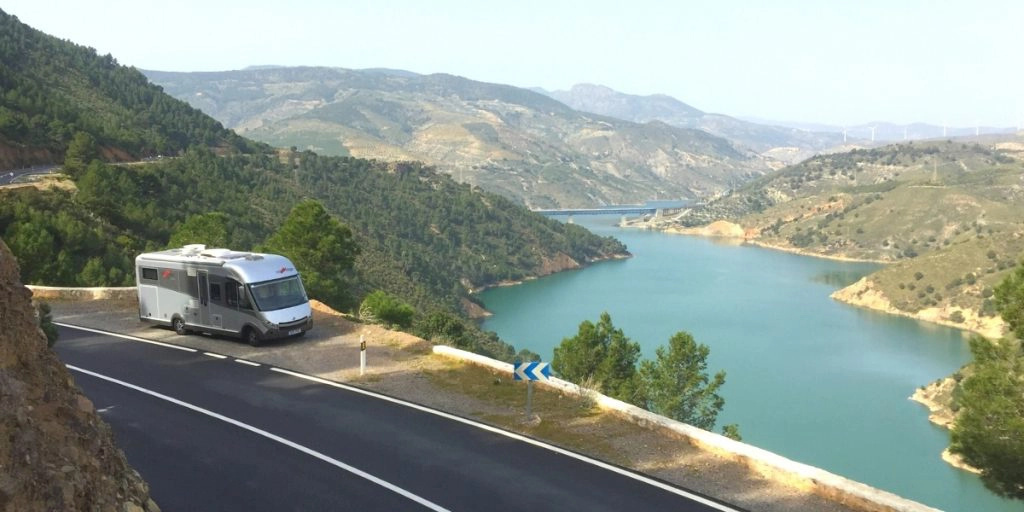
Motorhoming in Spain: Your Complete Guide for 2024
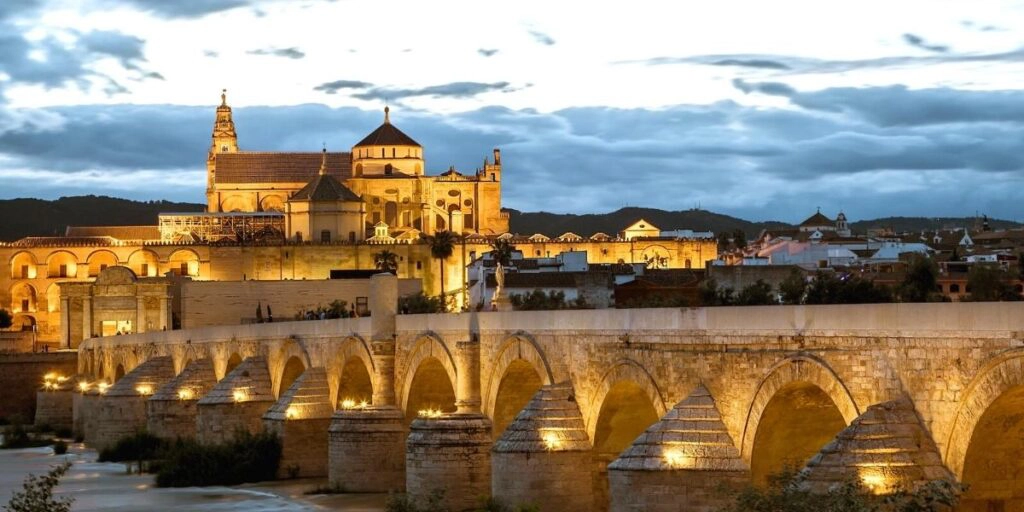
Cordoba in One Day: Itinerary, Map, Tips & Guide
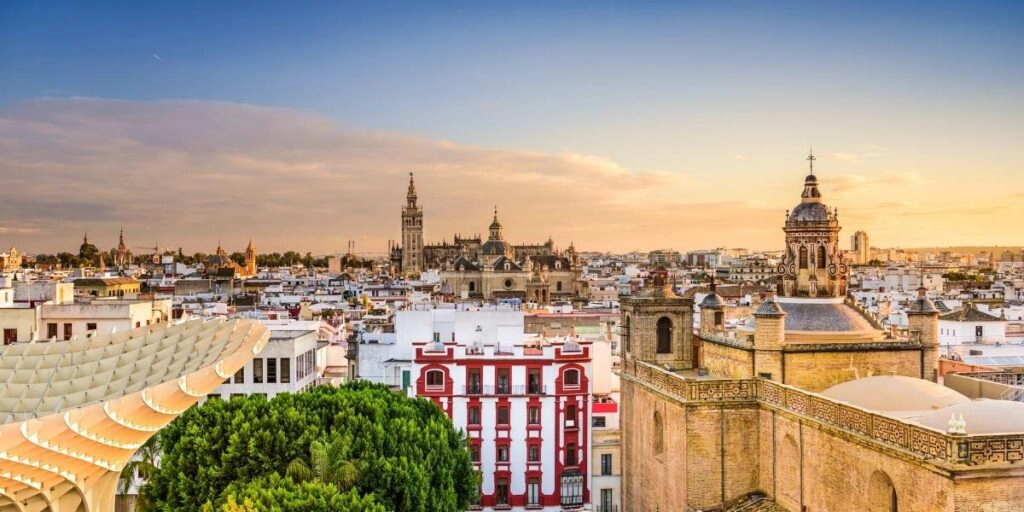
One Day in Seville – Itinerary, Map, Tips & Guide
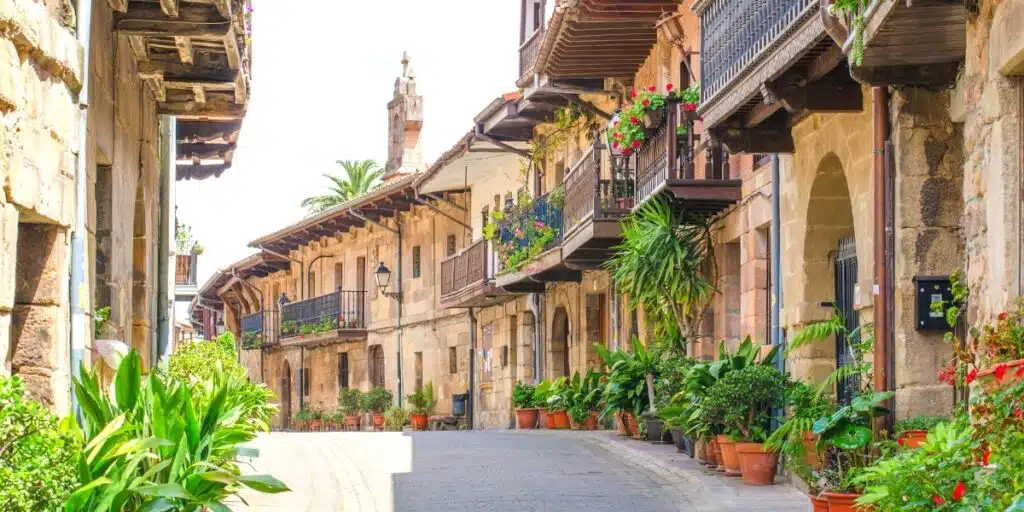
North Spain Road Trip: Itinerary, Route & Tips
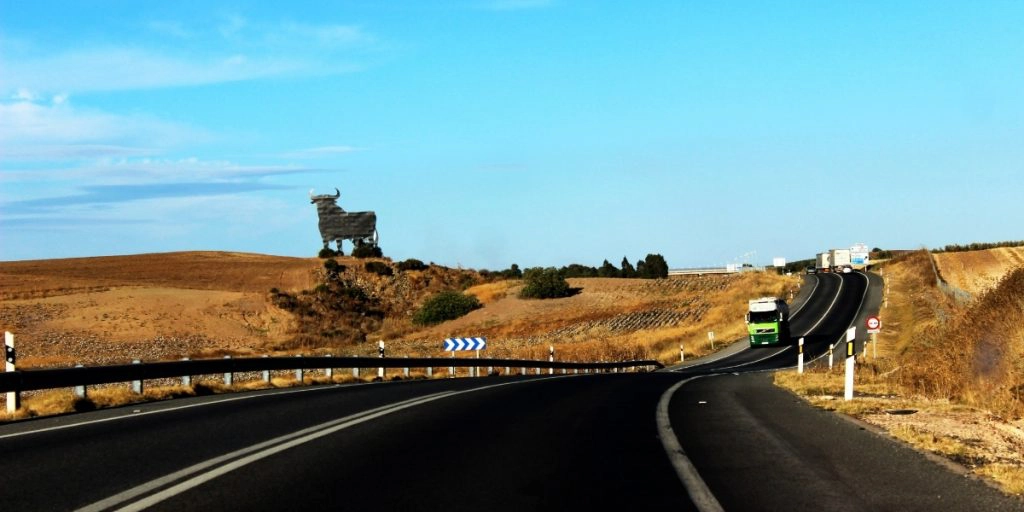
Driving to Spain from UK: Best Routes & Driving Tips
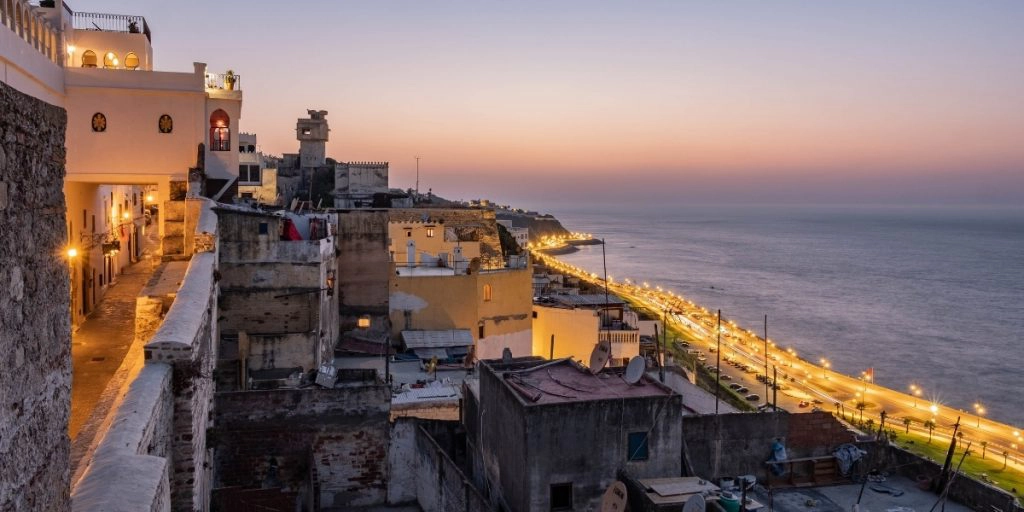
Tarifa to Tangier: Tips & Tricks for a Day Trip to Morocco
Central spain.
Madrid – Toldeo – Cáceres – Ciudad Real – Consuegra – El Toboso – Cuenca – Madrid
- Distance: 1085km
- Duration: 10 days
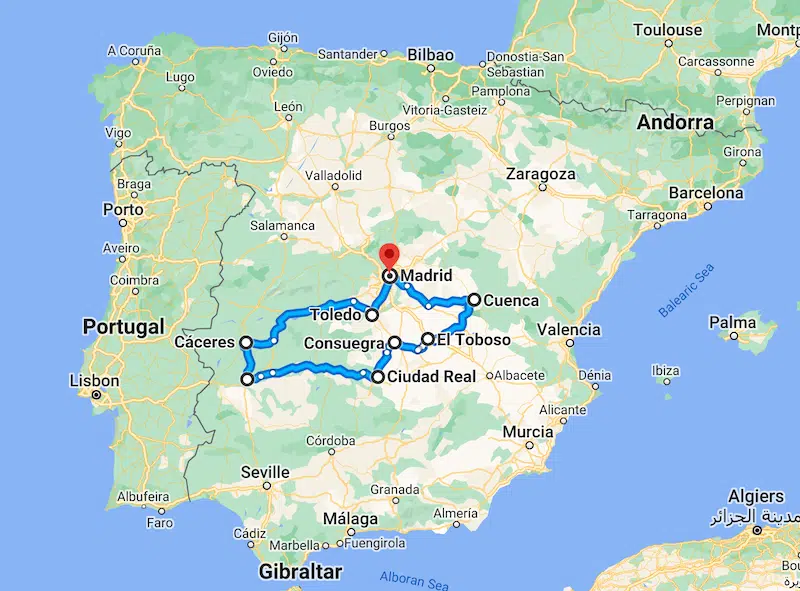
This road trip from Madrid explores the wild and windswept plateau of Castilla-La Mancha and Extremadura, parts of Spain’s interior that are really on the road less traveled. Amongst the hidden gems and architectural surprises expect abandoned villages and huge swathes of, well, nothingness.
For us, the the rolling steppe and vast plains, rich with birdlife and craggy outcrops more than compensate for its remote nature and long hours on the road.
Toledo is up first, and what a start to your road trip! An ancient city set on a hill above the plains, Toldeo is known for the medieval Arab, Jewish, and Christian monuments in its walled old city, giving rise to its name ‘City of the Three Cultures’. There’s also a connection with Hannibal who used extra-hard Toledo steel for his swords in the Punic Wars.
It’s a gorgeous drive through forests and rolling plains to medieval Cáceres, a UNESCO jumble of narrow alleys, castles, palaces, and squares, where it’s easy to while away a few days eating tapas and admiring the olive trees growing in serried ranks across the rolling lands which surround the town.
Ciudad Real is a quick stop to admire the 14th century Puerta de Toledo, one of the city’s original Mudéjar-era gates, and visit the Quixote Museum, dedicated to Miguel de Cervantes’ classic Spanish novel, Don Quixote .
Next up, riding the Cerro Calderico mountain and with the 12th century Castle of La Muela as a backdrop, are the Consuegra windmills, a line of twelve tower mills described in the story of Don Quixote , that are one of the most iconic landmarks in Spain.
Initially built to grind grain, the mills were modeled on the Dutch windmills of the 16th and 17th centuries. These tower mills were passed down through the generations until being retired in the 1980s when twelve of the original thirteen mills were restored and opened as a tourist attraction.
El Toboso is your next stop. Famous for being the hometown of the fictitious Dulcinea, lover of Don Quixote, El Toboso has a great many pretty corners and traditional buildings of masonry and whitewashed walls. Don’t miss the House of Dulcinea, a traditional La Mancha structure from the 16th century, which has been beautifully renovated.
Your final stop before returning to Madrid is Cuenca. Founded by Moors, Cuenca is perched on a limestone spur above the Júcar and Huécar rivers and has a historic Walled Town with steep cobbled streets and medieval castle ruins. Cueunce is most famous for its well-preserved casas colgadas , or hanging houses which are dramatically cantilevered over the Huécar gorge as they cling to the cliffside.
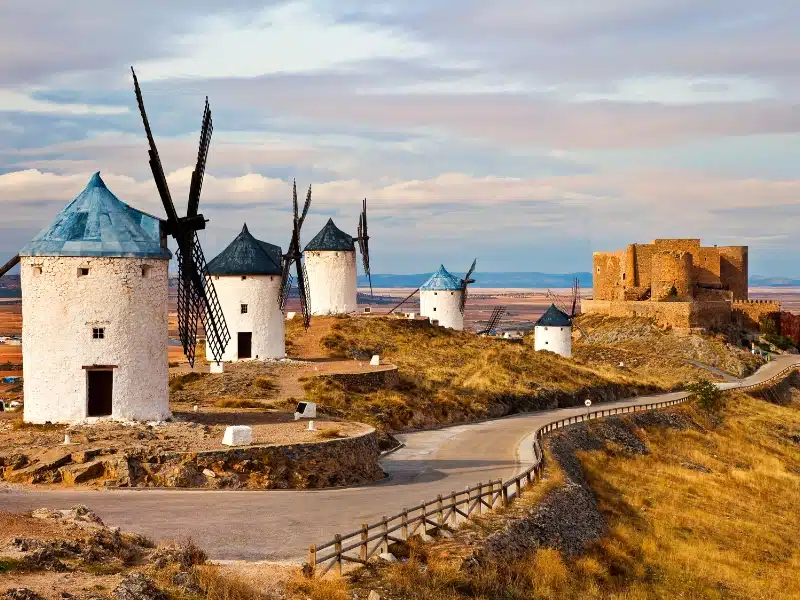
Green Spain
San sebastian – bilbao – comillas – oviedo – a coruna – santiago de compostela.
- Distance: 838km
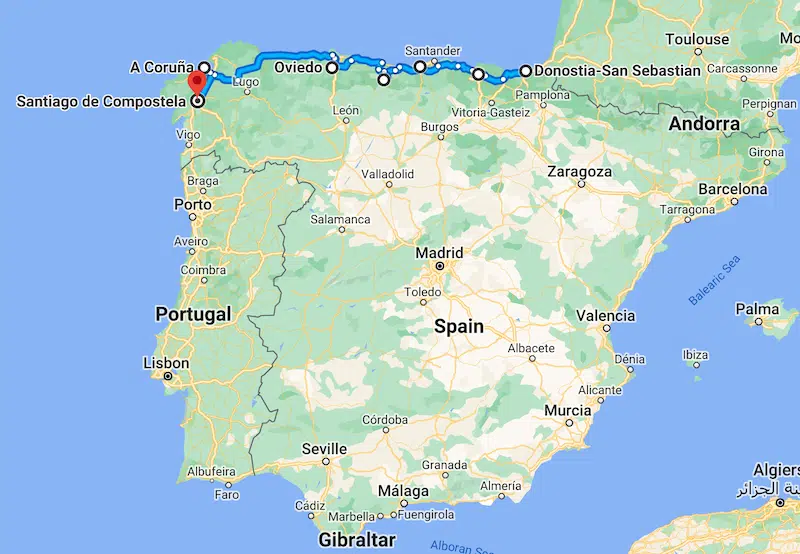
This north of Spain road trip will take you through the beautiful and lush, aptly named Green Spain, hugging the north coast along the Atlantic Ocean.
From San Sebastian through Cantabria, Asturias, and Galicia, you’ll see some of the most picturesque landscapes in Spain, enjoy amazing food, and crisscross the famous Camino de Santiago .
Start in gorgeous Donastia-San Sebastian, the most well-known of the Basque resorts. A picturesque seaside resort with fabulous sandy beaches, San Sebastian is known as a foodie town, and deservedly so. There is a great collection of fine restaurants and authentic pintxo bars here, serving world-class food produced from local ingredients.
Next is Bilbao, home of the incredible Museo Guggenheim and backed by beautiful green mountains. The museum itself is a work of art, with beautifully curved and sweeping architecture.
Bilbao now rivals San Sebastian as one of the top coastal cities in Spain , with its vibrant restaurant and bar scene, and offers fine Basque cuisine and freshly caught seafood in its atmospheric restaurants and bars.
Head west to the stunning Santillana del Mar, known as the town of the three lies. Not holy (santi), not flat (llana) nor by the sea (del mar) . This medieval town is well-preserved and worth a meander before you make your way to Comillas, further along, the coast.
Traditionally low-rise, you’ll find a lovely beach, a tiny fishing port, and a charming cobbled casco antiguo here. If you have a few extra days, head into the Picos de Europa National Park for excellent hiking in the beautiful peaks of this small, but perfectly formed mountain range.
Oviedo is the next stop and the starting point of the lesser-known Camino Primitivo (the oldest Camino). This compact and elegant city is another foodie delight, with a vibrant gastronomic scene.
Home to Spanish cider, you’ll find traditional sidrerías along Calle Gascona, known as Cider Boulevard. Visit in September for Fiestas de San Mateo, a live theatre and music spectacular. If you go in October, you’ll be in the middle of the apple harvest in Asturias, a region in which you could easily spend several weeks .
A Coruña is up next, passing by the spectacular Playa de Las Catedrales en route. The ‘beach of the cathedrals’ is one of Spain’s top natural landmarks and is best visited at low tide , when its possible to walk on the beach and get up close to the fabulous rock formations.
A Coruna is a dynamic city that is home to a busy port, a relaxed beachfront resort, and an atmospheric old town. The seafood here is some of the freshest and most delicious in Spain, with seafood tapas being a specialty. Take a walk out to the Tower of Hercules, a lighthouse that looks nothing like a lighthouse!
Finally, you’ll reach Santiago de Compostela, the end point of the famous Camino de Santiago, and your last stop. As you enter the city, you’ll see pilgrims covering the final few miles and proudly displaying their Vieira, the scallop shell badge that you’ll have seen along your route .
The UNESCO World Heritage Site of Santiago de Compostela is undoubtedly one of the most beautiful cities in Spain, full of labyrinthine alleys, dramatic squares, and historic religious buildings.
There are too many must-sees to list, but consider a walking tour with a local guide if you don’t have much time, you’ll get to see the most important things and learn about the history of the city too.
It’s a hop and a skip from here into tiny Portugal, via fascinating Vigo. Portugal packs a powerful punch with incredible coastlines and vibrant cities and a Portuguese road trip makes the perfect complement to your Spanish road trip.
- Visit the highly recommended Guggenhei m Museum Bilbao and be awe-struck by both architecture and art.
- Explore the cathedral in Santiago de Compostela and make the climb to Las Cubiertas , the cathedral roof, for incredible views of the city and the landscape beyond.
- Walk along the boardwalks at Playa de Las Catedrales and marvel at the extraordinary natural arches and racing sea.
Bilbao ⇒ Hotel Tayko for its minimalist style, hip location, and excellent restaurant.
Oviedo ⇒ Barcelo Oviedo Cervantes for its laid-back vibe, modern decor, and smooth service.
Santiago de Compostela ⇒ Parador De Santiago de Compostela for its history, traditional decor, and HUGE breakfast buffet.
RELATED POST: North Spain Road Trip: Itinerary, Route & Tips
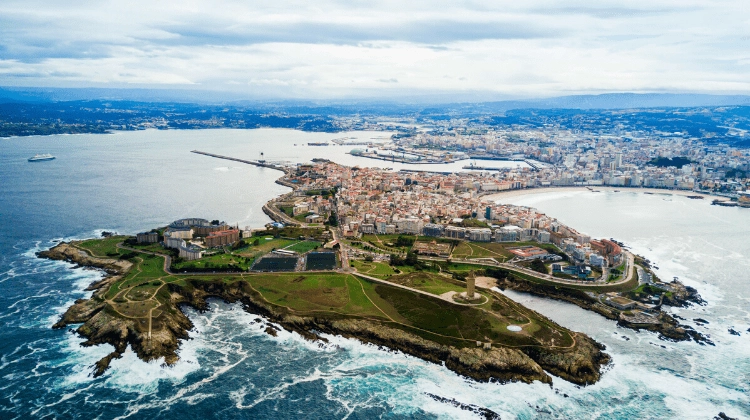
Madrid – Salamanca – Santiago de Compostela – San Sebastián – Barcelona – Valencia – Alicante – Almeria – Granada – Malaga – Cordoba – Seville – Cáceres – Toledo – Madrid
- Distance: 3791km
- Duration: 3-4 weeks
- Drive Time: 38 hours
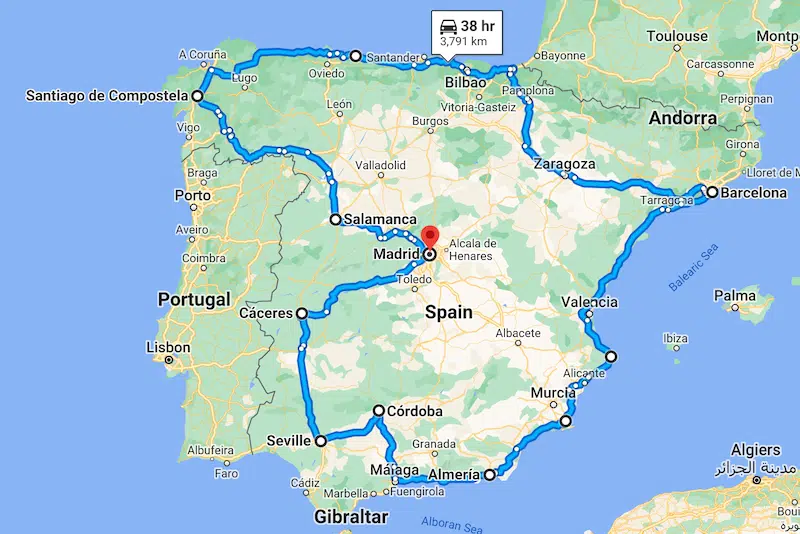
If our seven great driving tours of Spain have whet your appetite but you have a bit more time and want to experience all that Spain has to offer, why not try this combination of all our Spain road trips together?
Stop in the major cities on this eclectic itinerary, and take day trips as you go to see the main attractions along the route. Enjoy local gastronomy, learn about regional customs, and marvel at the variety that Spain has to offer.
From coast to mountains and taking in all the major cities and must-see places, this ultimate Spain road trip will give you the drive of your life and show you the best of Spain in all its wonderful guises.
Want to plan your own road tri p? Get our step-by-step road trip planning guide to help you organize the perfect trip., or check out our favorite road trips in Europe for inspiration.
Planning Your Spain Road Trip
Spain road trip resources.
Here are the websites and services we personally use and recommend for traveling in Spain.
- Search for affordable flights to Spain with Skyscanner
- Search for availability and book hotels and accommodation in Spain with Booking.com
- Find and book the best campsites in Spain with Eurocampings
- Book the cheapest and most reliable hire cars in Spain with Rentalcars.com
- Find and hire your perfect motorhome or campervan with Motorhome Republic
- Get highly rated, reliable, and trustworthy travel insurance with True Traveller
- Check if you need a visa and arrange your documents with Visagov
Best Time to Visit Spain
Spain has varied weather and different climate systems, depending on where you are in the country.
The weather of Spain in spring is just perfect for those who want to enjoy the beautiful climate and it’s no wonder that this is also considered to be one of the peak seasons for travelers in Spain.
From March to May, the weather is pleasantly warm and you definitely won’t need your winter woolies! You may need a long-sleeve top for the evenings, and if you’re visiting the north of Spain, it’s a good idea to pack a cozy fleece or jumper and a waterproof.
A visit in spring also offers the opportunity to experience Easter or Semana Santa . Catholics in Spain celebrate Holy Week through traditions that commemorate the crucifixion and resurrection of Jesus and each day has its special traditions, like processions on the streets and bringing olive branches to church. It really is a spectacle, and best seen in Seville or Granada.
Summers in Spain can be punishingly hot, especially in the south, and there will be a greater influx of European tourists heading to the popular beach resorts and historic cities, although most Spaniards will stay at home during these months.
Lower temperatures in the green north make it a great option during the summer, but be aware that prices for flights, accommodation, car hire, and activities increase everywhere.
Similar to spring, fall sees milder temperatures and fewer visitors, making it a good option for a post-summer break. Spain turns the most beautiful shades of russet and yellow during fall and hotels and other accommodation are reasonably priced at this time.
Winter temperatures are where the extremes really show. Northern Spain may see snow and Madrid in winter can be super cold, just as Malaga is one of the hottest winter destinations in Europe with the sea warm enough to swim in!
This is also a good time for budget travelers to plan Spain trips as prices tumble and there are real bargains to be had. Avoid the north and Pyrenees though, which regularly see snow in winter.
RELATED POST: Autumn in Europe: 23 Stunning Destinations for Fall
Fiestas in Spain
Right across Spain, from the largest cities to the smallest villages, fiestas or parties, are an important annual marker and a great excuse to celebrate life.
Usually held to mark a religious day, these riotous parties are one of the greatest pleasures of traveling in Spain.
The streets are adorned with decorations, street food is prepared, wine flows, and live music is played as people come together. Everyone is welcome; to visit Spain and not join a fiesta is to miss the ethos and spirit of this country entirely.
You can find a fiesta calendar here to help you plan your trip and coincide your visit with the best of them.
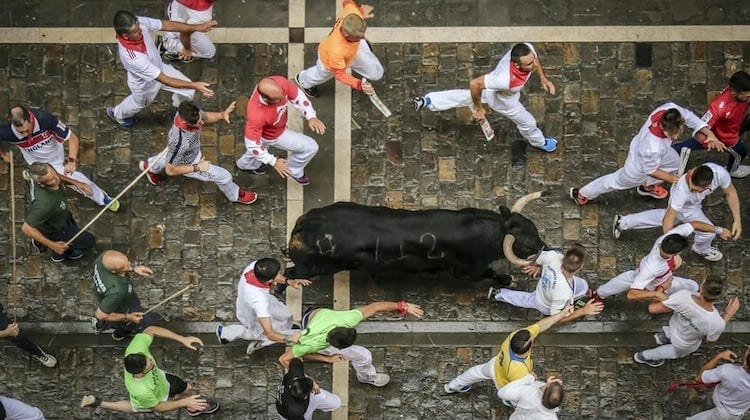
Driving in Spain
Car travel in Spain is easy, with a good network of Autovias (A) and Autopistas (AP). The latter were toll roads until 2020 when many (but not all) became toll-free.
Fuel and car hire are some of the cheapest in Europe making Spain a really cost-effective place to take a road trip.
Touring Spain by car in rural and mountainous areas can take longer than you think although the standard of non-motorway roads in rural areas is generally good. Allow time to get off the beaten track and experience the real Spain as you tour this fabulous country.
Whether you’re driving your own vehicle to Spain or you’re in a rental car, follow our driving in Spain tips;
- You must have at least three months remaining on your passport (issued in the past ten years) at your intended date of departure from Spain.
- You must have at least 3rd party insurance for your vehicle when you roadtrip Spain.
- Citizens of non-EU third countries may require an IDP, you can check here .
- You must carry two warning triangles for the front and rear. These warning triangles are now being phased out and from 1st July 2021, a new law requires that a V16 flashing emergency light is used, although both means of advising other traffic will be legal until the end of 2024.
- You must also carry a reflective jacket (for the driver and all passengers) a spare wheel and the tools to change a wheel or a tire repair kit.
- If you wear glasses you must also carry a spare pair in the vehicle.
- UK cars will need headlight beam converters to be fitted (unless they adjust automatically).
- The use of winter tires in Spain is regional. Look out for traffic signs indicating that winter tires or snow chains are compulsory where you are.
- Anything with a screen (television, video, DVD, etc.) that could distract you when driving should be positioned where you can’t see it. This doesn’t apply to a sat nav but you must not touch or program your sat nav unless parked in a safe place.
- Using radar detection equipment is prohibited under Spanish law and new regulations from January 2021 mean that it will also be illegal to be in possession of such equipment .
- On roads with single carriageways, the speed limit established may not be exceeded by more than 20km/h when overtaking.
- Free parking is almost impossible to find in Spanish cities. A better way is to book a hotel or accommodation with its own parking.
Are you looking for more incredible road trips? Check out these top posts…
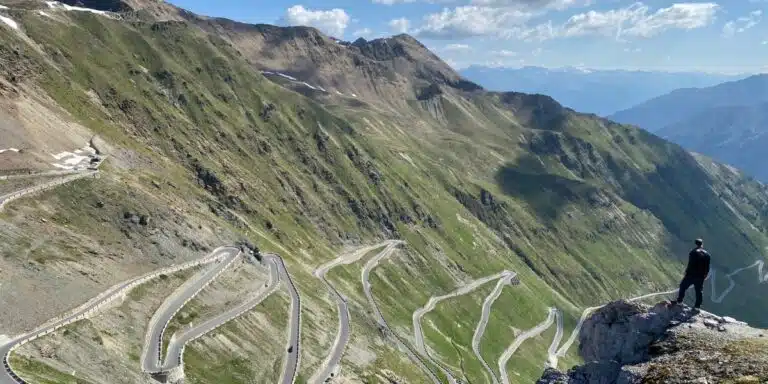
Stelvio Pass: The Best Mountain Road in Italy?
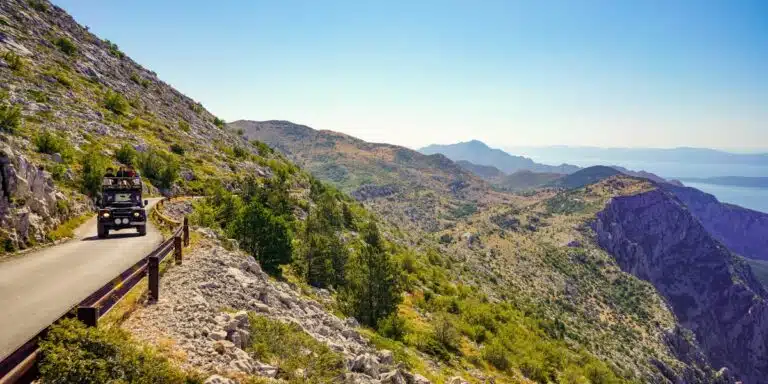
Croatia Road Trips: Five Incredible Routes
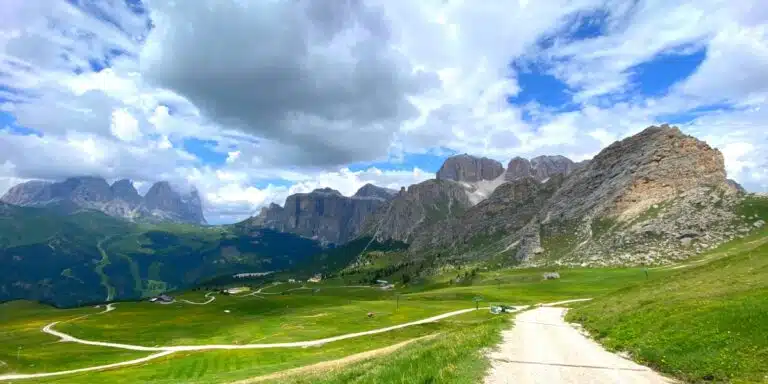
Dolomites Road Trip: Explore the Best of Northern Italy
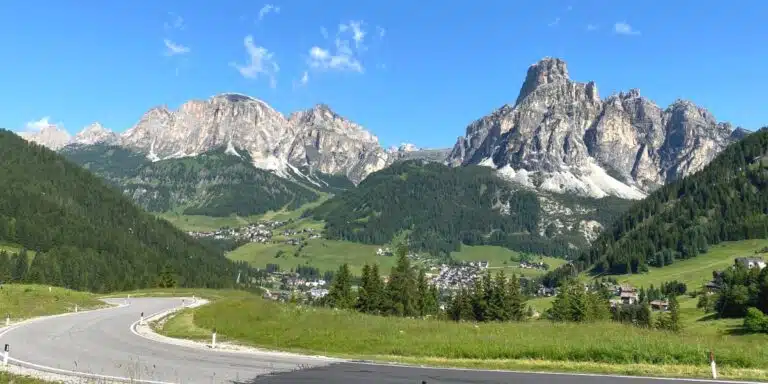
Great Dolomites Road: Absolutely Everything You Need to Know!
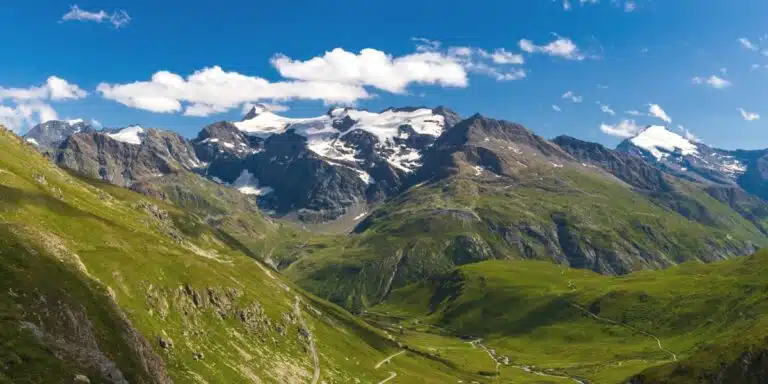
Route des Grandes Alpes: An Epic French Road Trip
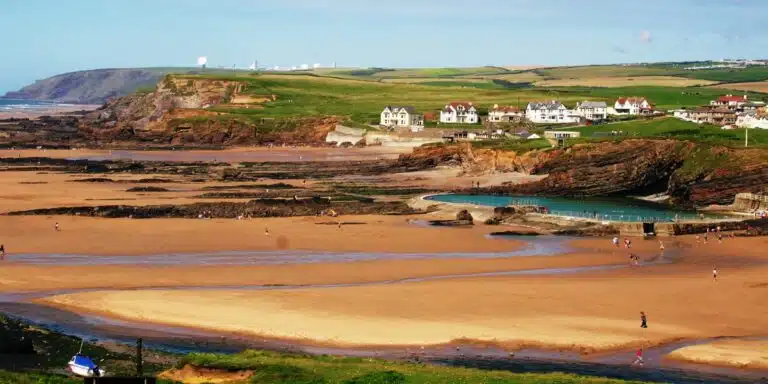
Atlantic Highway: An Epic Devon & Cornwall Road Trip
Love it pin it.
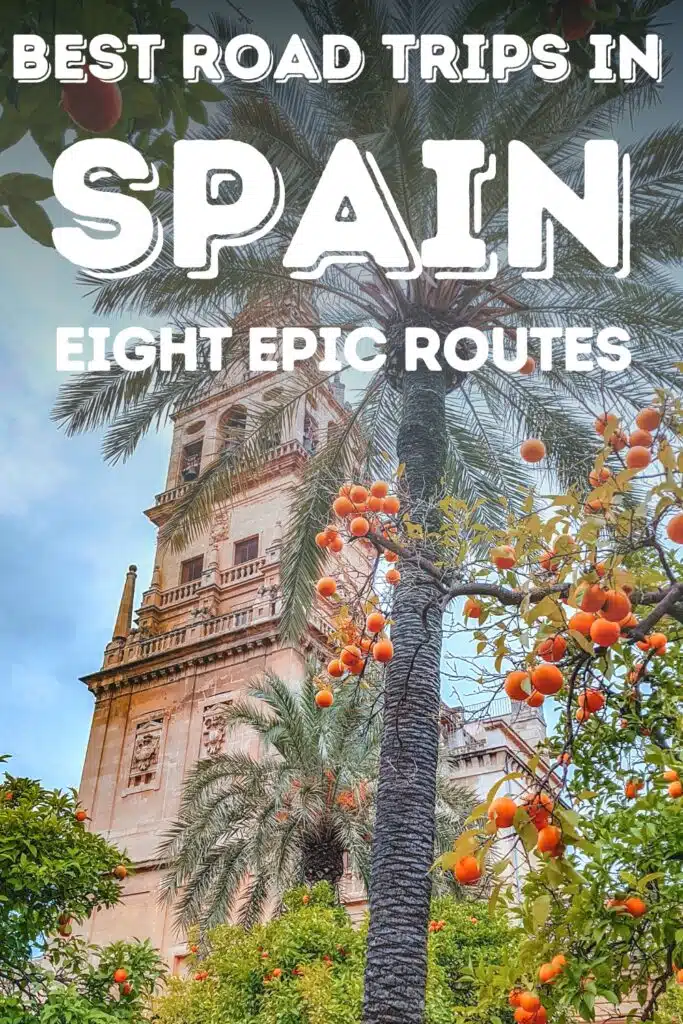

The Best Road Trips in Spain and Their Self-Drive Itineraries
March 11, 2021

From rocky volcanic coasts to medieval city charm, driving in Spain can be an absolute joy. After years on the road as a travel writer and resident, I bring you the best road trips in Spain, plus the ultimate Spanish road trip itinerary. Bucket lists at the ready? Let’s go! Updated 2021.
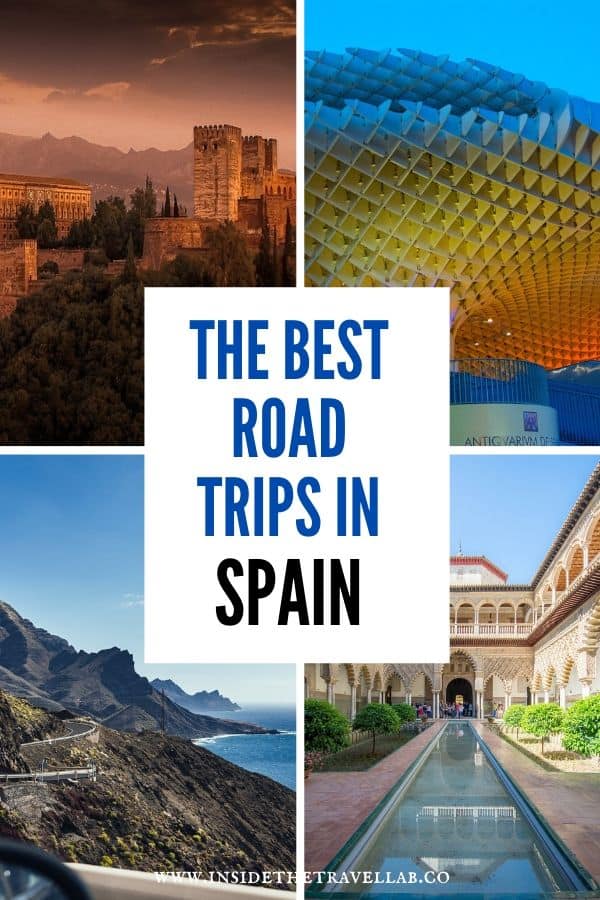
Table of Contents
THE BEST ROAD TRIPS IN SPAIN
If walking is one of the best ways to see a city, then driving is one of the best ways to see a country. Driving in Spain has brought me deep, deep joy, rising through the red dust of Andalusia and plunging through the deep green of Galicia.
You can find the separate road trip itineraries through Spain dotted throughout the article, but this article focuses on the best road trips in Spain.
- Download your free road trip essentials list and road trip packing list.
- Download the road trip planner and toolkit here.
Recommended
I love sharing the best travel resources I can find.
- I never book a flight without looking on Skyscanner first
- My favourite one stop shop for airport transfers, food tours & excursions is Get Your Guide
- Out of the big accommodation machines, I use Expedia and Booking.com the most
- I’ve hand-picked useful travel gear and tools for you in my Amazon shop . Never leave home without a travel adapter or collapsible water bottle . I’d also recommend these soft ear plugs and a sleep mask .
- Access all our planners and budget spreadsheets in the Travel Toolbox ©
- Plan the perfect road trip with our Road Trip Planner & Toolkit ©
- Use these packing cubes to make life so much easier on the road.
- Save on mobile phone roaming charges with an eSIM from Airalo .
TRAVEL SPAIN BY CAR
We start with the ultimate Spain road trip itinerary, taking in the mainland for first time visitors. But don’t forget Spain’s islands, not to mention delving deeper into the regions to find a richer, more authentic experience when you have more time.
Whether you call it fly-drive, self drive or want someone else to help you travel Spain by car, this is the collection of the best road trips in Spain.
Happy planning!
The Ultimate Spain Road Trip Itinerary
If all you have is two weeks, then this is the best Spain road trip itinerary for you. This two week self-drive Spain itinerary brings you the highlights of the country at a reasonable, but not relaxed, pace.
However, I’d always advise that you take is slow if you can. It’s far more enjoyable to spend more time out of the car than in. With that in mind, check out some of the other regional road trip ideas below.
Of all the places in the world, Spain is disinclined to rush. People here like to take their time and savour the joys of everyday life. Racing to fit your busy schedule does not usually rank highly in that regard.
The Ultimate Spain Road Trip Itinerary At a Glance
- Day 1: Arrive Barcelona
- Day 2: Barcelona
- Day 3: Girona and the Pyrenees
- Day 4: Valencia
- Day 5: Valencia to Madrid
- Day 6: Madrid
- Day 7: Madrid to Toledo
- Day 8: Toledo to Granada
- Day 9: Granada and the Alhambra
- Day 10: Alpujarras Mountains
- Day 11: Seville via Cordoba
- Day 12: Seville
- Day 13: Cadiz via Doñana National Park
- Day 14: Malaga to fly home
Historical city centres in Spain were designed for pedestrians and, at a stretch, horses. They were not designed for cars! Be careful when following SatNav instructions into steep, old towns. You can find yourself unable to make some tight turns and then somehow need to reverse backwards down a narrow road. Stick to the main roads in town!
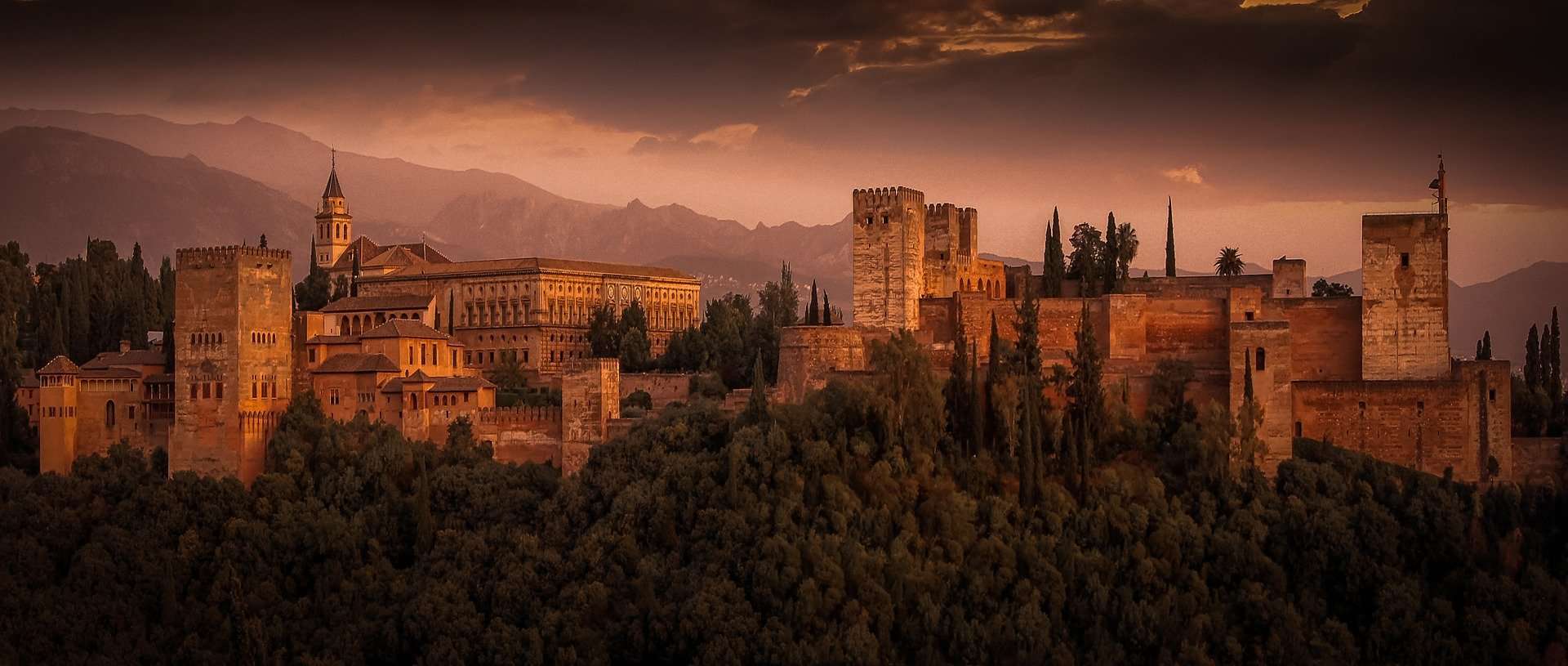
Southern Spain Road Trip Through Andalusia
A road trip through Andalusia, Spain’s biggest region, unsurprisingly covers a lot of ground. This passionate place is the home of flamenco, jamon and sherry, as well as staggering, world-renowned monuments.
You can easily fill two weeks with UNESCO World Heritage Sites like the Alhambra in Granada, the Real Alcazar in Seville and the unbeatable mosque turned cathedral in Cordoba.
But a self-drive road trip through Spain allows you to visit off the radar places and explore local traditions like joining the olive oil harvest in the mountains. From the beaches to the snowy peaks of the Sierra Nevada, driving through Andalusia really is one of the best road trips in Spain.
Andalusia Road Trip Itinerary At a Glance
- Day 1: Arrive Malaga.
- Day 2: Drive to Cadiz
- Day 3: Cadiz to Seville via Doñana National Park
- Day 4: Seville
- Day 5: Seville to Granada via Cordoba
- Day 6: Granada & Alpujarras Mountains
- Day 7: Back to Malaga to fly home. Find the complete southern Spain road trip itinerary here.
- Malaga is the biggest international airport but you can also fly into Seville and Granada with relative ease.
How about the Madrid to Seville drive?
With so many international flights arriving in Madrid, you may be wondering whether or not you should drive from Madrid to Seville or take the train instead.
A Madrid-Seville Road Trip can pass through many off the beaten path destinations, like Zafra and Merida, but in my opinion, it’s not one of Spain’s best road trips.
If you are short on time, I’d highly recommend taking the extremely fast and efficient Madrid-Seville train and then picking up your rental car in Seville to tour Andalusia.
It’s also possible to drive from Madrid to Granada by car, swerving up and down the Alpujarras Mountains, but again, I’d suggest picking up your wheels in Andalusia instead.
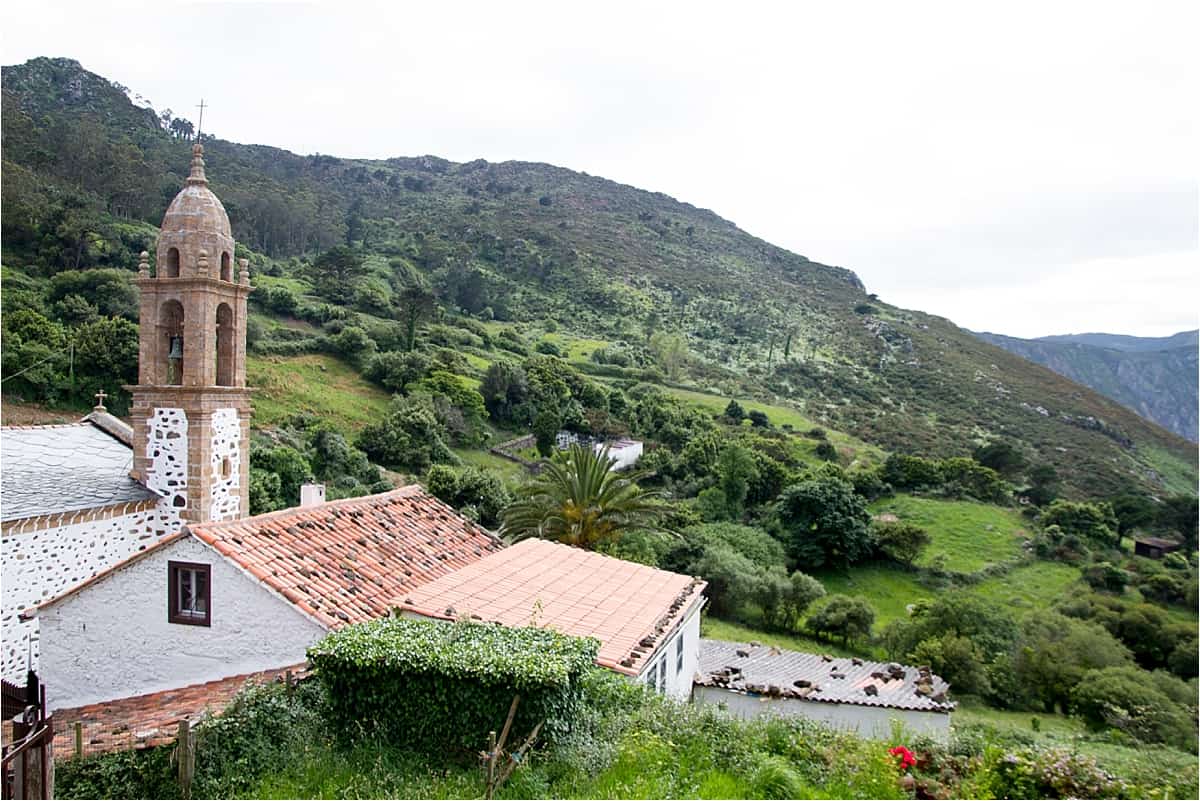
The Sanctuary of Dismembered Wax Body Parts
Northern Spain Road Trip Itinerary
Prepare to be surprised when you find out what makes this one of the best road trips in Spain.
The northern area of Spain swaps dry plains for rocky coves, and bull rings for lighthouses and salt marshes amid the green. Famed for its seafood and as the finishing point for the Santiago de Compostela pilgrimage route, this northern Spain road trip itinerary will show you a different side of the country.
- Want more detail? Explore this Galicia road trip itinerary.
Northern Spain Road Trip Itinerary At a Glance
- Day 1: Arrive San Sebastian
- Day 2: San Sebastian to Bilbao
- Day 3: Bilbao to Aviles
- Day 4: Aviles to A Coruña
- Day 5: A Coruña to Santiago de Compostela
- Day 6: Santiago de Compostela to Vigo
- Day 7: Back to San Sebastian to fly home
Recommended reading: Road Trip Galicia, Spain; The Undiscovered Northern Coast
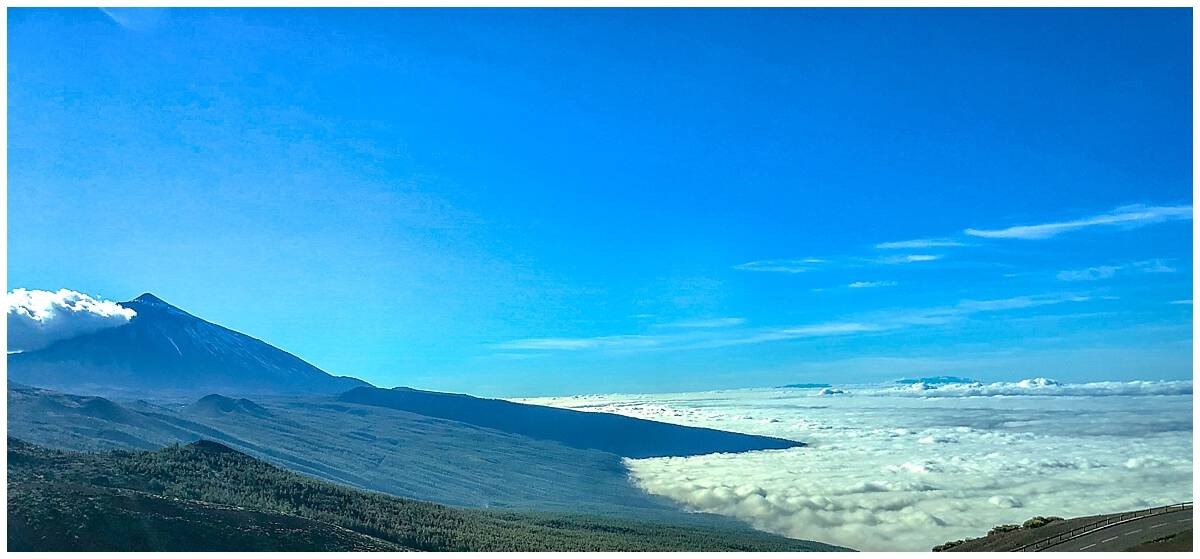
View above the clouds on El Teide in Tenerife
Road Trip Through Tenerife (Canary Islands)
As the largest Canary Island off the northwest coast of Africa, Tenerife is famous for its fly and flop beach holidays. But there are so many unusual things to do in Tenerife , from UNESCO World Heritage cities like Laguna to primitive biosphere reserves in Anaga. It’s a hiking paradise and if tight turns and steep roads don’t phase you, a great wild landscape awaits.
Driving through Spain takes on new and heady heights when you’re bounding over black volcanic stones and watching the clouds appear beneath you. This is one of the best road trips in Spain because it is also one of the most beautiful.
It’s also easy to combine with staying in one place and organising a series of day trips around the island. So if packing and unpacking on a road trip becomes a chore for you, try this instead.
Road Trip Through Tenerife at a Glance
- Day 1: Arrive and stay in UNESCO World Heritage La Laguna
- Day 2: Drive El Teide Volcano
- Day 3: Los Gigantes for a whale watching excursion
- Day 4: Hiking in Anaga National Park
- Day 5: Orotava, Icod de los Vinos and Garachico
- Day 6: Pyramids of Guimar
- Day 7: Explore La Laguna and fly home

Casa Mila: worth it on any Barcelona itinerary
Road Trip Through Catalonia (Catalunya)
Barcelona is the most famous part of Catalunya but to see more of the Catalan character, get behind the wheel and enjoy one of the best road trips in Spain.
Travel by car in Spain to discover the curious city of Girona, the sandy coast of Costa Brava and the smoky peaks of the Pyrenees.
Costa Brava offers volcanoes, sleepy coves and some of the best restaurants in the world. That’s not a boast. That’s actually a validated claim (read more about that here. )
You’ll also find flamboyant artwork from local household name Salvador Dalí, a great spot for a hot air balloon ride and a renewed appreciation for the difference between Catalan and Castilian Spanish.
- How to spend three days in Barcelona, an inside guide
- Unusual things to do in Barcelona
Road Trip from Barcelona At a Glance
- Day 3: Barcelona to Girona
- Day 4: Figueres and Cadaques
- Day 5: Garrotxa Natural Park
- Day 6: Tarragona
- Day 7: Return Barcelona to fly home
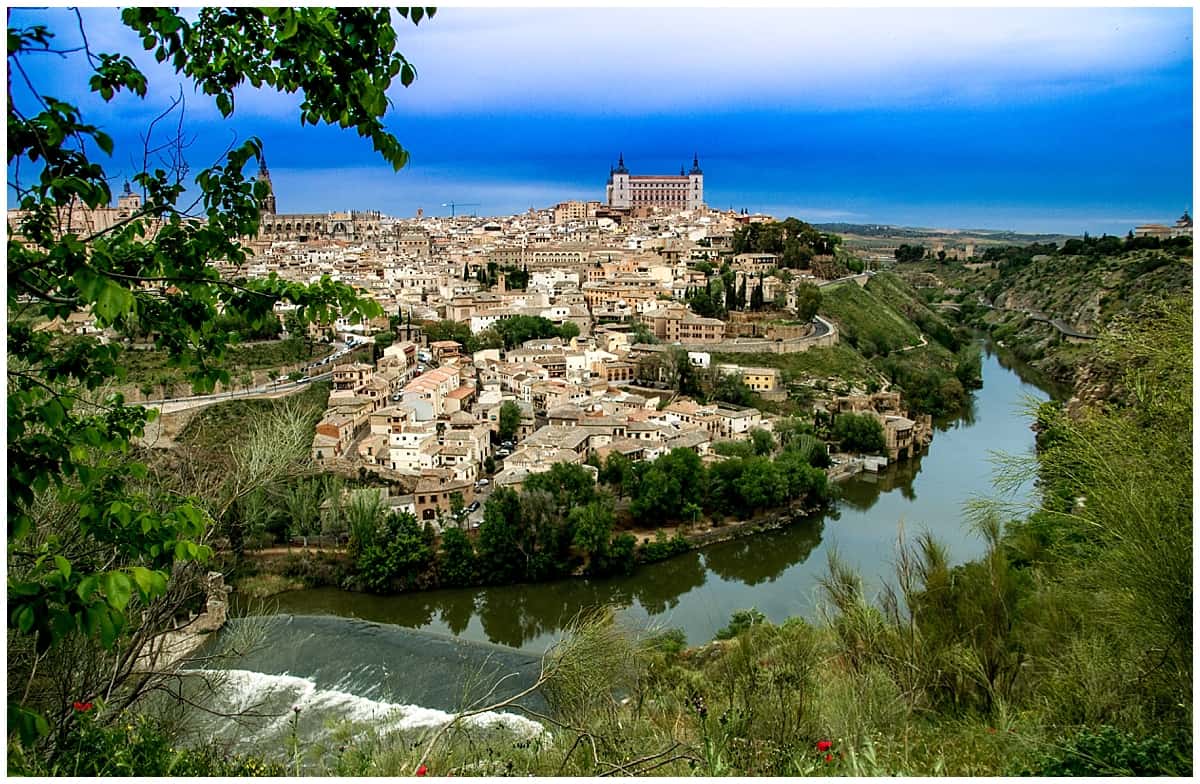
Road Trip Through Central Spain
Treat yourself to a literary, gastronomic and thoroughly authentic journey through this central part of Spain, the region of Castilla La Mancha. It’s one of the best road trips in Spain for hidden gems and a sense of exploration.
Take in Toledo, the former capital and UNESCO World Heritage Site. Search the hills for the windmills made famous by Don Quixote. Hike through one of the best bird reserves in the country. And relish taking your time amid small Spanish villages, far from the crowds.
Road Trip Through Central Spain at a Glance
- Day 1: Arrive Madrid
- Day 2: Madrid
- Day 3: Madrid to Toledo
- Day 4: Toledo
- Day 5: Don Quixote Countryside
- Day 6: Hike through the Tablas de Daimiel
- Day 7: Return Madrid to fly home
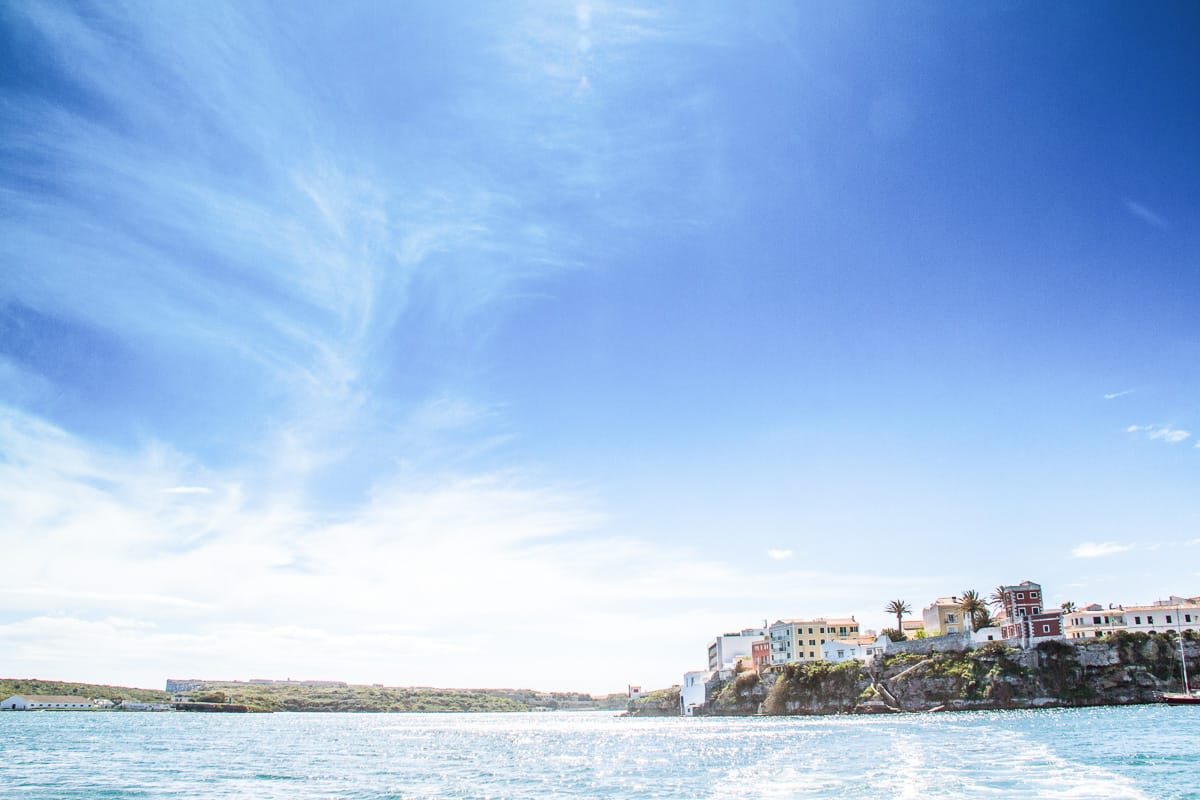
Both islands have stunning coastlines (but this place is Menorca!)
Driving the Balearic Islands
One of the best road trips in Spain involves flying to one of her smaller islands and taking a laid back approach to plans and itineraries all together. Mallorca and Menorca are the two main Balearic Islands and each has a distinctive character. Mallorca has party spots, UNESCO World Heritage and wild hiking routes. Menorca specialises more in family beaches, quiet streets, small towns and an awful lot of gin.
- Menorca or Mallorca for your Balearic Island holiday?
Set yourself up with one home base for a week and take a series of day trips to explore either island.
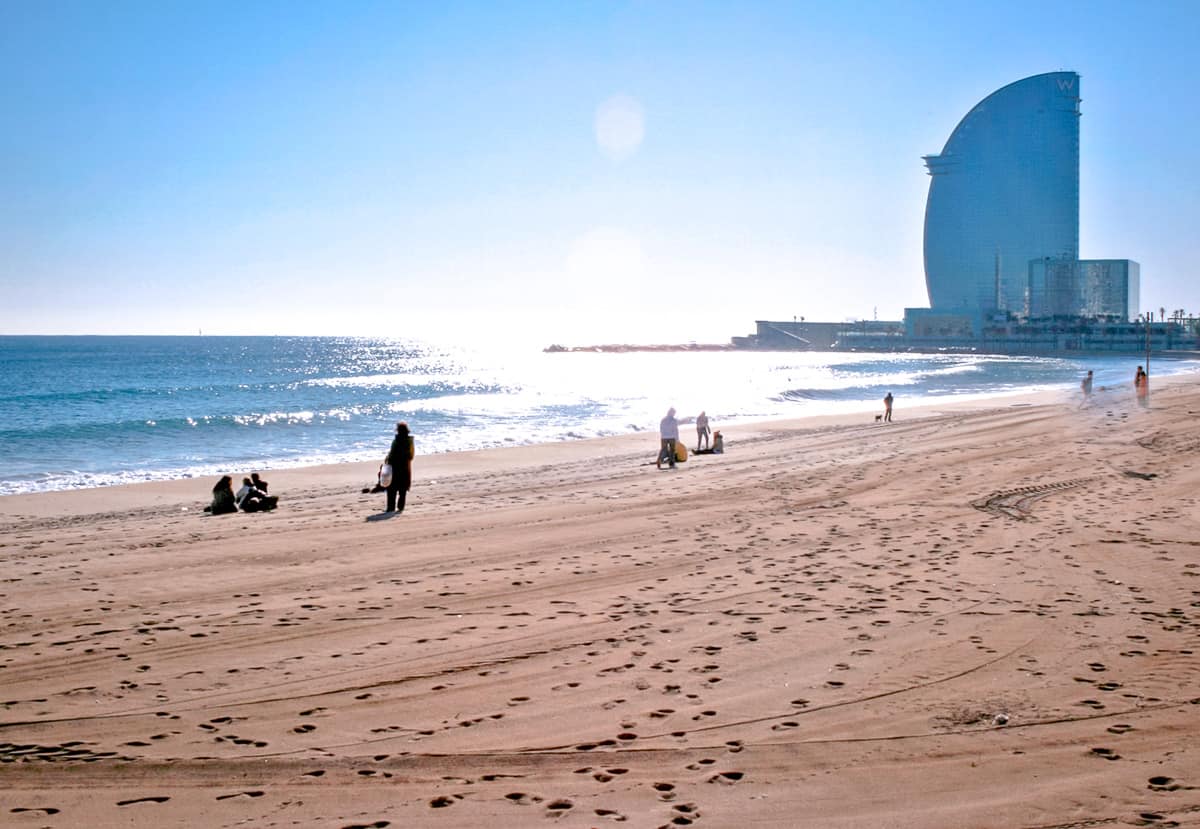
One of the best things about Barcelona is that it leads right onto a sandy beach…
Road Trip Along Spain’s East Mediterranean Coast
Drive from Barcelona to Valencia to experience two of Spain’s most interesting cities and her sparkling coastline as well. Find the Roman amphitheatre at Tarragona and the rice fields that gave us paella outside Valencia. If you have more than one week to ten days, continue south to the Moorish fortress in Amería as part of a road trip through Andalusia.
Road Trip Through the East Coast of Spain At a Glance
- Day 2: Barcelona and Girona
- Day 3: Valencia via Tarragona
- Day 5: Alicante and the Costa Blanca
- Day 6: Almeria and Cabo de Gata
- Day 7: Back to Barcelona to fly home (or to Malaga)
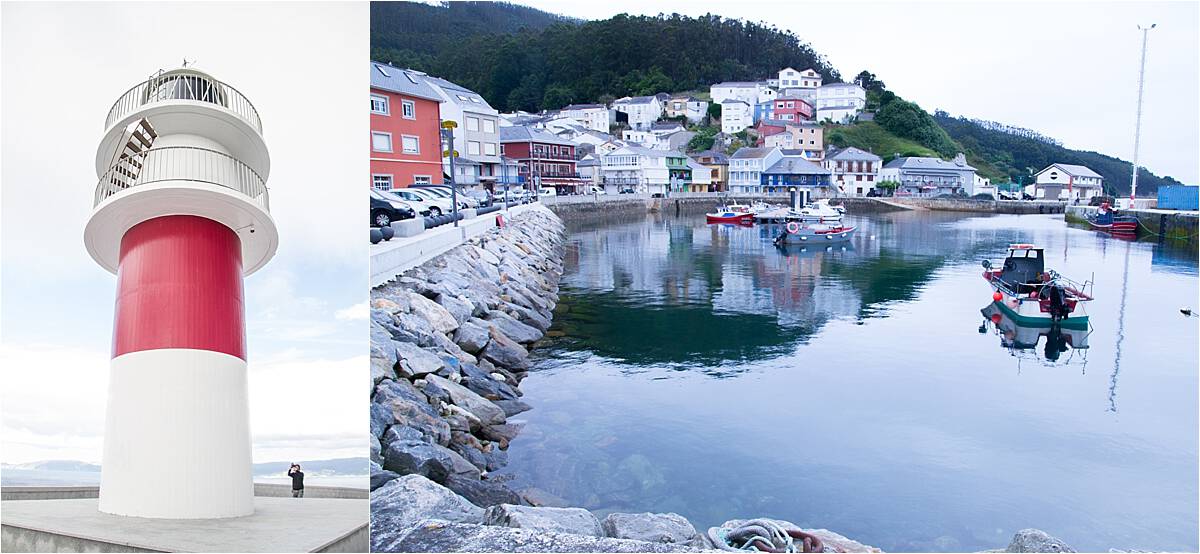
Road Trip Across Galicia
Decked out in deep green hues and bursting with salty seafood, a road trip through Galicia provides a completely different experience of Spain.
With a coastline more reminiscent of the rugged, craggy inlets of Ireland than the white sand of the south, it’s no surprise that Galicia offers seafood to make even the uncertain smile. Expect lighthouses, green fields, great walking routes and great food.
- A Galicia Road Trip: Northern Spain’s Rugged Green Coast
Road Trip Around Galicia at a Glance
- Day 1: Arrive La Coruña
- Day 2: Pontedeume and Redes
- Day 3: Porto do Barqueiro & Viveiro
- Day 4: Praia das Catedrais
- Day 5: Torre de Hercules Lighthouse & home

Road Trip Around the Basque Country
Link up San Sebastián, Bilbao and Santander for an epic road trip through Spain’s Basque country. Taste arguably the best food in the country in the pintxos bars in San Seb and take in the curls and swirls of the Guggenheim in Bilbao.
Add in secluded coastal curves and surprise museums, like the Balenciaga museum in Getaria , and you will find yourself with an unforgettable Spanish Road Trip.
Road Trip Through the Basque Country at a Glance
- Day 1: Arrive Bilbao
- Day 2: Bilbao
- Day 3: Bilbao to Logroño via Pamplona
- Day 4: Logroño to San Sebastian
- Day 5: San Sebastian
- Day 6: Hiking in Getaria
- Day 7: Back to Bilbao to fly home
What to know if you travel Spain by car
Cars drive on the right and you’ll need a full and valid driving license.
Tips for Spain Road Trip Itineraries
If you book through these links, we may earn a small commission at no extra cost to you. Cheers!
Typically, it’s best to pick up a vehicle at at the airport unless you have your heart set on exploring an historic city centre first. Bring your full driving license and book in advance. I’d highly recommend booking your car rental through Hertz.
Planning in Detail
I rely on the AA Route Planner to give me times and directions in Spain. Make sure you check for:
- Tolls (or factor them into your budget anyway)
What You Need to Drive in Spain
For a robust rundown of what you need to drive in Spain head to the Government website . From here you can check the latest recommendations and legal requirements, including information on an international driving permit.
Booking Hotels
Many smaller, boutique hotels in the centre of cities will not have parking options. It’s best to either park on the outskirts of town and walk in (in some places, such as Seville, taxis will struggle to get in as well) or if that’s too difficult for you then book a hotel on the outskirts of town and use their transport to travel in.
Highlights of Driving in Spain
Travel Spain by car and you’ll find all the following benefits.
While the big cities can get the pulse racing, for the most part, driving in Spain is a beautiful experience. Here are five reasons why:
1) THE ROADS ARE EMPTY
Outside the main cities that is. Gleaming wide main roads covered with smooth tarmac are the rule rather than the exception. Drive from Granada to Seville or Segovia to Merida and you’ll hardly see another car for miles.
2) THE SCENERY IS STUNNING
Low swirling mist rising over olive groves, intense sunshine hugging the contours of rust-red rock. Sparkling coastlines and white-washed towns with church towers spiking out of scorched plains. The green cloaked mountains of Galicia, the almond-scented mountains of Alpujarras and the Catalan curves of the eastern Pyrenees. Unlike driving in some countries, these views are visible from the windscreen of the car – you don’t have to wait until you park and get away from the roads.
3) GIANT BULLS ON THE HORIZON
Not real ones, of course. But building-sized, black, one-dimensional bull cutouts. Apparently, these first appeared as part of an advertising campaign for sherry. They were due to be removed until people clamoured for them to stay. Now, they add to the fun, as you never quite know when the next one will appear.
4) FRESH TAPAS AT SERVICE STATIONS
Forget about crisps, biscuits and overpriced coffee. Most petrol stations along the road in Spain are family run affairs with a chef on site. Coffee costs less than a euro while a plateful of patatas bravas, chocos, gambas or more is only a few minutes away. And if you’re feeling too hot? Try refreshing gazpacho instead.
5) FREEDOM AND GETTING OFF THE BEATEN TRACK
For reasons I’ll never quite understand, Spain has a reputation as a sand-and-sea destination and that’s about it. Visitors tend to cling to the coast and never realise just what they’re missing. Hiring a car and hitting the roads is the first step towards fixing that. Stop off in one of Andalucia’s pueblos blancos, for example, and you’ll probably be the only foreigner in town.
And that’s just for starters.
What is the best way to travel across Spain? Road trip or by train?
Great question. And the answer is: it depends.
Driving through Spain is an absolute joy, once you are out of the cities. Road tripping through Spain allows you to reach hidden villages and hike through unspoilt landscapes. It also makes life much easier if you are travelling with your children.
If you mainly wish to city hop between the big cities like Madrid, Barcelona and Seville, then the train is the better option. If you want to get off the beaten track and explore, go for a road trip.
Tools & Planners for the Best Road Trips in Spain
You’re in road trip heaven here, as we have everything from a full list of road trip essentials to the Ultimate Road Trip Planner for people who love freedom and hate spreadsheets.
And just for fun, we have the best road trip quotes and some road trip questions and games to help everyone get along.
Also, check out our road trip planning series on YouTube:
- The 5 biggest road trip planning mistakes people make (and how to fix them)
- The 7 best road trip planning tools.
1 thought on “The Best Road Trips in Spain and Their Self-Drive Itineraries”
The scenery is stunning indeed. I didn’t have to go driving to notice that. It’s wonderful!
Comments are closed.
Search the Site

- Accommodation
The Ultimate Spain Road Trip Itinerary
A road trip in Spain – just the mere mention conjures up images of scrumptious tapas, ambrosial wine , affectionate and fun-loving people, pristine beaches, stunning landscapes, and architecture that spans pretty much all ages.
Today, we take you on a journey from Andalucía in the South of Spain all the way up to Figueres in the North-East with a suggested itinerary for a Spanish road trip that will let you savour the best of what Spain has to offer. Expect to see sights like this:

I would like to add that this was a “birthday trip” for Savi, so the idea was to hit as many carnivals and festivals in Spain as possible. Besides having tons of fun, this also made us see the real Spain and helped us understand local culture.
Spain Road Trip Itinerary
- Day 1: Fly from London to Malaga and pick up rental car
- Day 2 – 4: Malaga and some gems of Andalucia
- Day 5: Drive to Valencia via Granada
- Day 6 – 7: Explore Valencia and get bruised by tomatoes in Bunol and coloured by red wine in Valencia
- Day 8: Drive to Figueres
- Day 9 – 11: Explore Figueres and the surrounding areas
- Day 12: Fly back to London from Barcelona
Total distance : Approximately 2,000 Kms including the day-trips

Malaga and Costa Del Sol (4 days)
Malaga is a party-hub and a popular beach-side resort on the Southern coast of Spain. Popular with British tourists, it’s quite cheap to get to Malaga from London. To avoid the commotion, we opted to stay in an adjacent village called Benalmádena – great choice. The beach was quieter and nicer as compared to the one in Malaga and it was just a short drive from the centre of Malaga.
A major reason for us to fly into Malaga was to attend the annual carnival in Malaga, also known as Feria De Malaga. People take to the streets and the Feria grounds as early as 10 in the morning. There’s wine, there’s tapas, there’s dancing, and there’s a lot of happy people. We spent the entire day and the evening partying with the locals.
Read more about our exploits at the Feria De Malaga (opens in a new tab).
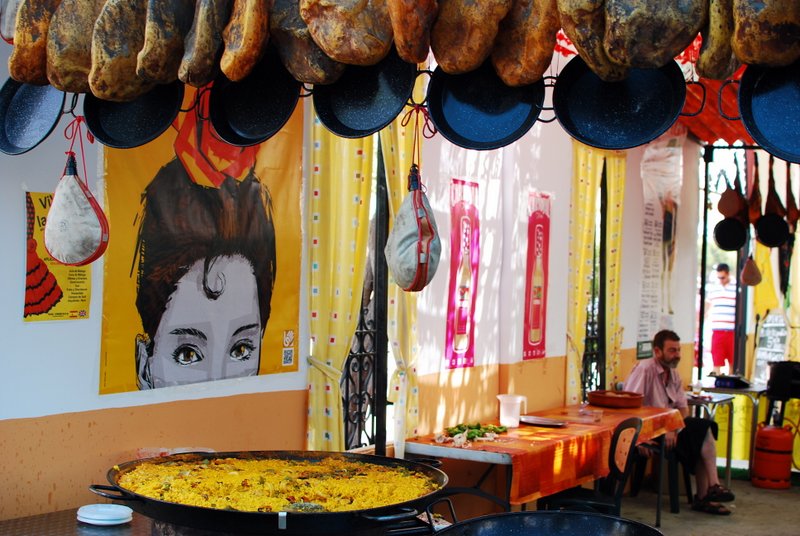
The following morning (what with the hangover!) we decided to enjoy a leisurely Spanish breakfast coupled with a strong cortado (espresso with little milk) and make friends with some locals. Morning well spent, we got into our car, put on our favourite road trip playlist over at Argus, and off we went to explore the surreal rock formations near the quaint village of Antequera. The layered rocks are a sight to behold and the neighbouring village of Antequera is right out of a Spanish fairy tale – cobbled streets, majestic churches, street side cafes, and a towering castle.
Read more about our adventures at the surreal rock formations in Antequera (opens in a new tab).

It’s not possible to visit South of Spain and not visit the mighty Alhambra. Make a day trip out of it, and instead of taking the highway, opt for what is now called the “old road to Granada”. The serpentine road will take you through vineyards, rustic houses, treacherous mountains, and our favourite, Rio Frio, a tiny hamlet which is known for Trout fishing. We’ll be writing a detailed post on this day trip soon, so watch this space.

Accommodation in Malaga
Like we mentioned before, we stayed in Benalmádena , a 20 minute drive from Malaga. The village and the beach were definitely quieter than Malaga, especially in the carnival season. You can compare and book a hotel here .
Valencia and Bunol (3 days)
Valencia is a bustling city and it’s easy to spend a couple of days just walking around countless Plazas (squares), sampling tapas in hidden tapas bars, and sipping on the local drink, Horchata, a traditional beverage made of ground almonds. The highlight of this segment of our road trip, however, was the day we spent in the tiny village of Bunol, made famous by the annual Tomato throwing festival, La Tomatina. Thousands of visitors descend upon this otherwise sleepy village to partake in the biggest food fight in the world. How could we have stayed behind? We can safely say we came out with a lot of bruises and an aversion to tomatoes, at least for the next couple of days. If you can, definitely plan your Spanish road trip so that you can enjoy the madness in Bunol. La Tomatina festival takes place on the last Wednesday of August each year.
If you do make it to Spain during the last week of August, don’t miss out on the wine fight that happens in Haro near Valencia . Participants pour wine all over each other using water pistols, glasses, and buckets at the La Batalla del Vino festival. Expect unending dancing and revelry.
Recommended Reading : Our experience at the Tomato throwing festival, La Tomatina (opens in a new tab).

Accommodation in Valencia / Bunol
We would recommend staying in Valencia instead of Bunol – Bunol is a tiny village and accommodation options are limited. Valencia has tons of places to suit all budgets and needs. You can compare all hotels and book here .
Figueres and Costa Brava (3 days)
Figueres is known for the The Dalí Theatre-Museum , which is the largest surrealistic object in the world and houses the largest collection of Dalí’s paintings and sculptures. It’s easy to spend an afternoon in the museum. Owing to the popularity of the town, accommodation is sometimes difficult to come by, so it’s best to set base in one of the neighbouring quaint villages like St. Miquel De Fluvia.

There is no dearth of picturesque towns in the Catalonian region, Cadaques being one of the most popular ones. For us, however, the medieval town of Besalu and the seaside town of Begur stole the limelight. This region boasts of some of the most spectacular drives and scenery in Spain, not to forget vast expanses of sunflower fields.

On the last day of our road trip, we spent the entire afternoon lazing on one of the hidden ‘Calas’ (coves) that are commonly found in Costa Brava. Looking back on the last 10 days, we realised that we had seen so much, met such amazing people, eaten some of the best tapas, and sampled lush wine. The following day we drove to Barcelona to catch our flight back to London.
Accommodation in Figueres / Cadaques
We stayed in a tiny village called St. Miquel De Fluvia. To be honest, you won’t go wrong if you choose any village/town to stay in this region. If you don’t mind the crowds, then definitely go for Cadaques . If you’d like to be in a quieter place, then look for a hotel or apartment near Figueres .
The next road trip to Spain, this time through central Spain, is currently being planned as we pen this post 🙂

- We opted for self-catering apartments in Malaga, Valencia, and Figueres. The cost was roughly £15 per person per night on an average. You can find more details in our Where To Stay In section .
- Car rental in Spain is cheaper than other European countries. We paid £15 per day for a 5-door economy car from Hertz. There was NO one-way drop-off fee when renting with Hertz.
- There are two kinds of highways in Spain – Autopistas and Autovias. The former are mostly toll roads, so if you want to save some money, use the Autovias which have a lower speed limit.
- All towns and cities are well connected by road and it’s easy to drive in Spain. As always, it’s handy to have a GPS during your road trip, especially if you like to take detours to discover hidden gems like we do.
- For your visit to The Alhambra, book in advance as the tickets run out fast. The combined ticket to Alhambra, Generalife, and the Nasrid Palaces costs around 14.50 Euros per person. Keep in mind that you have to choose the time of your visit to the Nasrid Palaces when booking the ticket, so plan your day-trip accordingly.
- Entrance to The Dalí Theatre-Museum is 12 Euros per person, but in summer, there is an option of a night time visit, which comes highly recommended from us. Tickets for the night time visit cost 13 Euros per person. It’s strongly advised to book in advance.
We have been to Barcelona and Madrid on city-breaks in the past, so we wanted to do a road trip that would take us to some offbeat places in Spain, and this particular itinerary did not disappoint. From grand palaces to barren deserts, from windy beaches to the snow-capped mountains of Sierra Nevada, we saw it all.
If you are planning a road trip in Spain, you can read all our posts about Spain here (opens in a new tab).
If you love driving as much as we do, you should definitely check out our epic Iceland road trip (opens in a new tab). We can guarantee you that you will be tempted to pack your bags and leave for Iceland 🙂
Drop us a line if you have questions about planning and places to visit – we’d love to help. If you have done a road trip in Spain already, share your tips with us in the comments below 🙂

Previous Post
Offbeat London – Alternative Things To Do In London

Visiting Saigon’s China Town – Travel Fashion in Vietnam
151 thoughts on “ the ultimate spain road trip itinerary ”.
I haven’t done a road trip in Spain, but watching “Spain: On the Road Again” has made me long to go on one to last for weeks, driving, photographing, eating (rinse & repeat). Fantastic! I’ll have to keep your post in mind!
Wouldn’t that be amazing ? We would love to spend 3-4 weeks (or more) driving through Spain. We absolutely love Spain !
Hi is Spain a good idea in January around 19-26th jan.. I’m planning to travel for my anniversary
Yes. Spain will be nice in January too, albeit a bit cold.
Spain Spain Spain !!! I so badly want to be a part of the Tomatina festival some day 🙁 🙁
You should go in 2014 – you’ll love La Tomatina. Maybe you can do a similar road trip to what we did 😉
Planning a similar list part of our bucket list.A bit older but looking forward to the adventure
Tell us how it went 🙂
Great job guys! I’ve been longing for Spain for a few years now and have it on my list for the next few years. Will definitely keep this in itinerary somewhere safe for future. Can I ask, how did you find driving in Spain vs driving in the UK?
If you haven’t driven in Europe before, then you might find driving on the other side a bit tricky to begin with. But you soon get used to it. Driving in Spain was fine as long as you stay out of busy cities. Spanish countryside is very beautiful 🙂
Well done! I will add this into our “to-do” list. Looking at all these road trip posts, I am desperate for one. Have you guys ever done a road trip through French alps?
Hey Snigdha,
We love driving wherever we go – we have driven in the South of France in the French Riviera but didn’t go further north. That post will be up on the site soon )
Yes, this is on my to-do list so badly! Great idea for a road trip, thanks 🙂 I’ll be looking to do something like this in the next year or so.
We are sure you’ll have an amazing time in Spain. Everything about the country is gorgeous.
Ooh, fun! Where are you planning to go for your central Spain road trip? I lived for three months in Merida, the capital of Extremadura, a town full of Roman ruins which receives so few tourists it’s almost like you have them all to yourself most of the time. And I had no idea car rental was so cheap there…if only I could remember how to drive!
Car rental was in fact super cheap. So much so that we had to check twice that the rental agency hadn’t made a mistake 😉 We’ll go to Madrid, Salamanco and Toledo. Merida sounds amazing – we’ll definitely factor that in. Cheers for the tip !
In 2008, I met my then 21 year old son at the Madrid Airport. We rented a car and did a 4 night trip that was a loop with stay-overs in Segovia, Salamanca and Toledo (with a day stop in Avila). Between Avila and Toledo, we drove through the Gredos Mountains. This was a reasonable itinerary for the amount of time we had. My son did the driving. I thought it was because he liked to drive. I only learned later that the only thing he hates worse than driving is the thought of me driving.
That is quite a funny story. I’m sure you guys have a good laugh about it now. The places that you visited sound so amazing – we will be covering those on our next road trip in Spain 🙂
Gadhe !Awesome website! Just started going through it to plan my trip to Spain in end-of-June/first-week-of-July for work+leisure.. Too bad I will miss both the bull run and tomatina, but can’t change my travel dates.. 🙁 Expect a lot of queries from my end! :))
Thanks a lot 🙂 Of course – let us know what all questions you have and we’ll help you plan an amazing itinerary for Spain 🙂
and this post goes in my Life’s top 10-to-do list !!!
Priyadarshini that’s a good choice for a top-10 list. It was definitely one of the best road trips we have done.
What’s so great about Spain is that you never run out of things to do. Most of the great stuff is hidden in the small towns anyway! My favorite villages are Mondoñedo (Lugo), Cangas de Onís (Asturias), Garganta la Olla (Cáceres) and my boyfriend’s hometown, San Nicolás del Puerto. Pueblos have the cheapest food, the best fiestas, and the cutest grandpas!
All the villages you mention sound amazing. For our next road trip through Spain, perhaps 😉 I completely agree about the cutest Grandpas 🙂
We love Malaga too – The Carnival of Malaga should not be confused with the Feria which you went to in August. Carnival is in February – Both are great parties!!!
Thanks guys ! Your tips came in very handy. Yes, we are also planning a trip to Malaga during the Carnival in February:) Absolutely loved Malaga and the Feria
I love Spain!! You guys should definitely try going to Seville and Ronda sometime. They’re both beautiful and for Ronda, you can even do just a day trip. We drove from Granada to Seville and took a 4 hour break in Ronda.
We have been to Seville – way back in 2009. We were completely bowled over by the city. It’s one of our favourite places in Spain. We really wanted to visit Ronda on this trip, but since we had to go up north and attend the La Tomatina Festival in Bunol, we had to give Ronda a miss this time. Will definitely go there next time. Thanks for the heads-up 🙂
savi and vid awesome job. Spain has been on my mind for a long long time and this is how we’d exactly want to do it. I am going to keep this bookmarked for future use 🙂 Love the name, the content everything about this site. Thumbs up from me !!
Thanks Sneha 🙂
We loved this road trip through Spain and are planning another one for next year 🙂
Hi guys, great post! I did a 6 day road trip a few years back starting in Malaga and going to Ronda, Marbella, Casares, Granada, Gibraltar, Las Alpujarras and Nerja. I loved Analucia – definitely my favourite part of Spain. The moorish history, mountain towns, hiking and white washed buildings were incredible. Looking forward to reading about your next trip!
Your trip sounds amazing Katie. We love Spain 🙂
the name says it all . Spain seems to be definitely ultimate.. !!! everything from tomato fight to scenic beaches .. all looks amazing !!! 🙂
What a great itinerary, and beautiful pictures! Was the first European country I visited, so it has a special place in my heart. I only went to Valencia and Madrid, but I’ve been dying to go back ever since. Hopefully one day I’ll be able to do a trip as cool as this!
Hannah Spain is one of our favourite countries. We’ve taken a number of trips in Spain, but this road trip itinerary ranks right up there as our favourite one 🙂
What was the total cost incurred during the road trip? Was communication ever a problem?
Hey Anmol, the cost of a road trip in Spain depends on the place you’re flying from and the accommodation you choose. Just drop us an email with the details and we’ll get back with an estimate of costs 🙂 Communication isn’t a problem. One can get away with English in most places
An indepth exploration of Spain (beyond Barcelona, which we’ve visited) is high on our travel wishlist. The Alhambra and Grenada (and Seville and Madrid) is calling to us! But we’d prefer not to deal with the stress of driving. Hopefully Spain has a good train system like the rest of Europe?
Spain does have a decent rail system but it’s possible to explore a lot more with a rental car. The Alhambra and Granada are gorgeous – you must explore them soon 🙂
I haven’t done a road trip in Spain (yet), and after reading this post, it’s now on my bucketlist!
Spain is one of our favourite countries for a road trip Valerie – one is almost guaranteed perfect weather, scrumptious food, and picture perfect villages in every corner of Spain 🙂
I was planning a 10 days trip to spain with friends.We have for 5 places in mind.Barcelona,madrid,valencia,ibiza and formentera.Could you please suggest best road trip possible from these 5 places.I was thinking of barcelona to madrid..
We’d suggest driving from Barcelona to Malaga (along the coast, via Valencia) and then flying to Ibiza. To be honest, 10 days might not be enough to enjoy all these things, but if you must, drive from Barcelona to Malaga over 6 days and spend 4 days in Ibiza and Formentera.
This looks like a perfect itinerary for a road trip!! I will be going to Spain in Winter with my family and I think theres a high probability of us using your suggested itinerary. Too cool to be missed! 🙂 Thank you for this!
Nurin a couple of our readers have followed the exact same itinerary and they loved it. We hope you have a great time too 🙂
Great post! I’m planning to do a coastal road trip similar to yours but in the last week of dec and into January. Have you been to Spain during those times? I heard the winter on the Mediterranean side is quite mild. Any advice would be appreciated. Thanks! Ps did you pass by any vine regions on this road trip?
Thanks ! Glad you like it. You’ll have a great time in Spain. We have never driven there in December, but I’m certain that as long as you don’t go up the Sierra Nevada, you should be fine. Winter will be mild (around 15 degrees Celsius). We once went to Seville (south of Spain) in December and it was amazing. As for vine regions, we did see some near Almunecar – initially we had planned to visit Bodega of Horacio Calvente (very close to Almunecar) but thanks to my constant stops for taking pictures, we had to skip the detour to the vineyard since we had to drive a long way to Valencia that day.
Have a great trip and let me know if you have any other questions 🙂
Hey guys – Enjoyed reading your travelogue. One question though – Do you guys have an international driving license or will the Indian driving license work for car rentals in Spain? I am planning to follow the same itinerary in Q1-2015 🙂 Cheers!
Hey Akash – the Indian driving licence works well 🙂 Have fun in Spain
I recently discovered your blog and I am honestly addicted to it! I love travelling so much… I just wanted to ask you, I am planning a holiday to Spain as I have never been, which one city would you recommend? I love your pictures with the sun flowers and beautiful postcard beaches, but ideally would like to go somewhere with a lot to do (kid friendly things) as I will be going with my family and we all like different things. Your response will be much appreciated! 🙂
Hey Shazia – we’re sorry for the late response. If it’s your first time in Spain, then Barcelona is a great city to begin with. The city itself offers lots of kid-friendly activities and the sun-flower fields that you love are just an hour’s drive away 🙂
Hi guys, I’m from India and live in Delhi. My wife and I are planning a short road trip in spain around end May 2015. I would really appreciate it if you could share your email or telephone number with meso that I could connect with more details. My email is [email protected] thanks guys
Hey Sanjeev – drop us an email using the ‘Contact Us’ button you see on the top right 🙂
Hey Guys, great job on the blog!
Me and my future wife are gonna be travelling to spain for my honeymoon. Were renting a car and wanting to hit all the hot spots and gems in southern spain. Any ideas on where we should be going? We originally planned on flying into Barcelona and driving south but Im thinking we should be flying into Malaga first. Is there a language barrier in the large/small towns. My fiancée has celiac disease (gluten-free), do you think it will be difficult for us/her at restaurants. If so what option/route should we go? Thanks Tony
Hey Tony – English is widely spoken (and understood) in Malaga. Communicating gets a bit harder as you go deeper into the countryside, but it’s nothing a few fervent hand gestures can’t solve 🙂 There are a few speciality restaurants in bigger cities but it might be hard for your fiancée to find food in restaurants in smaller villages. But there are always supermarkets and there’s nowhere better than Spain for dozens of picnics in the countryside 🙂 Hope you have an amazing honeymoon
Hi guys, We did a Spain road trip as well.. And your blog really helped us. We wouldn’t have discovered cadaques without you guys! I am completely hooked to your posts !
Aww thanks Shilpa – so good to know! We hope you continue to enjoy our adventures around the world 🙂
Hey Savi Vid,
Am I glad that I found this post 🙂 we are three families with teenage children from India planning a road trip in Spain in the second half of June. We have 7 days with us and plan on doing Barcelona to Valencia to Madrid.
Can you recommend if hotels are a better option or apartments ? Also the area which is central and good to stay. Also the absolutely must visit places in these cities ? Will appreciate your inputs !
Hey Reena – I think apartments are always better when you’re travelling as a family 🙂 We booked some great ones through Air B&B and GoWithO. You can check out detailed reviews of all our accommodation in Spain in our ‘Accommodation’ section here: https://www.bruisedpassports.com/category/where-to-stay-in
I’m so glad to chance upon your site as your experience would hopefully help me with my itinerary. I am planning to rent a car in Madrid and drive up to Barcelona and then back, with a stopover at Zargoza.
Here’s the thing that makes me think twice about driving. Is it really that bad to drive in the city? Understand parking will be bad but i’m searching for apartments via airbnb that offers free parking space. Is it advisable to drive in the city to places of interest or should i just park my car and use their public transport? Hear from you soon!
In places like Barcelona and Madrid, it can be tricky to drive in the city, especially in office hours. Many of the places in Madrid and Barcelona are well connected by public transport so you should just use that when you can. For driving a bit out of town or for day trips, you can use the car 🙂
He, we are planning to visit Spain and start from Barcelona for about 10-12 days and mostly a road trip… What are ideal days to be at each location.. Cities which we want to cover are Barcelona, Valencia, Seville, Costa Brava, Madrid Ibiza and granada.. Please help
You shouldn’t try to visit all these places in one trip – Ibiza is an island so you will have to take flights to and from. We would recommend 2 days in Seville, 1 day in Granada, 3 days in Madrid, 2 days in Barcelona, 3 days in Costa brava. You can leave Valencia and Ibiza from this trip or it will become too hectic.
Hope this helps.
I’ve been planning to do a roadtrip like this one…seems amazing!! I have finally a starting point in Spain and you made it easy for me to want to go. I’m portuguese and I’m planning to start in Portugal and go to Spain through the South. Since I have time I want to continue and go through the north to Pamplona, San Sebastian Vigo and back to Portugal. Do you have any recommendations to these areas? Are you considering to do a roadtrip in Portugal? We have amazing places that you would enjoy also.
Hey Pedro – we loved driving around in Portugal but we’re yet to write about it (we visited Portugal before we had our blog, so it’s one of those stories that never got written!). Pamplona is a great area, less touristy and every bit as amazing as the rest of Spain. Try to rent a cottage/apartment in the countryside – it makes for a perfect base to explore the area
Savi & Vid – if you like the occasional nature tour, check out SpainBirds, they offer several different guided tours (in English) to national parks or wilderness areas in Spain to spot local birds and if you are lucky to see an Iberian lynx. They also go to Morocco…cool! A thought for your next trip to Spain. You can learn more about SpainBirds and other eco tour companies by country destination on my new directory website, EcoTourLinQ.com. also @EcoTourLinQ Cheers!
Hi Savi & Vid,
This road trip looks enchanting. I was planning to go to Spain with my family and 6 month old nephew. Since we have never been to Spain before, is it possible to add Madrid and Barcelona to this itentiary? Do recommend.
Madrid might be a bit out of the way (or not if you have 4-5 extra days) but Barcelona can definitely be added – it was on the way from Valencia to Figueres but we didn’t stop there this time as we have been there before 🙂
Hope you have a great trip.
Amazing.. I also read ur Iceland trip.. Thanks a ton.. Now.. I m planning Spain by road in September.. 15 days.. Starting around Sevilla.. Upto barcelona.. Ibiza for a couple of days.. Harley or car? What do u suggest Thanks again
Whatever floats your boat, Tarun 🙂 We really can’t comment on that – depends on your tastes and travel style. All we can say is that irrespective of what you choose, you will have a great time in Spain 🙂
Hi Savi and Vid,
Nice post there. I am visiting Barcelona for four days in the first week of September along with a friend. We have already booked a car (a convertible BMW, thanks to much cheaper rental prices than other countries!) and would like to do some rugged road trips instead of just spending time within the city. So we were planning to drive all the way down to Valencia with little stops here and there and then of course come back to Barcelona as we have our return flight from there. (I might get to meet a friend at Valencia, so can’t change the route)
So I have come across names like Sitges, Montserrat, Tarragona, Peñíscola, etc. What stops would you suggest me? We could do some onward and some on our return.
Any kind of suggestion for this driving route would be really helpful. Thanks buddy.
Warm regards, Lalit
We didn’t stop at many places in that stretch because we wanted to get to Figueres from Valencia. We had lunch at Peniscola and it was nice.
Have a great trip – with that car and the sea on one side, it can’t really go bad 😉
Hello, coming all the way from Australia and planning to travel around Spain and Portugal for about 18 days, starting probably in Madrid or Barcelona. Must see San Sebastian and would like to see the coast,places of beauty, not toooo touristy. What would you recommend? We are in our late 50’s, fit and healthy, can get around but don’t want to ride pushbikes! We would prefer to drive, stop, look around, have a bit of lunch, drive some more, look around some more, stop again, settle for a night or two in palace of interest and then go again. Many thanks, Sue
Perhaps you could start in Barcelona, spend a few days in the city, rent a car, drive to Cadaques or a neighbouring village, spend a couple of nights in Costa Brava. Then drive to Zaragoza or Girona depending on what you prefer and on towards San Sebastian. We haven’t explored the northern part of Spain so won’t be able to comment much.
We definitely recommend Costa Brava though 🙂 Some parts might be touristy, but some are absolutely amazing. We really enjoyed Besalu and Begur. Just rent a car and explore – you’ll definitely come across a hidden gem – Spain is full of those 🙂
Hope this helps. Have a great trip in Spain 🙂
hey guys…great post !!! I think you guys can help me out. Me and my wife are landing to Valencia in early feb. We have 3 days of work there. After that we want to extend our trip for another 6 days to other parts of spain. Now we should add Barcelona side to it or go for andalucia and Marbella/Malaga. We are more interested in spanish culture, food and wines. We will prefer a self driven car with scenic beauty and stopovers at beautiful villages. What do you suggest.
Hey Nitin – both areas have their pros and cons but you should choose Andalucia and Malaga if you enjoy scenic drives and culture 🙂 There are tons of incredible villages and gourmet tours along the way
Hi guys, Have just discovered your website whilst looking for a good guide book to Spain. My husband and I are planning a road trip through Spain, driving down from France and heading to the south of Spain as quickly as possible(although I am tempted to get some info on flights and hire cars after you saying how cheap that is) We spent 4 days in Seville just before Christmas and loved it, and we are particularly interested in places that have had major peninsular war connections. Any suggestions woud be gratefully received! Alison
How about driving down the eastern coast of Spain – Girona, Costa Brava, Valencia, Almeria, Granada, and Malaga. To really enjoy this stretch, you will have to dedicate close to 10 days or so 🙂
Hi! Can we drive around with an Indian license?
Hey Richa – yes you can drive in Spain with an Indian driving license 🙂
I dont think you can drive with an Indian Driving Licence. Right now I am in Spain only for holidays and have got my International Driving Permit. I came to this conclusion after too much of search and gather info from so many people. Some car companies like sixt dont care what licence you have but if you would caught by the cop then you will have to pay hefty fine. According to my information, only EU countries issued licences are valid to drive in Spain.
Hey Nitin, an International Driving Permit is nothing but your licence translated into English. Since all driving licenses in India are already in English, we don’t think it should pose a problem. However I’d like you specify that we’ve never been stopped by the cops, so we can’t base this on experience. It’s best to verify this with local authorities before renting a car 🙂
Hey Savi Sid
I have rented a car from Gold car and specifically asked if IDP is necessary. Their reply was that the car rentals just required the regular licence in English but if in case you get caught by the cops then you will be in trouble. So I would recommend to get IDP to avoid the problems and Richa getting IDP is not a big deal in India. I got it in one day only with the validity of one year. The one thing I found strange that the Gold car rental company asks for atleast one year driving experience. Otherwise they dont give you the car.
Where is the first picture taken? I am looking into a road-trip through the south of Spain and want to go to as many beach towns as possible.
Hey Lizzy – the first photo is from Cadaquez 🙂 Have fun in Spain
Need Help in building by itinerary for spain in may. its a 10 day trip..please help. i will land and depart from madrid
Hey Vineet – you’ll find all our favourites above. Just pick and choose the towns/cities you find interesting and cover those in the 10 days you have 🙂 Cheers
Hey guys !! We are planning for Road trip through Spain this July August. Will really appreciate the guidance for Route, Things not to be missed, must visits, and accommodations… Trip duration is no bar for us… We can spend put o 3 weeks !!
Hey Sriram – we’ve written everything about our favourite route, things not to be missed in Spain and the accommodation in our articles. Just go through them when you have a moment 🙂 Here’s the link: https://www.bruisedpassports.com/category/spain
Hi We are planning a road trip spain and love the idea of road trip . how did u guys get the driving permit for spain .we r from delhi and dont have international driving permit . Althou we did a road trip thru new zealand 4 years back but they accept indian driving licences. Please help.Plan to go in sept . Also did u do skydiving and scuba if so …please share ur experience
Hey Rashmi – we used an Indian Driving License in Spain. It worked ok 🙂 September is a great time to go to Spain. We didn’t go skydiving or scuba diving in Spain.
Thanks a ton …ur blog is super cool and inspiration for travel adventures . Mite keep bugging u guys till I go to Spain .but just wondering if Ibiza and Majorca will be worth a visit in sept. Also is staying in Marbella as a base in Malaga a better option.
Thanks Rashmi – hope you have an amazing time in Spain. Ibiza and Majorca are great during September – however do beware it is still tourist season, so they will be quite busy. As for the better base out of Malaga/Marbella, that depends purely on what you have planned for your time in Spain 🙂
Hey Savi, do u advise a road trip from Malaga to Barcelona with a one night stop ever in between , maybe at valencia
Hey Rahul – you could definitely do that but do beware that you’d be driving for the majority of the time. This itinerary won’t leave you with any time to explore the places along the way
Hi I just came across your link while trying to plan a road trip to Spain.may be you can suggest what is the best wat to plan it we are planning to leave from NJ to Barcelona on sept 1st & return on Sept 7th.we would like to see Barcelona,Valencia,Sevilles,Grenada not sure if we have enough time to do Madrid also. I am open to suggestions & alternate cities if it comes highly recommended. Thank You
Hey Poonam – think that’s a LOT to fit in a week. You’ll end up spending most of it in transit. We’d suggest sticking to Barcelona, Valencia, and Costa Brava (gorgeous beaches). If you want, you could add Zaragoza to your itinerary instead of Valencia. Hope this helps 🙂
Hiiii guys.. love love your blog. Thank you for all the information you provide, so helpful!! We are planning a trip to Spain in December and were planning to do Madrid – Seville – Granada – Valencia – Barcelona. We were thinking of driving from Seville – Granada – Valencia. Would you recommend the drive? Is it beautiful or should we rather take the AVE?
Thank you in Advance! Manika
Hey Manika – that’s a great drive. Try driving by the coast as far as you can and you’ll love it 🙂
Thank you! Let me check Maps, i think i saw AP7 being the coastal route 🙂 Thanks Again!!
But, is December a good time to drive here? Wouldn’t it be windy and hence too cold, to be at the beaches? Thanks.
Yes December will be a bit cold for the beaches – we did this road trip in August!
Hey, just came across your link , very interesting and inspiring to do a road trip , just wanted to check how safe it is to drive around in Spain and do u think Madrid can be included in a 10 -12 day trip Thanks
It’s absolutely safe to drive around in Spain. Yes, of course you can definitely include Madrid on this trip 🙂
Hi, I sent a private message few days back, don’t know if you received it.
Hey Payal – we wrote back to you. Hope you got it ok
Hi Savi Vid,
glad that i found your trip internery ,, just let me know how about parking facility in spain ..can we park nearby attraction we visit?
Hey Jaya – parking varies from place to place. Generally parking in larger Spanish cities is expensive but plentiful. Hope this helps 🙂
Thanks so much for your detailed blog! My friend and I are planning a trip to Spain this April. I have a few questions!! My first two questions are about the Andalucia region specifically, because this is where we will be renting a car! 1) How is the terrain in the countryside? Is it steep/mountainous? We’re a little scared to drive in mountainous areas, especially if there’s no fence on the side of the road! 2) How are the drivers (in both the city and the country)? We’re from the states and drivers here are pretty tame, so we do not have much experience driving with aggressive drivers. 3) We are thinking of driving from Granada to Gaucin/Ronda/Grazalema area (to do some hiking). Then from there to Jerez de la Frontera. And finally from Jerez to Seville. Any general suggestions about the itinerary?
Next I wanted to ask about Costa Brava. My friend and I are thinking of renting a small boat to navigate around the coves. Is there a lot of boating traffic in this area? Would you say this is a good and safe way to get around the coves, or do you guys have any other suggestions? Thanks!!
The terrain is not very difficult to drive on, even when driving through the mountains. The drivers are absolutely fine and drive in a sane fashion. Your route sounds fantastic – try and drive on the old road to Granada (I believe your friend Divya messaged regarding that on another post).
As for Costa Brava, we didn’t hire a boat to explore the coves so can’t comment on that. Sorry 🙂
Have a great trip
hey hi how much did this road trip in spain cost?
Hey Anchal – the cost depends on the kind of hotels you choose and the place you’re flying from. But once you’re there expect to spend around $100 per day on fuel, car rental, food, activities etc
Hello! Thank you for your post. We are six friends travelling to Spain in May 2017. We land in Barcelona and take from Madrid. After spending 5 nights in Barcelona we plan to hire a self-drive a car to costa brava. There we are staying for a night and doing scuba diving next morning and spending the day there. Next Morning we plan to leave south for Valencia and drop the car there. From Valencia we would like to go to Seville. Since we are in our early 20’s and not having much experience in driving we want to avoid driving for long distances.
My questions are. 1. How much will car rental from Barcelona to Valencia cost which can accommodate 6 adults with 6 suitcases and handbags? Which car can you suggest? From where in Barcelona should we rent a car?
2. Is it a good idea to go to costa brava only for scuba diving?
3. How is the journey from Costa Brava to Valencia? Is it a costal drive?
Hey Yash – I don’t think most cars would accommodate would that much luggage with 6 adults unless it is a mini van. I’d suggest renting 2 4X4s. We use a price comparison engine to get the best prices. Here’s the link: http://www.economybookings.com/?lang=en&btag=bruisedp
Costa Brava is great for Scuba Diving and Costa Brava-Valencia is a beautiful costa drive.
Thank you for sharing your post! This is so very helpful as I’m currently trying to plan a road trip down the coast of Spain. I was wondering how long in advance you booked your car rental through Spain? It caught my eye that you didn’t pay a one-way fee, which is rare and something I was hoping to jump on as well. Any tips on renting a car? I have a rather large group of 6 that I’m planning for, so it’ll be an adventure!
You’re welcome 🙂
We booked the car 6 weeks before our trip and were happy that we didn’t have to pay a one-way fee. A lot of car rental agencies have these offers from time to time as they need to relocate the vehicles so they’re happy to waive off one-way fees 🙂
Hope you have a great trip 🙂
Hola Savi-Vid, Lovely pics there. What time of the year did you make this trip? We are contemplating if August is a good time for a road trip on the southern coast. Gracias!
We did this road trip in the carnival season – end August. As you can see, we had a great time. It can get really hot in places in August, but overall it was amazing!
We are planning a road trip to Spain this July 2017, So could you help us in brief the places we should cover, we are there for 9 days with both start and end point in Madrid. Barcelona is a must in our list. Also if you could suggest us a good festival/carnival around that time as we are going to miss La Tomatino.
Hey Rahul – we’ve mentioned all our favourite carnivals and places in Spain in this itinerary. You can pick and choose the ones that suit your interest. July isn’t carnival time, so there are a few going around.
Hi Guys! First visit to your site by searching for Road Trips to Spain. Interesting stuff here. Nice to see what you guys are doing. We are 4 adults & are planning a Spain holiday. Were looking at 2 days driving in Spain and then flying to Ibiza & Barcelona. For 2 days, what area of Spain you would recommend; to do a road journey? Though seeing your above Road trip itinerary: THE ULTIMATE SPAIN ROAD TRIP; I feel like just copying & pasting it. But people in the group want to do Ibiza.
Hi Anubhav,
Thanks for dropping by. To be honest 2 days isn’t a lot to enjoy a road trip in Spain. However, you could rent a car in Barcelona and drive up to Costa Brava and spend a couple of days driving around that area – it’s beautiful 🙂
Have a great trip.
Hey guys! Really liked the site. can you please tell me more about Valencia to Barcelona road trip? Like if it has scenic roads and sea side roads? or its just normal drive!
You can opt for the coastal route – it’s a great drive but I wouldn’t call it spectacular. You should drive to the north from Barcelona (towards Cadaquez) – that’s an amazing drive!
Hey! Loved yoour post and have aleady started planning a road trip. I understand that yoou’ll stayed at Benalmadena and did day trips in your car to Malaga, Antequera, Granada and the beaches. Could you please tell me what the car parking scene was like in these various places (Malaga, Antequera, Granada (Alhambra) and the various beaches)? Is it possible find free parking and if not, how much should one expect to shell out for parking? Also, diid your apartment in Benalmadena offer free parking? I understand that staying away from Malaga city would be comparitively cheaper and would offer parking as well.
Hey you can find free parking in quite a few places but even if you don’t it’s not so expensive (around a euro per hour if it’s not bang in the town centre). Even in Malaga city you can find many apartments with free parking 🙂
Hey guys! This is the first time I have visited your site at the recommendation of a colleague. I have been wanting to do Spain for the longest time and this post has really gotten me excited. However, would you recommend doing an 8 days trip instead of a 12 days road trip? Also, is it safe to drive around with a 3 year old?
Yes, it’s safe to drive in Spain as long as you pay heed to simple rules and common sense 🙂
Yes you can definitely do an 8 day road trip – just cut out the places that don’t tickle your fancy 🙂
Is valencia better or Ibiza? Planning for Sept. Please recommend.
They’re both very different. Of the two we like Ibiza better
Hi guys, is there an entry ticket to the feria in Malaga? Also how good was it? Should I be mentally prepared for over priced food/drinks?
Hey there – no entry ticket to the street parties. A small entry fee for the actual Feria and drinks etc are priced a bit more than usual but not crazy overpriced!
Hey Guys. I am biggggg fan. Getting married in Nov. was planning a road trip to Portugal and Spain from end Nov to mid dec . Do you think it will be a good idea ?
Yes a road trip in Spain and Portugal is always a good idea 🙂
Hi guys, We are going to Spain and Lisbon for 8 days on our honeymoon, the entry point is Madrid and exit from Lisbon. We were hoping if we can do the road trip in Spain but don’t know if it would be possible in such a short duration. Can anyone please suggest any itinerary?
Hey you can always tailor the drive according to your preferences and days at hand 🙂
Spain v/s East Europe? Your pick? (For a vegetarian adventurous crazy foodie)
Spain is better as vegetarian food is more accessible
Hello We are a family of 7 traveling to Barcelona on April 1 and leave April 10, 2019. We are interested in driving from Barcelona to Gibraltar then back to Barcelona. Can you help with best route And stops so we get to see as much as possible. Also what is a good company to rent vehicle in Barcelona
Hey unfortunately we haven’t driven that route, so will be unable to advise!
Hello Savi and Vid!
Please keep inspiring us with your stories!! We are planning a trip to Spain this summer (Barcelona, Ibiza, Granada and Madrid). Can you help us with any specific not to miss things/food/places around? It would be great if you can direct us to any of your blogs on these places 🙂
Hey Reemki – instead of particular restaurants I’d suggest trying some fun local dishes. You can find suggestions here: https://www.bruisedpassports.com/wheres/best-things-to-eat-in-spain
First of all, I love your blog and have been following it for quite a while! 🙂
I am planning a trip to Spain in May and would love to have your inputs/suggestions.
My itinerary currently looks like this – Barcelona (4 nights) -> Malaga by flight (2 nights), which would include a day trip to Granada -> Seville by road (1 night) -> Madrid by road/train (2 nights)
Have a few questions for you guys:
1) What do you think of the itinerary? Do you guys think 1 night would suffice in Seville and 2 nights in Malaga? 2) Is driving around in Spain easy, if you’ve never driven in Europe? 3) Where did you guys stay in Spain? Do you recommend booking an Airbnb or a hotel? 4) Is Madrid worth the drive? FYI I’m traveling to Spain for the first time
Sorry for bombarding you guys with so many questions, but I would love to hear out your suggestions on the points above. Please let me know! Would really appreciate it.
Cheers! Aashray
Here you go: 1) Looks good. I’d say spend 2 nights in Seville and 2 in Malaga especially if you;re going to Granada 2) Yes it is. Just get used to it on the first couple of days 3) We’d suggest AirBnB 4) Yeah why not? Madrid is nice
Hope this helps 🙂
Hi Savi and Vid – Thank you for sharing the guide, so informative . Trip looks so satisfying.
I am actually looking out for Spain + Portugal guide for the months Nov – Jan If you can share any listing of festivals around the this time that would be great.
Looking forward.
Hey Shivani – unfortunately most festivals happen during summer months, so you will only find Christmas Markets in the bigger towns around that time 🙂
Hey Savi and Vid, Hope you are enjoying at home in Delhi.
I am a avid follower and you are my first travel blog I refer to before travelling anywhere. Going to Spain in July, and this is my first trip to Europe. I wish to see Madrid, Barcelona and will surely follow this road trip (duh?!). Can you suggest something where I can include Madrid and Barcelona also and what all to cover there? If you have an itinerary for there as well.
Hey Prerna – you can easily include Barcelona and Madrid in this itinerary. However would suggest renting a car on your last day in Barcelona as it is really hard and expensive to find parking in the larger cities 🙂
we are planning a road trip in Spain in the last week of October, what would you suggest ?
Great time to go – the tourist hordes have calmed down. The only con is some of the beaches might be quite chilly to swim etc
- Pingback: How To Prepare For A Road Trip In Spain
Leave a Reply Cancel reply
Your email address will not be published. Required fields are marked *
Yes, add me to your mailing list.

Road Trips in Spain: 18 Exciting Spanish Road Trips You Need to Take
If it’s not your first time here, you probably already know I have a minor Spain obsession. My Spain bucket list keeps growing and growing, and I’m not just looking for new city break destinations. I’m also in search of the best Spanish road trips and trust me when I say the list goes on and on.
I think my biggest dream would be to take a never-ending road trip in Spain so I could explore every inch of this incredible country.
Until that happens, I’ll have to take it one road trip at a time, so I’ve gathered some exciting routes with the help of a few fellow bloggers.
Prepare yourself for some serious travel inspiration and don’t make any decision about your driving holiday in Spain until you get to the end of this post.
* This post may contain affiliate links from which I earn a commission (for more info, read my disclosure ). As an Amazon Associate, I earn from qualifying purchases.
* I try to keep the information on this blog as updated as possible, but I still recommend consulting the latest prices, opening hours, and other details on the official website of each site, hotel, and tour, as well as checking the updated public transport routes and timetables.

Table of Contents
Best Spanish Road Trips in the Mainland
Costa brava.
By Naomi from Probe Around the Globe
Route: Circular road trip from Barcelona.
Escape Barcelona and go for a slower-paced life with one of the most scenic drives in Spain! A road trip around Spain’s Costa Brava region is perfect for discovering sandy beaches, a rugged coastline, great food, culture, and history!
A must-do on your Costa Brava road trip is going to Girona! The city became famous due to the Game of Thrones, but the medieval old town has a lot more to offer.
Stroll around, take in the cathedral and bridges and get a warm ice cream sandwich at one of the best ice cream places in Spain!
On your second day, you can drive out to the peninsula. On twisting roads, you’ll finally reach Cadaques, a dreamy fisherman’s village with lovely white houses, tiny eateries, and the water surrounding you.
Here you can visit Salvador Dali’s private home or go to the tip of the land at Cap de Creus. The views from here are stellar, and you’re at the most eastern tip of Spain.
Either spend the night at one of the seaside villages or head to Figueres. People flock here to visit the extraordinary Salvador Dali museum to understand how Dali changed the way we look at art today.
After two days, head back to Barcelona. On the way, you can visit the archaeological site with Greek and Roman ruins at Empuries or go up to Begur for sweeping views of the Costa Brava.
Finally, you follow the main road to come back to Barcelona. To read all the details about the Costa Brava road trip, go to Probe around the Globe .

The Region of la Rioja
By Pie y Pata
Route: From Logroño to Najera.
Known as one of the top wine regions in the world yet overlooked as a road trip destination, La Rioja is definitely worth exploring by car, driving through its scenic vineyards and enchanting small towns.
Start your La Rioja road trip in Logroño, the region’s capital. This beautiful historical city is not only an important stop on the Camino de Santiago but also a foodie’s heaven.
Be sure to head to Laurel street, which is filled with dozens of bars that offer delicious local dishes like migas and champis.

Next, visit the Marqués de Riscal Wineries. Taking a tour here and tasting their wines are a must, but what makes this place so iconic is the unique architecture, which is the masterpiece of Frank Gehry, who also designed the Guggenheim Museum in Bilbao.
End your route in Elciego and Najera, two of the most charming towns in La Rioja. You can also visit other places in the region like Santo Domingo de la Calzada, Haro, Ezcaray and San Millán de la Cogolla, but if you do, add a day or two to your road trip.

By Anna from At Lifestyle Crossroads
Route: Circular from Almeria.
There are so many things to do in Almeria – the sunny Spanish Province full of rural sceneries, beautiful beaches, and dusty Western-like landscapes.
No wonder its wide and dry expanses have a long history with filmmakers, from Hollywood´s most iconic films like The Good, the Bad, and the Ugly or Indiana Jones, to the recent Game of Thrones shooting. It sounds like a perfect setting for a road trip, right?!
Your journey should start in the city of Almeria. Allow yourself at least a day to wander around the main sites: The Alcazaba, The Cathedral of Almeria, The English Cable, and Port Area and museums.

Afterward, venture out to the Cabo De Gata National Park in search of out-of-this-world landscapes. Your main stops here should be Monsul Beach, Vela Blanca Tower, Cabo de Gata Lighthouse, San Felipe Castle, and Viewpoint of La Amatista.
The next two possible stops here could be the ancient mines of Rodalquilar and Cortijo del Fraile. However, keep in mind that the road towards both is unpaved.
Thereafter, head to the small fishing villages of Las Negras and Agua Amarga and finish your drive through the Cabo de Gata National Park by visiting the famous Playa de Los Muertos Beach.
Now you can head to one of the prettiest white towns in Spain – Mojacar. Next, visit the famous Wild West Parks of Las Tabernas Desert on your way back to Almeria.
This Circular Almeria Route can be done in 4 days: 1 day for Almeria, 2 days for The Cabo de Gada National Park, a couple of hours in Mojacar, and 1 day for the Las Tabernas Theme parks. However, if you’re up to a more laid-back trip, you could perfectly stretch it for a week.

Medieval Villages of Catalunya
Route: Circular from Barcelona.
Days: 5-8.
The region of Catalunya boasts an impressive number of tiny yet extremely charming villages that will make you feel like you’ve stepped back in time, and the easiest way to visit them is by car.
After spending a few days in Barcelona, head to the village of Mura, and then continue to the historic town of Vic.
Admire Vic’s beautiful Plaza Mayor, see the Roman Temple of Vic and Sant Pere Cathedral, and wander through the city center’s enchanting streets.
Continue north to the magical village of Rupit, Castellfollit de la Roca, and the picture-perfect town of Besalu, which has a fascinating Jewish history.
Head northeast to Monells, Peratallada, Pals, and the coastal town of Calella de Palafrugell.
From there, you can go back straight to Barcelona, or add another day stopping at other coastal towns like Tossa de Mar and Lloret de Mar.

The Region of Navarre
By Erick & Kirsten from Travelaar
Route: From Pamplona to the Bardenas Reales.
Navarre is an autonomous region in the north of Spain, which has a unique landscape as it has mountains in the north and a semi-desert in the south.
That’s exactly why this is one of the most scenic driving routes in Spain, and the starting point of your road trip is Pamplona, Navarre’s capital.
Pamplona truly is a beautiful city with a compact city center and lots of history. Stay a day or two to explore the city. Read more about what to do in Pamplona .
In the north of Pamplona lies the Irati Forest. It has a high altitude because it’s situated at the foot of the Pyrenees, making it the second-largest pine forest in Europe after the Black Forest in Germany. Drive around for a few hours, or spend as much as you like if you enjoy biking or hiking.
Olite is the next stop. Once, this was the capital of the Navarre region. This small historical town is dominated by the Royal Palace of Olite, which is a medieval castle. Visit the castle and enjoy the view from one of its towers.
The highlight of this road trip is definitely the Bardenas Reales, which is a semi-desert. The landscape is phenomenal and truly unique.
Bardenas Reales’ most famous place is Castilla de Tierra, a huge sandstone tower. It’s about an hour’s drive to cross the desert from north to south.

Basque Country to Galicia
Route: From San Sebastian to A Coruña.
Days: 10-14.
Driving from the Basque Country to Galicia is ambitious. There are countless places to see on a northern Spain road trip and it’s all about prioritizing.
Start your journey with a day or two in San Sebastian, which many consider the food capital of the world. Beyond the pintxo bars and Michelin-starred restaurants that will win over any foodie, you’ll fall in love with its old town, famous La Concha beach, and viewpoints like Monte Igueldo.
On your way to the Cantabria region, stop at San Juan de Gaztelugatxe, a scenic islet on the Basque coast that was also a Game of Thrones filming location.
In Cantabria, you have to visit the medieval town of Santillana del Mar, the village of Comillas where you can find one of Gaudi’s crazy creations outside of Barcelona, and the inland beach Playa de Gulpiyuri.

Continue your journey to the region of Asturias. Between the lakes of Covadonga that make you feel like you’re in Switzerland and the colorful fishing village of Cudillero, this region knows how to deliver.
Making your way towards the end of the route, Galicia is a fantastic final stop. I particularly loved the charming fishing village of Combarro, but the highlight for me was visiting the Cies Islands, a true Spanish hidden gem .
This exotic paradise is only a 20-minute ferry ride away from Vigo, and the islands are the perfect spot to relax and soak up some sun or take a few extremely scenic hikes.
Read here about the stops you should add to your road trip across Spain’s northern regions .

Extremadura Region
Route: Circular from Caceres.
Days: 6-10.
Want to explore a region in Spain that is full of history but has yet to be discovered by international travelers? Go off the beaten path and take a road trip through Extremadura!
It starts in the medieval city of Caceres, the capital of the region and a true feast for the eyes. Its highlight is the UNESCO-listed old town, packed with beautiful streets and squares, landmarks, and museums.
From there, head north to the small village of Robeldillo de Gata, the unique abandoned walled town of Granadilla, and the archeological site of the Roman city of Cáparra.
Next, the village of Hervas with its well-preserved stunning Jewish quarter is a must-visit. Not too far, you’ll find the natural pools of Los Pilones, perfect for a little relaxation.
Continue to the stunning San Jerónimo de Yuste Monastery and the town of Villanueva de la Vera.
Before going back to Caceres, stop in Guadalupe to see the impressive Royal Monastery of Nuestra Señora de Guadalupe, and spend some time in the historic town of Trujillo.
If you can add a few more days, head to the southern part of the region and visit places like Merida (and its astounding Roman Theatre), Badajoz, Zafra, and Jerez de los Caballeros.

Route: Circular from Malaga or Granada, depending on your flight.
Days: 7 (but could be extended).
It doesn’t get more classic than a road trip through southern Spain . It is the land of olive oil, sherry wine, and flamenco, and it has such a unique culture and history. It’s also the region with the most UNESCO World Heritage Sites in Spain.
Your first stop should be Granada. Spend two days exploring its beautiful streets and landmarks, and of course, the iconic Alhambra.
This complex of palaces and gardens is one of the most visited sites in Spain, with its fascinating history, intricate architectural details, and mesmerizing views over the city.

Head to Cordoba for one day of colorful patios and charming alleys, and learn about the history of Jews, Christians, and Muslims in this city.
Continue your journey with 2- 3 days in Seville , a city full of UNESCO Sites, beautiful squares and streets, tapas bars, and authentic flamenco shows.
Your next stop has to be Cadiz . It is the oldest city in Europe and a gem often overlooked by travelers. I could spend an entire month in Cadiz, and it’s all thanks to its cozy and inviting atmosphere.
Finish your southern Spain road trip route with a visit to the stunning town of Ronda and some relaxation time in the resort city of Marbella.
Read here the full and detailed Andalusia road trip itinerary (and check out a few places in southern Spain I wish I hadn’t missed ).

Castilla-la Mancha Region
Route: Across Castile-La Mancha province – from El Toboso to Argamansilla de Alba.
The province of Castile-La Mancha is one of the most authentic regions in Spain, as it is the famous homeland of the Spanish national hero and symbol Don Quixote.
Don Quixote is a novel by Miguel de Cervantes, one of the world’s best-selling books of all times and an emblematic prototype of a modern novel. Therefore, a book-themed road trip through Castile-La Mancha simply belongs on your list of best Spanish road trips.
All of the stops on this Don Quixote route are connected either to the author or to the characters of the book.
You could start your journey by exploring the small town of Toboso, then drive to one of the most famous Spanish landmarks – the windmills of Campo de Criptana.
Afterward, take your time to explore the local small towns of Alcazar de San Juan, Puerto Lapice, and Cuidad Real.
Make sure not to miss Villanueva de los Infantes, one of the prettiest villages in Spain and the local oasis of Lagunas de Ruidera Natural Park. Your road trip will end at another emblematic location of Argamansilla de Alba.
Not so many people know that the famous novel Don Quixote was written by Miguel de Cervantes during his imprisonment here, in Cueva Medrano.

The Region of Asturias
By Talek from Travels with Talek
Route: Circular from Oviedo.
This is a great circular road trip starting and ending in Oviedo , the capital of Asturias in northern Spain.
Spend two or three days visiting all the city has to offer, and then rent your car and head north to the port city of Gijon, with its Roman ruins and a surfeit of Michelin-rated restaurants. Have lunch at El Otro Mallu for a fantastic and reasonably priced, 3-course daily special of fresh seafood.
Sixty-two km east of Gijon is the picturesque seaside town of Lastres, one of many fishing villages that dot the Asturian coastline.
Another hour east of Lastres is Llanes, a charming coastal town surrounded by a remarkably well-preserved medieval wall. Within the walls is a small but lively town with great tapas bars, winding cobblestone streets, and brooding churches.
From Llanes, you can visit Cueva del Soplao, a 250-million-year-old cave with amazing rock formations, and the medieval village of Santillana del Mar which many consider the prettiest town in Spain.
Stop at Picos de Europa National Park, one of the oldest in Europe where you can hike the famed Cares River trail. Also in the park is the spectacular Sanctuary of Covadonga and the scenic Covadonga lakes.
On your way back to Oviedo, you can travel route N-634 through some of the most beautiful, lush, green mountains and valleys in all of Spain. This is a magical road trip that can be extended or reduced depending on your time.

Galicia’s Death Coast
By Inma from A World to Travel
Route: From Fisterra to Malpica.
Nobody agrees where the wonderful Costa da Morte (aka Death Coast) in Galicia begins and ends, so we will take the fishing town of Fisterra as the beginning of our route (where the pilgrims continue to walk after finishing the Camino and arrive at Santiago de Compostela) and Malpica as the end of the same.
Famous for being one of the westernmost points in all of Europe (considered the ‘end of the world’ when the existence of America was not yet known), Fisterra has a lighthouse from which to watch the sunset that attracts many on a daily basis.
Lires, Muxia, Camariñas, Camelle, Corme, and Malpica are other nearby towns that are also well worth a visit. Among them are lighthouses, capes, cliffs, and exceptional beaches that rarely fill up with people.
One of the reasons for this is because this is a raw coast, where storms enter strongly and wreak havoc like the dozens of sunken ships that lie at the bottom of the sea.
Do you already understand where the name of the Death Coast comes from? If you dare to explore it, spend at least three days there. I assure you that there are many things to do and see in Costa da Morte .

Andalusia to the Basque Country
By Joanna from The World in My Pocket
Route: From Malaga to San Sebastian.
I have driven on a regular basis from Malaga to San Sebastian, on my driving route from Spain to the UK .
This road trip is probably one of the easiest to make in Spain, with plenty of things to see along the way but also great condition roads and not much traffic.
Along the route, there are many beautiful cities where you can stop by and explore. My recommended stops are Granada, Toledo, Madrid, Vitoria Gasteiz, and San Sebastian. This would make a relaxed fantastic one-week road trip.
Granada is Andalusia’s gem, with its Moorish architecture and cultural influences and the mighty Alhambra waiting to be visited.
Toledo is an ancient museum city set on a hill, with narrow streets and three different cultures: Jewish, Moorish, and Christian. Madrid, the capital of Spain, is definitely worth a stop.
Vitoria Gasteiz, the capital of the Basque Country, is very different, with a medieval quarter and a Gothic-style cathedral. San Sebastian, the end of the road trip is an outstanding foodie destination with pristine sandy beaches and a lively atmosphere.
Extra tip: I personally prefer to stay in hotels outside the cities, located on the motorway because they are cheaper and offer free parking (as opposed to Spanish cities where you need to pay separately for parking that can easily cost as much as 20 extra Euros a day).

Madrid and the Region of Castilla Y Leon
By Corina from Another Milestone
Route: Circular from Madrid.
5 days, 4 Spanish cities, and a road trip you will remember forever! One of the best road trip routes in Spain is the one in the Castilla y Leon region, starting in Madrid and exploring the traces of kings and knights left along the way.
All your stops will be at UNESCO World Heritage Sites and that guarantees you an interesting experience.
After a day or two in Madrid , go to Avila, but before arriving there, you can spend a whole day in San Lorenzo de El Escorial. Here you can visit the royal monastery of San Lorenzo, the library, the two palaces, and the burial place of the kings of Spain.
Head to Avila, a fortified city with its medieval walls very well preserved. When you see it, you have the feeling you have traveled back in time. You can take a long walk on its walls, visit the cathedral, or get lost on the cobblestone streets inside the fortress.
Salamanca, your next stop, is famous for its university dating back to the 12th century, but once you get here as a tourist you will discover other beautiful attractions: The Cathedral or its old town with palaces and museums.
If you want to visit something different, try Casa Lis, the museum of Art Deco and Art Nouveau.
The last city you will enjoy is Segovia. A castle that inspired the Disney castle, a Roman aqueduct, and an impressive cathedral are just some of the reasons to stop here. If you have extra days to spend here, spice your road trip with some traditional villages.

Looking for more Madrid travel tips ? Here’s:
- Madrid packing list
- 4-day Madrid itinerary
- Hidden gems in Madrid
- Best areas to stay in Madrid
- Fun facts about Madrid
- Landmarks in Madrid
- Reasons to visit Madrid
- Brunch places in Madrid
- Free museums in Madrid
- Towns and cities to visit near Madrid
The Spanish Pyrenees
By Allan from It’s Sometimes Sunny in Bangor
Route: Biarritz (France) to Alquezar.
Days: 1-2 days.
This area of the Spanish Pyrenees is easily one of the least traveled routes in all of Spain, where the closest major city to our start in Biarritz would be Zaragoza which is 400 km south.
However, we chose a more scenic route through the Spanish Pyrenees traveling east into the hills of Huesca Province and to the lesser-known medieval village of Alquezar , which is one of the most secluded and picturesque destinations we have come across in Spain.
The roads are less traveled and almost empty for miles, yet they are also new and pristine as they wind between arid mountain karsts and blue lagoons, and at times, it is hard to believe you are in Europe.
Certainly, having just crossed the borders from Biarritz (France), the surroundings are more desert-like and arid, yet there is still snow on the caps of the further ranges of the Pyrenees mountains.
There is just so little traffic anywhere that it’s no problem to just pull up to the side of the roads to admire the surrounding views.
Along the way, settlements are few and scattered, and we stopped occasionally at abandoned villages like Escó, which had been left behind for further cities.
Otherwise, the first real sign of urban life would be in Pamplona, the small city famed for the running for the bulls, which makes for an ideal stopover along the way.

A Mini Road Trip Through Andalusia
By Priya from Outside Suburbia
Route: From Seville to Granada.
Days: One day, but you can overnight in one or more of the villages.
If you are visiting Andalusia, Southern Spain, you must plan a visit to the white villages. We went on a road trip from Seville to Granada and stopped at a couple of villages on the way.
The white villages , with whitewashed walls, red-tiled roofs, ornate churches on top of cliffs, and cobblestone streets are charming. Some of these villages date back to the Romans and Moors and are rich in history.
There are several little towns to stop and explore. The small town of Grazalema is where we stopped for lunch.
It’s located in a natural park with a variety of flora and fauna that varies from Spanish fir, maple woods, cork to deer, and Iberian wild goats. It’s known for its great hiking routes and outdoor activity options that are popular with climbers and hikers.
You can spend a night here or drive to Ronda and stay there. We were short on time, so we drove to Granada and reached in the evening right on time to catch the sunset over the Alhambra.
Read more about Spain:
- 55 things to know before visiting Spain
- Novels set in Spain
- 50 Spain travel quotes
- Travel quotes in Spanish
- Gifts for Spain lovers
- Long weekend breaks in Spain
Best Road Trips in Spain’s Islands
By Linn from Brainy Backpackers
Route: Circular from Palma de Mallorca.
One of the best road trips in Spain is definitely the Tramuntana mountain range on the beautiful Mediterranean island of Mallorca. To get the most out of it you should spend at least two or three days.
The UNESCO World Heritage site of Tramuntana has mesmerizing views of steep cliffs meeting the blue sea beneath. The whole mountain range is dotted with incredibly charming villages.
Start your road trip in Mallorca by driving from Palma de Mallorca to Cap de Formentor’s viewpoint where you get some of the best cliff views of the island.
Just across the parking lot, you can drive up a smaller road until you don’t get any further. These views are incredibly mesmerizing and not everyone knows about the place.
Further, you can drive to Pollensa, a small medieval town that is truly beautiful. The main attraction is to walk the 365 steps to Calvary Hill. The town is good to have some lunch in one of the many bars.
The next stop should be Lluc, which is a sacred center for pilgrims and is home to an incredible monastery. After a stop here, continue to Fornalutx and go back in history among old buildings with incredible views.
I suggest you stay the night in Soller where you find restaurants and a few hotels to choose from. The next day you can have breakfast and explore the town before taking the old-fashioned tram to Port de Soller and back.
On the way back to Palma de Mallorca you should not miss Deia and Valldemossa, two picturesque villages sitting on implausible viewpoints towards the sea.

More on Mallorca:
- One-week Mallorca itinerary
- Free things to do in Palma de Mallorca
- Breakfast and brunch spots in Palma de Mallorca
- Hidden gems in Mallorca
- Is Mallorca worth visiting
- Mallorca packing list
Fuerteventura
By Gabor and Rachele from Surfing the Planet
Route : Circular around the island.
Days: A minimum of 4 days.
Fuerteventura is one of the main islands of the archipelago of the Canary Islands. It’s considered as one of the islands of Spain with the greatest number of paradise beaches.
Nevertheless, if you plan a road trip around the island, there are many more things to do in Fuerteventura than just relaxing on the picture-perfect beaches.
Whether you arrive by plane or by boat, you can divide the island into 4 sectors, and we recommend you dedicate at least one day to each of them.
You can start with the beaches of the Jandía Peninsula, where you can find some of the longest beaches surrounded by pristine landscapes. We especially recommend you to take the dirt road to the beautiful Cofete Beach.
You should dedicate at least one day to the interior of the island, where you will find charming villages like Betancuria, lonely windmills, and fascinating viewpoints between the mountains. This is also the best area to try local food.
You must also spend at least a couple of days in the northern part of the island. On the Northwest side, there’s the area of El Cotillo with Caribbean-style white sand beaches in beautiful coves and also some of the greatest beaches for surfers.
The Northeast side of the island is famous for the large dunes of El Corralejo that tower near the golden sand beaches.

By Teresa from Brogan Abroad
Route: From Costa Adeje to Santa Cruz de Tenerife.
From relaxing beach resorts to unique mountain villages and spectacular volcanic landscapes, Tenerife offers something for everyone. To make the most of it, a road trip around Tenerife is the best way to explore the ‘Island of Eternal Spring.’
Start in Costa Adeje, in the southwest of the island. Spend your first day driving north along a rugged coast that hides countless coves and beaches. Finish in Puerto de Santiago, with its jet-black sandy beach and right next to the dramatic Los Gigantes cliffs.
On day two, head to the Teide National Park, where you can climb (or take the cable car) to the top of the volcano, and hike around otherworldly landscapes.
The following day, drive up to the northwesternmost spot on the island, Punta de Teno, with its beautiful red and white lighthouse. Make sure you stop in Masca, a little hamlet perched on top of a rocky outcrop surrounded by rugged cliffs.
On day four, visit Garachico, a picturesque town with volcanic natural pools, and Icod de los Vinos, a traditional town known for its food and wine, and the Millenary Dragon Tree.
On your final day, as you drive along the north coast, make sure you stop in Puerto de la Cruz, La Orotava, and finally Santa Cruz de Tenerife, the capital of the island .
You can visit Tenerife with kids , as a couple, and even with a group of friends.

Looking for more European road trips? Read:
- A One-week northern Italy road trip
- Northwest Italy road trip itinerary
- Best road trips in Italy
- Road trips from Milan
- The best road trip from Lisbon to Porto
- Best road trips in Portugal
- The best road trip through Northern Portugal
Did you like these Spain road trip ideas? Pin this post for later!
About Or Amir
Hey, I'm Or! I'm a passionate traveler with a severe coffee, chocolate, and pastry addiction (or any other carb for that matter). I'm always planning my next trip to Spain, Italy, or any other country in Europe, and my goal is to help you make the most of each destination.
4 thoughts on “Road Trips in Spain: 18 Exciting Spanish Road Trips You Need to Take”
we are traveling for 4 weeks beginning in Madrid ‘spiralling’ down and up through Portugal to Santiago de Compostela, across the top and down through Barcelona ending in Seville. ant tips or recommendation appreciated
What kind of recommendations are you looking for? 4 weeks is not a lot of time for this route, so I’d say – don’t try to squeeze too many places into your itinerary.
All on this page is great!! I’m interested in a 3 week driving trip but not sure where to start, Interested in: Festivals Music Dance also any information about renting a SUV rates insurance Best weather No rain and not to hot
Hey Rudy! When are you planning to have your trip? Also, I don’t have any experience renting an SUV in Spain.
*Your emil address will not be published. By using this form you agree with the storage and handling of your data by this website
Leave a Comment Cancel reply
Save my name, email, and website in this browser for the next time I comment.
Hi, I'm Or!
I'm a passionate traveler obsessed with traveling in Europe and discovering hidden gems in each place I visit. For me, it's not about ticking destinations off the bucket list but experiencing each one of them to the fullest. Read more about me and my story.

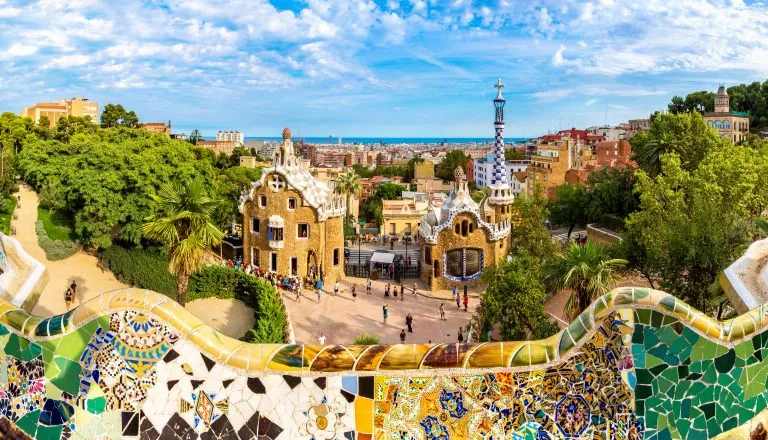
The Ultimate 10 Days in Spain Itinerary (+ Travel Tips)
If you’re planning your first trip to Spain and are hoping to sample a variety of what makes this sun-drenched country special, we designed this 10 day Spain itinerary for you!
Spain has had a special place in our hearts ever since we landed in Madrid for the first time when kicking off our supposed “6-month” round-the-world trip (that was almost 7 years ago, and that trip arguably never ended).
In the years since, we have been lucky enough to visit Spain so many times that we’ve lost count, exploring countless cathedrals, castles, alcabazas , beaches, and cities along the way.
We’ve explored the country via train, car, bus, and ferry, sampling iconic attractions and little-known villages alike, traveling both alone and with various groups of family and friends.
This itinerary for Spain in 10 days has been curated for first-time travelers based on our lived experiences in Spain, and we hope that you walk away loving this beautiful country as much as we do!
Here’s how to fall in love with Spain in 10 days.
Table of Contents
How We Structured This 10 Day Spain Itinerary
Getting around during your 10 days in spain, the ultimate 10 days in spain itinerary, the best time of year to enjoy this itinerary for spain, more than 10 days in spain, what to pack for your trip to spain, your 10 day spain itinerary map.

Some links in this post may be affiliate links. If you make a purchase through one of these links, we may earn a small commission at no extra cost to you. Please see our disclosure policy for more detail.
We structured this 10 day Spain itinerary to cover many of the country’s most popular destinations in a “U” shape, beginning in Madrid and ending in Barcelona.
In addition to the ever-popular Madrid and Barcelona, this itinerary also loops through Toledo, Seville, Granada, and Cordoba in a quest to sample a variety of what makes traveling in Spain special.
With the help of the high-speed train between Madrid and Barcelona , you can easily enjoy this trip by either flying round-trip to and from Madrid, or booking an open-jaw ticket where you fly into Madrid and leave from Barcelona.
And, while we opted to start this itinerary for Spain in the capital, you can easily reverse it and start in Barcelona instead, if the flights work out better that way!
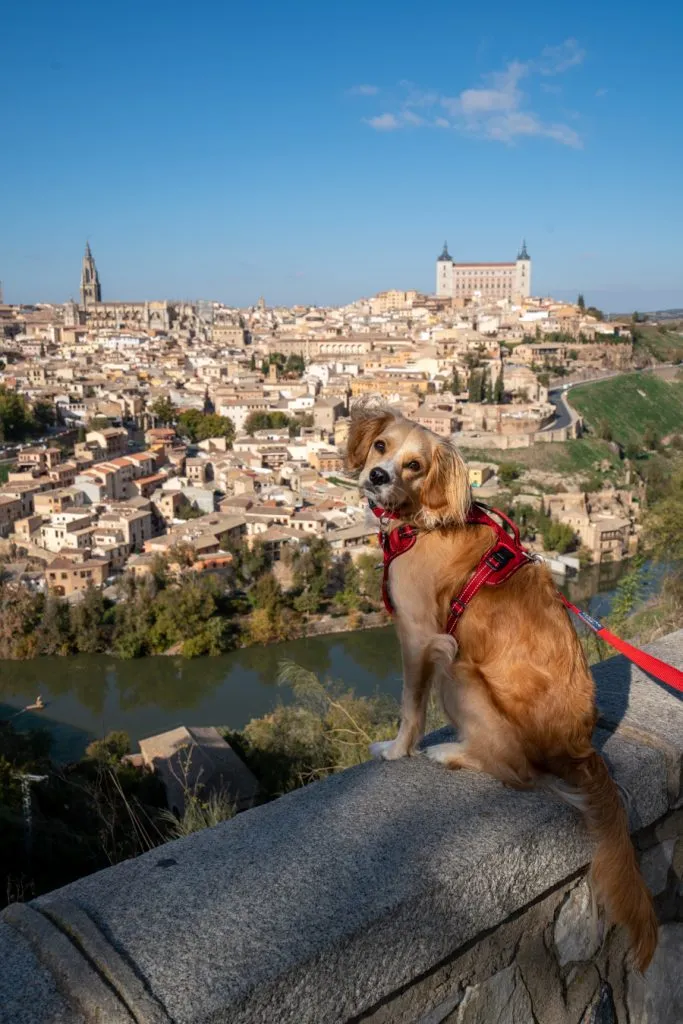
Since this 10 days in Spain itinerary is focused on cities, there’s no need to rent a car or drive on this route!
The simplest (and most fun) way to travel between each destination on this itinerary is via train.
For most places, you’ll have the choice of a high-speed train (more expensive but much faster), or a slower regional train.
We recommend comparing train schedules and prices via Omio , the service we use to book many trains around Europe.
Spain’s high-speed AVE trains, like many high-speed trains around Europe, use dynamic pricing–in other words, you should lock down your fares as soon as you can commit to dates!
Once you’re in a given destination, each city is walkable (with the help of public transportation and/or cab rides in certain places).
Shop train tickets for your trip to Spain today!
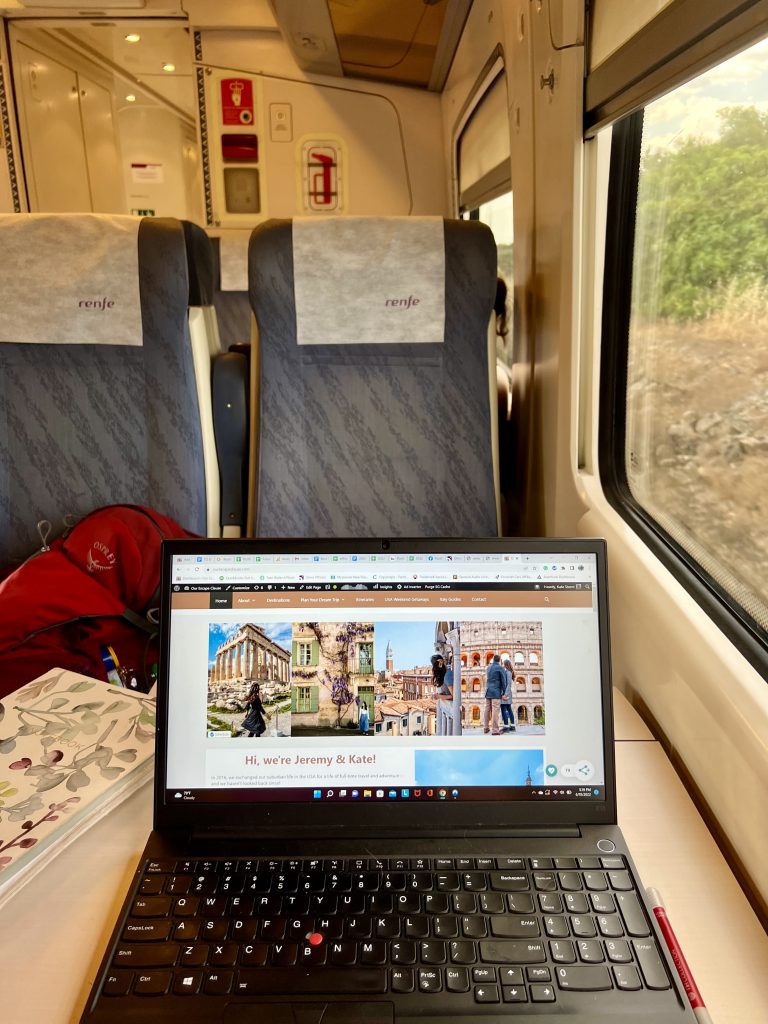
Day 1: Arrive in Madrid and start sightseeing.
There’s nowhere better to kick off your 10 days in Spain that in the vibrant capital city of Madrid!
Often underestimated compared to popular Barcelona, Madrid is beautiful, endlessly interesting, and pulsates with life from every corner.
It’s one of our favorite cities in Europe to fantasize about living in, and who knows–one day we might just make it happen.
On your first day in the city, tour the (gigantic, opulent) Royal Palace , check out the cathedral, meander through Plaza Mayor, and stop by the Templo de Debod.
And, of course, your first day in Spain can’t be complete without tapas!
Head to Mercado San Miguel for endless options, or opt for this popular tapas tour to learn the ins and outs of this tradition (knowledge that will be very useful for the rest of your time in Spain).
Book your Madrid tapas tour today!
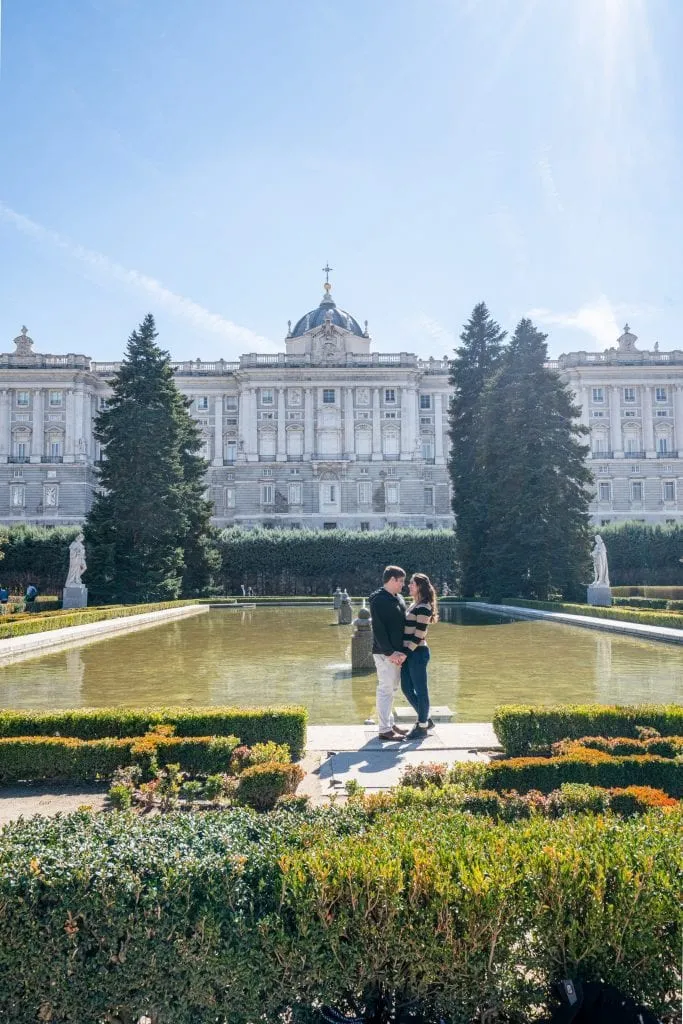
Where to Stay in Madrid
Hostal Adis — Located just off Puerta del Sol and boasting excellent reviews, you couldn’t ask for a better location in Madrid–and at a budget price, too!
Hostal Adis is an excellent property for budget travelers looking for an excellent location and plenty of privacy–rather than being a traditional hostel, Hostal Adis is more like a budget hotel.
Check rates & book your stay at Hostal Adis today!
Hotel Regina — Featuring plush beds, spacious rooms, excellent customer service, and a perfect location near Puerta del Sol, mid-range travelers can’t go wrong with a stay at the popular Hotel Regina.
If you’re feeling like a bit of a splurge, upgrade to a room with a panoramic view for an experience you won’t forget anytime soon!
Check rates & book your stay at Hotel Regina today!
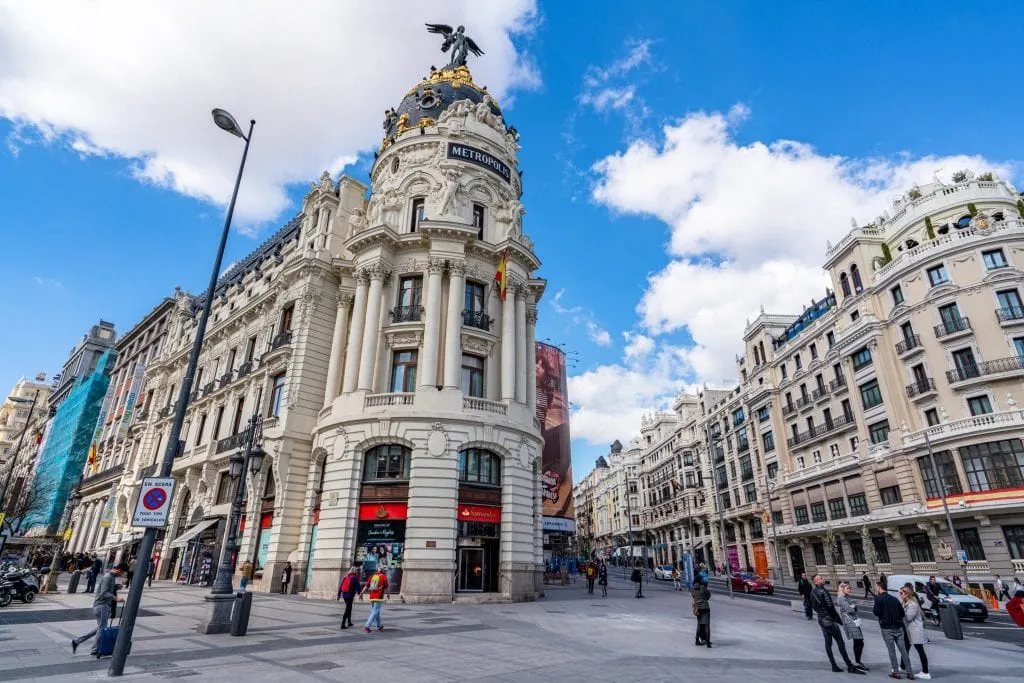
Catalonia Las Cortes — Simultaneously sleek and cozy, modern and traditional, Catalonia Las Cortes is housed in an 18-century building in the heart of Madrid and has blended together all the best of classic atmosphere and modern convenience.
We’ve stayed at a few Catalonia hotels over the years and have always been impressed.
An excellent location near Puerta del Sol, rave reviews and beautiful rooms make Catalonia Las Cortes the perfect luxury hotel choice for those looking for a blend of traditional and modern during their 3 days in Madrid!
Check rates & book your stay at Catalonia Las Cortes today!
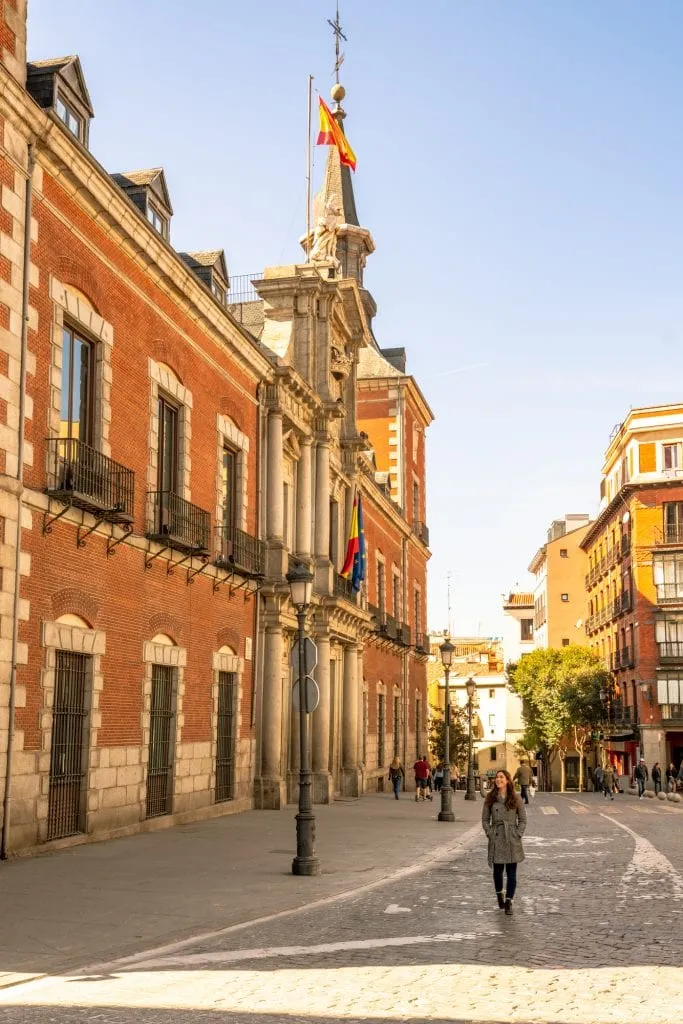
Day 2: Enjoy a second day in Madrid.
The second day of this itinerary for Spain opens with one of the most memorable art museums in the country: Spain’s National Art Museum, the Prado.
Packed with masterpieces (primarily Spanish, but also from across Europe), the Prado is one of those museums that we never get tired of.
Skip-the-line tickets are a great idea here, but for the most context (and efficient sightseeing), consider taking a tour in order to make sure you see the best of Velázquez, Goya, El Greco, and beyond!
Book tickets to visit the Prado today!
Once you’re ready to move on, head to the delightful Retiro Park.
With gardens to explore, rowboats to rent, statues to admire, lawns to lounge on, and even the Palacio de Cristal to enjoy, Retiro Park is a wonderful place to relax.
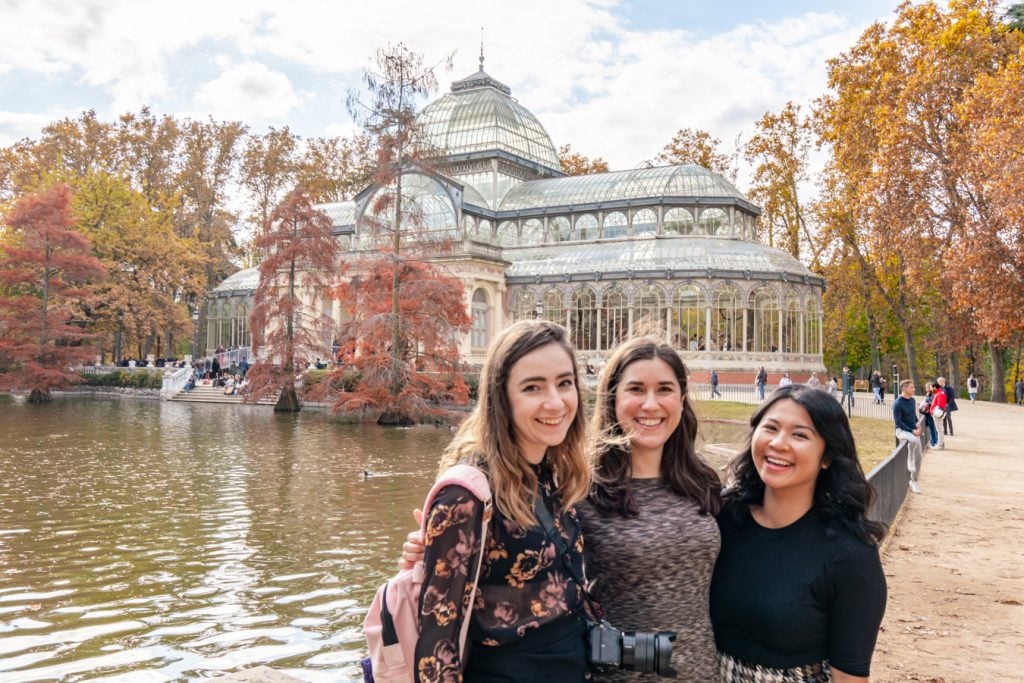
Eventually, make your way to the exit by the Puerta de Alcalá and head up Gran Vía to check out some of Madrid’s most famous architecture!
This shopping street is where you’ll find the iconic Metropolis Building (the rooftop bar and restaurant on top of the Círculo de Bellas Artes has an amazing view of it!), as well as the Cybele Palace.
Branch off to explore the Puerta del Sol and lively La Latina neighborhood in the afternoon and evening!
Don’t wrap up your last (full) day in Madrid without at least one round of churros con chocolate at Chocolatería San Ginés , either.

Day 3: Take a day trip to Toledo.
Today, it’s time to leave the capital behind and take a day trip to the beautiful medieval city of Toledo.
Set about 35 minutes away from Madrid by high-speed train (or about an hour by bus or car), beautiful Toledo is easily one of the best day trips from Madrid.
Surrounded on 3 sides by the Tagus River, Toledo is as charming to look at as it is historically relevant.
The city once briefly served as the capital of Spain, and was even an independent kingdom at one point!
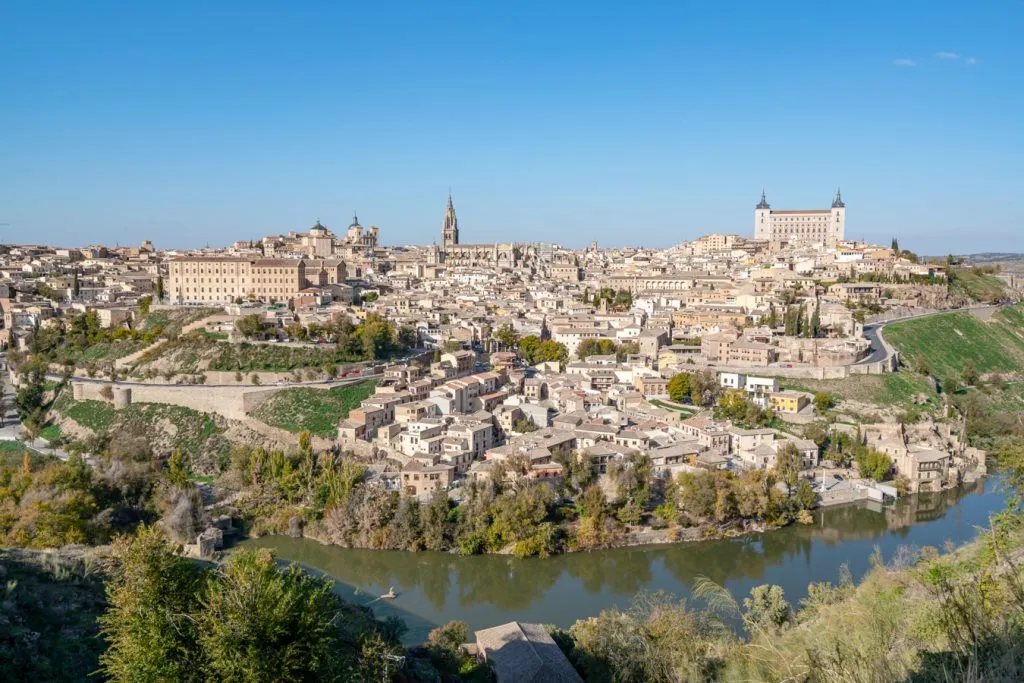
Some of the best things to do in Toledo include visiting the magnificent Toledo Cathedral, touring the Alcázar, stepping inside the Monastery of San Juan de Los Reyes, and meandering through the city’s charming streets.
Don’t miss the viewpoints of the town from across the river, either!
You can easily take the high-speed train to Toledo yourself for the day, but if you prefer the context of a tour (and/or want the easiest access to the viewpoints from across the river), this popular day trip is also an excellent option.
Book your day trip to Toledo today!

Day 4: Head south to Seville.
Sunshine, sour orange trees, flamenco, and some of the most fascinating architecture in Europe await in the next part of this Spain itinerary: welcome to Andalucia.
This is one of our favorite regions in Spain, and it always seems to keep drawing us back.
A roughly 2.5-hour high-speed train journey will deliver you from Madrid to Seville, the capital of the Andalucia region and an excellent jumping-off point for your explorations.
We recommend taking an early train down from Madrid, dropping off your luggage at your hotel (most are happy to hold it until check-in for you), and starting your sightseeing.
Today, be sure to check out the stunning Seville Cathedral , climb to the top of the Giralda (bell tower) for beautiful views of the city, wander through the famous Plaza de Espana, and explore the delightful neighborhood of Barrio Santa Cruz.
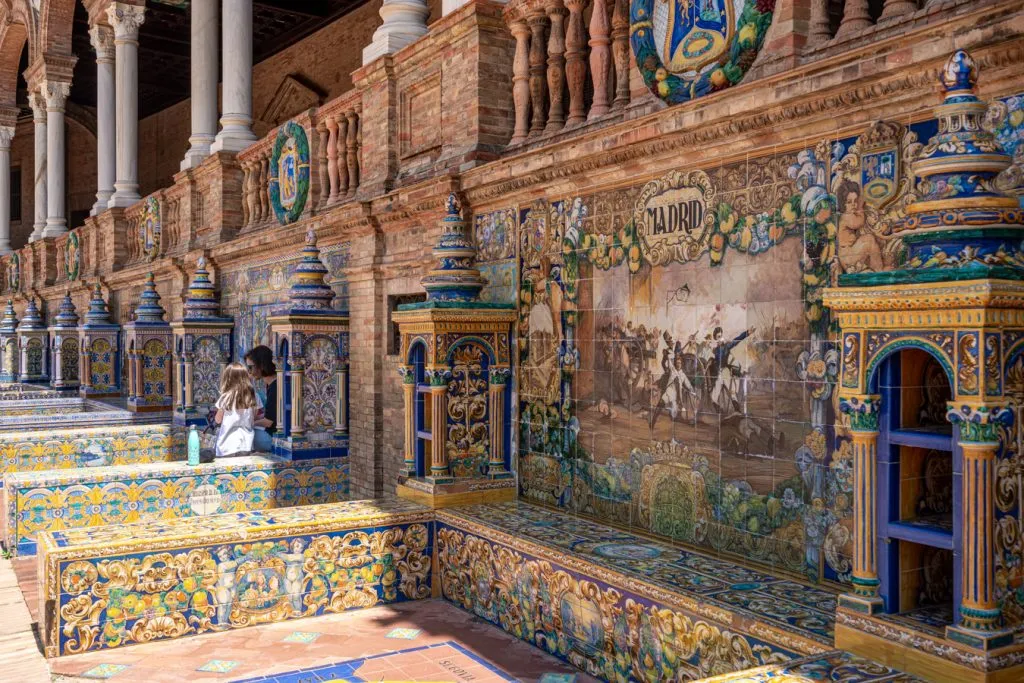
The Royal Alcazar of Seville is stunning, and also one of the best attractions in town–but we’d only recommend visiting today if you’re a really big architecture fan.
As amazing as the Alcazar is (and it is, truly), it’s somewhat overshadowed by the Alhambra, which you’ll see in another couple of days when following this 10 day Spain itinerary.
On the other hand, if you’re interested in adding a flamenco show to your Spain itinerary, Seville is the place to do it.
Andalucia is widely considered the birthplace of flamenco (though the specific origins are debated), and a flamenco show like this is a wonderful way to close out your evening.
Book your flamenco show in Seville today!
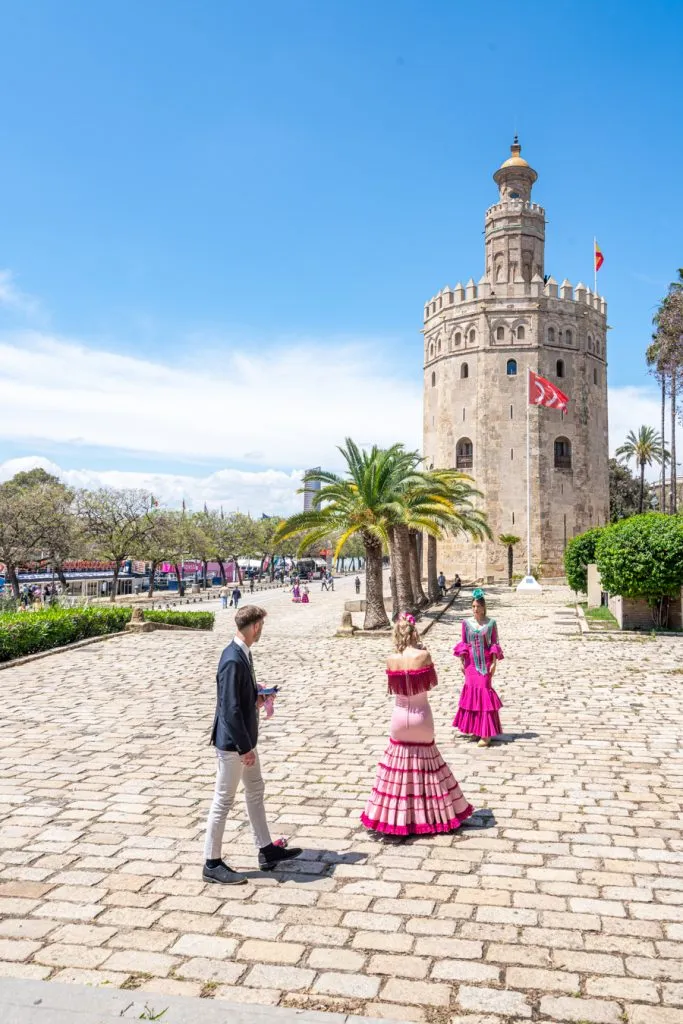
Where to Stay in Seville
When deciding where to stay in Seville, location is key as ideally, you’ll want to stay within walking distance of Seville’s best attractions.
We had a fantastic experience at Petit Palace Puerta de Triana on our most recent trip to Seville.
The hotel has a fantastic location (central but also quiet–a far-from-guaranteed combination in Spain), a delicious breakfast, and comfortable rooms.
Looking for something a bit different?
The incredibly popular Hotel Rey Alfonso X is an excellent choice, and its rooftop views are sublime!
If you’d like to stick to more of a budget, Hotel America Sevilla gets wonderful reviews and doesn’t sacrifice too much in terms of location.
Meanwhile, for the height of luxury, you can’t beat the absolutely stunning Hotel Alfonso XIII !
Check rates & book your stay in Seville today!
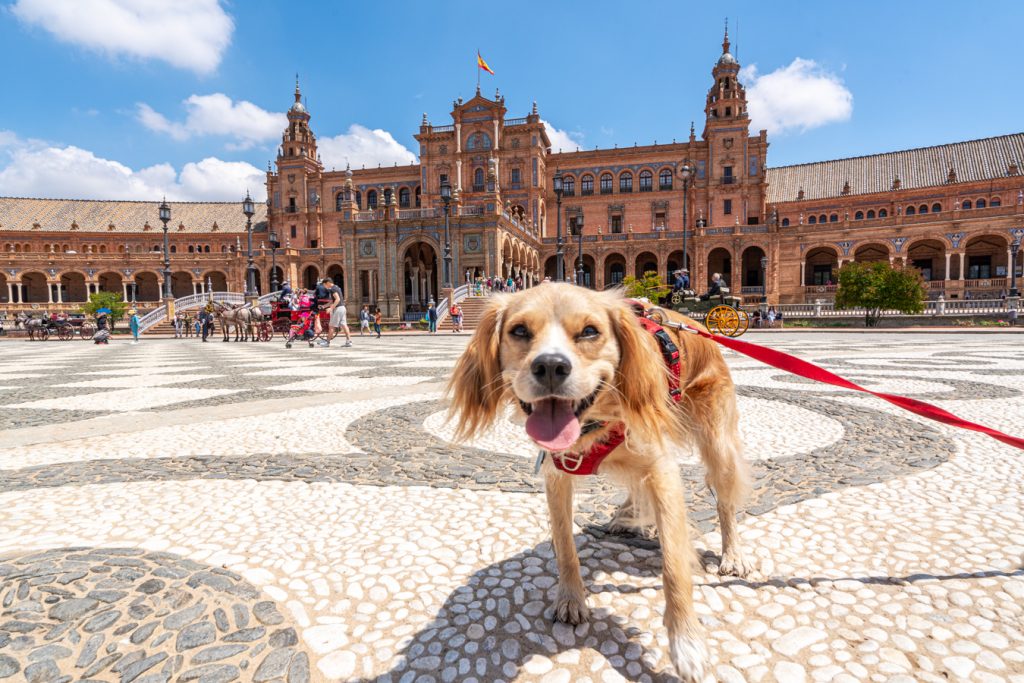
Day 5: Take a half-day trip to Cordoba.
Less than an hour from Seville by train or car, you’ll find the captivating Andalucian city of Cordoba–which happens to be one of our favorite places in the region!
Once the most powerful city in Islamic Spain, the Cordoba of today is small and manageable, a bite-size tourism destination that nonetheless leaves a big impact on visitors.
Cordoba is most famous for its incredible Mosque-Cathedral –literally a former mosque with a cathedral built into its center–which is one of the most memorable buildings we’ve had a chance to visit anywhere.
The Mosque-Cathedral should absolutely be your top priority when visiting Cordoba, but beyond that, there’s still plenty to see within a short walk!
Snapping photos of the picturesque Calleja de las Flores, relaxing in the Patio de los Naranjos, wandering through the Jewish Quarter, and checking out some of the beautiful patios of Cordoba should also be on your to-do list.
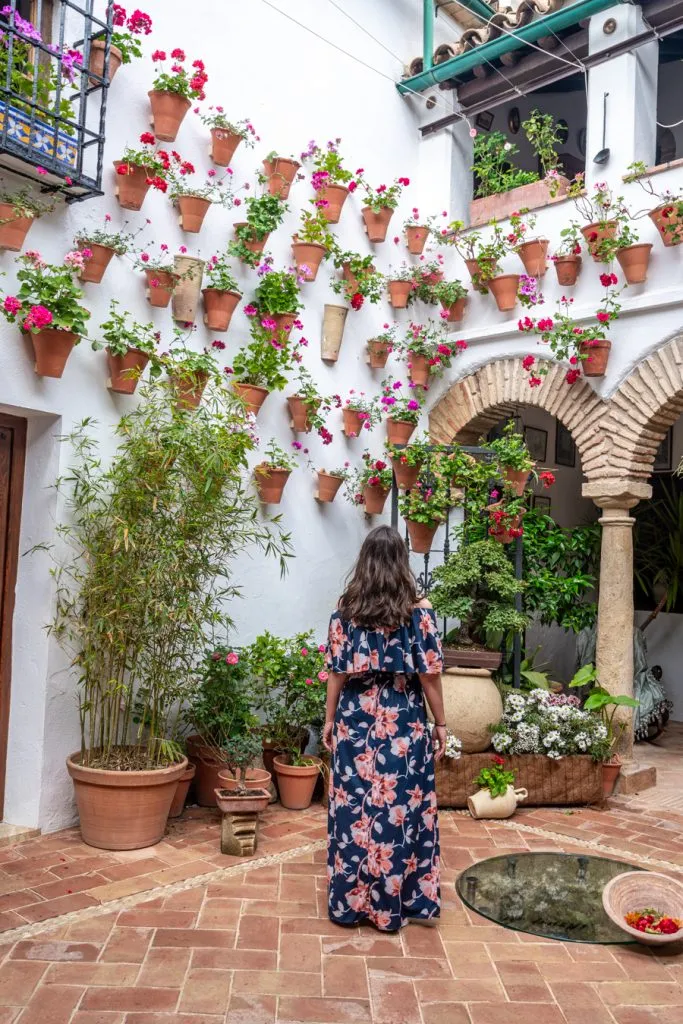
After seeing the best of Cordoba, you have two options for the rest of your day: first, you could enjoy another evening in Seville.
Or, if you’d rather make today particularly busy in favor of having more time for sightseeing tomorrow, you could head onto Granada.
Granada, home to the Alhambra, is about 3 hours from Seville by train or car and is your destination for tomorrow.
You could opt to continue sleeping in Seville and take a long day trip there on day 6, or, if you’re open to packing and unpacking an extra time, you could sleep in Granada starting tonight to give yourself more time in the city.
Personally, we love Granada and would recommend spending extra time there, but both options are compatible with this Spain itinerary.

Where to Stay in Granada
When spending a few days in Granada, we opted to rent an apartment from Mosaiko Homes and could not have had a better experience: the owner was responsive, the apartment fantastic, and the location unbeatable!
Mosaiko Homes is located on a quiet street a short walk from many of Granada’s top sights, offering the combination of a convenient location and a lack of noise at night–two things that can be difficult to find together in Andalucia!
Another excellent option with near-perfect reviews is the incredibly unique Casa de Reyes (that decor!).
For a bit of luxury, the popular Shine Albayzin is not only housed in a 16th-century palace, it overlooks the Alhambra .
Generally speaking, lodging in Granada is much more affordable than in, say, Barcelona or even Seville.
If you’re going to splurge on a luxury property during your 10 days in Spain, Granada is a fantastic place to do so!
Check rates & book your stay in Granada!
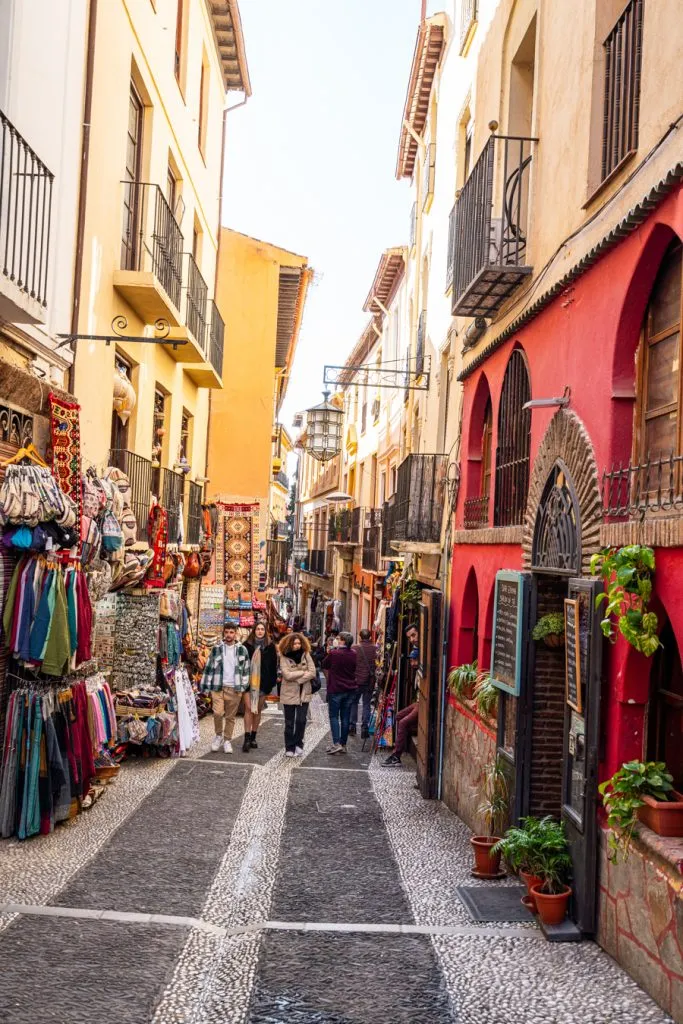
Day 6: Explore Granada and tour the Alhambra.
Whether you’re visiting on a day trip from Seville or spending the whole day in Granada (we recommend the second, but the first is doable too), there is one major item on the agenda today: the Alhambra.
This collection of centuries-old palaces (plus a fort, gardens, ruins of a medina, and more), is one of the most unique groupings of architecture in Europe, and the most-visited tourist attraction in Spain!
We wrote about visiting the Alhambra extensively here , so I’ll try to keep this (kind of) brief, but the long and the short of it is that this is a place you need to plan ahead for.
Tickets often sell out, and a tour is a great idea here if you like historical context ( we enjoyed this one ).
If you’re visiting from Seville, we recommend booking a day trip , because 3 hours of transit each way plus navigating to and from the complex is a headache in a short time frame (we rarely suggest taking day trips this long, but the Alhambra is worth it).

However you decide to visit, make sure that you book a ticket or tour that includes the Nasrid Palaces!
These magnificent palaces, the final stronghold of Islamic Al-Andalus before the Reconquista was officially completed by the Catholics in 1492, are the jewel of the Alhambra and an absolute must-visit.
Not all tours and tickets include them, though, so book yours carefully .
Once you wrap up at the Alhambra, if you’re staying in Granada, be sure to wander through the Albayzin neighborhood, admire the views of the Alhambra from a distance at the beautiful Mirador de San Nicolas, and visit the beautiful Granada Cathedral.
Granada is also a fantastic place to enjoy Spain’s tapas culture, so be sure to indulge in some snacks along with a tinto verano .
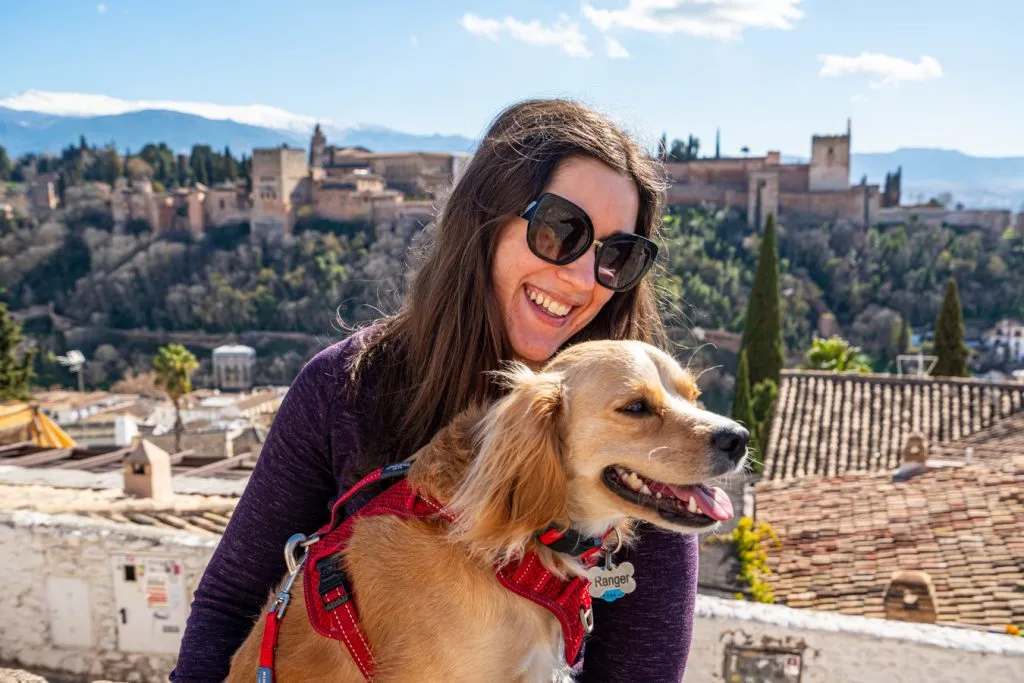
Day 7: Head north to Barcelona.
Today, say goodbye to Andalucia and head north to Barcelona!
This is the longest travel day included on this 10 days in Spain itinerary, and you can expect to spend 6+ hours on a train from Granada to Barcelona.
We recommend booking this trip at least a few weeks in advance, as you’ll want a choice of schedules and to get the best price possible.
If you’re on a budget, you can price out flights too, but traveling by train is much more fun!
Once you arrive in Barcelona, you can check into your hotel, get unpacked, and start exploring.
Meander through the Gothic Quarter, check out the Barcelona Cathedral, sample the Santa Caterina Market, stroll down Las Ramblas, and soak up the beauty of Plaça Reial.
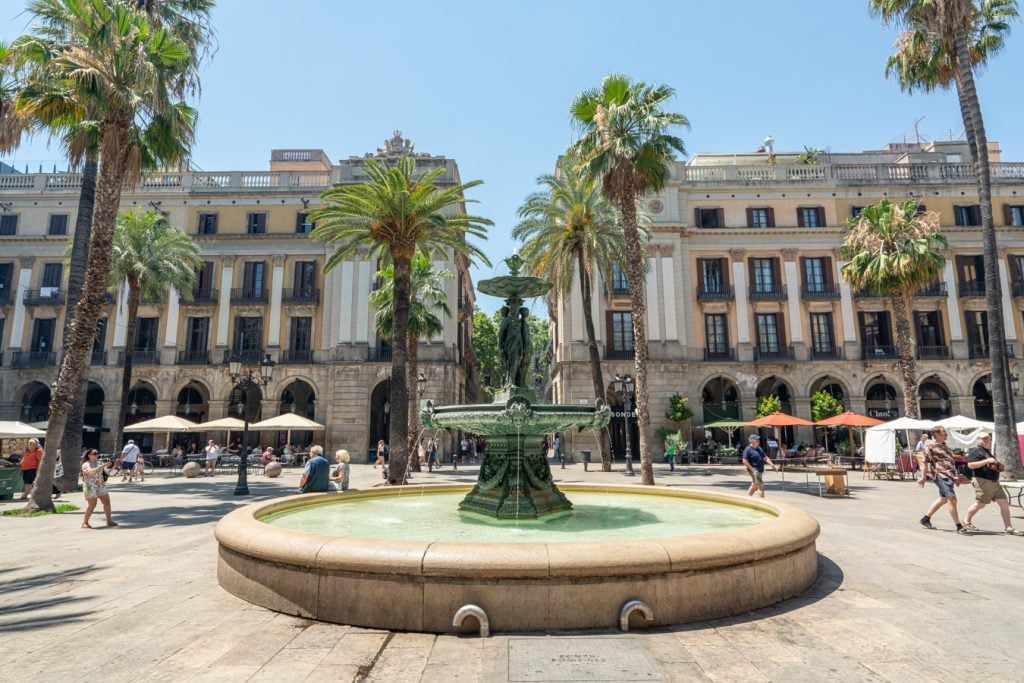
Where to Stay in Barcelona
When deciding where to stay in Barcelona, it’s important to keep in mind that this sprawling city requires some effort to move around–there’s no way to stay near all the best things to see in Barcelona, but it’s best to stay by some of them!
We checked into Citadines Ramblas Barcelona and were extremely satisfied–to the point that we may just keep going back on additional trips.
Our room was spacious, complete with a kitchenette, and extremely quiet despite the hotel being located in a prime spot right along Las Ramblas.
The view of the Barcelona Cathedral from the rooftop deck of the Colón Hotel Barcelona is pretty incredible too, though, and we have it bookmarked for a possible future trip.
If you’re traveling on a bit more of a budget, Hotel Nouvel also gets excellent reviews and is in a wonderful location.
Check rates & book your stay in Barcelona today!
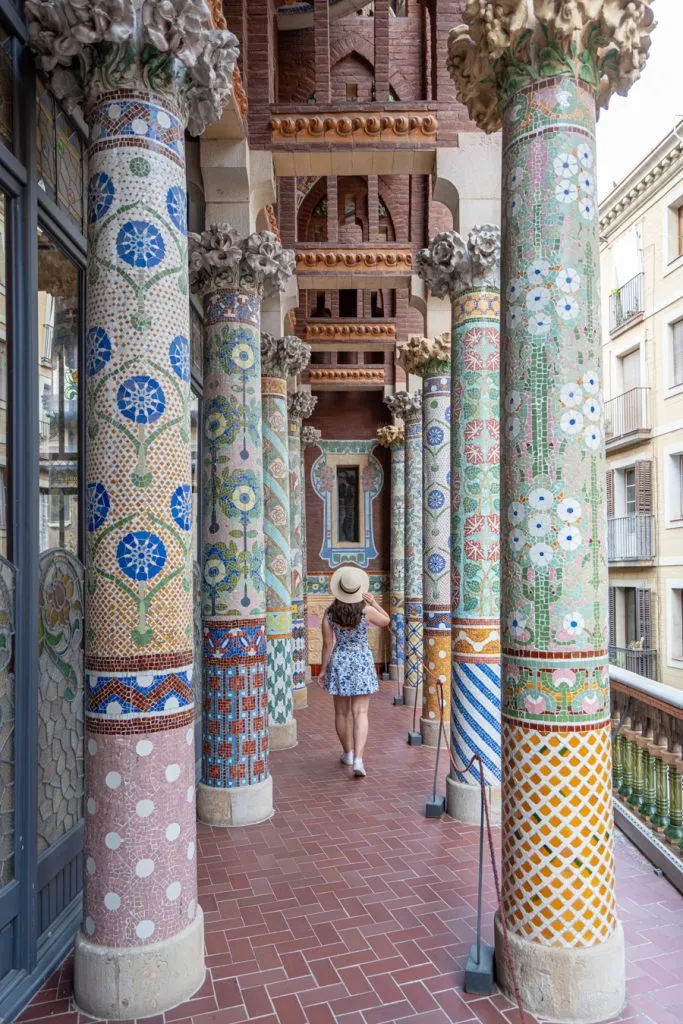
Day 8: Explore Barcelona’s unique architecture.
On your first full day in Barcelona, start with a visit to either Casa Milà or Casa Batlló , two of the most famous homes designed by Gaudi!
They’re fairly close together, but with only a couple of days left in Spain, we recommend only going inside one and seeing the other from the outside.
You’ll also want to get an early start–personally, we recommend pre-booking tickets for Casa Batlló when it opens).
From there, explore any nooks and crannies of the Gothic Quarter you didn’t get to see yesterday, including Catalunya Plaza and Mercado de la Boqueria.

If you’re excited about all of Barcelona’s Catalan modernism architecture, we can also heartily recommend a visit to Palau de la Música Catalana .
Though not designed by Gaudi, it’s an amazing (and compared to much of Barcelona, uncrowded) example of the style and a memorable place to visit!
Barcelona’s Arc de Triomf is also only a 10-minute walk away.
From there, you’ll be about a 25-minute walk from Barcelona’s beaches and bustling coastline.
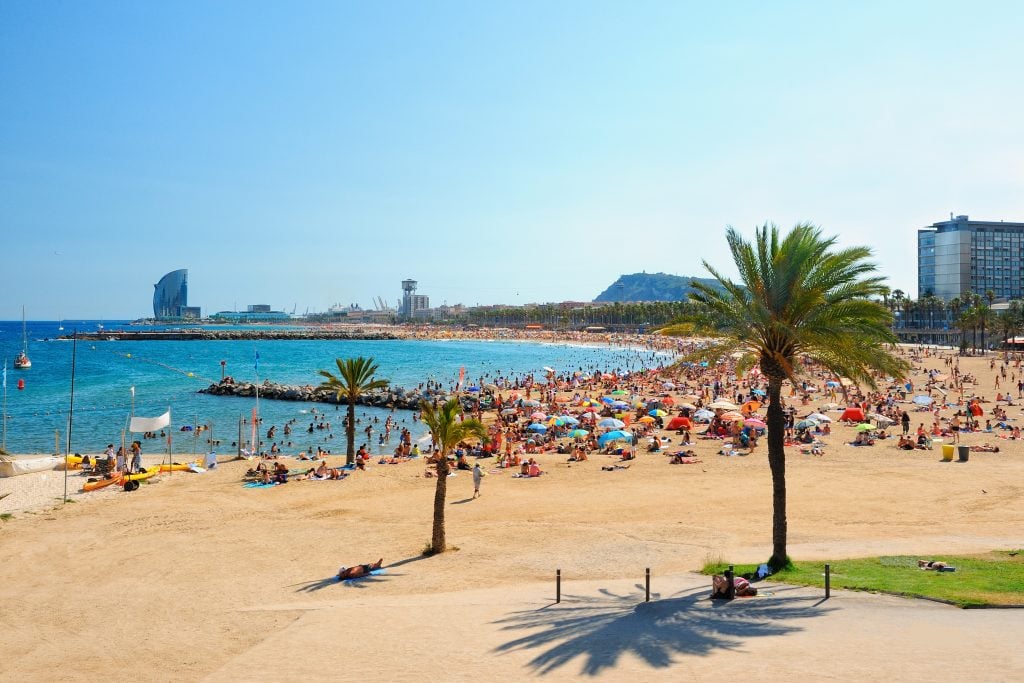
Day 9: Dive deeper into Barcelona (and possibly take a day trip).
With its long list of incredible attractions, it would be very easy to spend the penultimate day of your Spain vacation exploring the city in-depth–but another option would be to add on a trip to the monastery of Monserrat.
This mountain retreat away from the city is known for its incredible views, and a half-day trip there is a wonderful way to get a taste of Catalonia beyond Barcelona itself.
However, staying in the city also has its charms: the views from Park Güell and/or Tibidabo, the incredible Picasso Museum (which holds over 4,000 of the artist’s works), and a visit to Camp Nou are possible additions to your list.
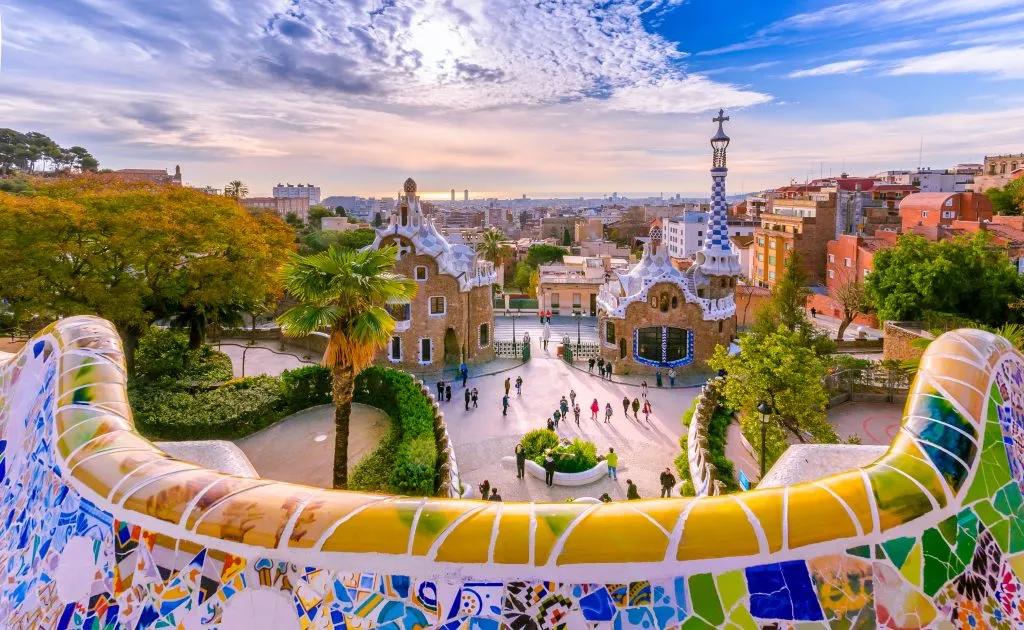
And, of course, we can’t forget the Sagrada Familia : Gaudi’s unfinished masterpiece of a cathedral is an absolute must-see when visiting Barcelona!
We visited in the early evening after hearing that the interior’s light was at its best then, and we were not disappointed–the colors were phenomenal.
If you wrap up at the Sagrada Familia before sunset and would like to enjoy the Mediterranean while in Barcelona, consider wrapping up your evening with a sunset catamaran cruise .
Book skip-the-line tickets to visit the Sagrada Familia today!

Day 10: (Maybe) head back to Madrid and say goodbye to Spain.
How the final day of this itinerary for Spain works for you depends on one factor: whether you’re flying home from Madrid or Barcelona.
If you’re taking an evening flight home from Madrid, you’ll need to take the high-speed train back to the capital (we highly recommend booking this in advance ).
If you’re leaving from Barcelona, you may have time for one more round of pan con tomate enjoyed while admiring the bustling of the city before you catch your flight!
However you close out your 10 days in Spain, we hope you say goodbye already dreaming of your trip back.
Shop train tickets from Barcelona to Madrid today!
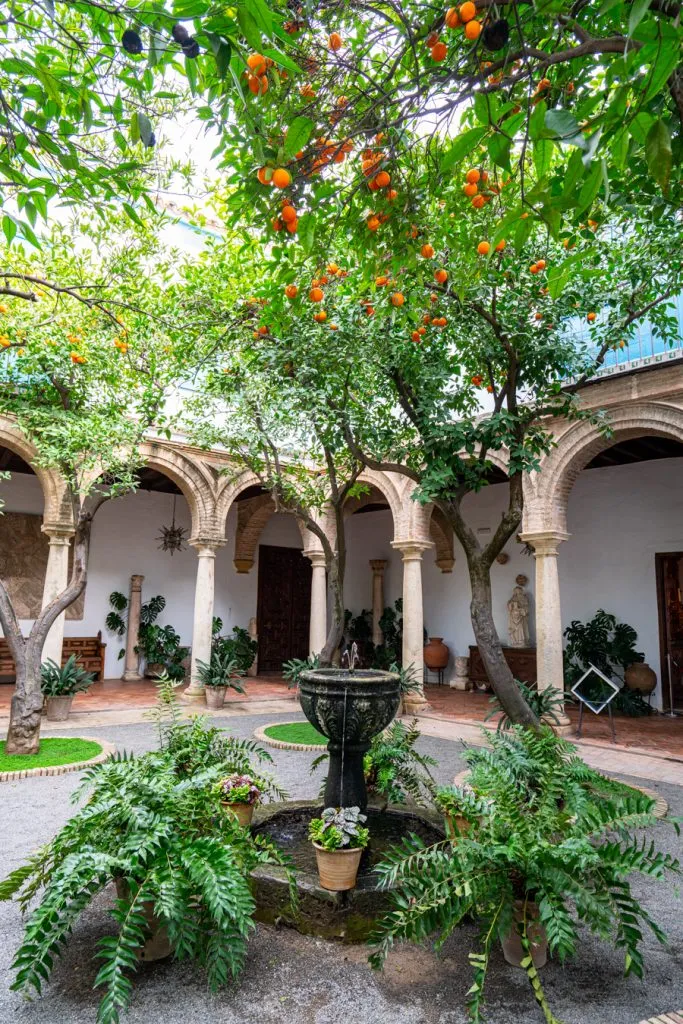
Spain is the definition of a year-round destination, and that includes this Spain itinerary!
That being said, though, if you have flexible dates and are trying to pinpoint the ideal time to travel Spain, we recommend enjoying this itinerary in the spring or fall.
Summer in Spain, especially in Andalucia, can be brutally hot (we shudder to think of visiting the Alhambra at noon in July).
Winter is perfectly doable, but the weather can be rainy and less predictable than in spring or summer.
On the plus side for winter, though, you’ll experience few crowds, low prices, and still have a decent chance at soaking up some Spanish sun, albeit with a jacket at hand.
The sweet spot for this 10 day Spain itinerary, though, which travels a decent chunk of the country and therefore needs to take multiple climates into account, is the spring and fall.
We have visited Spain in every season, and while each trip was a delight, we have a special place in our hearts for our spring and fall visits!
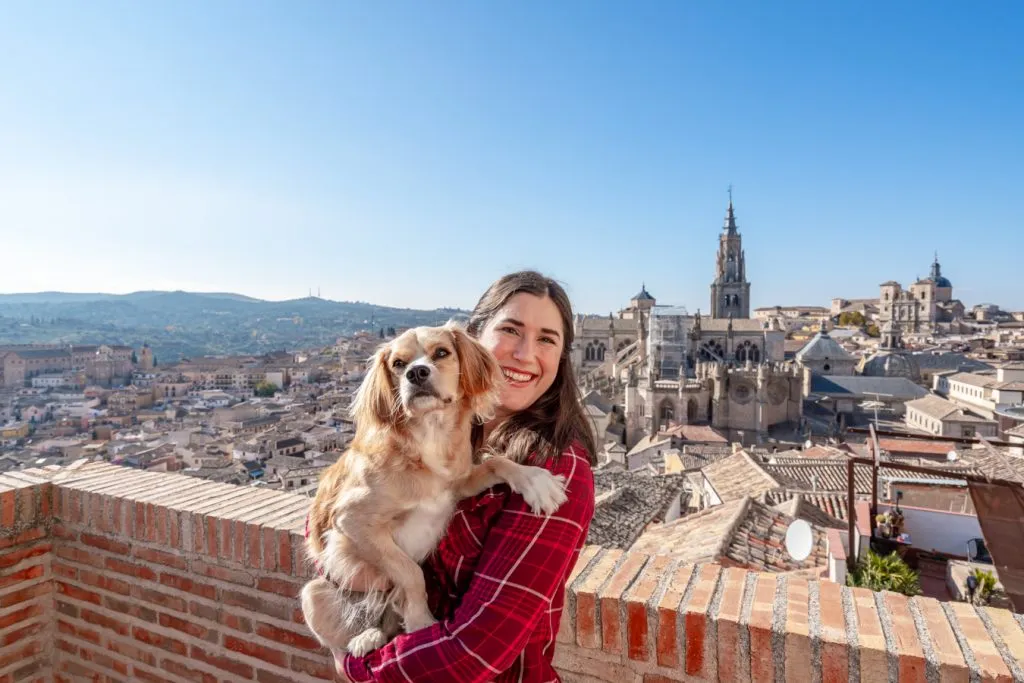
Lucky enough to have longer than 10 days in Spain? If so, congratulations!
Our first recommendation with a couple of extra days to add to your Spain itinerary is to slow down: every destination covered in this travel guide could easily use another day or two at least.
While it’s doable to travel Spain at a breakneck pace for a week and a half, the longer you’re there, the slower you’ll want to travel.
Alternatively, if you want to keep the speed going, you could add on another day trip: visit Girona from Barcelona, Segovia from Madrid, or Ronda from Seville, for example.
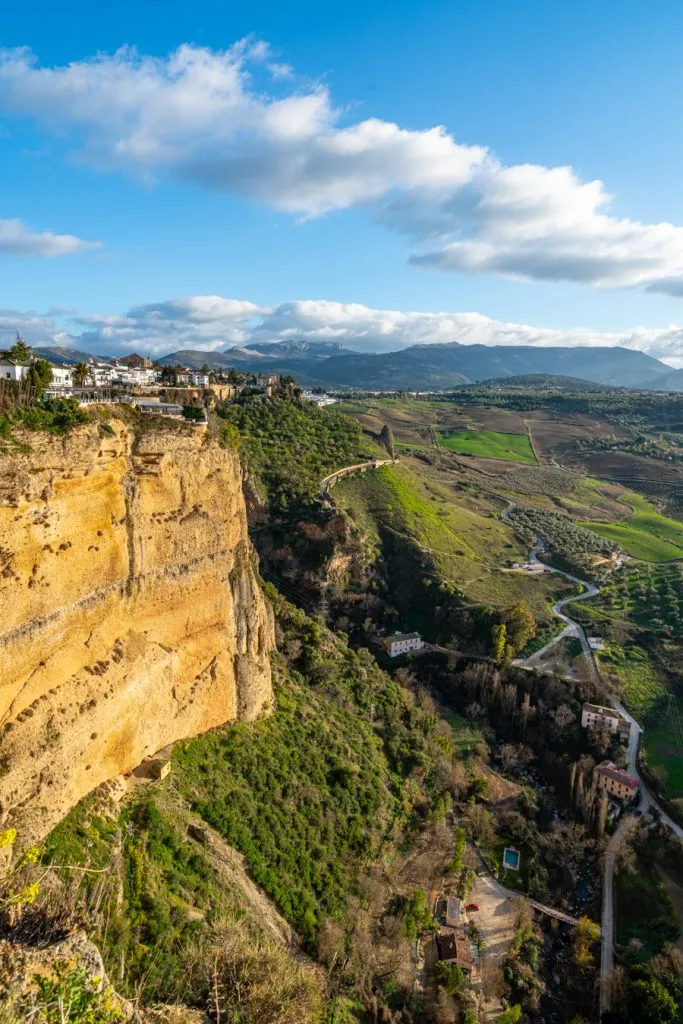
If you have closer to 2 weeks in Spain, consider adding Basque country to your itinerary!
San Sebastián, Bilbao, Vitoria-Gasteiz, and beyond makes for a wonderful extension to round out a couple of weeks in Spain.
Alternatively, you could opt to extend the Andalucia portion of your trip to include a couple of days on the Costa del Sol.
With near-limitless ways to enjoy a Spain vacation, it’s safe to say that wherever you head, you’re bound to have a wonderful trip.
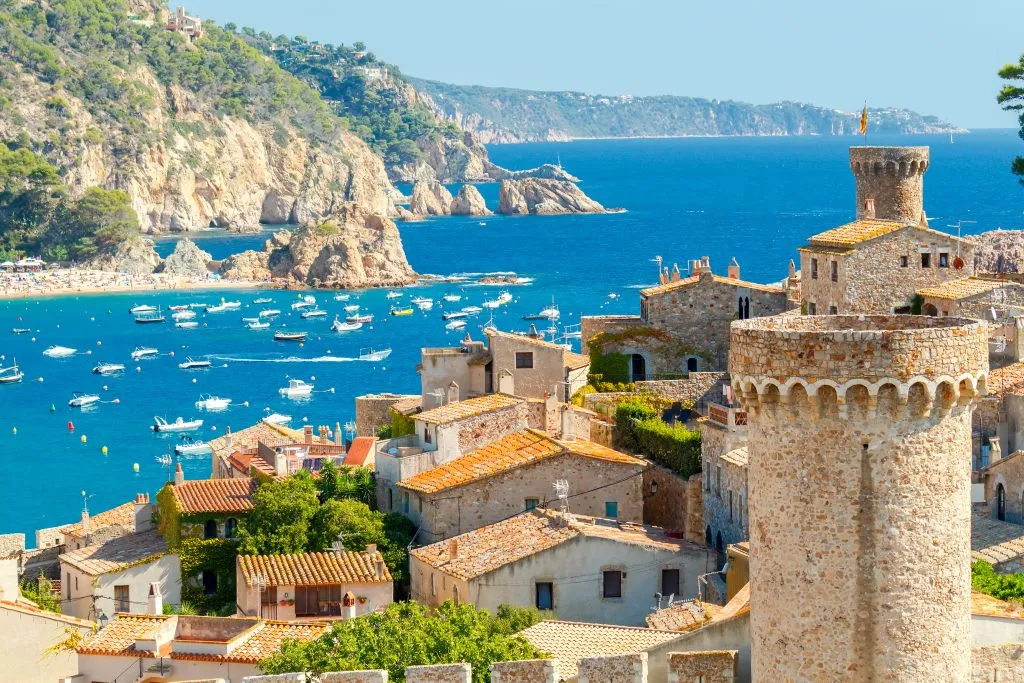
Our detailed packing lists for Europe in summer , fall , and winter cover just about everything you’ll need to bring on your 10 day Spain vacation!
To get you started on your list, though, here are a few essentials to add to your packing list:
Travel Adaptors for Spain — If you’re coming from outside of mainland Europe, you’ll definitely need adaptors for your electronics.
Camera — We completely adore our Sony a7R III , but whatever camera you’re comfortable with works–just make sure you have something with you to preserve your memories!

Comfortable Day Bag — We currently use Pacsafe’s sleek anti-theft backpack and love it, but if you don’t want to shell out the cash for this trip, that’s totally understandable.
Just aim for something comfortable to wear, not flashy, and medium-sized–we used a Northface Jester backpack for years and loved it as well.
Sunglasses — They’re not kidding about the Spanish sun! I find myself reaching for sunglasses regularly even when visiting Spain in winter.
Portable USB Charger — Don’t stress about your phone dying while you’re sightseeing in Spain: bring a USB charger along for the ride.
Take This Map With You! Click each highlight to pull up the name of the destination. To save this map to “Your Places” on Google Maps, click the star to the right of the title. You’ll then be able to find it under the Maps tab of your Google Maps account! To open the map in a new window, click the button on the top right of the map.
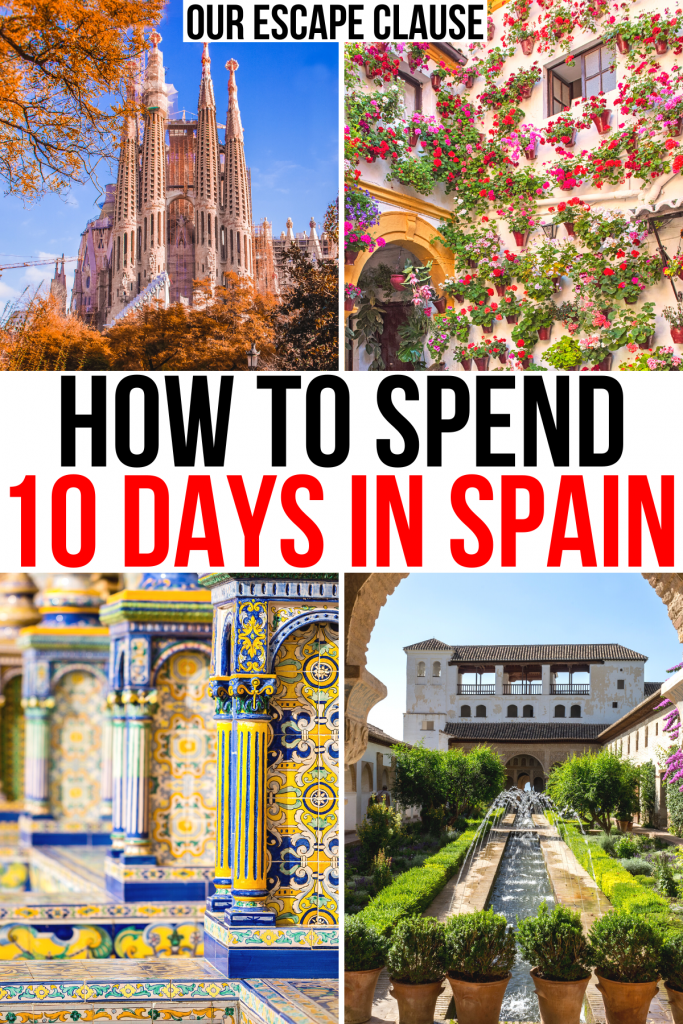
About Kate Storm

In May 2016, I left my suburban life in the USA and became a full-time traveler. Since then, I have visited 50+ countries on 5 continents and lived in Portugal, developing a special love of traveling in Europe (especially Italy) along the way. Today, along with my husband Jeremy and dog Ranger, I’m working toward my eventual goal of splitting my life between Europe and the USA.
63 thoughts on “The Ultimate 10 Days in Spain Itinerary (+ Travel Tips)”
Great overview and suggestions, Kate!
Any suggestions you can offer for an afternoon of wine tasting along the journey?
Thanks, Rob!
We haven’t done a lot of dedicated wine tourism in Spain, though of course, the local wines are delicious. You’ll be near wine regions in each stop, though, so can easily opt for a half-day wine tasting outside the city somewhere.
Alternatively, every city has more excellent wine bars and wine shops than you can count!
Amazing!! Thank you so much for all of this!!
Kate quick question if I may bother you for a bit.
I went through everything you wrote and I calculate maybe about $5,000 would cover the hotel, train and eating expenses between cities for a family of three (My husband and I and our baby girl, toddler) This does not count the air flight ✈️ to Spain.
We were thinking of visiting ending of May or Beginning of June.
Does this sound about reasonable amount to take ??
$5000 (USD, I’m assuming) is very doable, especially if you’re conscious of your budget when booking hotels! I’d recommend booking your train tickets in advance too, as those can be pricier at the last minute.
Generally speaking, Barcelona will be the most expensive stop on this itinerary and Andalucia the most affordable.
Thank you so much!
Thank you so much for creating this! This is extremely helpful and I appreciate all your tips. I am going to Spain in the middle of Semana Santa, but flying into Barcelona and departing from Madrid. I would love to visit the cities you mentioned, but this is the current itinerary I have going. Do you think that this is doable?
DAY 1 – ARRIVAL IN BARCELONA DAY 2 – BARCELONA DAY 3 – BARCELONA Easter DAY 4 – Fly to GRANADA DAY 5 – GRANADA (Alhambra visit) DAY 6 – SEVILLE DAY 7 – SEVILLE (day trip to Cordoba) DAY 8 – SEVILLE DAY 9 – MADRID DAY 10 – MADRID DAY 11 – Fly home
Yes, that sounds like a very reasonable itinerary! You’ll have a great time.
I’d definitely have some food/snacks with you as you’re traveling on Easter Sunday, as you’ll no doubt run into lots of closures.
The week of Easter is also VERY busy in Spain (and in much of Europe), so expect higher-than-usual prices and crowds. I’d recommend booking your hotels ASAP and Alhambra visit ASAP!
I love your site and this itinerary for Spain. We’re spending about 12 days in Spain in early April (unfortunately also over Easter, like Chloe in the message above), and using your itinerary as our template, we want to add a day or two in Gibraltar & Tangier. Have you done this? Too ambitious to add to the itinerary? It would look something like this:
1 – Arrive in BARCELONA 2 – BARCELONA 3 – Fly to GRANADA 4 – GRANADA (Alhambra visit) 5 – GIBRALTAR 6 – TANGIER 7 – SEVILLE 8 – MADRID 9 – MADRID (Toledo) 10 (Easter) MADRID 11 – Back to BARCELONA 12 – Fly home
That is a very packed schedule, but I do get the temptation of adding on a quick day in Morocco (and the UK, in a manner of speaking).
If you want to add on Gibraltar and Tangier, I’d consider trimming a different destination to give yourselves more breathing room, as that’s a tough pace to keep up for 12 days (though doable, if you are dedicated to seeing every last place).
Seville is a gorgeous city, but taking it off your itinerary would give you another day to work with, which you could then add to Granada or Gibraltar, since you’ll really only have an afternoon and evening there.
If you really want to see Gibraltar, of course it’s worth seeing, but if it’s more or less just a stop on the way to Tangier, you could also look at Tarifa, a beautiful Spanish beach city (no passport control) that you can access Morocco from (I believe the ferry is slightly shorter from there, too–we’ve taken that one ourselves).
Alternatively, the high-speed trains do run on Easter, so if that day is more or less just a holding day on your calendar (since the Madrid sites will be closed), you could travel back to Barcelona then, which would give you day 11 back to see a bit more of that city.
Any high-speed trains you do opt for, though, I’d book ASAP. It’s often a mad rush for trains over Easter with people traveling for the holiday.
Thanks Kate. After doing some more reading and research, we’re going to bypass Tangier. Instead, we’ll use that time to explore the towns between Granada and Seville (Thinking Nerja and Ronda) by car. Have you rented a car and driven in southern Spain? Any issues we should know about or is it a pretty standard car rental experience?
Gracias! Chris
We’ve driven in southern Spain many times(including Granada, Seville, Ronda), but generally by renting cars in Portugal and then driving them over.
It’s a pretty standard European driving experience, though–parking outside of historic centers and walking in, etc. If you’re a confident driver I wouldn’t be worried. The driving is also stunning–plenty of chances to enjoy gorgeous views along the way!
There is no condensed itinerary on this page
Here you go, Sarah. 🙂
Day 1: Arrive Madrid Day 2: Madrid Day 3: Day Trip to Toledo From Madrid Day 4: Travel to Seville Day 5: Half- Day in Cordoba Day 6: Granada and the Alhambra Day 7: Travel to Barcelona Day 8: Barcelona Day 9: More Barcelona or Day Trip Day 10: Travel Home
This is a GREAT article. I’m going to follow your itinerary. I’d also like to visit San Sebastián and Cadiz. Could you recommend a way to incorporate these into your itinerary? Thank you!
So glad you found our post helpful!
There’s not an incredibly efficient way to add San Sebastian to this itinerary, as it’s several hours out of the way regardless of where you add it on. It is a gorgeous city, though!
Your best bets would probably be either visiting after Madrid and then flying to Andalucia from San Sebastian, or visiting after Barcelona (especially if you’re flying out of Madrid) and then taking the train back to Madrid to head home.
Of course if you find a good flight to or from San Sebastian you could use it as a starting or ending point, but Madrid and Barcelona tend to have the best deals for transcontinental flights (assuming you’re not coming to/from Europe).
Cadiz is much easier to add on–it’s just an hour or so south of Seville by car, so you can easily add it to your Andalucia leg. Some people even visit it as a day trip from Seville.
Hi! Your trips look amazing! Wondering if you could offer advice. I have 10 days to plan. In my head I will be able to see Madrid, Barcelona, Seville, a beach town, Lisbon or some location in Portugal, and Morocco. As I’m researching, this looks like it might be impossible. Knowing my family would like to hit all 3 countries, what would you offer as a reasonable way to spend these days without feeling crazy and traveling constantly. It is myself, my husband, and kids age 13 & 17 who travel very well. Thanks for any help!
You know, I actually have it on my list of future blog posts to write some sample itineraries combining Spain and Portugal. Thanks for the reminder!
If you want to see all 3 countries in 10 days, the most realistic way is to do it via a sampler platter style, meaning 1-2 base destinations in each of Spain and Portugal, depending on whether you want to take a day trip to Tangier or you plan to spend a few days in Morocco.
One option could be 3 days in Lisbon (with a possible day trip), 3 days in Seville (with day trips further afield–possibly Granda/the Alhambra and Cordoba), 2 days in Tarfia (pretty Spanish beach town with ferries to Tangier), and then a couple days in Tangier. But that’s already pushing it as far as what you can fit in!
Keep in mind that unfortunately, Spain and Portugal are not very well-connected to each other by rail. When you’re short on time, your best options will be renting a car and driving across the border (in the south/if you want to go to the Algarve) or flying (between major cities).
Hi, Thank you for this great itinerary! My husband and I are planning a trip on similar lines this year and I had a few questions I was wondering you could advice us on: 1. Is early September a good time to visit? Would August be too hot?! 2. Is one day in Granada enough? I have heard that Alhambra itself can take quite a while and hence was wondering if one day would be too tight a squeeze 3. Between Barcelona and Madrid, if you had to suggest one for first time travellers, which would you recommend?!
Hi Rushali,
Of course, happy to help!
Early September is definitely preferable to August. It’ll still be warm, especially in Andalucia, but it’ll be much less crowded. It often feels like all of Europe heads to the beaches or mountains in August and then promptly goes home by September 1–so September will be much more pleasant from that angle.
One day being enough in Granada is all dependent on how much else you want to do! In a perfect world, I’d love to rent an apartment in Granada for a few months and take advantage of all the food and nearby hiking. 🙂
But for the purposes of a short trip, one day is enough to see the Alhambra (it will take up the bulk of your day) and then do a quick pass through the rest of town, hopefully prioritizing the Albayzin neighborhood, the Mirador de San Nicholas, and tapas.
If you’re able to add on a second day (or even half day, like I laid out as an option above), you won’t be sorry, though.
Barcelona vs Madrid… that’s an intense debate! Personally, we prefer Madrid, but we’re in the minority. Barcelona is wildly popular (deservedly so!) and has the beach, more outlandish architecture, and a more fast-paced vibe.
Madrid is arguably more elegant, with world-class museums, and is a bit cheaper.
Both are incredible–if you are struggling to decide, I’d make a list of the top 3-4 things you want to see in each city and see which ones pull to you more.
Hope you guys have a wonderful time!
Hi Kate, Would you recommend activities like River Rafting, Hot Springs, Walk in the wild while in Spain? We are planning a trip during early May
If they’re priorities for you and you have time, absolutely! Andalucia in particular has great options for all of those. You might want to look into extending your time in Granada if you want to get outdoors during your trip.
Hi! My husband and I are going on a 10 day trip starting in Barcelona. We go to Mallorca then Seville. Were having a hard time deciding if we want to end in Madrid or Lisbon, any recommendation?
Hi Samantha,
That’s a hard call, as they’re both wonderful but very different!
Very generally speaking, I’d say that Madrid is best if you’re looking for museums, the royal palace, and a chance to travel overland from Seville (it’s an easy train ride).
Lisbon is best for views, being near the coast (you can easily take a day trip to Sintra, Cascais, or both), and the chance to sample another country during your trip. There’s no train service from Seville, you’ll need to fly, drive, or take a bus.
Both offer popular food options, but Lisbon has a bit more of a seafood focus while Madrid tends toward pork.
This is all very general, but I hope it helps a bit!
If you haven’t seen them, our guides to spending a few days in each city will give you a feel for them:
Madrid: https://www.ourescapeclause.com/3-days-in-madrid-itinerary/ Lisbon: https://www.ourescapeclause.com/3-days-in-lisbon-itinerary/
Good luck deciding! 🙂
Hi Kate! Would recommend Lisbon or Madrid if we can only go to one on our trip? Were going to Barcelona, Mallorca and Seville before.
Hi Kate! Thank you for this great itinerary. My husband and I are planning to visit Spain this September (finally will be going on our honeymoon!). We are thinking of being out there for about 10-12 days. I have two questions that I would love your insight on. First, considering we may have extra days, any suggestions on which cities we should extend our stay at? We love wine, great food, and the outdoors. Second, what, if any, restrictions are still in place due to COVID that we should keep in mind? Thank you in advance for your help!
Congratulations on your marriage!
Honestly, any of these cities are worthy of spending more time in, but if I absolutely had to pick, I’d recommend Granada (because your time there is really compressed in the original 10-day itinerary and there’s lots of great hiking just outside of town) or Barcelona (the most popular day trips include the Penedes Wine Region and the beautiful small towns along the Costa Brava–a different kind of nature to appreciate).
I could make a case for any of them, though!
As far as COVID, there aren’t any current restrictions that are likely to impact your trip. I believe masks are still required in pharmacies and hospitals, but that’s about it.
Hope you guys have a fantastic honeymoon!
Hi! Thanks so much for this super helpful blog.. I have a question about transportation. We are a group of 3 ladies arrving from US to Madrid in the afternoon and would like to start our trip in Barcelona and end in Madrid for return flight. I think we will travel via train same day to Barcelona but my concern is luggage. Do you know if trains allow for larger suitcases or will we be met with bag costs?
Thanks so much for any advice!
You can take your luggage onto the train without issue! European trains are much more flexible with bags than any plane is, you’ll even see people bringing sporting equipment and such onboard, depending on the place.
We have many more tips on what to expect on trains here: https://www.ourescapeclause.com/travel-europe-by-train/
Have a great trip!
Hi Kate! I am planning a two-week trip to Spain for my husband and me for next spring. (Your 10-day Spain itinerary has been super helpful!) So far, I am generally following that itinerary with a few extra nights in some places (we have 3 nights in Madrid with a day trip to Toledo, 3 nights in Seville with a day trip to Cordoba, 2 nights in Granada, and 4 nights in Barcelona with a day trip to Girona). My question is, if we still have 2 more nights we can add on somewhere, would you recommend renting a car and seeing some of the White Hill Towns of Spain (with 2 nights in Ronda), or using the Lisbon stopover program and spending those 2 nights in Lisbon (with a day trip to Sintra)? I can’t decide between the two! Any thoughts or suggestions you have would be great! Thanks!!
Definitely a very hard decision! And unfortunately, there’s no right answer.
I’d opt for the hill towns if you’re looking for more peace and quiet with a side of nature, and Lisbon if you’re looking for a city break and palaces (in Sintra). The hill towns are gorgeous but aren’t as heavy on sightseeing as a capital city is.
Lisbon definitely adds more variety to your trip, so I’m inclined to lean that way (the stopover program is very convenient, we used it ourselves several years back), but if hill towns definitely make for a more relaxing trip since you’ll be spending a full week in Andalucia that way.
Hope that helps a bit, but I’m afraid there’s no clear winner or loser here!
I think we are going to spend a few days in Lisbon! Thank you!! 🙂
Hi, how would you recommend adding Ibiza to this itinerary in a 2 week trip?
Hi Rebecca,
Assuming you’re trying to fit everything within 14 days, the only realistic way to do so would be to trim another destination or two. Personally, I’d recommend visiting either Madrid or Barcelona (whichever appeals to you more/has better flight options for you), then Ibiza by plane, then fly to Andalucia from there.
You can take the ferry to Ibiza as well, but I’d recommend looking into an overnight route so you don’t lose one of your days to traveling there.
If you have longer than 14 days and want to add Ibiza as an addition, I’d probably leave from Barcelona and then fly to Andalucia afterward.
Hi Kate, we will be visiting friends who live in Madrid in later March-early April of 2023 (exact dates still TBD). We’re spending a week 3/23-3/31 with them at a rental house in Benimeli, but will likely travel around on our own for another week or two on our own. Your itinerary sounds lovely. Can I ask why you don’t include Valencia? My sister studied there in college and loved it.
For the same reason we didn’t include Basque Country, Mallorca, Galicia, and many more… simply time! Can’t see it all in 10 days, as lovely as that would be, so we focused on the destinations that tend to be a priority for first-time visitors.
Valencia is a beautiful city, though, and would definitely allow you to trim the budget a bit if you swapped it for Barcelona. 🙂
Hi Kate! This is SO helpful!
I’m planning a trip for December, which will be winter and on Christmas Eve/Day. Do you have advice or tips for travelling, where to go, what to do/not do or anything that would be useful for being in Spain at this time?
Thank you!!
In general, expect for things to be closed and everything to be VERY quiet on Christmas Eve and Christmas Day! Some places will be open the morning of the 24th and then close around midday.
I’d recommend stocking up on groceries and planning to spend a relaxed day exploring places that can’t “close”–parks, plazas, etc.
If you’re there before Christmas, check out any Christmas markets that are around! They don’t have quite the same atmosphere as the ones in Central Europe, but they can still be lots of fun.
We’ve already been to Seville (loved it of course), any thoughts on swapping it with Valencia? Curiously nobody in the comments has mentioned it, and you don’t either…we travel in January and seems like a really nice place to visit that time of year. Looks beautiful. 10ish days split between Madrid/Valencia/Barcelona seems easy travel wise too.
Valencia is a beautiful city, and very popular with expats! It doesn’t tend to call as many tourists as Seville, probably due to both location and fame. I don’t know anyone who has visited who didn’t love it, but as most people are working with very limited time, the most iconic cities tend to pull visitors.
I’d have a hard time suggesting someone skip Andalucia entirely if it’s their first trip to Spain (it’s one of our favorite regions, and we’re far from alone in that), but you’re obviously in a different position!
We are planning this trip from Jan 1-11th. Thank you so much for sharing your trip. The only place we are skipping is Granada. Should we try to accommodate a stop there, or leave it for another trip.
1st DAY- MADRID (1)(Hotel Regina, RIU, or any other) 2nd Day- TOLEDO (2) (35 mins highspeed train) 3rd Day- MADRID TO SEVILLA (3) (2.5 hrs highspeed train) 4th Day- Still in Sevilla (Day trip to Cordoba (4)) 5th Day- Sevilla to Cadiz (5) 1hr 24 mins 6th Day- Cadiz to Malaga (6) 3hrs 48 mins (day trip to Marbella(6)) 7th Day- Malaga to Barcelona (7) 6hrs 17 mins 8th Day- Barcelona 9th Day- Barcelona 10th Day- Madrid
Your itinerary is already very full, so if Granada isn’t at the top of your priority list, I think it makes sense to leave it off for this trip!
I’m not sure if you’re planning to sleep in Toledo on day two or take a day trip, but personally, I’d recommend opting for a day trip to keep the transition simpler.
The other day that sticks out is day 6. It doesn’t seem like you have enough time to explore both Malaga and Marbella, so I’d recommend choosing one of them and staying there. If you’re mostly hoping to appreciate Marbella, in other words, I’d just head right there and spend the night instead of taking a half-day trip after spending several hours getting there from Cadiz.
Hope that helps and that you have an incredible time in Spain!
Kate and Jeremy,
Thank you so much for taking the time and effort to educate those of us who will be traveling to Spain for the first time. My wife and I, who are around 70, are planning a 10 – day trip to Spain in September. Your 10-day intinerary sounds fantastic. While we are both in good health, my wife does have a knee that can act up. Based on your experience, is this itinerary a reasonable one for people our age?
The other question I have is whether there is a travel agent you would recommend to help us coordinate everything? We are spoiled as we just returned from a trip to Argentina and worked with an amazing person — both professionally and personally. Plans came together perfectly. Does anyone come to mind?
Thank you, again, for your thoughtful recommendations. It is incredibly helpful and reduces the anxiety of being completely overwhelmed by all the touring options. Happy holidays.
Gayle and Alan
So happy you’ve found our site helpful!
Everyone is different at any age, of course, but I’d say you’d have better luck with this Spain itinerary than, say, a similar one in Italy–fewer hills. You’ll definitely want to take advantage of tours to smaller towns (with possibly some hop on/hop off bus tours), including Toledo, to limit walking in hilly places. For the Alhambra, definitely take transportation up to the palace–it’s a long, steep walk from town.
But Madrid, Barcelona, and Seville all offer lots of flatter walking areas.
Anecdotally, we visited Seville and Cordoba last year with my grandparents in their late 70s, and they found it very doable.
As far as travel agents, no advice to offer there, I’m afraid–we’ve never worked with one ourselves.
Hope you guys have an incredible trip!
I have been practicing Spanish for the goal of traveling to Spain in 2024 or 25 with my family. I wanted to do 10 days and capture all the popular and non-popular but recommended spots. I think this is perfect – going to save it!
That’s great to hear, thanks Anita! Good luck with your Spanish studies–it definitely does a lot to enhance a trip. 🙂
HI KATE HOPE YOU DOING GOOD . UR DETAILED ITENIARY ABOUT SPAIN IS AMAZING . WE ARE PLANNING A TRIP IN START OS MAY . THOUGH WE ARE CONFUSED WHETHER WE SHOULD DO SPAIN OR ITALY . WE HAVE 10 TO 12 DAYS IN HAND , COULD YOU PLEASE SHARE SOME OF YOUR VIEWS TO IT . THANK YOU MARISHA
So happy you found our posts helpful, Marisha!
Choosing between Spain and Italy definitely isn’t easy! Personally, we have a slight preference for Italy, but both countries count among our favorite places to travel. You truly can’t go wrong, so I’d decide which is home to your absolute top 1-2 destinations, whether that’s Madrid, Cinque Terre, etc, etc, and then go with whichever country that is.
Alternatively, you could of course enjoy one city in each country with a flight betweeen!
Here’s our recommended 2 week Italy itinerary if you want to compare: https://www.ourescapeclause.com/2-weeks-in-italy-itinerary/
Thank you for all your wonderful tips! My husband and I are planning a 10-12 day trip to Spain this year and wanted to ask for some advice on cities to see. We love architecture, churches, markets, and music and enjoy walking and exploring new sites.We were thinking of doing the following cities: Madrid (fly in/out of), Toledo, Seville, Cordoba, Granada but wanted to know what other day/overnight trips you would recommend to places such as Ronda, Nerja, Malaga, Andalusia or Estepona. As much as we would love to visit Barcelona we would rather do that on another trip.
Hi Melinda,
There are definitely more than enough day trip options (or overnights) to keep you busy with that timeline! Truly you don’t necessarily need to add any others–slowing down a bit in the places you mentioned will still leave plenty of stones unturned–but if you would like, the white villages (including Ronda, Setenil de las Bodegsas is also very memorable, among others) are a great option.
The Costa del Sol is a bit further, but if you want to spend some time on the beach, Estepona, Malaga, Cadiz, Tarifa, etc, are all wonderful bases as well.
Our Seville day trips guide might give you some ideas, it covers the general area pretty well: https://www.ourescapeclause.com/day-trips-from-seville/
Thank you Kate for the info! Do you mind giving recommendations on day trips vs. overnight stays? I don’t want to feel rushed when visiting a city but don’t mind spending a night or two in places where there’s plenty to see and do.
In your case, if you’re hoping to spend time on the Costa del Sol, I’d pick one base to spend a night or two in down there and potentially visit another spot from that base. Personally, we love Tarifa, while Malaga is very convenient for hopping from village to village. The smaller beach towns are lovely, but I’d opt for one of those if you’re hoping to stay in one place for a bit, as opposed to using it as a place to take day trips from.
The small white villages, like Setenil de las Bodegas, can easily be done as a day trip. We spent a few days in Ronda and loved the slower pace, but you can easily cover over half its main attractions on a day trip as well–just depends on your priorities!
Hi Kate, thank you for creating this itinerary! We used your Portugal itinerary last year and loved it! Planning a 12-day family trip to Spain in July with 3 kids ages 14-17. Currently considering the following: Fly into Malaga (2-3d) Granada (1d) Seville (1d) Cordoba (1d) Madrid (1-2d) /Toledo day trip (opt) Barcelona- remaining time/fly out of Main question- is Malaga worth visiting? Or we can do start/ end in Barcelona. Is it too much? Remove/add something? We don’t plan to rent a car, but may consider if it makes sense for a portion of the trip. Thank you in advance!
That’s amazing you hear you enjoyed our Portugal suggestions, thank you for sharing!
First, Malaga–if you’re wanting to spend a couple days relaxing on beaches, I’d consider going a bit further afield, perhaps to Nerja, Estepona, etc. If you’re just wanting some general sightseeing, a full day in Malaga is probably enough, and I’d consider trimming a day or two there and giving it instead to Seville, Granada, or Madrid.
Malaga has some cool places, and it’s definitely worth seeing the Alcazaba, Picasso Museum, Cathedral, etc. if you fly into there, but I would say that personally, we find it the least compelling city on your list (which is admittedly a list with very stiff competition).
You may already be planning on this, but I’d definitely take a day trip to Cordoba from Seville rather than spending the night there to avoid the hassle of changing hotels again–it’s a very easy day trip.
If you trim a bit from Malaga, I think you’ll be moving at a very doable pace, and agree there’s no need for a car on this route.
Enjoy some tapas for us!
Hi Kate, thank you so much for your reply and additional tips! I was thinking the same regarding Malaga, given the competition :). So reworked the itinerary as follows: D1 Fly into Madrid (seems to be doable with current flight options) D2 Madrid /Toledo day trip D3 Seville D4 Seville/Cordoba day trip D5 Granada D6 Granada D7-D12 Barcelona- /fly out of
A couple of questions: 1. Would you recommend adding a day or two D1-D6, and if so, where? 2. In addition to sightseeing in Barcelona, we hope for some beach time. Would you recommend staying in Barcelona for the beaches? Or is there one that is a reasonable day trip and is worth it. 2a. I looked into Cala sa Boadella, do you have any thoughts on that or any other one? Thank you so much!
Personally I’d suggest adding one day to Madrid to give you time to see a bit of the city in addition to visiting Toledo. Gives you a little more time after the flight to get settled, and Madrid is also a very cool city (we love it there).
Barcelona’s beaches are expansive, sandy, and good for relaxing on, but they’re generally not considered the best beaches in the region. If you’re looking to get out of the city for a little beach time, Sitges is a very easy and popular day trip, and Tossa de Mar offers a combination of beach + castle. There are lots of beach towns nearby, though! A Barcelona expat we know wrote up several day trip options from Barcelona for us and she included quite a few beach destinations: https://www.ourescapeclause.com/day-trips-from-barcelona/
Hi Kate! I am so sorry, somehow I missed your reply, just saw it. Thank you so much, I greatly appreciate it! Love Barcelona day trips, we will plan to do at least one. Thank you again!
Hi Katie I just read through your entire itinerary and it sounds great. My husband and I and our two adult children are flying into madrid, arriving on 4/15 and out of Barcelona on 4/24. We want to visit Sevilla during the Feria de Abril. I was thinking 4/15 and 16 in Madrid. Should we take train to Sevilla on the 17th or plan to leave Madrid on the evening of the16th? Want to do a day trip to Cordoba and see Granada before heading to Barcelona, Could you give me your thoughts how we should alot time in each city
Hi Suzanne,
If you are open to a more fast-paced itinerary, I’d definitely consider an evening train to Seville on the 16th, since it sounds like you’re hoping to fit in quite a bit down there.
From there, I’d recommend spending the 17th-19th in Seville (with one day allotted for Cordoba), then head to Granada on the 20th, see the Alhambra on the 21st, and head to Barcleona the 22nd.
That leaves you with only enough time for a very whirlwind tour of Barcelona, but since you’re hoping to enjoy the Feria de Abril, you won’t want to cut Seville short!
Kate This might be a duplicate comment. Going to Spain arriving in Madrid 9am on 4/15/24 and leaving from Barcelona on 4/24/24. We want to see El Palacio Real and Prado museum for sure. We are thinking of just staying one night in Madrid and then heading to Sevilla. We would like to go to Toledo. Should we go from Madrid or Sevilla? We are not interested in other museums in Madrid but have considered 2 nights in Madrid. We also want to go to Granada before Barcelona. Not sure how to split up our days. Any suggestions? We are traveling as a family with my husband, 31 yr old daughter and 28 yr old son. Also what are would you suggest if we would rather get an apartment than hotel in Madrid
Just saw you left two comments! I also have a message for you under your other one. 🙂
For Toledo, I’d recommend taking a day trip from Madrid and not changing hotels. You will have to double-back slightly that way, but overall it should be more efficient than changing hotels again, as the city is really very close to Madrid.
As far as using a hotel vs apartment in Madrid, there are pros and cons to both (and we use both depending on the trip). For such a short trip, though, we’d personally probably opt for a hotel unless you’re planning on eating most of your meals in an apartment versus going to markets/restaurants. If you do opt for an apartment, I’d carefully peruse the reviews for noise, as it can be an issue in Madrid depending on the street and neighborhood!
Not sure about the festival but we will be there during that time. How much time should we consider spending in Sevilla? If we want more time in Barcelona would you give up Cordoba or Granada?
I’d recommend making your you have one full day in Seville itself, excluding days you arrive, depart, or take a day trip to Cordoba. Here’s what we’d recommend doing with one day in the city: https://www.ourescapeclause.com/one-day-in-seville-itinerary/
As far as Granada versus Cordoba, they’re both wonderful.
Based purely on sightseeing, I’d recommend Granada, as it’s a distinct city that has a very different feel than Seville, and it also has the Alhambra, which is easily one of the best historic sites to visit in Spain.
However, Granada can’t easily be done as a day trip from Seville (you really need an organized tour for it, and even then, it’s a very long day), so I’d make the decision based on whether you want to keep your pace of travel slower (in which case I’d visit Cordoba), or if you want to prioritize seeing as much variety as possible in limited time, in which case I’d visit Granada but make sure to spend at least one night there.
That being said, we love Cordoba too! The Mosque-Cathedral is an unforgettable building, and either city will be a great addition to your trip.
Leave a Comment Cancel reply
Nomadic Matt's Travel Site
Travel Better, Cheaper, Longer
Spain Travel Guide
Last Updated: April 18, 2024
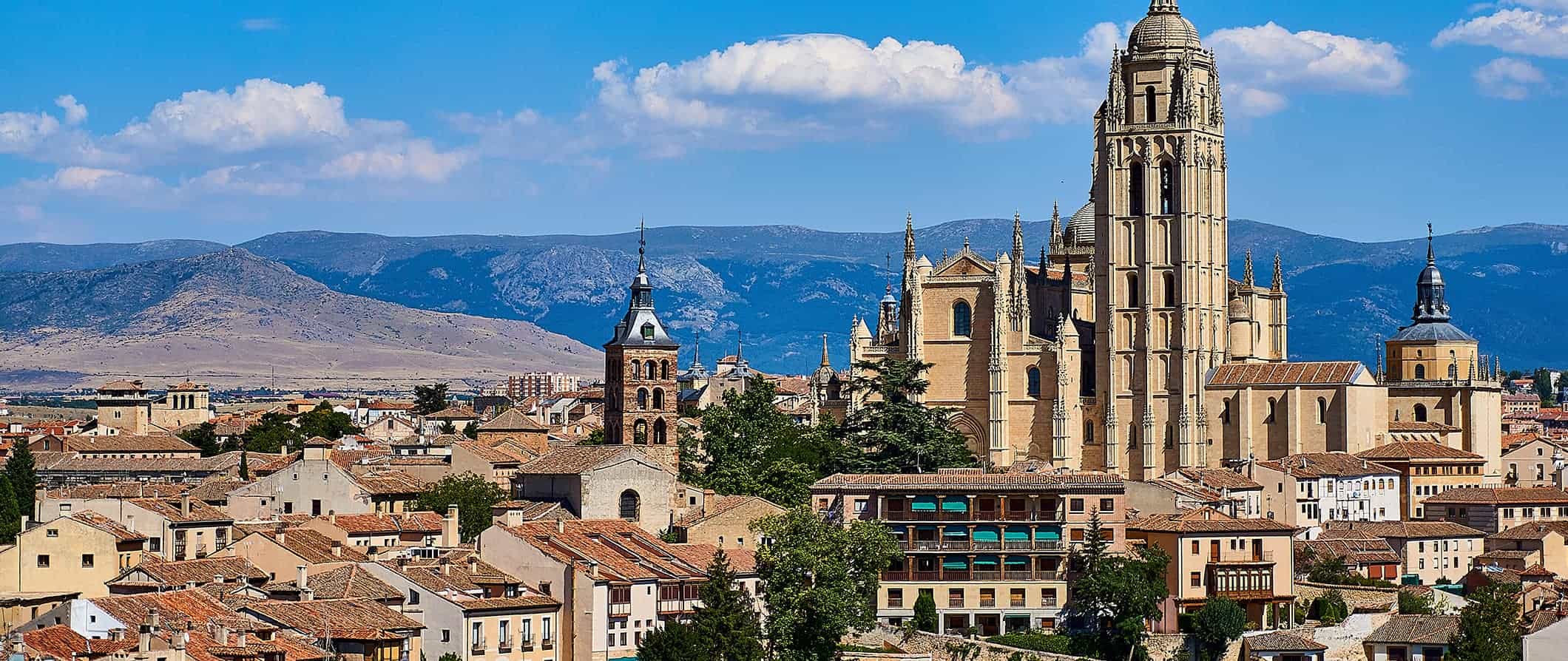
Spain is a country that moves slow. This is the land of the siesta. It’s a place for foodies, night owls, history buffs, religious pilgrims, and anyone not in a rush to do just about anything!
It’s a huge country with a lot of variety: Madrid and Barcelona are hip and energetic cities, Granada has a Moorish touch, Valencia has its own vibe, Catalonia has its own language and culture, and the Basque region (an autonomous community in northern Spain) feels like you’re in an entirely different country.
And, as an added bonus, Spain is an incredibly affordable place to visit. I’ve been traveling to the country for over a decade and I never break the bank while I’m there. It’s really easy to get by on a budget.
This budget travel guide to Spain can help you plan your trip, save money, and make the most of your time in this vibrant country.
Table of Contents
- Things to See and Do
- Typical Costs
- Suggested Budget
- Money-Saving Tips
- Where to Stay
- How to Get Around
- How to Stay Safe
- Best Places to Book Your Trip
- Related Blogs on Spain
Click Here for City Guides
Top 5 things to see and do in spain.
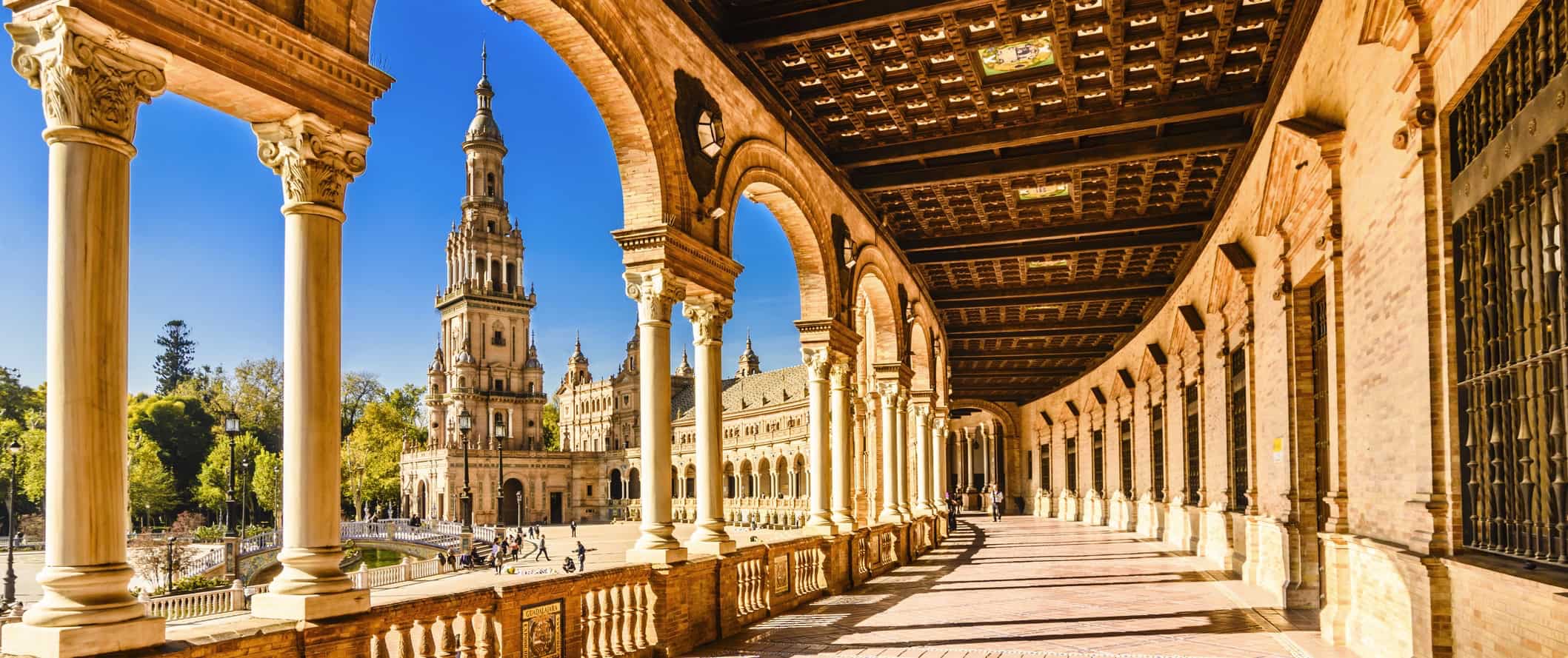

1. Enjoy Barcelona
Barcelona is famous for its all-hours partying, late-night meals, and historic streets. Embrace the nocturnal lifestyle and you’ll fit right in. Don’t miss the Museu d’Història de la Ciutat — it’s one of the best in Europe and contains the largest Roman excavation outside of Rome itself. Other highlights include the Picasso Museum (Museo Picasso), where you’ll need some time to peruse 5,000 or so of the artist’s works; the towering and iconic Basilica De La Sagrada Família , one of a number of striking buildings across the city by famous architect Antoni Gaudí; Barri Gòtic (the Gothic Quarter), where winding streets create a welcome maze built for wandering; and finding your way through the actual labyrinth that is the city’s oldest green space, Parc del Laberint d’Horta.
2. Explore the history of Granada
Granada is one of my favorite cities in Spain. It’s a place where culture, architecture, and ideas from North Africa and Europe collide in a unique way, and no trip to the south of Spain is complete without a visit. Don’t miss the Alhambra, a UNESCO World Heritage Moorish palace and fortress built in the 13th century, and the Fajalauza ceramic factory, which dates back to 1517 and still remains in the same family. There are also a number of cathedrals and monasteries, including the peaceful Monastery of San Jeronimo, with leafy cloisters and a lavish chapel (5 EUR). Be sure to watch a flamenco show while you’re here (they’re usually around 20 EUR) and visit a Moorish tearoom for mint tea (locals recommend it with plenty of sugar).
3. Wander Madrid
Madrid , the capital of Spain, is famous for its museums, tapas, and nightlife. Like Barcelona, this is a city that doesn’t get going until midnight, which makes for quiet mornings with empty streets if you want the city all to yourself. Make sure you visit Museo Del Prado, one of the largest art museums in the world (get skip-the-line tickets from Get Your Guide ), and the Royal Palace — with nearly 3,500 rooms, it’s the largest palace in all of Western Europe. Other highlights include the Temple of Debod (an Egyptian temple from the 2nd century BCE), El Retiro Park (a UNESCO World Heritage Site), the 15th-century Plaza Mayor, the city’s central square, and El Rastro market every Sunday — a mix of flea market finds, clothing, and jewelry.
4. Revel in La Tomatina
La Tomatina is an epic hour-long tomato fight that draws upwards of 20,000 people to the small town of Buñol (only 9,000 people live in the town itself). Started in 1945, this festival is held on the last Wednesday of August, and over 360,000 pounds of tomatoes are thrown during the event. It starts when water cannons fire, and it ends after exactly one hour. It’s the most amazing and messy festival I’ve ever been to! (Tip: Stay in Valencia for more overnight options.)
5. Discover Seville
Other things to see and do in spain, 1. lounge on the costa del sol.
Hang out on the beach and enjoy the laid-back lifestyle for which Spain is famous. This slice of southern Spain is renowned for its beaches, nightlife…and tons of tourists. That said, it’s still a fun place to eat great food in seaside restaurants (the region is famous for pescaito frito , or deep-fried fish), enjoy watersports in the clear Alboran Sea, drink sunset cocktails, and relax on beautiful beaches. Malaga is one of the go-to destinations on the coast, but I think there are better places further down, like El Bajondillo’s white sand beach and the incredible seafood surrounding La Carihuela beach. To beat the crowds, visit during the shoulder season. The weather will still be warm, but it won’t be as crowded.
2. See Valencia
Valencia is a pretty amazing town. Initially, I wasn’t attracted to Valencia — I simply went for the tomato fight in nearby Buñol (most participants use Valencia as their base during the festival). However, Valencia grew on me as I explored the city, as it makes for a quiet stop between Spain’s more lively cities. Originally a Roman colony and once the capital of Spain, it has delicious seafood, a unique local paella (rather than seafood, the recipe uses chicken, rabbit, and beans), a popular soccer club (Valencia CF), and a giant food market (Mercado Central) housed in an extravagant domed building that looks like a cathedral. It’s a cool city that straddles the past and future with historic streets, futuristic museums — there’s literally a museum focused on “enlightenment and modernity,” and an awesome seaside boardwalk that passes plenty of great tapas spots and the historic fishing district of Cabanyal.
3. Walk the Camino de Santiago
El Camino de Santiago, or The Way of St. James, is one of the most popular pilgrimage routes in the world. The path most people take, the French Way, runs from the border of France all the way to Santiago de Compostela in northwestern Spain. Stretching 800 kilometers (500 miles), you need around a month to complete the entire route. The mostly flat Camino is best done in May¬–June or September–October (July and August are both very busy and very warm). If you have the time, it’s a really great way to see the country and some of the less-visited areas of Spain. Of course, you can also walk sections of it if you just want to see what it’s like on a day hike.
4. Tour the islands
Spain has some of the most beautiful islands in all of Europe. Unsurprisingly, during July and August, they’re crowded and expensive, so try to avoid peak season. If you love beaches, surfing, hiking, or cycling, then be sure to hit up Gran Canaria, a UNESCO Biosphere Reserve filled with beautiful landscapes and wildlife, including dolphins. If you’re coming to Spain to party, a stop in Ibiza for its all-night clubs is a must. Other islands worth checking out are Tenerife (home to Teide National Park and the highest peak in Spain), Majorca (for turquoise water and medieval architecture), and La Palma (a certified Starlight Reserve). Ferries from Barcelona and Valencia run frequently from late spring to early summer. In the winter, ferries only run a few times a week.
5. Visit Gibraltar
Bordering Spain on the Iberian peninsula, Gibraltar has actually been an overseas territory of the United Kingdom since 1713. It’s known as “The Rock,” owing to the 426-meter-high (1,397-foot) limestone ridge that dominates the island — you can ride a cable car to the top, or get great views by climbing the 18th-century Mediterranean Steps. There’s an interesting mix of cultures here too, with influences from Britain, Spain, and North Africa. With sunny days year-round, views of two continents (Europe and Africa), wildlife galore (including Gibraltar monkeys, which are actually Barbary Macaques and the only population of wild monkeys in Europe). There are also plenty of sandy of beaches and caves to explore (St Michaels Cave is probably the most popular), it’s a small swatch of land with enough to see and do to make a short visit worthwhile.
6. Play in the Sierra Nevadas
This mountain range, located within Spain’s largest nathional park, is in southeastern Spain near the Mediterranean Sea. It’s the perfect place for summer hiking, winter skiing, and exploring small towns year-round. The area is one of the prettiest and most rugged regions in Spain and one of the better areas for outdoor activities in the country. There are plenty of trails ranging in length and difficulty, as well as the possibility for guided tours. Popular hikes include Mulhacen (6 hours), El Chullo (4-5 hours), and Pico de Veleta (4-5 hours). Lift passes for skiing at Sierra Nevada resort in the winter start at around 50 EUR per day.
7. Visit San Sebastián
Known as Donostia in Basque, San Sebastián is at the center of the Basque area of Spain. This place has killer nightlife and beaches (La Concha beach is the most popular), as well as loads of history throughout the city. It was founded in 1180 in the area that’s now become the Old Quarter. = The architecture — a cool mix of 16th-century Gothic churches, 19th-century mansions, and ultra-modern buildings — makes it one of the most beautiful and unique cities in all of Spain. For stunning views of the coast, hike up one of the 4 trails of Monte Urgull, located at the tip of La Concha. The city sees a fraction of the visitors compared to c Madrid or Barcelona so it’s much less crowded (and less expensive ). The regional Basque cuisine here is delicious, so be sure to take a food tour while you’re here.
8. Admire the Great Cathedral and Mosque
The Mezquita de Córdoba (Cathedral of Our Lady of the Assumption) is by far the most exquisite example of Muslim influence in Spain. Located in Córdoba just east of Seville, its giant arches, jasper columns, marble floors, richly gilded prayer niches, and the awe-inspiring domed shrine of Byzantine mosaics take you back to when Córdoba was under Muslim influence in the 12th century. Admission is 13 EUR and skip-the-line guided tours are 24 EUR.
9. Unwind in Salamanca
Salamanca seems to be in the middle of nowhere (it’s 2.5 hours northeast of Madrid by car), but it’s worth the detour for the history (it dates back to the Celtic era), and its historical Old Quarter which is a UNESCO World Heritage Site. The university town has a mix of small-town atmosphere, great nightlife, and plenty of backpackers. In the old quarter, join the other tourists trying to spot the frog carved into the 16th-century university facade — said to bring professional success. The main square, Plaza Mayor, is one of the largest in Spain and is great for soaking up the city, and the nearby cathedral is gorgeous. It’s actually two cathedrals —an Old, from the 12th and 13th centuries, and New, from the 16th — joined together.
10. Hike the Pyrenees
The majestic mountain chain that walls off France is laced with medieval villages, high mountain walking trails, and great skiing. It’s also the traditional start of the Camino (see #3 above). You can hike through the Pyrenees on one of three established routes, but it takes most people almost two months to complete the entire trek (choose spring or fall, summer will be extremely hot). Of course, you can also just hop on the Camino for a single-day hike or weekend hiking trip along one of the moderate routes. If you don’t want to go solo, you can take a full-day hiking tour of the Pyrenees from Barcelona with Get Your Guide .
11. Visit the Guggenheim Museum
One of the most famous museums in the world, the Guggenheim Museum Bilbao (a port city in northern Spain) always has some interesting exhibitions on modern art (including a permanent sculpture, “Snake,” that’s made of hot-rolled steel and spans more than 100 feet long!). There is also the iconic (and giant) spider sculpture outside the museum, and pieces by Rothko hang inside. Even if you’re not a modern art fan (I personally don’t love it), it’s still worth stopping by because the building is art itself. Frank Gehry, arguably one of the most famous living architects, designed it to have an eye-catching, undulating style, and the grand atrium alone is worth a visit. Admission starts at 16 EUR.
12. Explore Basque Country
Basque Country is an autonomous region in Spain, a place with its own unique culture and heritage. (The Basque people inhabited the area before Spain became a nation.) Located in the northeast corner of the country, you’ll notice the cultural and linguistic differences as soon as you step foot in the region. If you’re into off-the-beaten-path locations, be sure to tour Basque Country, which offers coastal areas, small towns, and mountains. Don’t miss the 153-year-old La Bretxa market in San Sebastian (open every day except Sunday), the Gothic-style St. Mary’s Cathedral in Bayonne, and Le Grand Stroll in Biarritz while you’re here. (The start of the Camino passes through the area as well.) La Rioja wine region can also be found in Basque Country — try its famous drink, a white wine called txakoli . Expect lots of seafood, lamb dishes, and pintxos (Basque tapas).
For more information on specific cities in Spain, check out these guides:
- Barcelona Travel Guide
- Granada Travel Guide
- Madrid Travel Guide
- Seville Travel Guide
- Valencia Travel Guide
Spain Travel Costs
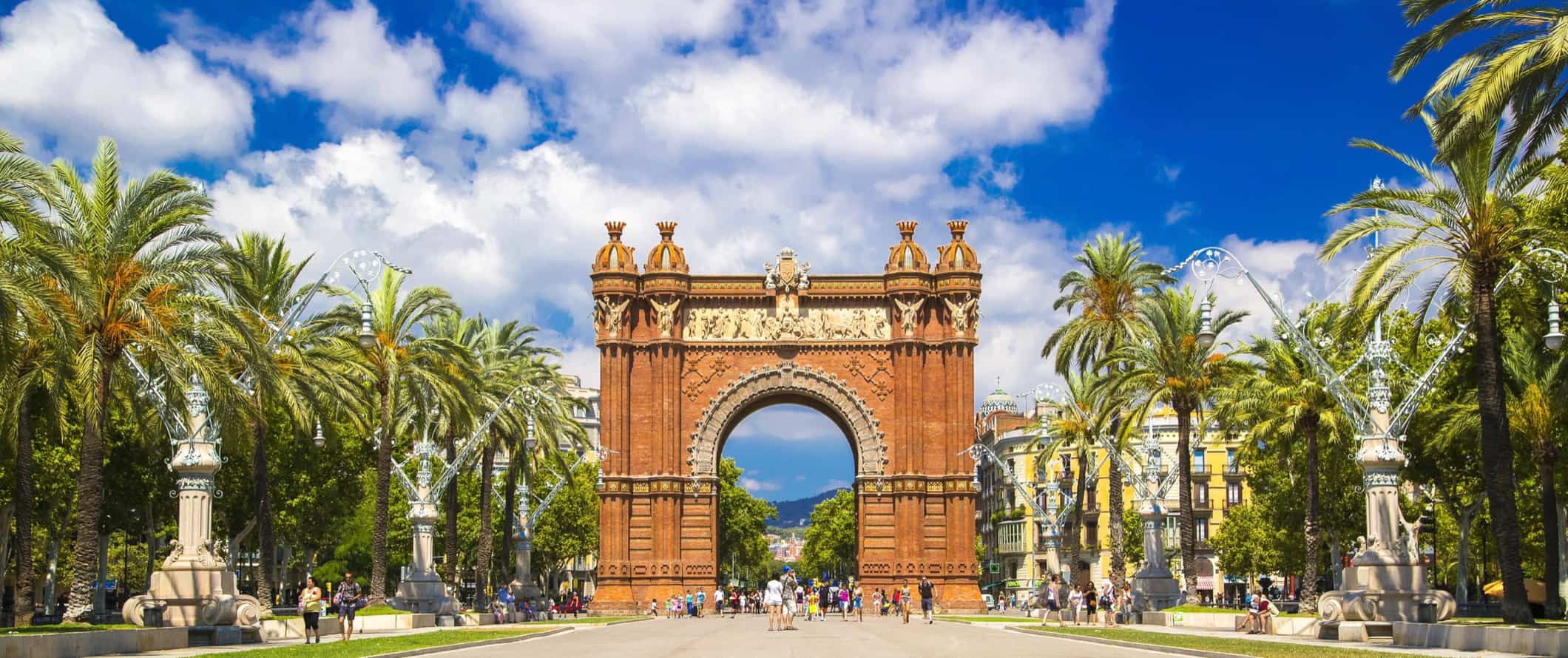
Budget hotels begin around 125 EUR for a twin or double and go up from there. Prices are slightly lower outside of the major cities and tourist areas but are about 20-30% higher during peak season. For larger cities during the summer high season, expect to spend closer to 200 EUR or more a night.
Airbnb is common in most major cities, with a private room starting around 60 EUR per night. For an entire home or apartment, expect to pay at least 120 EUR per night (often double that in the big cities or during peak season).
For those traveling with a tent, there are hundreds of campsites across Spain. Campground costs around 20 – 40 EUR per night. They can be as low as 5-10 EUR for a basic tent plot without electricity, while other costlier sites (around 50 EUR per site) often include extra luxuries like a pool, electricity, and Wi-Fi.
Food – Spain has a strong food culture. Meals can last for hours, and dinner often isn’t served until after 8 p.m. Each region in the country has its own local dishes and food culture, but there are some common favorites, like paella (originally from Valencia), gazpacho, churros, jámon ibérico (cured pork), patatas bravas (fried potatoes with sauce), gambas al ajillo (garlic shrimp), and tortilla (Spanish omelet).
You can usually find tapas and sandwiches for 5–10 EUR. Assembling a meal of tapas at a casual bar usually costs around 15-20 EUR, including a glass of wine. Cheap fast food (think McDonald’s) costs around 9 EUR for a combo meal. Chinese food is around 10 EUR for a main dish, while pizza costs 10-14 EUR.
Beer is 3–4 EUR, a glass of wine is 2-4 EUR, and a latte/cappuccino is around 2 EUR. Bottled water is about 1.50 EUR. (In general, tap water is safe to drink in Spain.)
A decent casual restaurant meal costs around 25-30 EUR with a drink. If you go out for paella, drinks, or appetizers, plan to spend around 35-45 EUR for a meal.
Spain has a lot of expensive restaurants if you want to splash out. Meals at finer establishments begin around 55 EUR.
If you plan on cooking your own food, groceries cost around 45-65 EUR per week. This gets you basic staples like pasta, rice, seasonal produce, and some meat or seafood. You can find the cheapest (and freshest) produce and meat at local markets.
Backpacking Spain Suggested Budgets
On a backpacking budget of 90 EUR per day, you can afford to stay in a hostel dorm or private Airbnb room, cook most of your meals, limit your drinking, take public transportation to get around, and do mostly free activities like free walking tours and relaxing in the parks. Add at least 20 EUR per day to your budget if you plan on drinking or partying a lot.
On a mid-range budget of around 215 EUR per day, you can stay in a private room in a hostel, or a 2-star budget hotel, eat out at inexpensive restaurants for most meals, have a few drinks, take the occasional taxi, and do more paid activities like cooking classes and museum visits.
On a “luxury” budget of 350 EUR or more per day, you can stay in a nicer hotel or entire Airbnb apartment, eat out regularly, drink more, take more taxis, and enjoy more guided tours. This is just the ground floor for luxury though. The sky is the limit!
You can use the chart below to get an idea of how much you need to budget daily. Keep in mind these are daily averages — some days you spend more, some days you spend less (you might spend less every day). We just want to give you a general idea of how to make your budget work. Prices are in EUR.
Spain Travel Guide: Money-Saving Tips
Overall, Spain is pretty affordable. While accommodation costs in most touristy as well as larger cities have risen greatly in the last few years, everything else is still affordable. Individual city guides have more specific information on how to save in each city, but here are some general ways to save money while traveling around Spain:
- Get the menu of the day – Most restaurants offer a cheap and filling “menu of the day” ( menu del dia during lunch for around 10–15 EUR per person. They are a good way to save money while enjoying some delicious Spanish food. Wine or water are generally included, too. Look for more crowded spots — that’s how you know the food is good. Skip eating out for dinner — it’s too expensive!
- Eat free tapas – In some cities (like Granada), you can find bars where free tapas are given out when you order drinks. Bounce around the bars to eat cheap while enjoying a few drinks.
- Stay with a local – Couchsurfing is a great way to save money on accommodations while also getting some insights from locals. You might have better luck in the larger cities, but be sure to book early as the major cities also see the most requests.
- Take the bus – While the train system is fast, it’s expensive, with high speed trains double (or more) the cost of buses. If you have the time and want to save money, take buses to get around the country. It will take longer but, if you’re on a budget, it will be worth it. And look at booking your tickets online and in advance — it can save you money.
- Get a city pass – Most of the major cities have multiple museums, attractions, and activities worth checking out. Buying a city pass — like the Madrid City Card (from 8.40 EUR) or Malaga–Costa Del Sol Sightseeing Pass (starting at 14 EUR) — can save you money on these activities and also get you free transportation. These passes will save you a lot of money if you’re planning on visiting the major sights.
- Ride a bike – Tourists can use public bikes in cities such as Madrid and Seville for a daily or weekly fee. Take note, Barcelona’s red city bikes (Bicing) are for residents only, but you can find shops that offer daily or weekly bike rentals.
- Use BlaBlaCar – This app connects you with drivers who have room in their cars for additional passengers. Drivers are vetted and verified, so it’s a cool way to get out of stuffy trains and buses, meet interesting characters, and take a mini road trip. It’s one of my preferred methods of travel for medium- and long-distance trips.
- Bring a water bottle – The tap water here is safe to drink, so bring a reusable water bottle to save money and reduce your plastic use. Spain now offers more water fountains and bottle-filling stations than in the past. LifeStraw is my go-to brand as their bottles have built-in filters to ensure your water is always clean and safe.
Where to Stay in Spain
Spain has plenty of budget-friendly hostels and hotels all around the country. Here are some of my recommended places to stay:
- HelloBCN Hostel (Barcelona)
- Hotel BestPrice Gràcia (Barcelona)
- OK Hostel (Madrid)
- Petit Palace Puerta del Sol (Madrid)
- The River Hostel (Valencia)
- Red Nest Hostel (Valencia)
- Oasis Backpacker’s Hostel (Seville)
- Onefam Centro (Seville)
- ECO Hostel (Granada)
- Hostal Antares (Granada)
For more places to stay, check out the city specific destination guides.
How to Get Around Spain
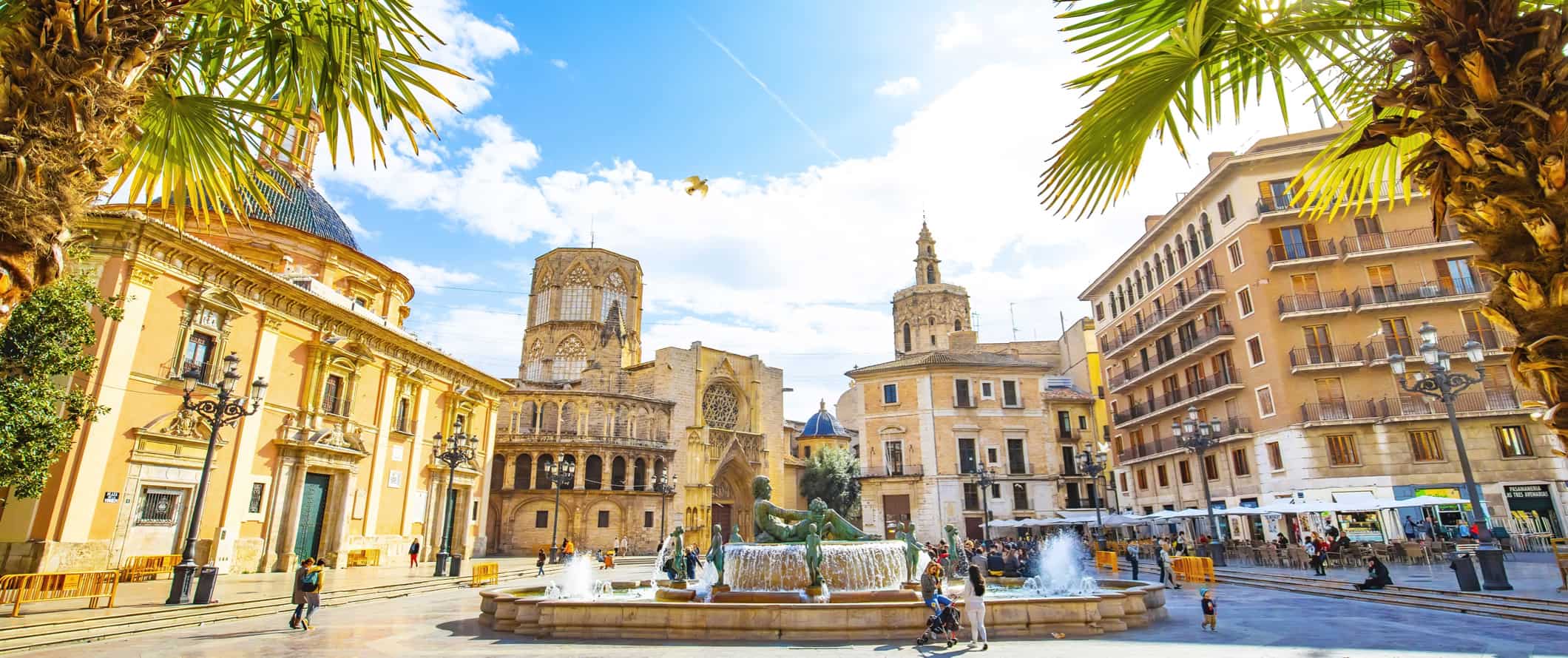
Bus – The bus is the cheapest option for getting between cities in Spain. FlixBus has tickets starting as low as 6 EUR. Most buses come with outlets and free Wi-Fi. A 9–hour trip from Madrid to Barcelona starts from about 35 EUR, while the 4–hour trip between Seville and Granada costs around 25 EUR. Alsa is another popular bus company for travel throughout the country.
Trains – RENFE is the national rail line in Spain. High-speed trains are more expensive, but you can travel between Madrid and Barcelona in just 2.5 hours. Even on the more expensive high-speed train, however, you can find tickets from Madrid to Barcelona for as low as 55 EUR during off peak times in the offseason. The trip from Madrid to Seville is around 2.5 hours and costs 35 EUR, while Madrid to Valencia is just under 2 hours and costs 30 EUR.
To find routes and prices for trains around Spain (and Europe), use Trainline .
A Eurail Pass , which allows travelers to explore Europe by providing a set number of stops in a specific time period, might also be a good option depending on your plans. For more information, here’s a detailed breakdown of how Eurail passes work and can save you money .
Flying – If you’re pressed for time and are looking to hop from one city to the next, a budget airline. You can find really cheap fares on most routes.
However, be aware that you have to pay for all the extras on these cheap flights (such as checked baggage, picking your own seat, etc.) So, while flights are cheap (Madrid to Barcelona can be found for as little as 65 EUR round trip), the little expenses add up. And when you factor in getting to/from the airport, most flights really aren’t much faster than the train.
Car rental – Car rentals can be found for as little as 25 EUR per day for compact vehicles when booked in advance. Make sure to check if the car is standard or automatic when reserving. Renters will need an International Driving Permit prior to book. The minimum age for renting a car is 21. For the best rental car deals, use Discover Cars .
Ridesharing – If your schedule is flexible, use a ridesharing service and catch rides with locals between cities. Drivers are verified and it’s perfectly safe. BlaBlaCar is the biggest company.
When to Go to Spain
Spain is lovely year-round, but the peak season — meaning, busiest and most expensive— is in the summer, from June to August. Popular destinations like Barcelona and Ibiza experience a massive influx of tourism — so much so that Barcelona’s residents have started clamping down on overtourism. Accommodations in the larger cities require serval months of advance booking is summer, and small shops may be closed in August for family holidays. The weather is fabulous this time of year, with high temperatures well into the 30s°C (90s°F)
The temperature in Spain doesn’t often drop too low, with winter temps between 4-10°C (40-50°F) country-wide. However, Northern Spain does sometimes experience snowfall — especially in the mountainous areas. While I wouldn’t aim to visit in the winter, if you’re already in Europe, this is going to be one of the warmer destinations on the continent, especially in the south. Madrid and Barcelona have plenty of holiday festivals in December and early January for Christmas and Three Kings Day. If you are in Spain during the holidays, visit a bakery to try traditional, seasonal desserts.
The shoulder seasons (spring and autumn) are great times to visit. Tourist sites are less congested (think Gaudi attractions in Barcelona)and prices are a bit cheaper, especially accommodations in Barcelona or Madrid. Temperatures are pleasant, although it’s not exactly beach season. Beach destinations like Ibiza and Mallorca tend to get very quiet during this time, but there is still plenty to see and do around the rest of the country. If you plan on outdoor activities or hiking the Camino de Santiago, this is the time of year to do it.
How to Stay Safe in Spain
Spain is pretty safe to visit. Violent attacks are uncommon, and the country is safe for solo travelers However, petty crime is really widespread and pickpocketing is very common in the larger cities, especially near major tourist sites (such as La Rambla in Barcelona) and on public transportation. Always keep your valuables secure and out of sight when on public transportation and when out and about. The thieves here are incredibly quick here. Report thefts to the local police, or ask your hotel or hostel how to file a report.
Be extra careful in Barcelona, especially in high season, where people may try to snatch your phone on the street or grab your stuff in crowded subways (pickpocketing is not as bad elsewhere in Spain). Also, never leave your backpack, phone, or laptop out and unsecured when at a cafe or restaurant. They can disappear in the blink of an eye.
Scams are also very common, especially in the larger cities (not that common though in smaller cities). Keep an eye out for kids in groups who might try to distract you before lifting your wallet, as well as people who might offer to “help” carry your luggage or take your photo, only to expect a hefty tip as thanks. You can read about common travel scams to avoid here .
Solo female travelers should generally feel safe here. However, the standard safety precautions apply (always keep an eye on your drink at the bar, never walk home alone at night while intoxicated, etc.). Many hostels also have female-only dorm rooms. For specific tips on staying safe, check out one of the many solo female travel blogs on Spain. They’ll be able to provide specific advice that I, a man, can’t.
If you experience an emergency, dial 122 for assistance.
Always trust your gut. Make copies of your personal documents, including your passport and ID, and keep them separate from your originals. When you’re walking around, take minimal cash and one form of ID.
The most important piece of advice I can offer is to purchase good travel insurance. Travel insurance protects you against illness, injury, theft, and cancellations. It’s comprehensive protection in case anything goes wrong. I never go on a trip without it as I’ve had to use it many times in the past. You can use the widget below to find the policy right for you:
Spain Travel Guide: The Best Booking Resources
These are my favorite companies to use when I travel. They consistently have the best deals, offer world-class customer service and great value, and overall, are better than their competitors. They are the companies I use the most and are always the starting point in my search for travel deals.
- Skyscanner – Skyscanner is my favorite flight search engine. They search small websites and budget airlines that larger search sites tend to miss. They are hands down the number one place to start.
- Hostelworld – This is the best hostel accommodation site out there with the largest inventory, best search interface, and widest availability.
- Booking.com – The best all around booking site that constantly provides the cheapest and lowest rates. They have the widest selection of budget accommodation. In all my tests, they’ve always had the cheapest rates out of all the booking websites.
- HostelPass – This new card gives you up to 20% off hostels throughout Europe. It’s a great way to save money. They’re constantly adding new hostels too. I’ve always wanted something like this and glad it finallt exists.
- Get Your Guide – Get Your Guide is a huge online marketplace for tours and excursions. They have tons of tour options available in cities all around the world, including everything from cooking classes, walking tours, street art lessons, and more!
- The Man in Seat 61 – This website is the ultimate guide to train travel anywhere in the world. They have the most comprehensive information on routes, times, prices, and train conditions. If you are planning a long train journey or some epic train trip, consult this site.
- Rome2Rio – This website allows you to see how to get from point A to point B the best and cheapest way possible. It will give you all the bus, train, plane, or boat routes that can get you there as well as how much they cost.
- FlixBus – Flixbus has routes between 20 European countries with prices starting as low 5 EUR! Their buses include WiFi, electrical outlets, a free checked bag.
- SafetyWing – Safety Wing offers convenient and affordable plans tailored to digital nomads and long-term travelers. They have cheap monthly plans, great customer service, and an easy-to-use claims process that makes it perfect for those on the road.
- LifeStraw – My go-to company for reusable water bottles with built-in filters so you can ensure your drinking water is always clean and safe.
- Unbound Merino – They make lightweight, durable, easy-to-clean travel clothing.
- Top Travel Credit Cards – Points are the best way to cut down travel expenses. Here’s my favorite point earning credit cards so you can get free travel!
- BlaBlaCar – BlaBlaCar is a ridesharing website that lets you share rides with vetted local drivers by pitching in for gas. You simply request a seat, they approve, and off you go! It’s a cheaper and more interesting way to travel than by bus or train!
- Take Walks – This walking tour company provides inside access to attractions and places you can’t get elsewhere. Their guides rock and they have some of the best and most insightful tours in all of Spain.
Spain Travel Guide: Related Articles
Want more info? Check out all the articles I’ve written on Spain travel and continue planning your trip:

The 7 Best Hotels in Madrid
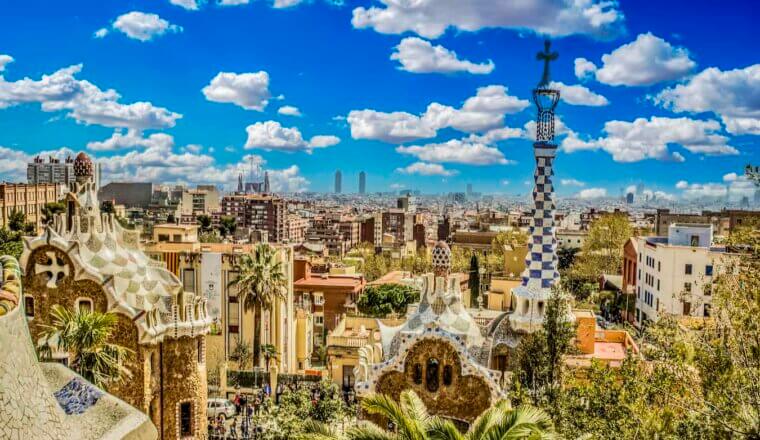
The 7 Best Hotels in Barcelona

The Best Walking Tours in Barcelona
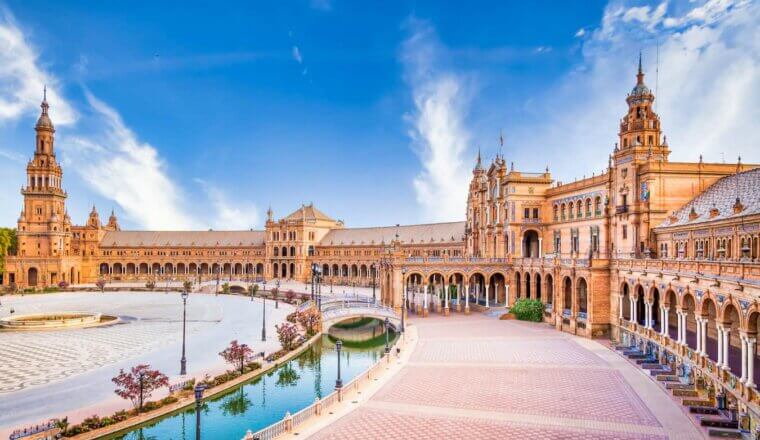
The Best Walking Tours in Seville

The Perfect 3 Day Granada Itinerary
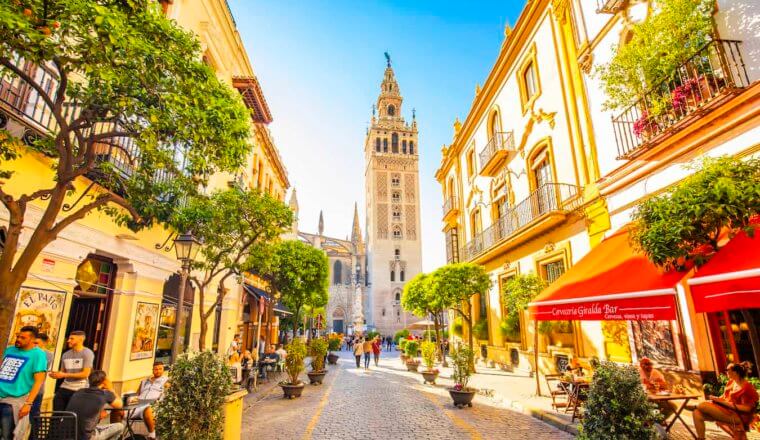
The 7 Best Hostels in Seville
Get my best stuff sent straight to you, pin it on pinterest.
- Where To Stay
- Transportation
- Booking Resources
- Related Blogs

The Ultimate Southern Spain Road Trip: Routes, Sights, Guides, Maps And More
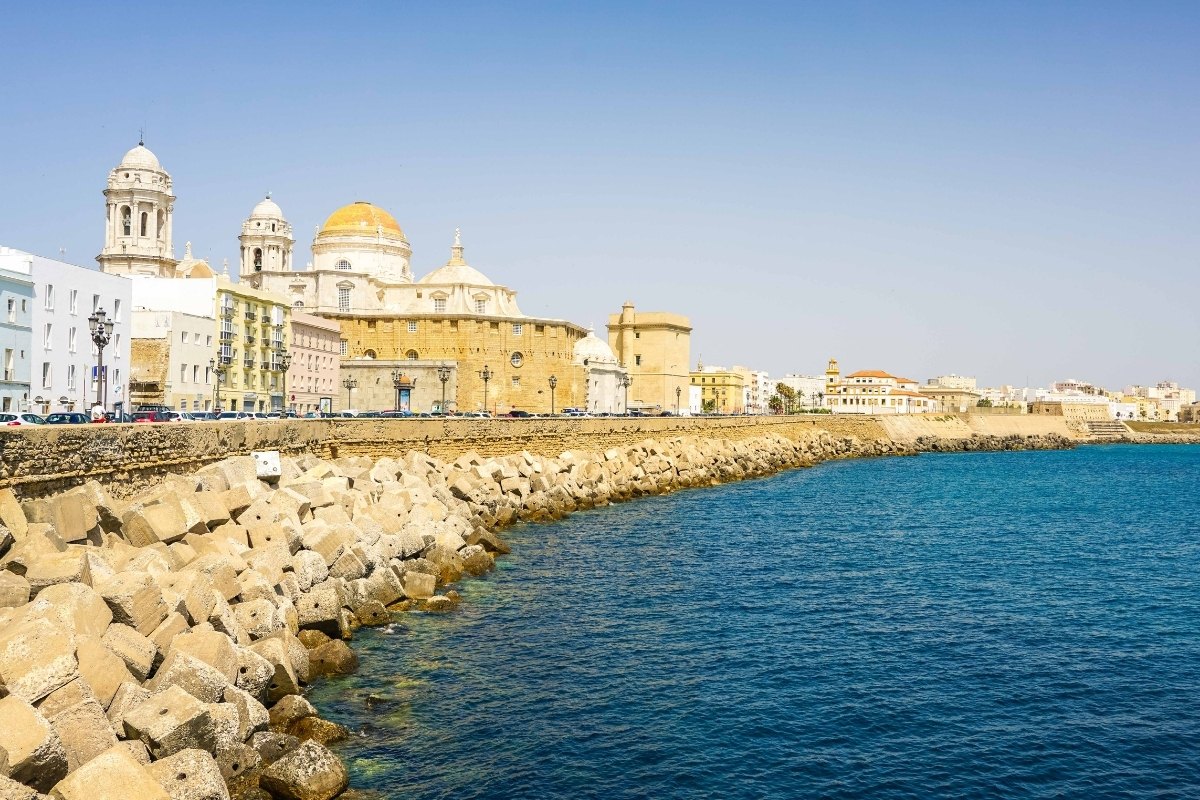
From the historic cities of Seville and Cordoba, to the natural beauty of Ronda and the spectacular beaches of Cadiz and Valencia, this southern Spain road trip offers something for everyone.
Grab your keys, we’re going on a road trip! Is there any better way to get to grips with a country than driving around it? I love having the freedom to explore at my own pace! If this is your favourite way to travel too, then I’d definitely recommend a road trip through the south of Spain.
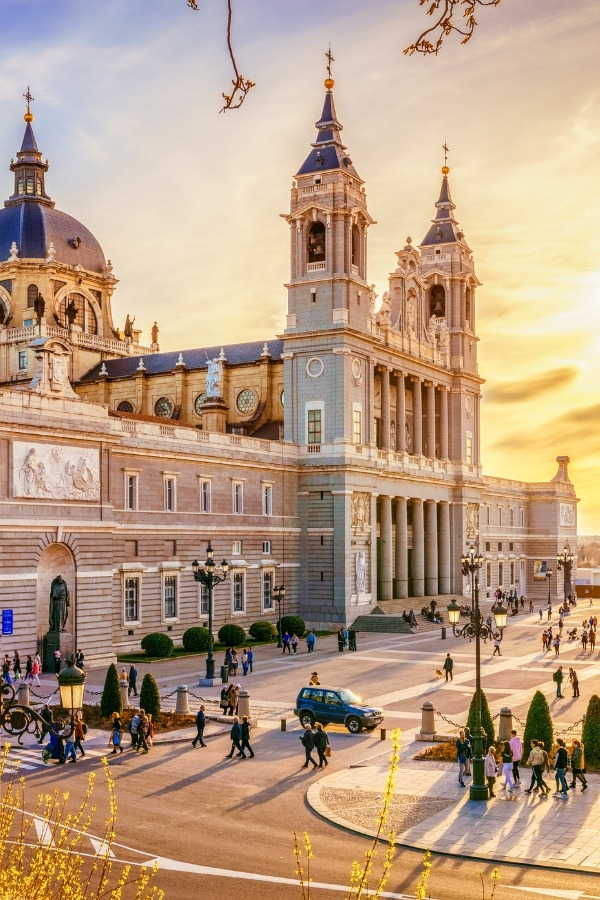
It’s a region I’ve visited on numerous trips, but only now am I piecing all the destinations together into one amazing road trip. This southern Spain itinerary offers so much. You’ll kick off in Madrid (lots of rental car options!) and spend your time visiting the museums and galleries, before travelling to the coast and enjoying the vibrant city of Valencia and the region of Murcia.
Then it’s time to kick off the next section – the Andalusia road trip! You’ll visit the peaks of Spain’s impressive Sierra Nevada mountains before immersing yourself in Andalusia’s fascinating history with trips to cities including Granada, Sevilla, Cadiz and Cordoba.
If you’re short on time, you could pick one section of this trip, and then return to do another section on a future visit.
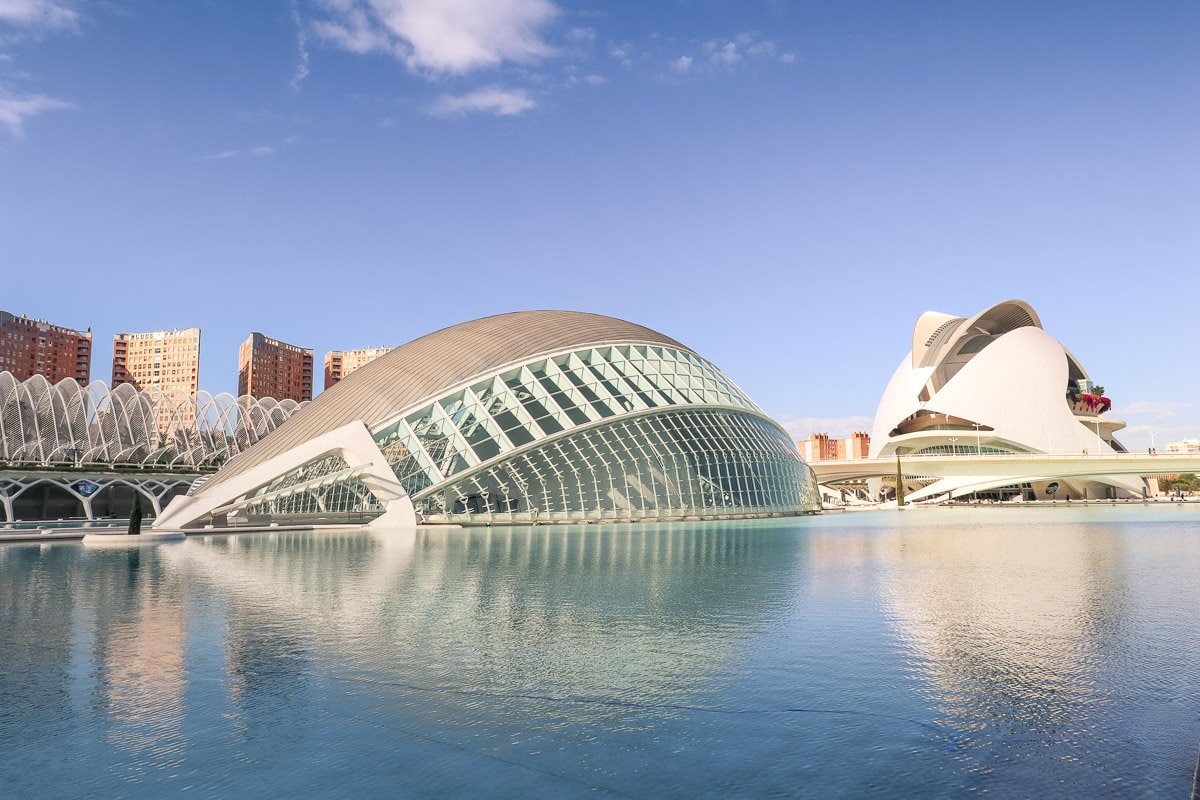
If you love art, be sure to visit Madrid’s Prado Museum and Malaga’s Pompidou Centre. Meanwhile, nature lovers will enjoy Murcia’s natural rock formations in Bolnuevo and Ronda’s spectacular gorge.
Southern Spain is also one of the best areas in the world for history, with sights including Granada’s Alhambra, Cordoba’s Mezquita and Cadiz’s roman ruins.
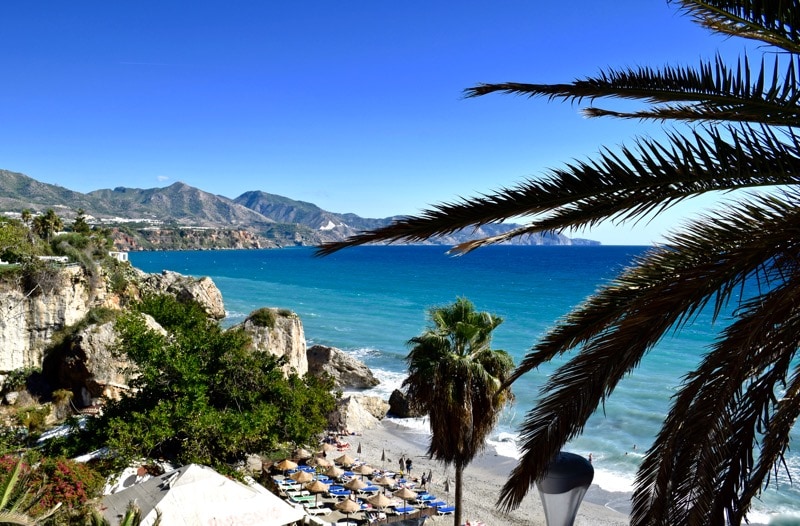
And if you’re a foodie at heart you’re guaranteed to fall in love with Spanish cuisine on this trip. Feast on tapas, sample horchata in Valencia and enjoy the simple pleasures as you bar-hop around the ancient towns and cities.
So, whether you’re looking for a bit of inspiration or you’re already planning your itinerary, this guide will cover all of the best places to visit in Southern Spain on a road trip.

Weather in southern Spain
This region of Europe has warm summers and mild winters. While the summer holidays are a popular time to visit southern Spain, it’s also a great option in the colder months, when it offers some of the warmest winter temperatures in Europe.
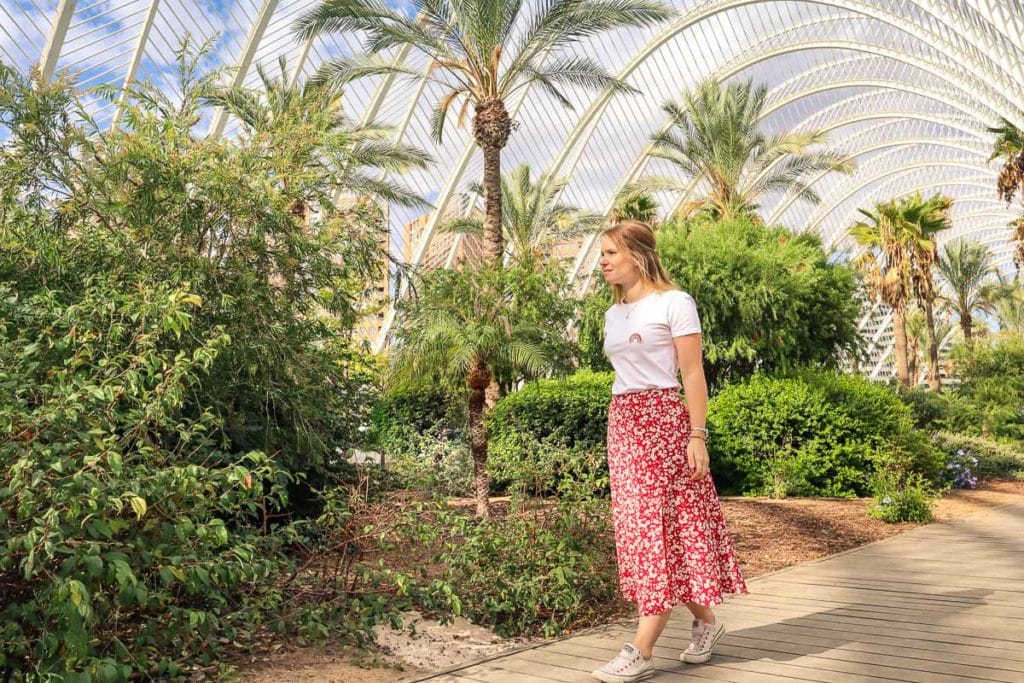
The warmest and sunniest month of the year is July, with average temperatures around 28°C (82°F). The coldest temperatures are in December and January, with averages of 11°C (52°F).
However, some years the temperatures have reached 18°C in these months, so it can be a lovely place to escape the cold in northern Europe. The wettest month is March, so you may want to avoid visiting then.
Southern Spain Road Trip Map
If you’re happy to travel at a pretty moderate pace, moving on every single day, you could just about fit this itinerary into ten days. However, I’d recommend moving a little slower so you can soak up all the little details in each destination.
This is one of the most scenic drives in southern Spain, so even the journeys between destinations are enjoyable.
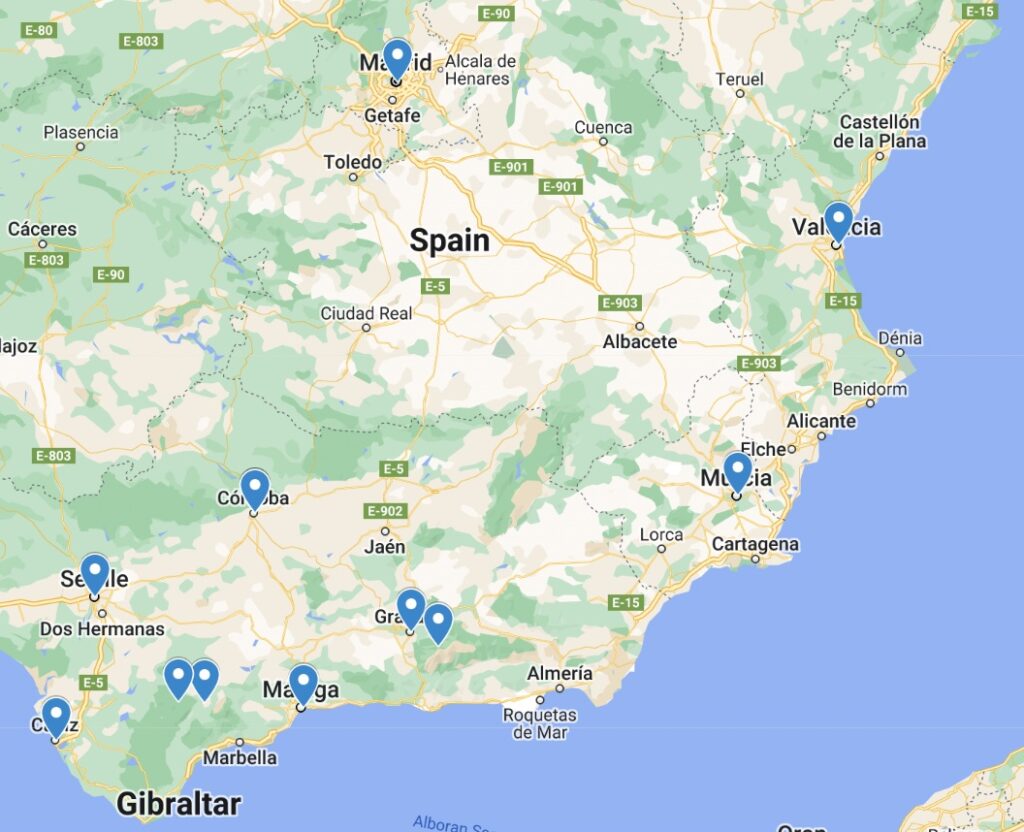
Here’s a handy map to go with this southern Spain road trip itinerary, which you can save to make your planning stress-free.
What to pack for your road trip
If you’re wondering what to pack for your trip, this guide to road trip essentials has you covered. From portable chargers to ways to stay entertained on long journeys, it’ll help you create your road trip packing list.
Southern Spain Road Trip Itinerary – Places To Visit In Southern Spain
Southern spain road trip: stop 1 – madrid.
Kick off your trip in Spain’s amazing capital city. Madrid is somewhere I often think is underrated as it gets pigeon-holed as the business hub of the country. However, it has a lot of charm and some incredible places to visit too.
Be sure to visit the oldest monument in the city, the Temple of Debod. The series of gateways here make up an ancient Egyptian temple that was presented to Spain by the Egyptian state. It was originally located close to Aswan and dates back to 200BC! It’s an amazing place for photography, with beautiful reflections in the pool of water.
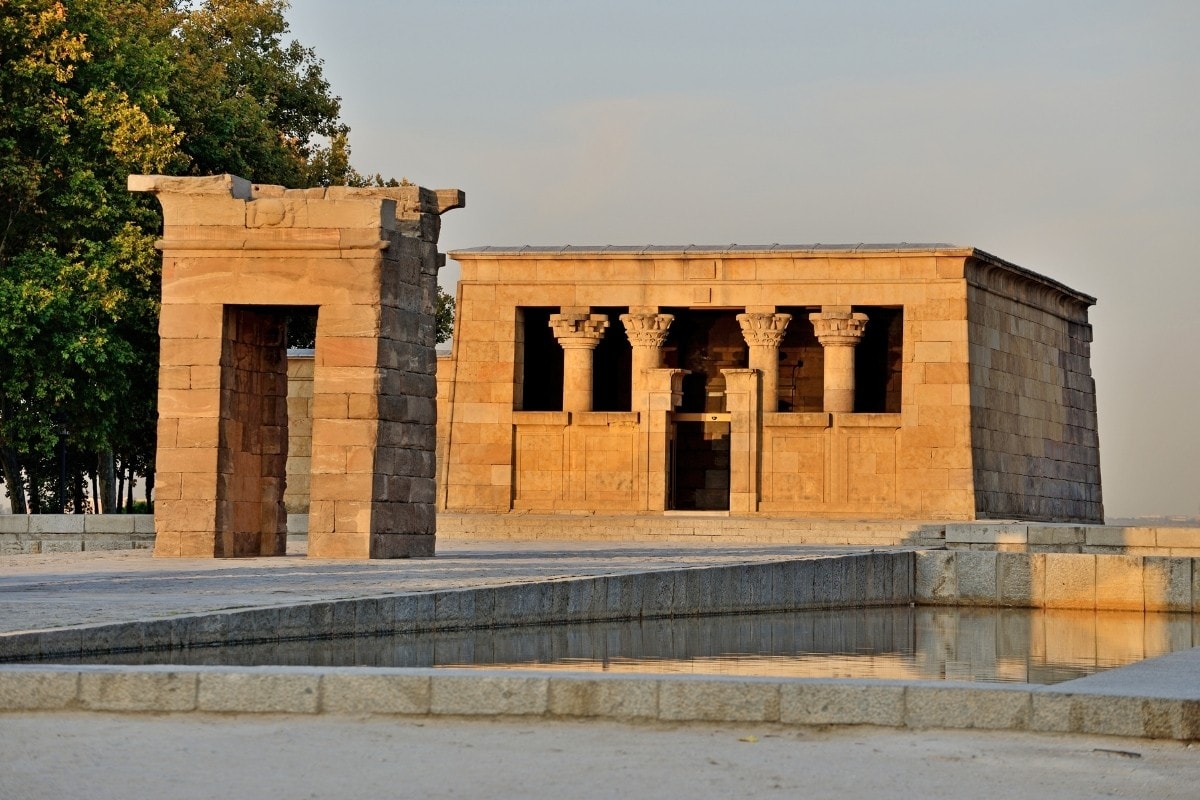
Art lovers simply must pay a visit to one of Madrid’s most famous attractions and one of the best museums in Europe – the Prado Museum . This enormous museum is considered as one of the greatest art museums in the world, and it’s not hard to see why!
The museum contains one of the largest collections of European art, with more than 15,000 paintings, drawings and prints, as well as over 1,000 sculptures. There are notable artworks by Goya, El Greco and Rubens and Titians.
One of the key pieces to see is Las Meninas by Velázquez. You could spend all day here, but remember there’s plenty more to see in the city! If you do decide to visit, I’d recommend booking a ‘skip the line’ ticket so you don’t waste hours queueing.
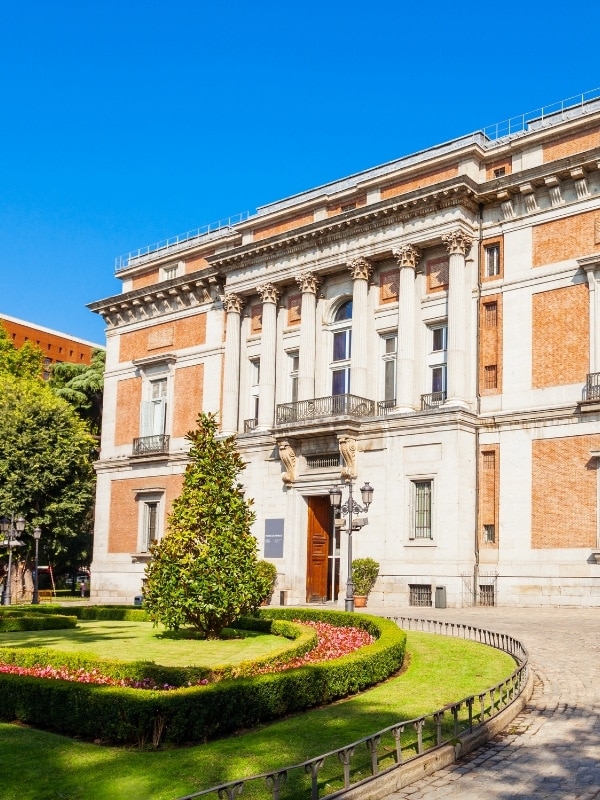
History lovers will also enjoy visiting the Palacio Real de Madrid (the Royal Palace). This palace takes the trophy for being the largest palace in Europe and it’s open to the public so you can have a nosy around!
For an escape from the busy streets of Gran Via and Puerta Del Sol, I’d recommend wandering around Retiro Park. This is a stunning and vast park with a large lake. It’s a serene place to take a picnic or grab an ice cream.
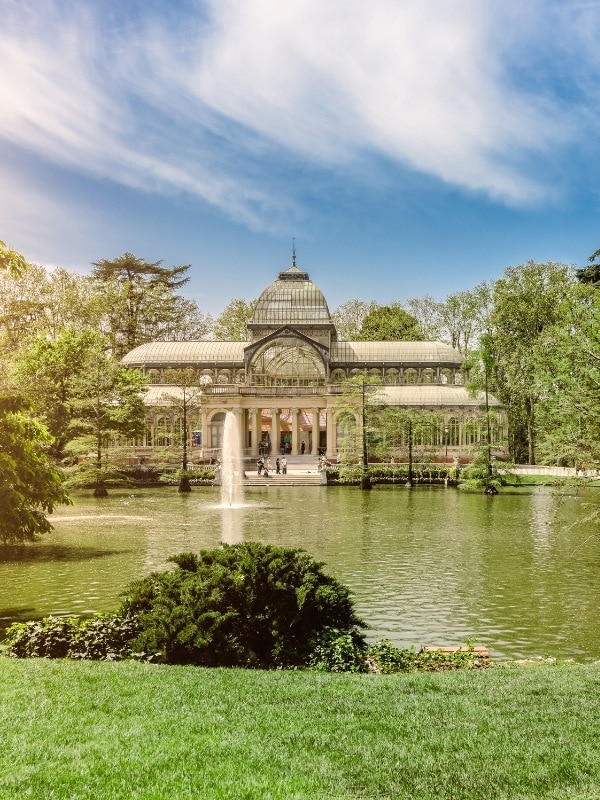
Are you someone who travels for food? Then you’ll definitely enjoy your time in Madrid. I’d recommend eating your way around Mercado San Miguel where you’ll find stalls selling everything from popular tapas dishes to sushi and ice cream. I love the food here – there is so much choice and the market has a great atmosphere.
For a sweet treat, pick up some churros from Chocolateria San Ginés . This café has been serving these delicious crispy sticks of fried batter with its signature hot chocolate sauce for well over 100 years. It’s something of an institution!
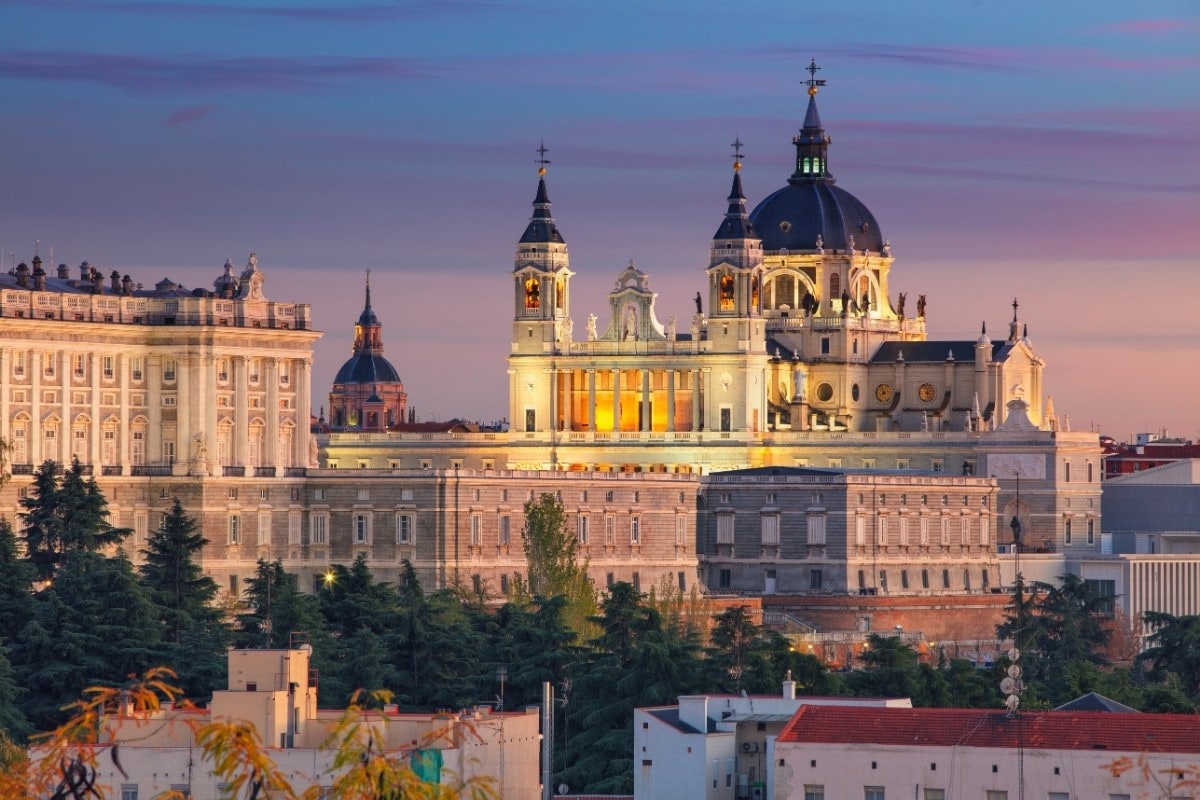
There’s a cool bar culture in Madrid too. I’d recommend checking out the likes of El Imperfecto and Café Central where there’s often live music. For a cheap meal, enjoy the aperitivo culture at El Tigre. Just order a drink and a plate of tapas will arrive too. It’s one of the most budget-friendly ways to eat out in Madrid.
If you’re deciding where to stay in the city, check out my guide to the best hotels in Madrid . There’s something for every budget.
Madrid to Valencia: 360 km / 3 hr 45 mins approx.
Southern Spain Road Trip: Stop 2 – Valencia
The second stop on this southern Spain itinerary is Valencia, one of my favourite cities in Spain. With its historic old town, modern museums and gorgeous beach, it’s a really varied destination. I’ve written lots of detailed Valencia travel guides so definitely take a look at those for more info on the city.
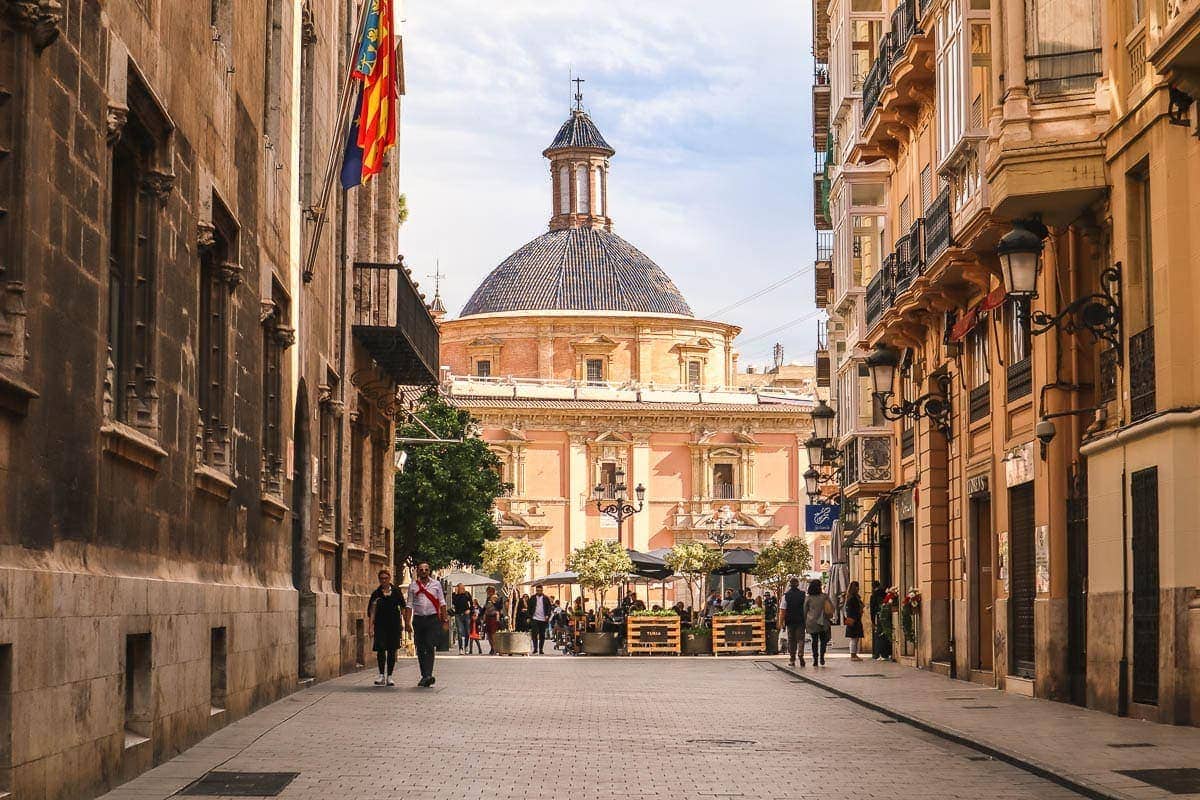
If you’ve only got one day on your southern Spain road trip, I’d recommend starting in Valencia’s old town. Here you can visit Valencia’s impressive cathedral, which is the most prominent landmark here. Its origins go back to the 13th Century, but you’ll find an interesting mix of architecture added at various times in history. Plus, if you’re looking for an amazing view of Valencia, definitely climb El Miguelete – the 167 ft baroque bell tower.
If you’ve found the old town a little hectic, take a breather with a leisurely stroll or bike ride through Turia Gardens. These amazing gardens span 9 km and feature landscaped gardens, natural parks, playgrounds, sports grounds and more.
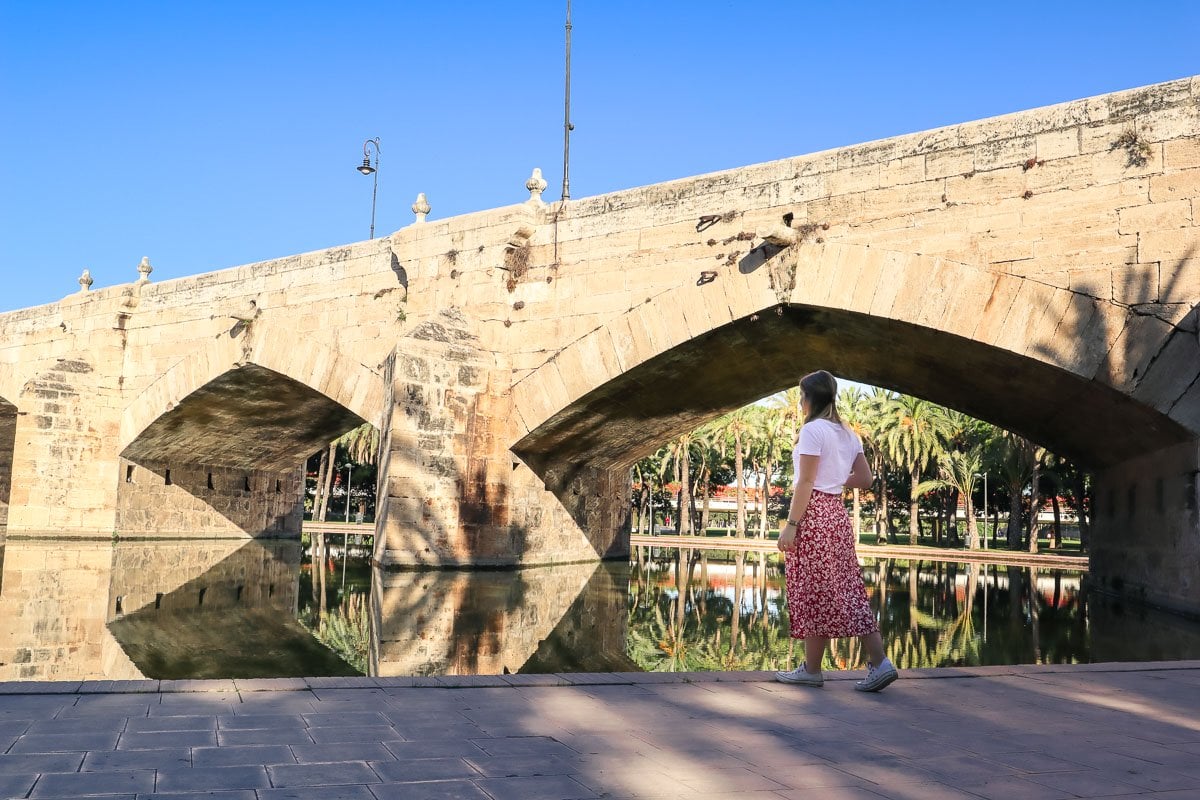
Modern art lovers will adore the Ciudad de les Artes y Les Ciences. This complex of futuristic architecture is absolutely spectacular! There’s a concert hall, science museum, gardens and aquarium all within this area.
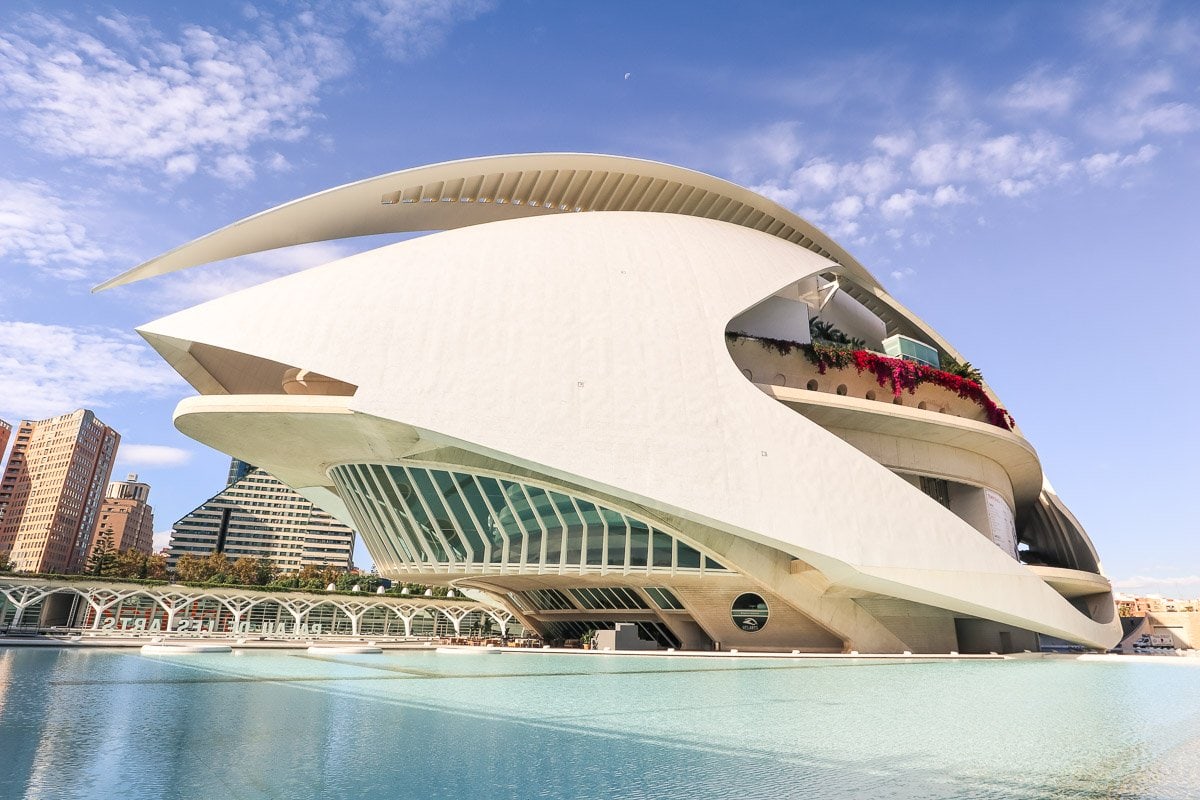
To complete your sightseeing trip around Valencia, finish your day at the beach. There are lots of bars and restaurants lining the sand here, it’s a lovely place to round off a busy day of sightseeing.
There are plenty of great delicacies to try in this city. If you haven’t tried it before, order a traditional Valencian paella down on the beach. After all, this city is considered to be the birthplace of this famous Spanish dish!
Horchata is another Valencian delicacy. This drink is often served with fartons, which are long sugar-dusted pastries, perfect for dunking! Horchatería Santa Catalina, a 200+ year old café in the heart of the old town is THE place to go for these! For a modern dining experience, I really enjoyed the food and atmosphere at La Manera, a modern restaurant serving tasty sharing plates.
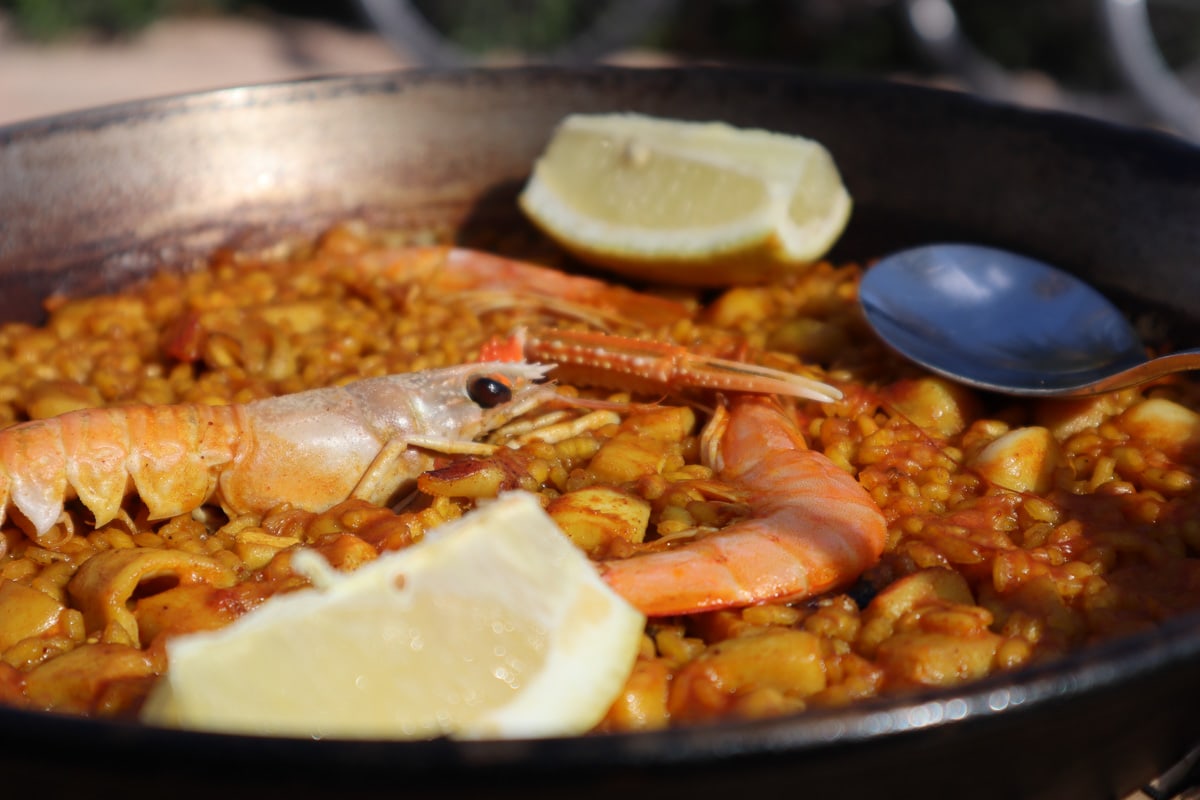
Or if you want someone else to do the hard work and order for you, you could book onto a food tour of the city. I really enjoyed this experience as it allowed me to hear all about the city from a local, while tasting some really authentic cuisine. I wrote about my tapas tour of Valencia so you can have a read and decide if it’s something you’d like to try.
Valencia to Murcia: 225 km / 2 hr 25 mins approx.
Southern Spain Road Trip: Stop 3 – Murcia
While I’d recommend you stay in the city of Murcia, this is also the name of the region and it’s worth getting out to see as much as possible.
Murcia is one of the best parts of Spain for nature lovers and outdoor adventurers. Not only is there the fabulous 250km Costa Cálida, there are also beautiful rivers, trails and caves.
If you love hiking, drive to the Segura River and explore some of the trails. Whether you fancy a gentle wander along the cliffs, or you want to spend a whole day out, there are trails for all fitness levels. If you want to challenge your adrenaline, you could go rafting on the river here too.
Another unique experience in Murcia is seeing the incredible rock formations on the beach at Bolnuevo. These natural sandstone wonders have been weathered by wind, rain and the ocean. They’re really eerie but definitely something special!
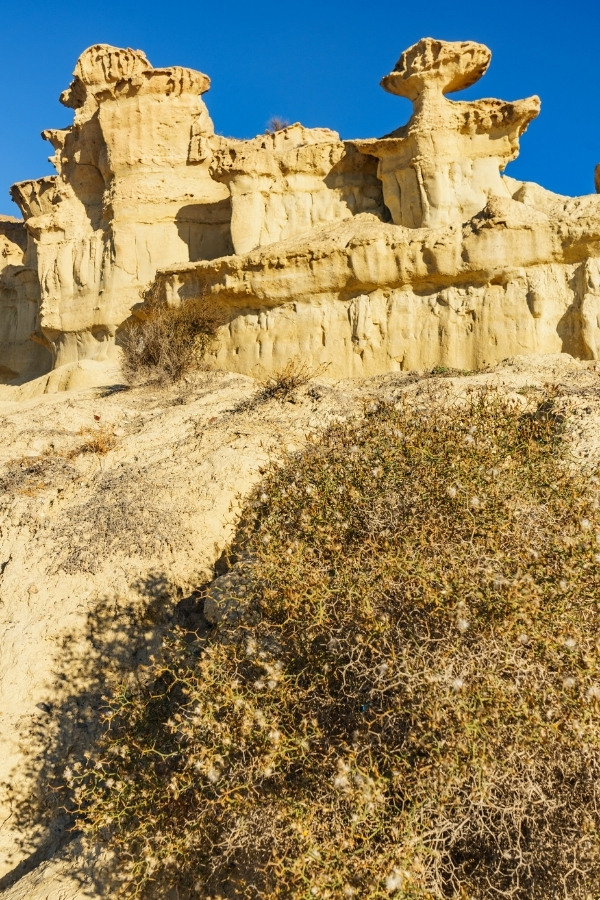
There are some impressive caves in Murcia too. Cueva de la Serreta in particular has cave paintings dating back a whopping 7,000 years!
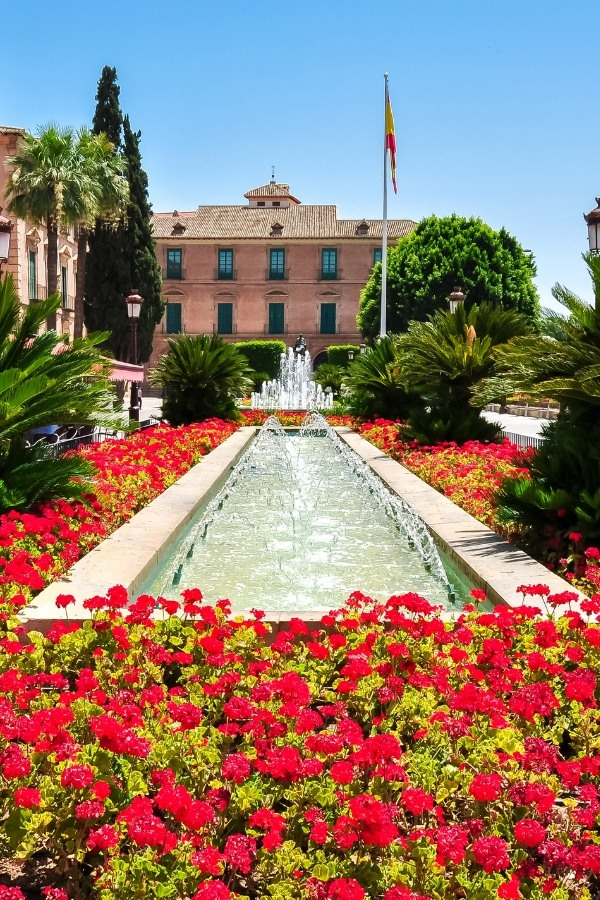
The city of Murcia is pretty underrated. It’s striking with its wide plazas, pedestrianised areas and ancient buildings. Santa María Cathedral is a must-see, dating back to 1385. There’s also a popular archaeology museum and theatre nearby.
Murcia to Sierra Nevada: 325 km / 3 hr 23 mins approx.
Southern Spain Road Trip: Stop 4 – Sierra Nevada
How about adding in a ski stop to your southern Spain road trip?!
First though, did you know you can ski in southern Spain? It might come as a surprise to many… I mean it surprised me when I found out! A country I associate with beaches and summer holidays actually has a great ski resort too.
The Sierra Nevada mountain range in Andalusia is very popular with snow bunnies from November to March. It’s a magical place to visit in the winter months right up until early spring. In fact, there can be snow on the highest peaks right up until June!
You can literally be on the ski slopes in the morning and sunbathing on the beach by the afternoon. How amazing is that?
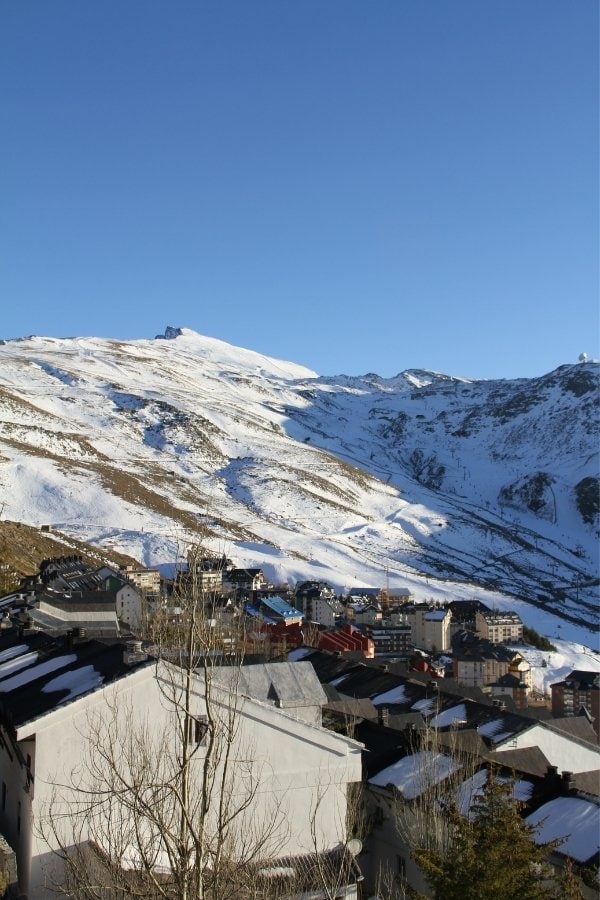
The ski resort at Pradollano is home to over 130 slopes, and has peaks over 3,000m. It’s ideal for skiing, snowboarding and other fun snow activities, and has ski runs to suit all levels. There’s plenty of accommodation in the main town too.
If you’re driving in southern Spain in the summer months, there’s plenty to see and do in Sierra Nevada. You could visit Capileira or Las Alpujarras, two charming whitewashed mountain villages with some of the best views in the region.
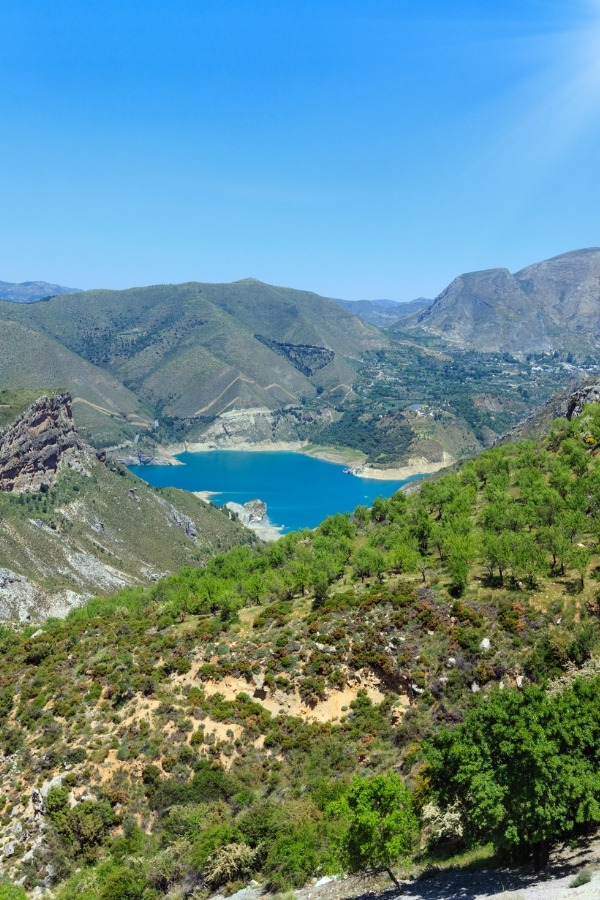
You can also catch the gondola and chair lift up to the peaks in July and August. When not covered in snow, the mountain trails are popular with e-bikers, who love to take in the view without the effort of cycling up the steep slopes!
If you’re travelling with kids, how about taking a ride on Trineo Ruso , a fun alpine coaster that’s open in the summer. This is also an incredible place for stargazing, so don’t forget to look up once the sun goes down.
Sierra Nevada to Granada: 40 km / 55 mins approx.
Southern Spain Road Trip: Stop 5 – Granada
Granada is one of the best places to visit in Spain to see Moorish architecture. This is a walkable city at the foothills of the Sierra Nevada mountain range you’ve just visited. It’s absolutely jam-packed full of history with its spectacular cathedral, monasteries and historic markets.
Visit the Albaicín neighbourhood to see some of the best examples in the world of Medieval streets. You’ll quickly see why this has earned its status as a UNESCO World Heritage Site!
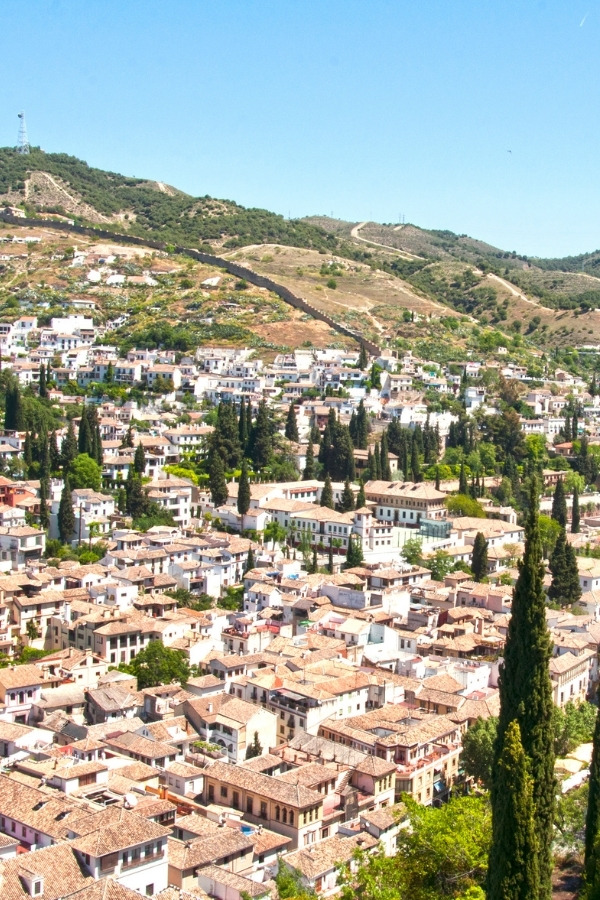
The lanes are really skinny, with pretty houses, bars and restaurants scattered throughout. I remember finding a lovely Middle-Eastern café on one of the streets and sitting outside with a cup of mint tea, feeling like I was world’s away from Spain. It reminded me of towns I’d visited in Morocco and Jordan. Carrera del Darro is one of the best streets to really soak up the atmosphere of this neighbourhood.
Meanwhile, looking down on the streets is one of the most famous landmarks in Spain: the Alhambra. Translating as ‘red palace’ this ancient palace and fortress dates back to the 8 th century. It’s one of the best-preserved Muslim medieval cities in the world.
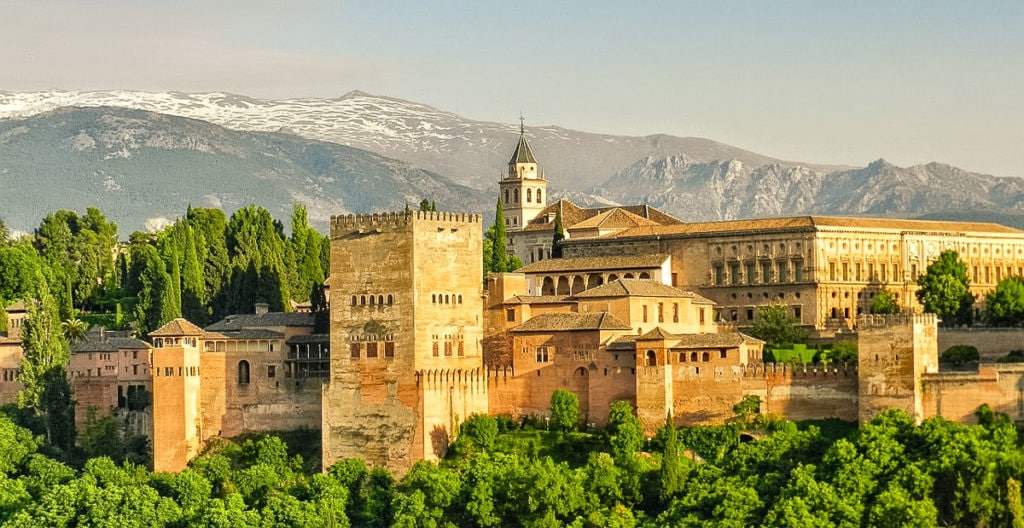
I’d recommend booking a fast-track ticket so you don’t waste time queuing. A guided tour is a great idea too as there is not only a lot to see here, but also so much history to learn. This building really has seen it all – a lot of change!
In terms of food, Granada is one of the best places for the whole ‘free tapas’ with a drink culture! Just order a glass of wine, beer or cider and you’ll be rewarded with a dish of something tasty on the house. I’d recommend bar-hopping over an evening, trying lots of delicacies as you go.
Some of my favourite spots include El Bar de Fede, Los Diamantes and La Blanca Paloma. To be honest though, most are great and it’s partly about the atmosphere too! Consider it your very own Granada food tour!
Granada to Malaga: 125 km / 1 hr 25 mins approx.
Southern Spain Road Trip: Stop 6 – Malaga
Can you believe we’re over half way through this amazing south of Spain itinerary now? With over 300 sunny days a year, hot summers and warm winters, Malaga on Spain’s Costa Del Sol is a great destination to visit all year round.
While it may not have the vast history of somewhere like Granada, the museums of Madrid or the natural beauty of Murcia, I’ve always had great times in the city and would definitely recommend stopping here on your southern Spain road trip.
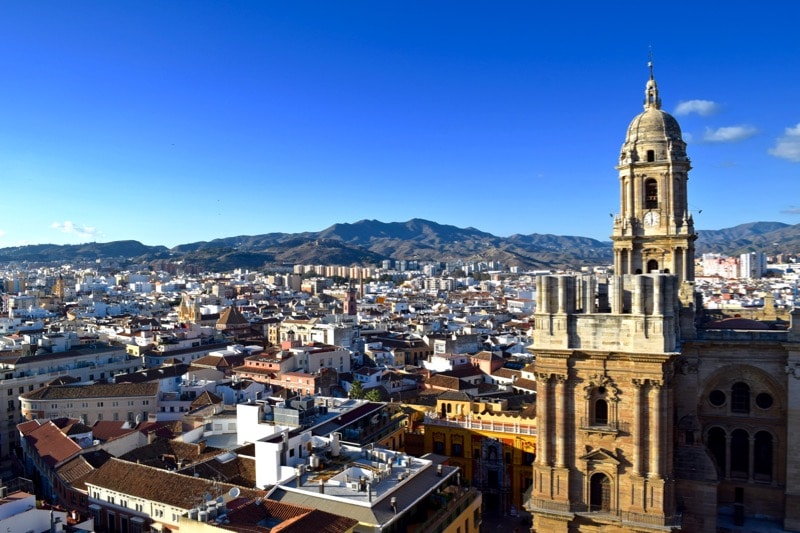
I’ve been thoroughly impressed with its cultural offerings and food scene. It’s a city that feels like it’s going through some regeneration right now too.
It’s somewhere you’ll find trendy bars and food markets right next to Gothic cathedrals and Roman ruins. I always love places with that mix of old and new, so I think that’s what drew me to Malaga.
One of the biggest attractions in Malaga is the Pompidou Centre . The entrance is via the colourful cube structure from which you descend underground to the main galleries. If you want to avoid queuing, I’d recommend booking a ‘skip the line’ ticket here.
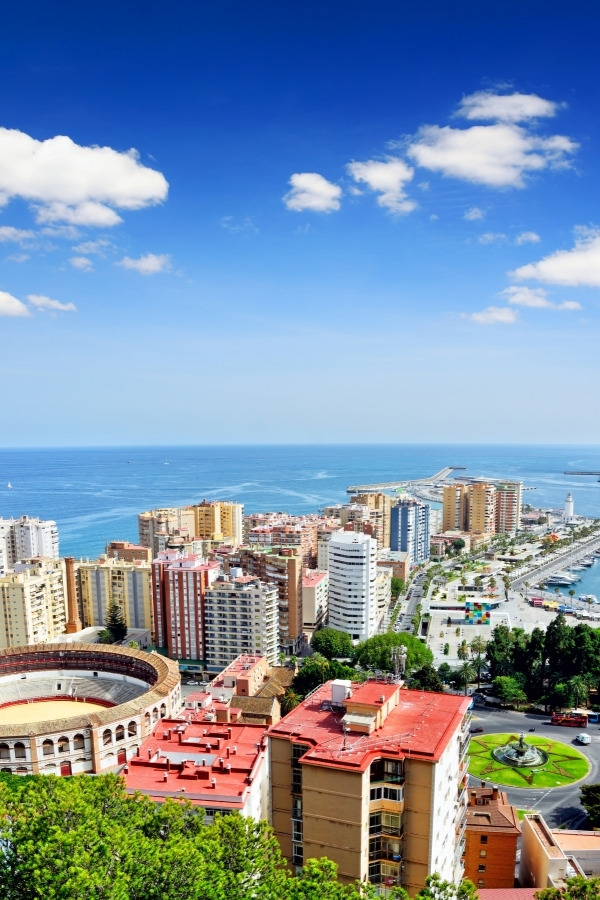
Food lovers will enjoy the city’s markets. There’s Mercado Central de Atarazanas with its amazing stained-glass window. Shop for fresh ingredients such as fruit and vegetables, fish, cheese, meats and olives. If you’re self-catering on your trip, you can stock up on supplies.
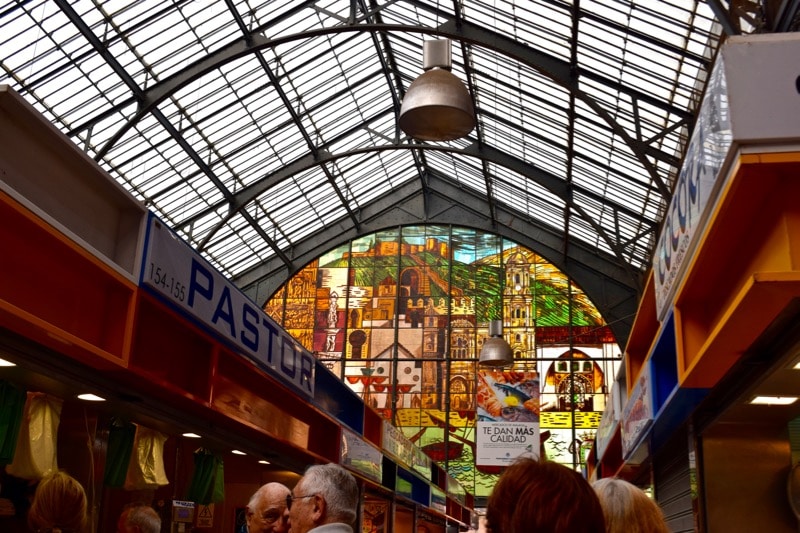
For more substantial food options visit Mercado Merced, which sells tasty tapas and alcoholic drinks. Be sure to order a dish of Malaga’s famous fried fish to croquetas while you’re there!
If you’re looking to shop in the city, wander down Larios, Malaga’s chic shopping street which is often compared to Paris’ Champs Elysee. Alternatively, take a stroll along Muelle Uno, the promenade which snakes around the port, or take a spin on Malaga’s observation wheel for some great views.
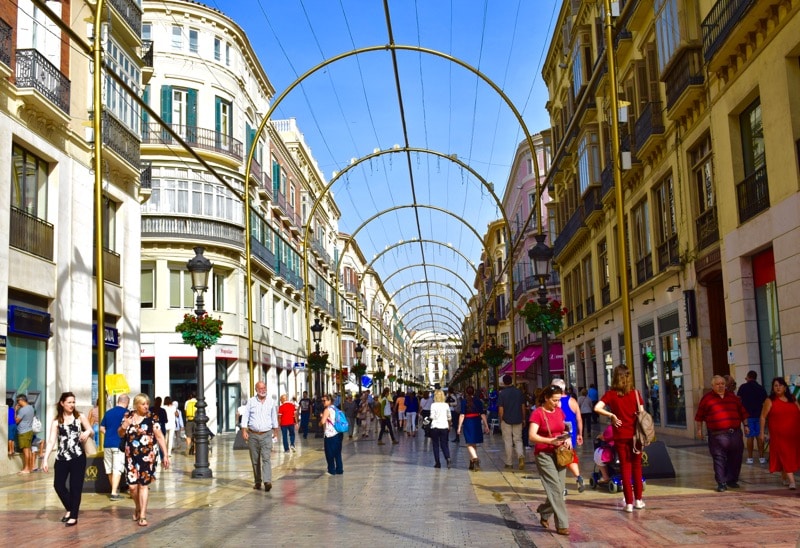
If you simply want to have a day to relax on this road trip, you could spend a day at one of the nearby beaches. There really is so much to do in this city, and I’ve got plenty more tips for visiting in my Malaga travel guide .
Malaga to Ronda: 100 km / 1 hr 20 mins approx.
Southern Spain Road Trip: Stop 7 – Ronda
The 7 th stop on this south Spain itinerary is somewhere I absolutely fell in love with! So much so, I’ve returned several times now. I think Ronda is one of the most magical towns in southern Spain, built across the deep El Tajo gorge.
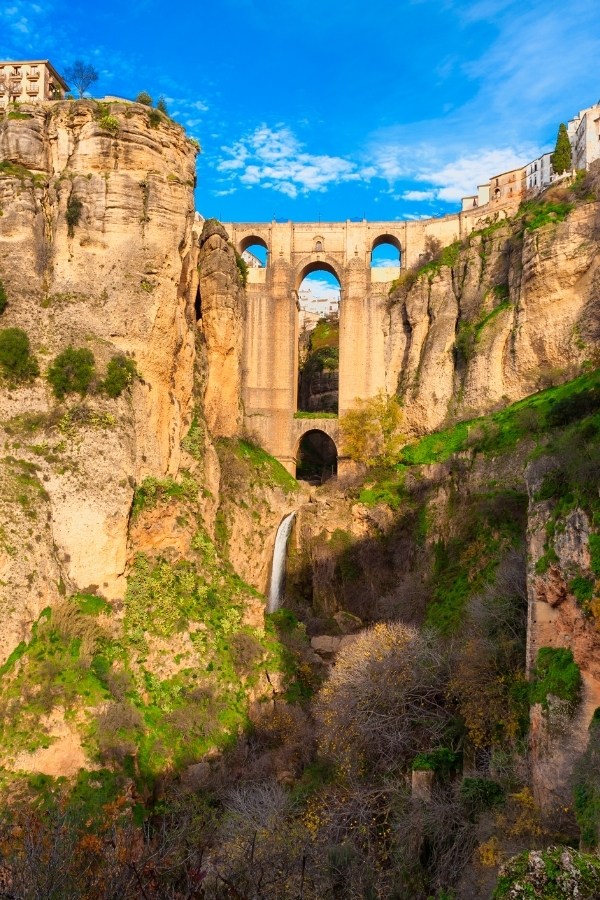
This isn’t a big town so you could spend a half day here if you’re pushed for time, or just visit as a day trip from Seville. If time is on your side though, I’d totally recommend a bit longer because it’s the kind of place you’ll enjoy seeing at a leisurely pace.
The key attraction in Ronda is Puente Nuevo. This 18th Century bridge spectacularly joins the two sections of the city across the huge gorge. The bridge is 100m tall with its base down below in the gorge and Guadalquivir River.
There are lots of angles you can view it from, but I’d recommend strolling through the Jardines De Cuenca – a series of terraced gardens.
Another big attraction in Ronda is the Plaza Del Toros a.k.a. the bullring. It’s one of the oldest in Spain and is a pretty magnificent to see inside. I don’t condone bullfighting though, so this is somewhere I’d visit for the architecture alone!

If you’re partial to a glass of vino, you could visit Bodega Joaquin Fernandez for a wine-tasting session. This winery is in a picturesque location with vineyards rolling down the hill area.
From Ronda you could also drive over to Sierra de Grazalema Natural Park where you can explore the spectacular mountain ranges, caves, gorges and fir tree forests.
Ronda to Cadiz: 145 km / 1 hr 40 mins approx.
Southern Spain Road Trip: Stop 8 – Cadiz
If you’ve followed me for a while, you’ll know what a fan I am of this pretty city in southern Spain. I’d go as far as to say Cadiz is my favourite place in Spain. Yet I’ve mentioned the city to friends and they’ve never heard of it… so, what’s so special about Cadiz?
Well, where to start! If you’re into history, you’ll be in your element here! Founded by the Phoenicians 3,000 years ago, Cadiz is one of the oldest cities in Western Europe. The Romans also settled there, building an impressive city (some of which is still in existence today).
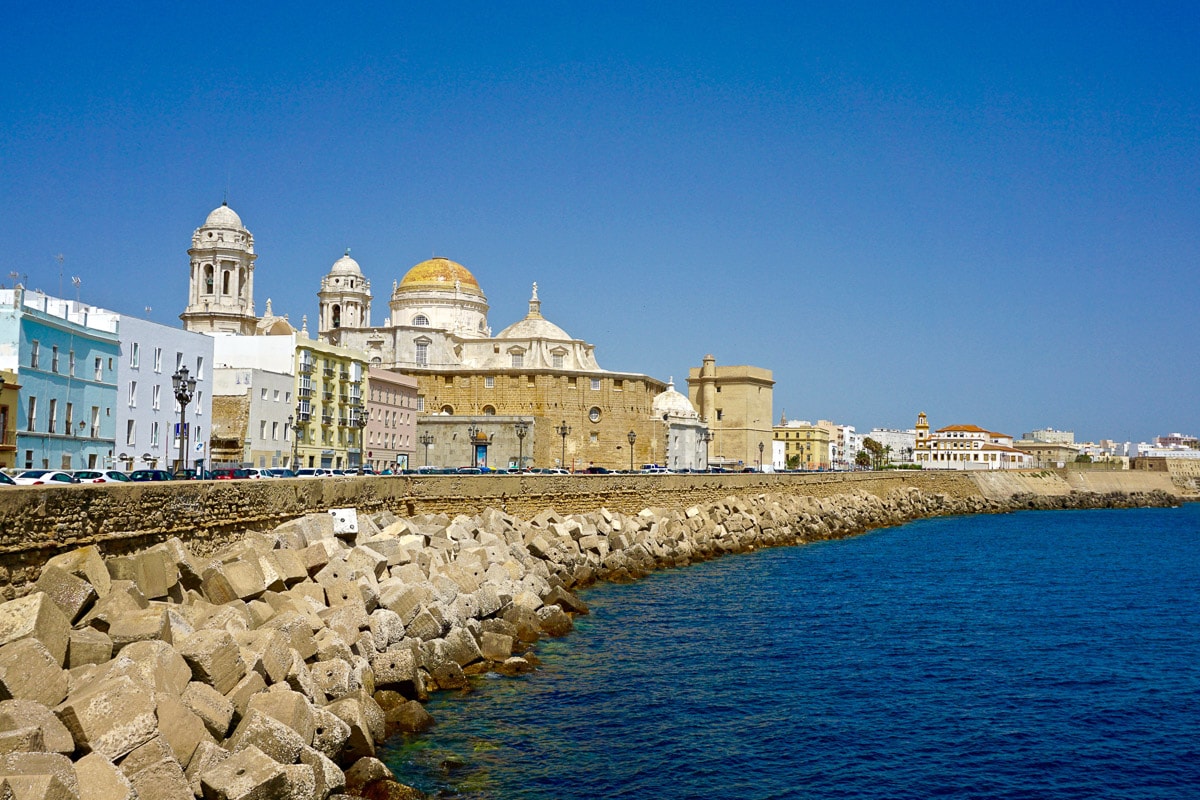
But you don’t need to be history nerd to appreciate Cadiz. It’s home to several beautiful beaches, including La Caleta right in the city centre. Set back from the water is the medieval city filled with narrow streets, beautiful tree-lined plazas, fountains and great restaurants.
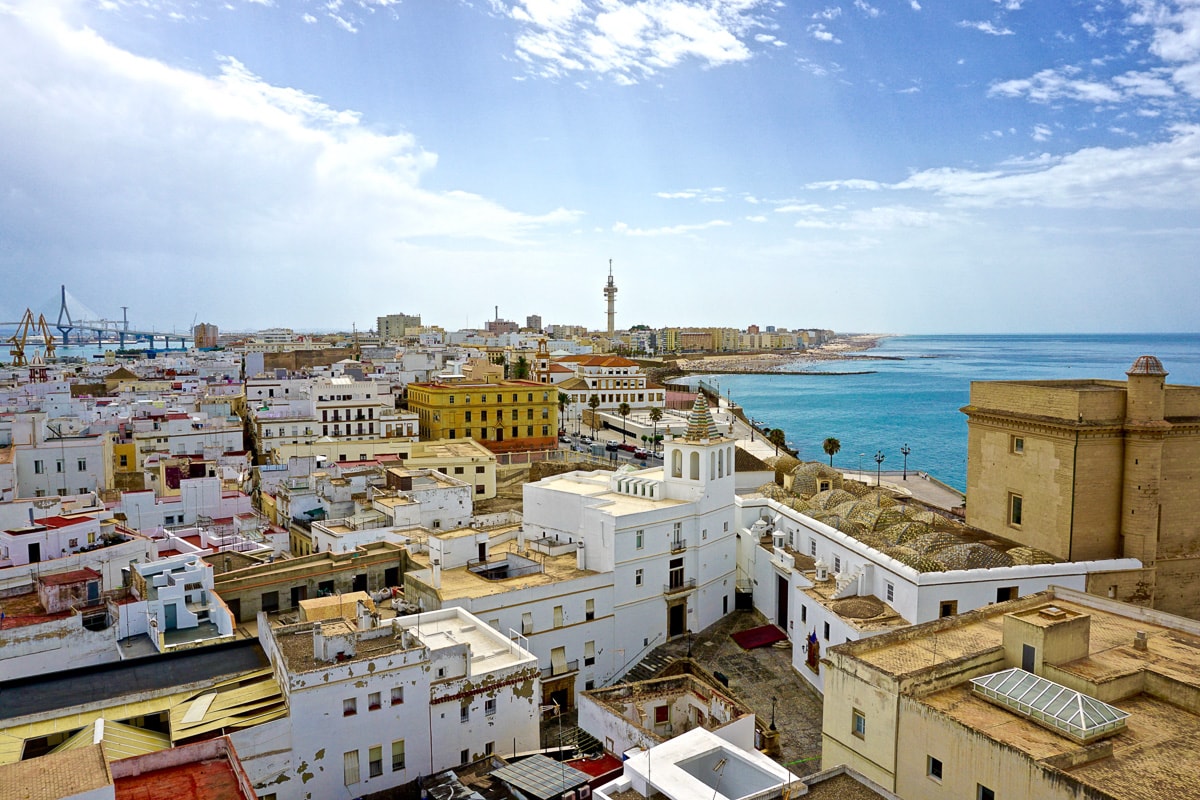
There’s also a port scattered with fishing boats and lots of pretty buildings all painted in white.
One of my favourite activities was the food tour I did. It was a fantastic way to learn how the locals eat, what produce is local and discover a few tapas bars to revisit during my trip.
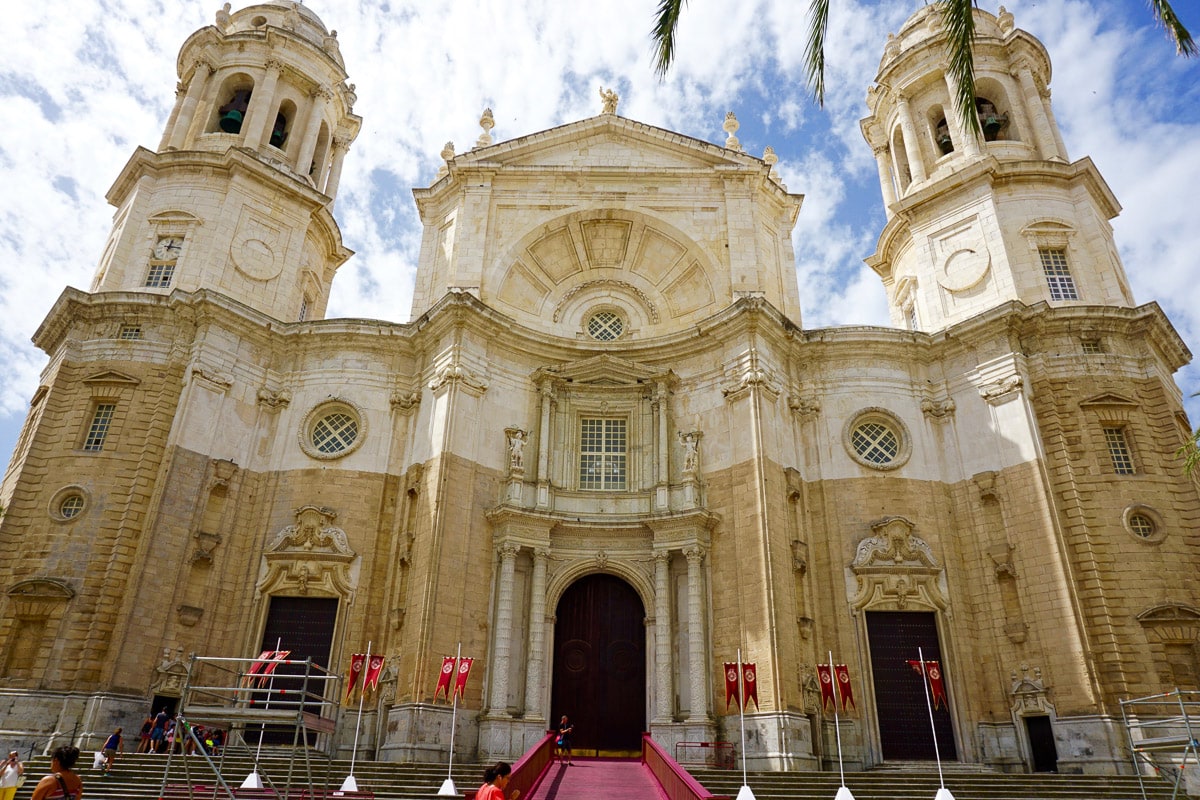
I’d also recommend climbing either the Tavira Tower or the Cathedral Tower for the best views of the city. Personally, I preferred the views from the Cathedral Tower as I liked being nearer the water as well as seeing the bells up close!
Other things to do in Cadiz include visiting the castles Castillo De San Sebastian and Santa Catalina, as well as touring the underground caves and catacombs.
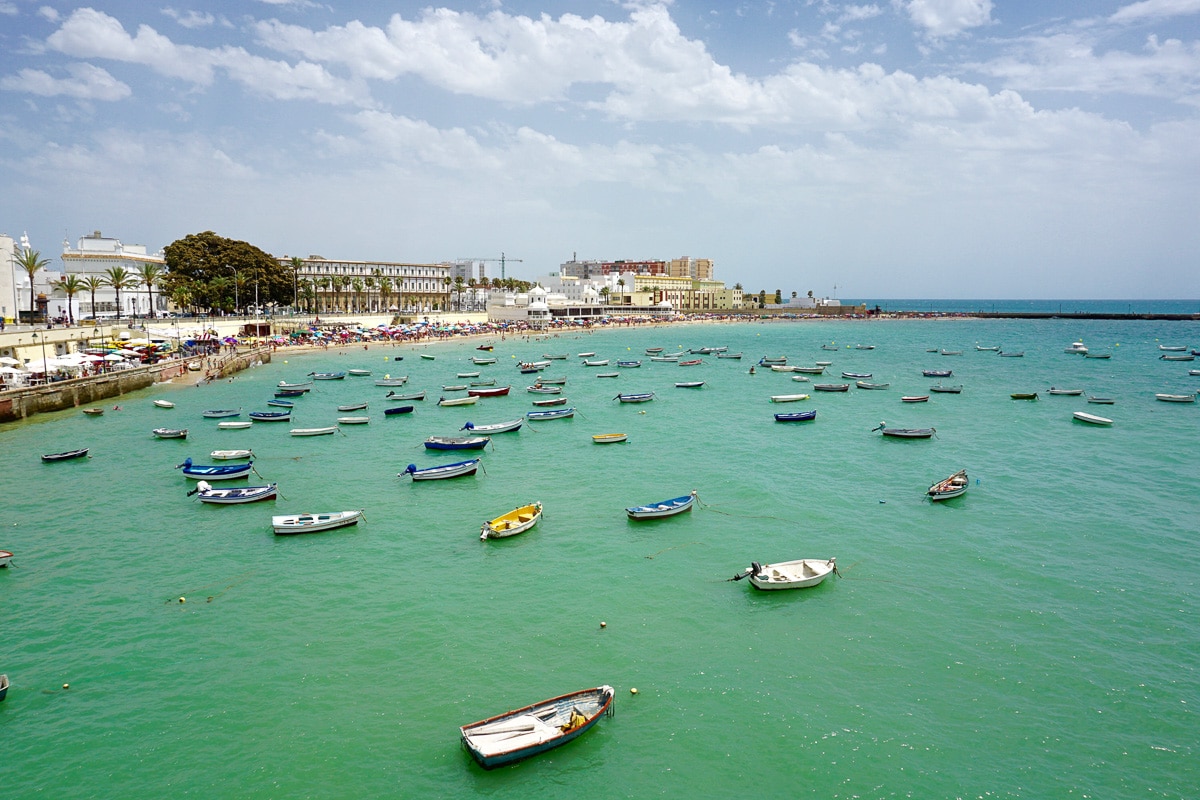
To be honest though, I loved mooching around Cadiz. Just set off and get a bit lost, stop for tapas at one of the many little bars dotted around the city, and see what you find along the way. It’s a place that is guaranteed to take your breath away .
Cadiz to Seville: 120 km / 1 hr 20 mins approx.
Southern Spain Road Trip: Stop 9 – Seville
If I was asked to describe Seville, I’d probably say it’s the most quintessentially Spanish city in Spain. It’s one of my favourite city breaks in the world as it offers so much.
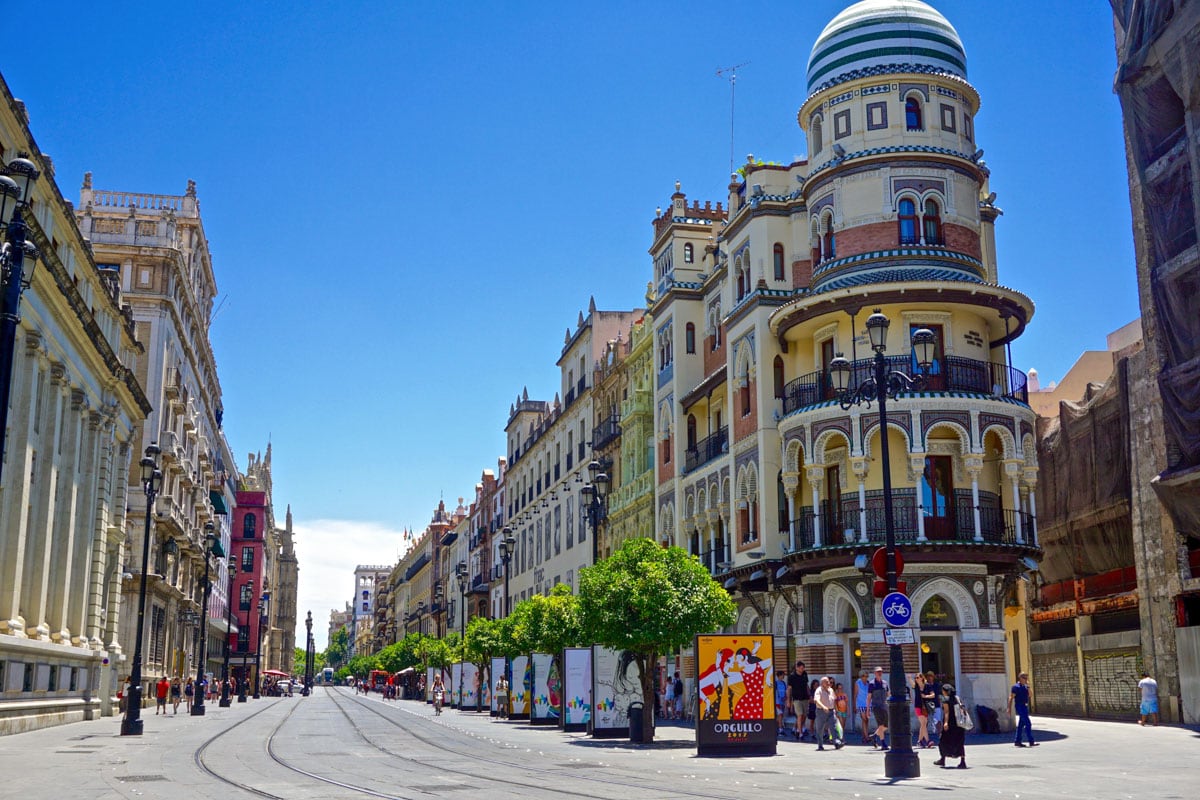
It has that feisty Spanish lust for life, with flamenco shows, live music and buzzy tapas bars. You’ll see sunshine and blue skies almost all year round. It’s also packed full of historic sites.
You simply have to visit Seville Cathedral and climb the Giralda Tower. From there you’ll have the best view of the city. I’d recommend doing this at the start of your day before it gets too hot. It’s a great way to get your bearings too.
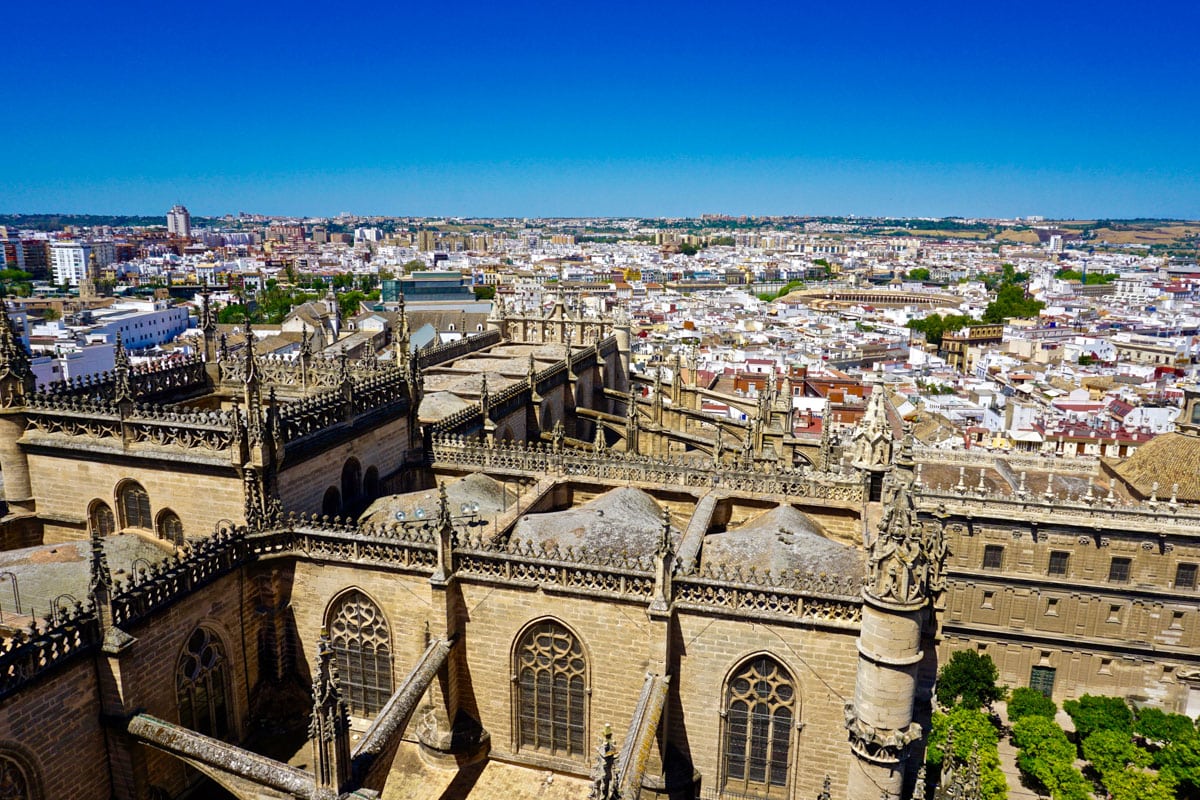
Also, squeeze in a trip to the Real Alcazar de Sevilla . This royal palace is absolutely stunning inside, with decorative courtyards, pristine landscape gardens and plenty of artefacts to admire. It can get really busy, especially in the holidays, so you might want to book a ‘skip the line’ ticket to save queueing.
My favourite building in Seville is Plaza de Espana. Built for the Ibero-American exposition of 1929, it’s an architectural masterpiece with its curved shape and beautiful water features. For a bit of fun, you could hire a rowing boat and view the building from a unique angle!
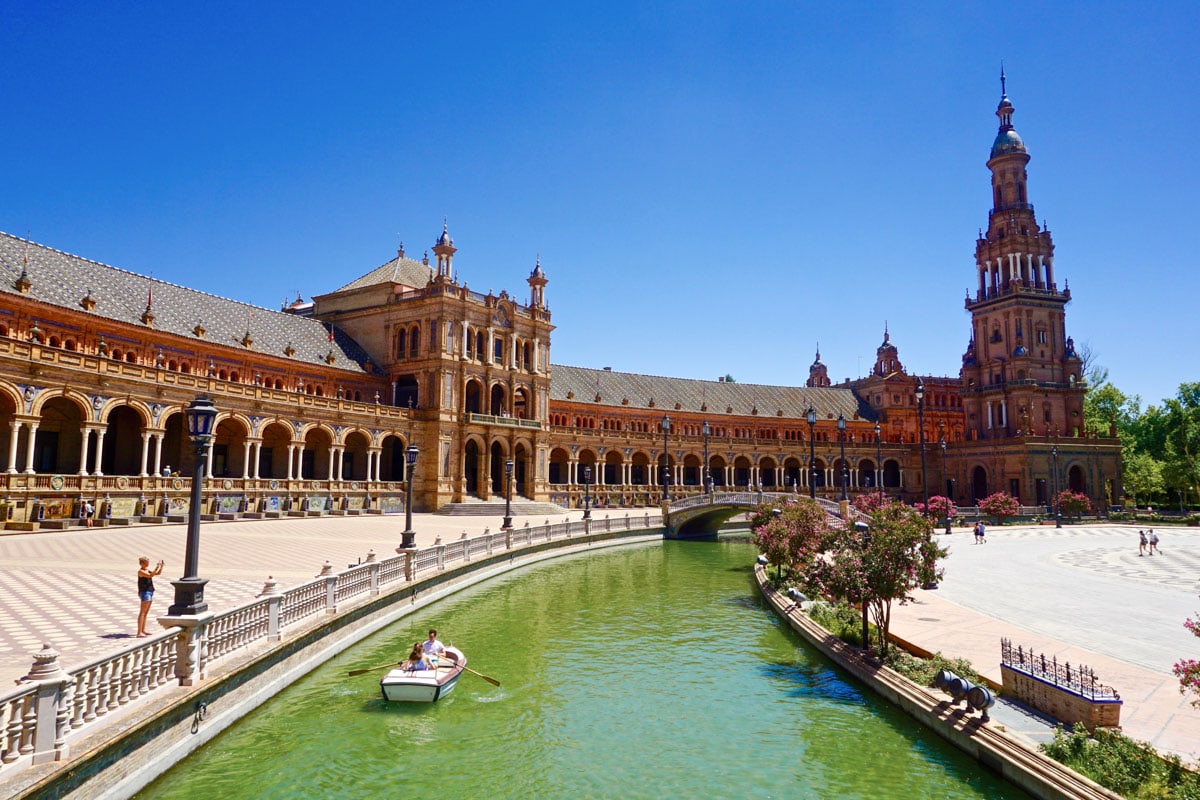
Seville isn’t stuck in the past though. If you love modern architecture, stroll under the Metropol Parasol. Consisting of six wooden parasols, this unusual structure is often referred to as the mushroom!
Plus, Seville is one Spain’s finest cities for food, particularly if you like the flavours of Andalucia. I’d recommend eating your way around gourmet food market Mercado Lonja Del Barranco or trying some local, authentic tapas at El Rinconcillo – the city’s oldest bar.
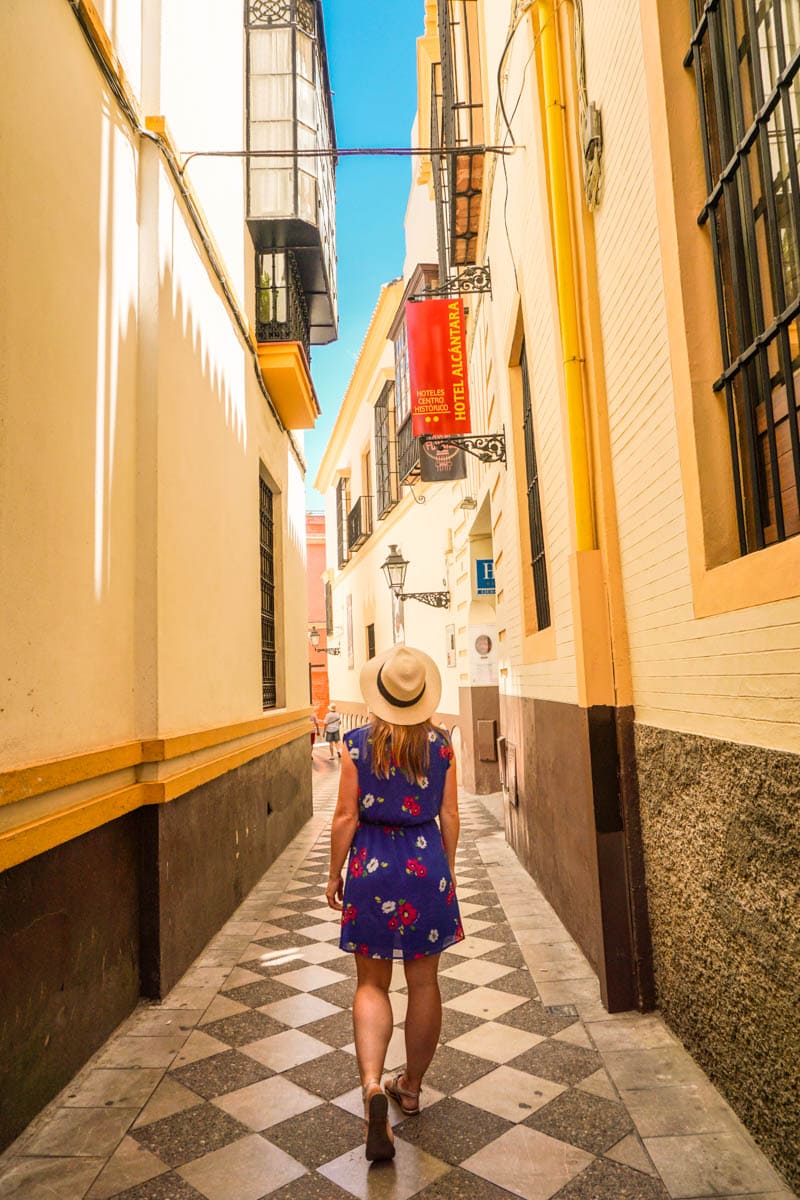
One little tip, park outside of the city centre. The streets are narrow and you don’t want to scratch your rental car!
Seville to Cordoba: 140 km / 1 hr 30 mins approx.
Southern Spain Road Trip: Stop 10 – Córdoba
Time for the final stop on this amazing road trip through the south of Spain!
It’s hard to believe that Córdoba was once the largest city in the world with around 1 million people living there… but that was 1,000 years ago! This is another city famed for its history, with four amazing UNESCO World Heritage Sites.
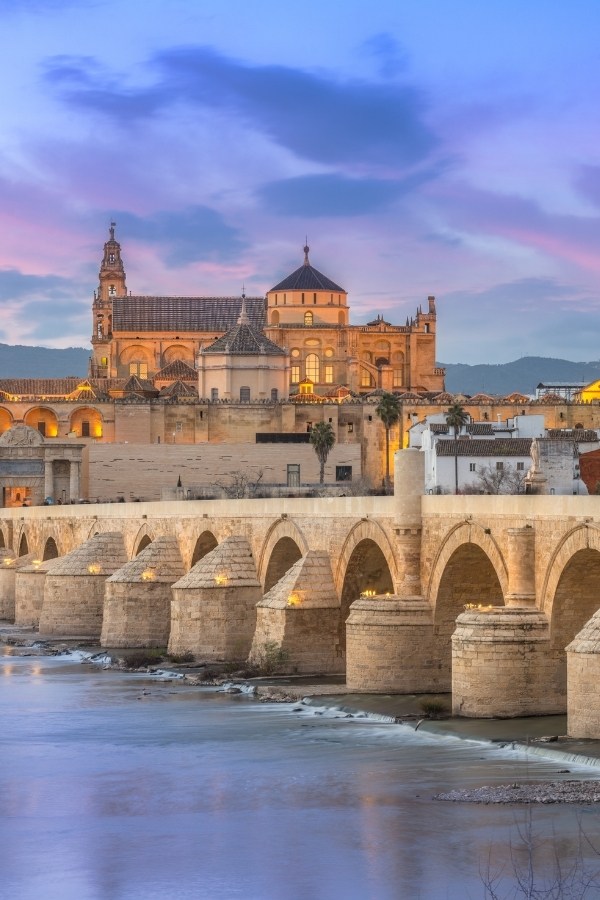
The most famous place to visit is the Mezquita-Catedral de Córdoba (I’d recommend booking a skip the line ticket to save queuing). Starting its life as a mosque, it was later converted into a cathedral. It’s the most amazing blend of Christian and Muslim architecture. This story alone is fascinating and a good indication into the melting point that this city is.
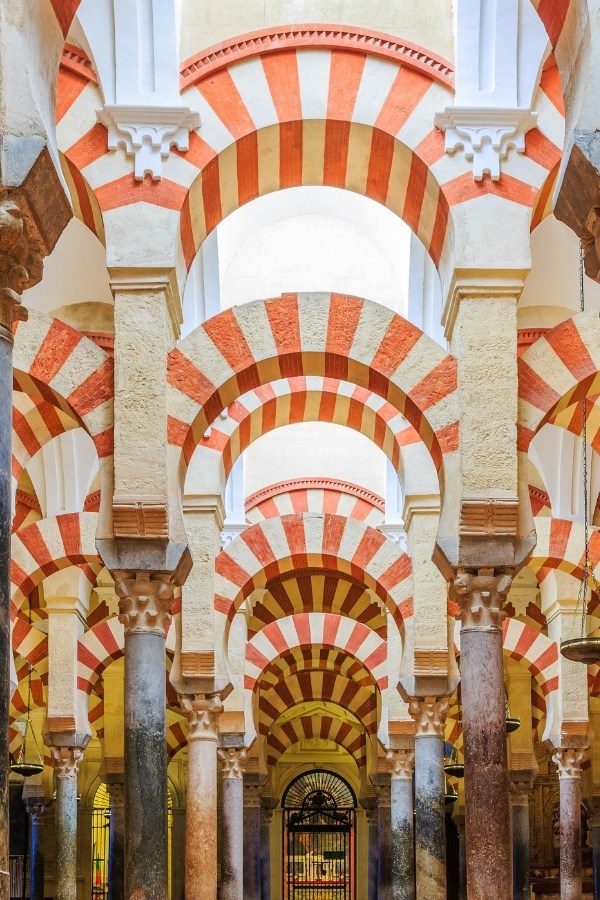
Just wandering Cordoba on foot is a delight. You’ll notice some differences in architecture here compared to some of other places you’ve visited so far on this itinerary. In particular, keep an eye out for the beautiful patios and courtyards in the centre of many of the buildings.
If you visit in May, you might get the chance to see some of these hidden gems up close! At this time of year there’s a special festival known as the Fiesta de los Patios where locals open their doors to show off their courtyards. It can get quite competitive, with pretty displays of flowers and art too!
You’ve seen the traditional blue pots filled with flowers, mounted on whitewashed walls before, right? Well, that’s a signature style of Cordoba (and Andalucía as a whole), so keep your eyes peeled as you wander the city.
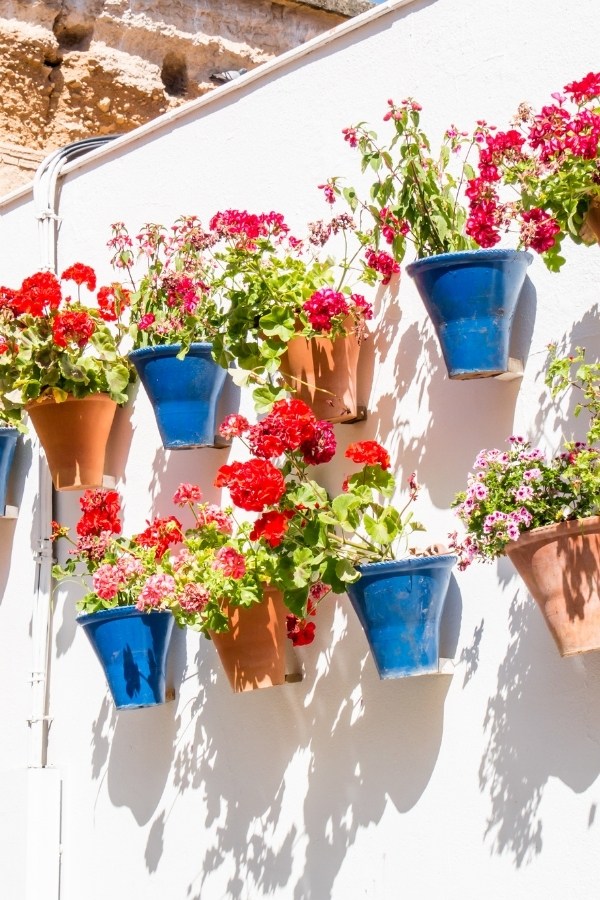
There’s plenty more to keep you busy in Cordoba, including walking the Roman Bridge over the Guadalquivir River, feasting on plates of tapas in local bars and enjoying some nightlife too. What better place to end an amazing adventure through southern Spain!
Cordoba to Madrid: 395 km / 4 hours approx.
Where To Stay On A Southern Spain Road Trip
If you’re wondering where to stay in southern Spain, here are a few of my top choices along this route.
Dear Hotel Madrid
Dear Hotel boasts one of the best hotel views in the whole of Madrid. What better way to relax after a hard day’s sightseeing than by sipping a cocktail from the stunning (but compact!) rooftop pool? It’s enough to make you feel as though you were swimming right over the city itself, and it’s a lovely place to take in the glittering city lights at night.
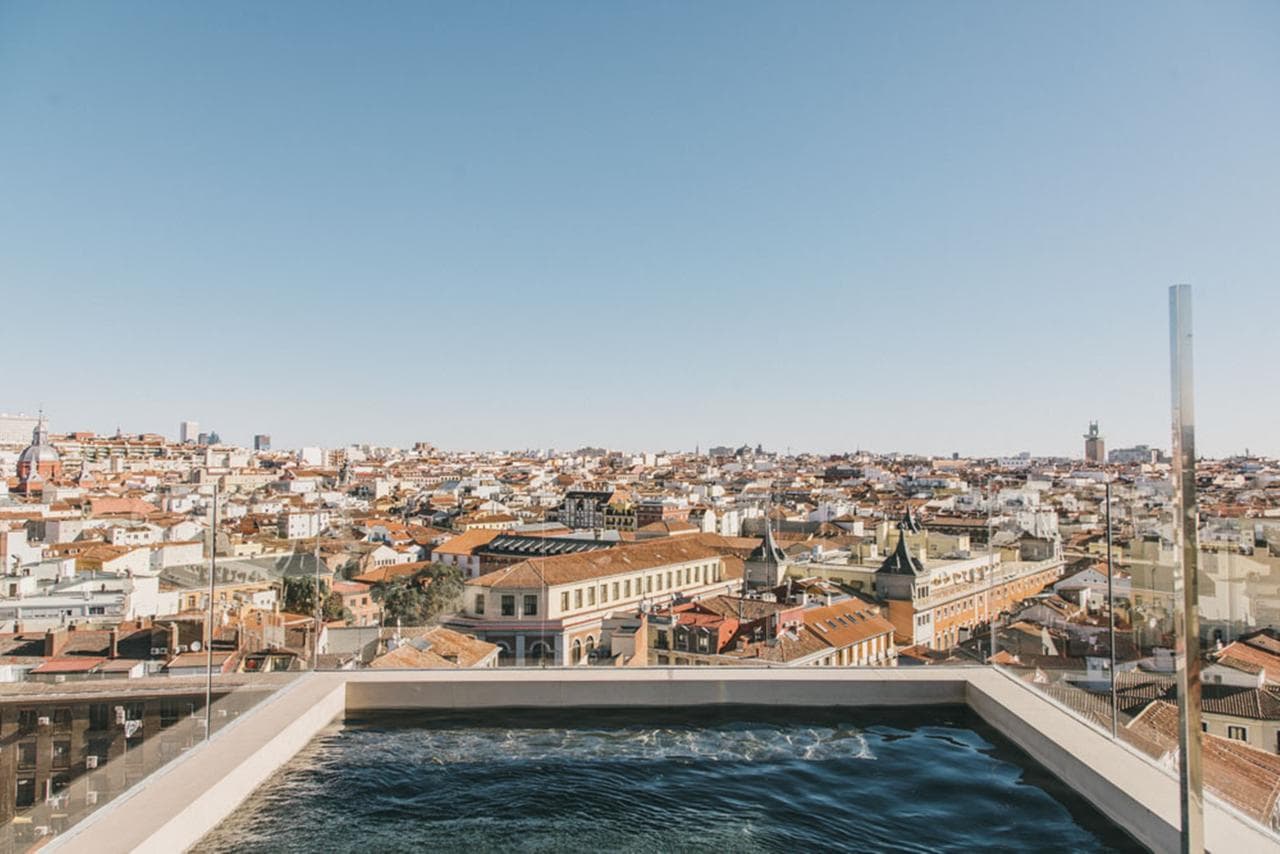
Located directly on the Calle Gran Via, Dear Hotel offers everything you need for a luxury stay in Madrid – so why not travel in style and treat yourself to a slice of opulence during your trip?
The Westin Valencia
Of all the 5-star hotels in Valencia, the Westin Valencia is arguably the most impressive. It’s an Art Deco dream, filled with glittering chandeliers, exquisite marble, and elegant artistic touches. It occupies a great location next to the Turia Gardens, just a short walk from the city centre and all of the charms of the historic old town.
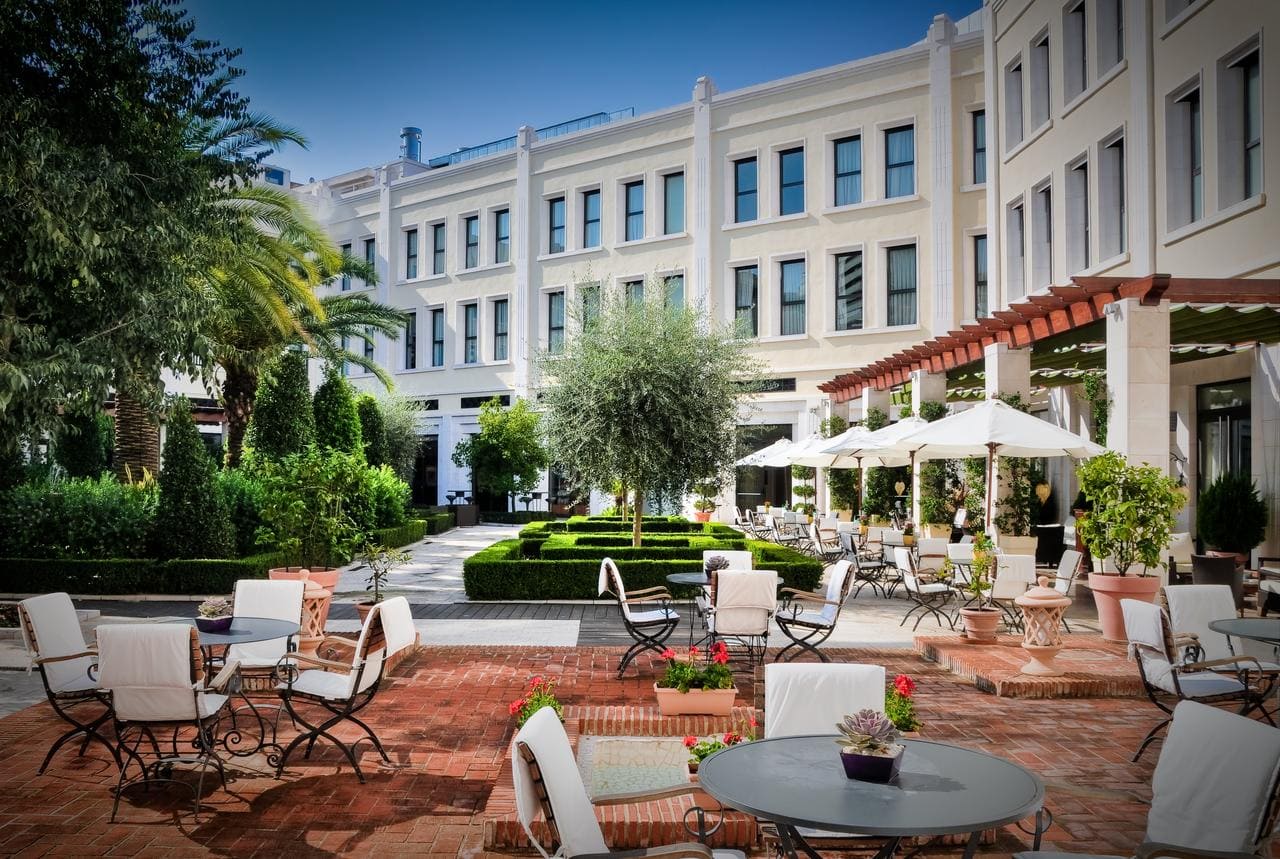
The Westin offers the best in comfort and luxury with exceptional service, a world-class spa, and the fabulous Komori Restaurant, which serves up Japanese-European fusion cuisine. This chic hotel is one of the best places to stay in Valencia for couples, offering romantic surroundings to unwind in, after a busy day of sightseeing.
Parador de Cadiz
If you’re looking for a modern and stylish place to stay in Cadiz, where you can catch a glimpse of the sea from every room and balcony, check out Parador de Cadiz. With incredible views of the bay as well as a relaxing spa and wellness centre, this is one of the best equipped hotels in the city.
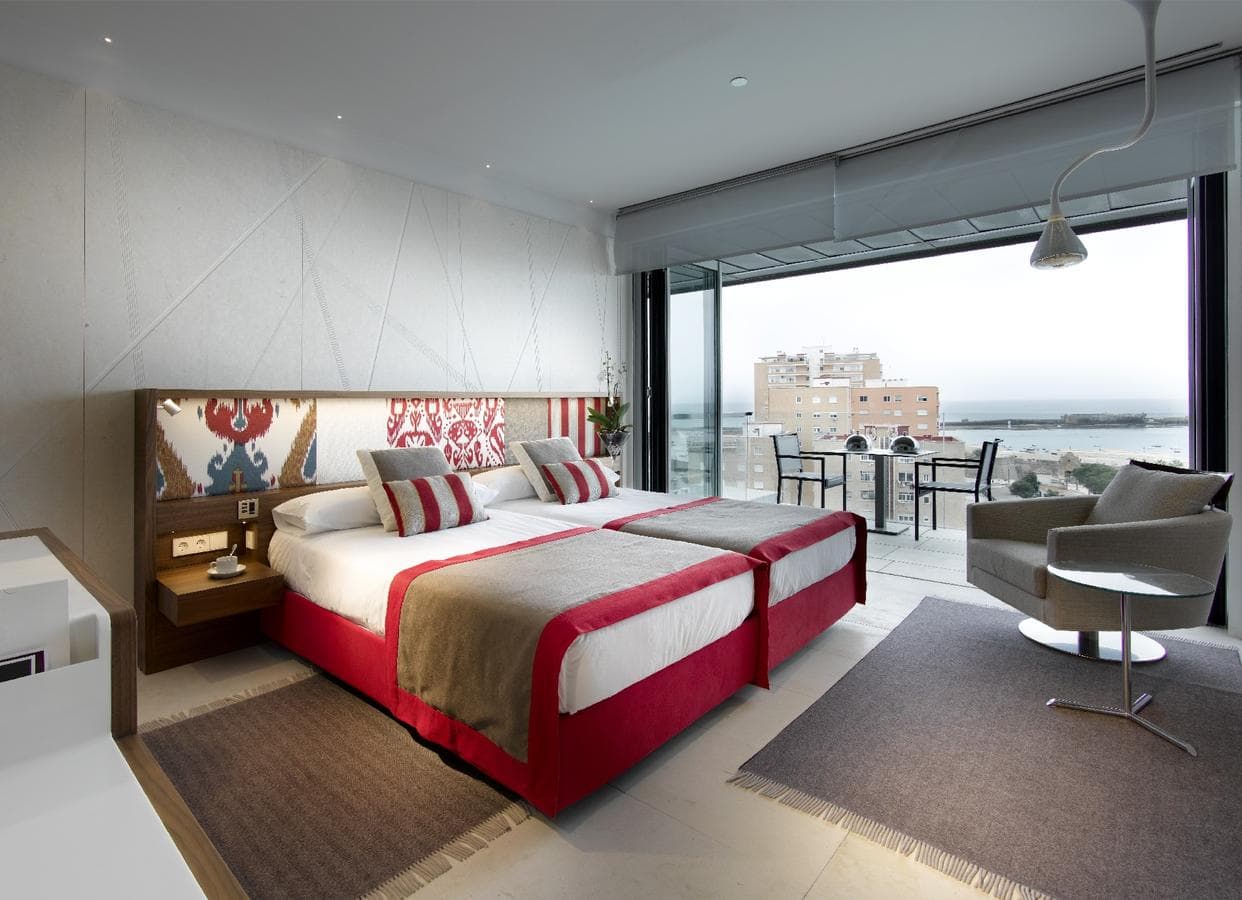
After a busy day of exploring you can head back to your hotel and unwind in the spa or swimming pool. If you fancy a culinary treat, the hotel’s tapas bar and restaurant serve a variety of traditional Spanish delicacies.
EME Catedrale Hotel , Seville
With Moorish-inspired interiors and luxurious contemporary rooms, EME Catedrale Hotel is one of the most popular 5-star hotels in Seville’s old town. As the name suggests, it’s just a stone’s throw from the cathedral, and offers one of the best views of any hotel in the city from its rooftop pool terrace.
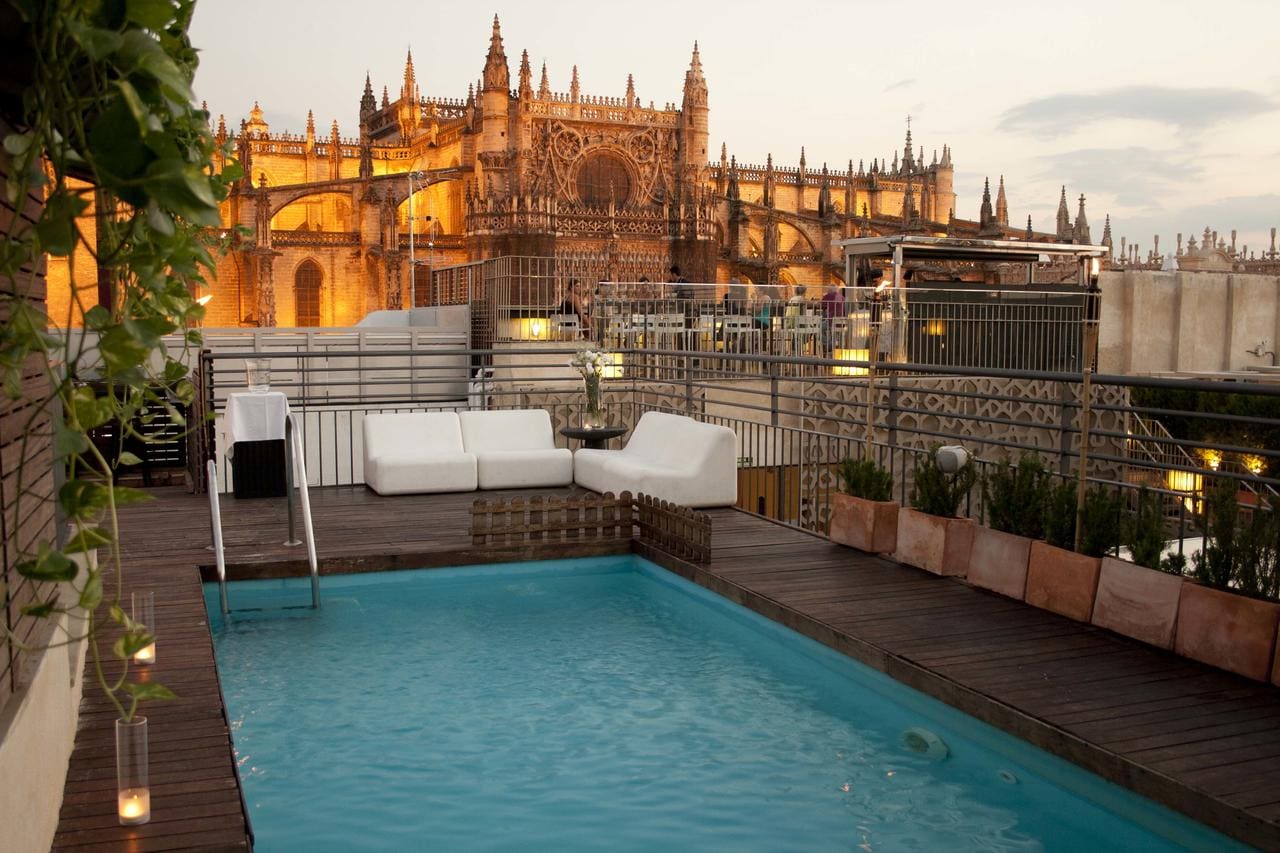
It’s also an ideal base from which to explore the Jewish quarter and all the main sights and sounds of the city. Along with the pool, another great feature is the hotel’s cocktail bar, which has a glass floor showing the subterranean Roman ruins below. Definitely a great spot for an atmospheric pre-dinner drink!
I hope you enjoy your south Spain road trip – let me know if there’s anywhere you’d add to the itinerary! I think you’ll agree, this is one of the best road trips in Spain. It just offers so much variety.
My best advice is to use this guide as a starting point, but don’t be afraid to add some extra spots along the way too. If you’re wondering where else to visit in Spain, have a read of my northern Spain road trip itinerary ! I hope you have the trip of a lifetime. Happy driving!
Chloe Gunning
With a passion for food, fun and adventure, Chloe is the content creator behind one of the UK's top travel blogs Wanderlust Chloe. From volcano boarding in Nicaragua, to sailing around Sicily and eating her way around Japan, her travels have taken her to some of the coolest spots on the planet. Named Travel Influencer of the Year in 2022, Chloe regularly works with a number of tourism boards, producing inspirational travel content across multiple platforms. Find out more about Chloe here.
Leave a comment Cancel reply
Plan the Perfect Trip to Spain
For some, a visit to Spain is simple, a weekend on a beach on the Costa del Sol or a few days in Barcelona and that's all they are looking for.
But for the rest of us, there is so much to fit into a limited time that some hard choices will be necessary .
Spain is not a very big country if you compare it to, say, the United States, but it is quite culturally fragmented. Some things, such as free tapas with your drink, are only available in a limited area of the country.
Suggested Itineraries
If you know what you are looking for most out of your trip, check out these tips below on which city to start your trip in.
For Cheap Tapas
Choose Granada (fly to Malaga) Why? Spain is one of the few places you can get something for free, as there are many bars where you get a bit of food with every drink you buy. There are such bars all over the country, but the highest proportion of such bars can be found in Granada and other cities in the area (such as Jaen). Leon is a great city for this too.
For the Best Tapas
Choose San Sebastian (and nearby Logroño) or Seville Why? The gourmet tapas scene in San Sebastian and Seville vie for top honors in internationally acclaimed tapas. Logroño, close to San Sebastian, is a lesser-known but equally good challenger.
For Good Weather
Choose Andalusia , but it depends on so much. Why? Well, what's good weather? If you want to spend your time on the beach, you'll probably want to head to Andalusia, unless you're visiting at the height of summer, when it can be too warm here. Otherwise, if you want to go hiking in cool conditions, Galicia is your best bet, though it will probably rain.
For the Best Wine
Choose The Basque Country or Madrid Why? San Sebastian and Bilbao, in the Basque Country, are close to the Rioja wine region, but they also have their own wine: Txakoli. Madrid, as the capital, gets the best of the wine in the country.
For Architecture
Choose Barcelona
Why? One word: Gaudi.
Choose Madrid or Bilbao Why? The Reina Sofia, the Thyssen-Bornemisza and the Prado museums of Madrid and the Guggenheim in Bilbao.
Choose Barcelona Why? For its good access to the Pyrenees .
For Bullfighting
Choose Seville or Madrid Why? Bullrings can be found throughout Spain. But a bullring doth not a bullfighting town make. Bullrings sprung up throughout Spain under dictator Franco as a part of his attempts to bring tourism into Spain. The main places to see bullfighting are in Andalusia (particularly Seville) and Madrid. There is also a number of bullfighting festivals in Spain which are great places to catch a fight. TripSavvy trusts its readers to make their own decisions on the ethics of bullfighting as an attraction.
Unique Things
- Africa is just an hour away. There are plenty of options to take ferries from Spain to Morocco
- In theory, nudity is legal anywhere in Spain.
- Spain has a strong Muslim, Christian, and Jewish heritage.
- No one will tell you that you're lazy for having a sleep in the afternoon! The Spanish tradition of siesta ensures that.
- You can throw tomatoes at people and not get arrested. (As long as you do it at the right time .)
- You can celebrate the most reverent Easter celebrations in the world.
Where to Go and When
Spain can best be divided into four areas: north, south, east and central (western Iberia is Portugal, which is also worth visiting).
Central Spain , which is dominated by Madrid, is home to historic walled cities such as Toledo and Avila , the windmills of Consuegra and grand old cities like Salamanca , Segovia , and Leon .
The east coast is also famous for its sun, sea, and sand, but it also has Barcelona, with its fabulous modernist architecture, and Valencia , the birthplace of paella .
The south of Spain is all about Andalusia , with classic cities such as Seville, Granada, Cordoba, Jerez and Cordoba to visit. Eat classic tapas, drink sherry and explore Spain's centuries-long relationship with Islam at the Mezquita in Cordoba or the Alhambra in Granada. Plus there's also the beaches of the Costa del Sol .
The north is an undiscovered country for many visitors to Spain. But with the modern cuisine of the Basque Country (especially in San Sebastian), the Guggenheim Museum in Bilbao, the wines of La Rioja, cider in Asturias and the UNESCO-protected old town of Santiago de Compostela , there is so much to see in northern Spain. And don't forget all that seafood!
But when should you visit? For guaranteed good weather, the summer is best, though what you would consider 'summer' gets longer the further south you go. The big events of the year for visitors are Easter (Semana Santa), Las Fallas in March, the Tomatina Tomato Fight in August and the Pamplona Bull Run in July. But there is so much happening all year round .
Trip from Madrid
The capital of Spain, Madrid , is the center point of the country, quite literally, around which all else revolves. Most of the other major cities are on the coast, typically at least six hours away from the capital by car. Between these are a lot of agricultural villages and barren land, with Seville, Granada, Leon, and Salamanca the main inland cities of note.
Madrid is a good place to arrive, as the capital is well connected by train, bus and internal flights . But that isn’t to say you should hurry out of the country’s premier city. While Madrid isn’t in the league of other European capitals like Paris and London, it is a living, breathing city with every kind of bar , restaurant and leisure activity you could desire.
Madrid and Barcelona are obviously Spain's two most famous cities and if you can't decide between the two, then this is an ideal way to cover them both.
Nearby Cities
Madrid is a great base for day trips to the wonderful aqueducts of Segovia and the historical delights of Toledo , with El Escorial also a short train ride away.
Madrid's location in the center of Spain, as well as its good train connections, means you'll want to travel by rail from the capital. This isn't always true for other cities in Spain.
- San Sebastian
- Lisbon, Portugal
Trip From Barcelona and Valencia
For a more cosmopolitan experience, there is Barcelona in the northeast, in the community of Catalonia. The locals say it isn’t really Spain at all and, while this is not the time to get into a political discussion, Barcelona certainly does have a different feel to it from the rest of Spain. It's spectacular Gaudí architecture , solemn Barri Gòtic and lively Ramblas street are as iconic as you can get in Spain.
Barcelona or Valencia
There are more flights to Barcelona than Valencia, so it is more likely you'll arrive in Barcelona. Valencia is Spain's third city (by population) and, like Barcelona, is connected to Madrid by the high-speed train (it takes about two-and-a-half hours from both cities to reach the capital).
However, Valencia is not Spain's third city when it comes to tourist sights. This may be an attraction in itself as the small city center allows you to ignore the vast suburban sprawl outside it. But for a full and active trip, you'll get a lot more out of Barcelona than Valencia.
Barcelona is also much better connected to other cities in Spain than Valencia is.
Places to Visit
The top sights outside Barcelona are not cities, but rather the Montserrat mountain and the Salvador Dali museum in Figueres.
After that, you have Tarragona, famous for its Roman ruins, and Girona, which is known for its Jewish quarter .
How to Get to Other Cities From Here
Barcelona's location in the north-east of Spain means it's quite difficult to get to the other extremes of the country, though the high-speed AVE train helps for getting to Madrid and Seville. In many other cases, you'll want to fly.
Connect the dots with these routes.
The Big Three: If you're a city-type that wants to see Spain's biggest cities on your trip here, this Big Three Itinerary covers Madrid, Barcelona, and Valencia, the country's biggest cities by population, in a tight triangle that squeezes in a stop in Zaragoza too. Much of the journey can be taken by high-speed AVE train or by bus if you're on a tighter budget. There's also a Guided Tour of Madrid, Barcelona, and Valencia .
Barcelona to Seville: It's a long way from Barcelona to Seville and you miss out a lot of top sights if you fly direct.
Trip to Malaga or Seville
The tourist brochure image of Spain, with its flamenco dresses, bullfighting, and blistering hot sunshine is not as universal in Spain as many think but if you go to Andalusia, you won’t be disappointed. With the Alhambra of Granada , the Mezquita of Cordoba , and the, well, everything of Seville, there is more than enough in Andalusia to fill several vacations.
Most flights to Andalusia arrive in Malaga, though there are a few to Seville too, so you'll probably choose to base yourself in one of these two cities for most of your time in the south of Spain.
Seville or Malaga
Seville is a far more attractive city than Malaga , with better food and plenty more to do. However, you'll find fewer flights to Seville than to Malaga.
For me, the best thing about a flight to Malaga is that you can connect easily to Granada. In every other way, you are better off in Seville.
Cities to Explore Nearby
All of Andalusia is within reach of Malaga and Seville, while there is also the high-speed AVE train to Madrid from both cities.
Granada is the best option from Malaga, as it is just over an hour away. It also has good connections with Ronda and is slightly better than Seville for getting to Morocco.
From Seville, you have great access to the nearby cities of Jerez and Cadiz.
- Jerez and Cadiz
- Marrakech, Morocco
Suggested Itinerary: Andalusia
Andalusia has the highest concentration of tourist sights in the whole of Spain. The high-speed AVE train can take you from Madrid to Cordoba and on to Seville. After that, a stop in Granada to see the Alhambra is a must.
Trip to Northern Spain
To really experience the diversity of Spain, you have to explore Spain's northern-most regions – Galicia, Asturias or Basque Country. Galicia's national instrument is the bagpipe, while in Asturias you are more likely to find cider than sangria , not what tourists usually expect of Spain!
The City You Should Base Yourself in
This will depend on where you can get flights to. There are airports all along the north coast in Vigo , Santiago de Compostela , A Coruña , Asturias, Santander, and Bilbao , plus Biarritz in France and Porto in Portugal, but most of these are small airports with few flights. If heading to the Basque Country, you're most likely to find flights to Bilbao, if heading to Galicia your best bet will be to Santiago, though you might need to fly to Porto.
How to Get Around
Galicia is well connected by train, with a fast, cheap line connecting A Coruña to Santiago de Compostela and Vigo. If traveling between northern Portugal and Galicia, you'll need to change in Vigo.
And then there's the Basque Country. Bilbao and San Sebastian are, the two main cities, are close together, with regular buses connecting the two. There are also bus and train services to the Rioja wine region.
Asturias, between the two, is a less well connected, with mainly bus services to connect you to the east and the west (trains in Asturias mainly head south to Leon, also great for tapas, and Madrid).
How to Get from City to City in Spain
Guide to Bus and Train Travel in Spain
Best Spain Tours Starting From Madrid
The Best Time to Visit Spain
The Very Best of Spain's Cities, Regions, Food, and Drinks
Top 15 Events in Spain in August
Spain's Best Tapas Cities
Top 12 Day Trips From Malaga, Spain
Where to See Flamenco in Spain
Spain's Must-See Sights and Attractions: City by City
How to Travel From Seville to Cordoba by Train, Bus, and Car
The Best Cities in Andalusia
Best Internal Flights in Spain
Where to See a Bullfight in Malaga, Ronda, or the Costa del Sol
How Long Should You Spend in Each City in Spain?
The 10 Best Traditional Festivals to Experience in Spain

Home » Destinations » Europe » Spain » 5-14 Day Spain Itinerary: A Guide For Planning Your Perfect Spain Trip
5-14 Day Spain Itinerary: A Guide For Planning Your Perfect Spain Trip
Links in this article may earn us a little money if you book/ order stuff. More here .

Plan Your Perfect Spain Itinerary with These Detailed Templates!
Want to explore Spain but confused about the perfect itinerary? You are not alone! It can be a true challenge to determine how many days to spend exploring.
From 5-day Spain itineraries to 7 or 10 days, to 14-day itineraries – there are certainly lots of different routes and options to choose from. The hard part? None of the routes are necessarily bad or wrong since there’s just so much to see and do all around Spain!
Spain is one of the most visited countries in the world. Because of its popularity, Spain knowledge is really flowing around the travel world these days!
It’s no secret that Lisa lived in Spain and took full advantage of her location (and her Spanish language knowledge)! So, she’s experienced quite a few of the places we recommend below for a great stop on your itinerary!
Spain Itinerary Overview
Best Time to Visit: Generally, summer is the hottest and winter is colder and wetter, but regional exceptions apply. March-June and September-end of October are best.
Getting Around: Trains ( RENFE ) and buses ( Alsa ) are reliable. A rental car in Spain is a must-have for smaller towns.
Popular Places to Visit: Barcelona , Madrid , and Valencia for larger cities, and Granada , Seville , and Córdoba are worth a look, too.
Where to Stay: Check for hotels in Spain here and Check for hostels in Spain here .
Table of Contents
Spain Itinerary – 5 Days
If you plan on travelling through Spain for only 5 days, it’d be best to fly into one of the bigger cities as they are usually well connected with other European cities.
Depending on your route, you can either take public transport if the travel times align with your plans or opt for a rental car if you would like more flexibility.
As with the other Spain itineraries in this blog post, our 5-day itineraries are pretty fast-paced. However, since it is pretty much impossible to go top to bottom and actually see parts of the country we decided to write two separate Spain itineraries for 5 days.
One covers the north and northeast of Spain while the other itinerary covers the south of the country . Choose the one that is more suitable for your interest and travel plans and feel free to modify the written itineraries however you see fit!
Spain Itinerary 5 Days – Northern Trip
For this classic 5-day trip across the northern parts of Spain, the total driving time is about 8 hours and covers around 750km .
If you rent a car, given this exact route, there are tolls on most of the highways so keep that in mind that it may be longer if you took non-tolled roads that may be more indirect. A bus would be able to breeze right along these highways, however.
navigate map
Spain Itinerary 5 Days – Northern Trip Overview
Day 1: Barcelona
- Day 2: Half-Day Barcelona/ Zaragoza
- Day 3: Logroño
- Day 4: Donostia-San Sebastián
Day 5: Bilbao
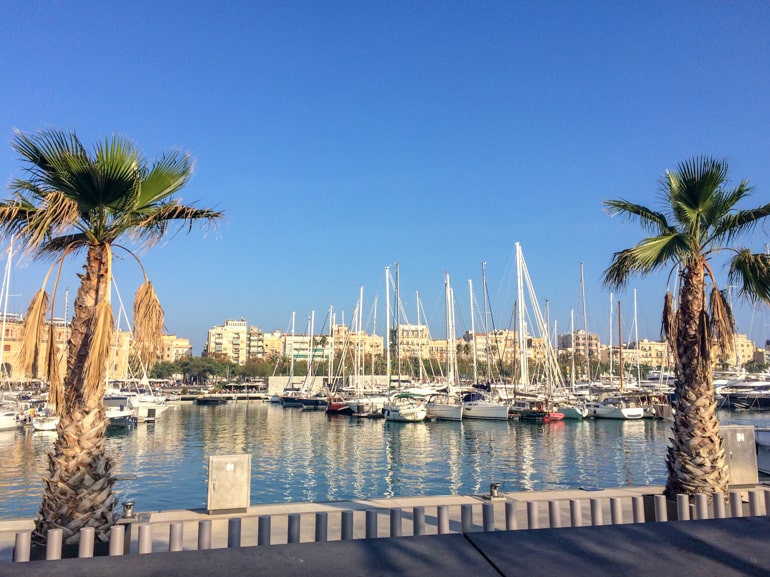
Barcelona is a good city to start a road trip since it is a popular tourist destination and thus has frequent flights to other European or International cities. Barcelona is the capital city of Catalonia which has its own unique culture and language next to Spanish.
Since it is such a popular city, the car rental industry is very well developed and it is easy to pick up a rental car from the airport or in the city.
Find your rental car in Barcelona here .
Alternatively, the bus station in Barcelona is great and easy to reach from the centre. There are numerous connections to Zaragoza which will be the next stop on your 5-day Spain itinerary.
Accommodation in Barcelona : As a super popular tourist destination, there are lots of hotels and apartments available in Barcelona.
Check here for Accommodations in Barcelona .
Specifically, for hotels check out Catalonia Born Hotel with a boutique style and rooftop pool in the city centre and close to the beach.
If you travel by car, Sallés Hotel Pere IV is a lovely and affordable hotel with spa in the heart of the city with a private parking garage onsite .
As for hostels, you can check out Barcelona hostels here. Specifically, we liked Kabul Hostel . This place even made our list of favourite hostels across Europe .
Overall, since Barcelona is so popular we strongly advise you to book in advance – especially during summer – as it can get very expensive otherwise.
Must-see Attractions in Barcelona:
- Sagrada Familia
- Casa Batlló
- The National Catalonian Arts Museum
We’ve written a whole guide on some of the incredible places to visit in Barcelona if you are interested in seeing more!
Day 2: Barcelona/Zaragoza
On the second day of your 5 days in Spain, you’ll spend the morning in Barcelona (you’ll get a cafe con leche y croissant in any cafe/bar for quite cheap if you get off the main tourist roads) and then drive from Barcelona to Zaragoza later in the day.
The drive from Barcelona to Zaragoza will take you approximately 3 hrs 10 min by car (includes a toll road), 3,5 hrs by bus and 1,5 hrs by train . If you end up taking the train, try to book in advance if you can as this will usually end up being cheaper.
Accommodation in Zaragoza: Since Zaragoza is a smaller city, there are fewer accommodations to choose from – but still lots of really great options.
Check here for hotels in Zaragoza .
Specifically, we love the look of Hotel Sauce . This bright and airy hotel is located right in the city centre and offers a homemade buffet breakfast, air conditioning, and private parking onsite for those travelling by car.
If you are looking for a rooftop pool, Hotel Palafox has you covered! Also located right in the heart of the city, the hotel has a cool decor, great city views, tasty breakfast, and also has parking and air conditioning!
There aren’t a ton of hostels but the ones that do exist are well-rated – so you can check here for hostels in Zaragoza .
Must-see Attractions in Zaragoza:
- Basílica del Pilar
- Aljafería Palace
- Cathedral San Salvador
Day 3: Logroño
On your third day, you will drive from Zaragoza to Logroño which is the capital of the autonomous region of La Rioja and known for its delicious wine.
If you get the chance visit one of the wineries and do a wine tasting – please plan ahead if you’re travelling by car since drinking and driving is a big no-no!
The drive will be a lot shorter than the day before. By car, it’ll take you approximately 1 hr 40 min and by bus the journey would be around 2 hrs if you get a direct bus.
Accommodation in Logroño : Similarly to Zaragoza, Logroño is a smaller city with many great accommodations in the heart of the city.
Check here for apartments and hotels in Logroño .
Specifically, Hotel Murrieta is a popular and very affordable option with a good breakfast right in the heart of the city. If you drive a car, Hotel Calle Mayor is a more charming (but still very affordable) hotel with secure underground parking at the hotel.
If you are looking for a hostel in Logroño, there aren’t many but the ones that exist are very good. You can check here for hostels in Logroño .
Must-see Attractions in Logroño :
- Cathedral of Santa María de Redonda
- Church of San Bartolomé
- The Bodegas (Wineries)
Day 4: Donostia-San Sebastián
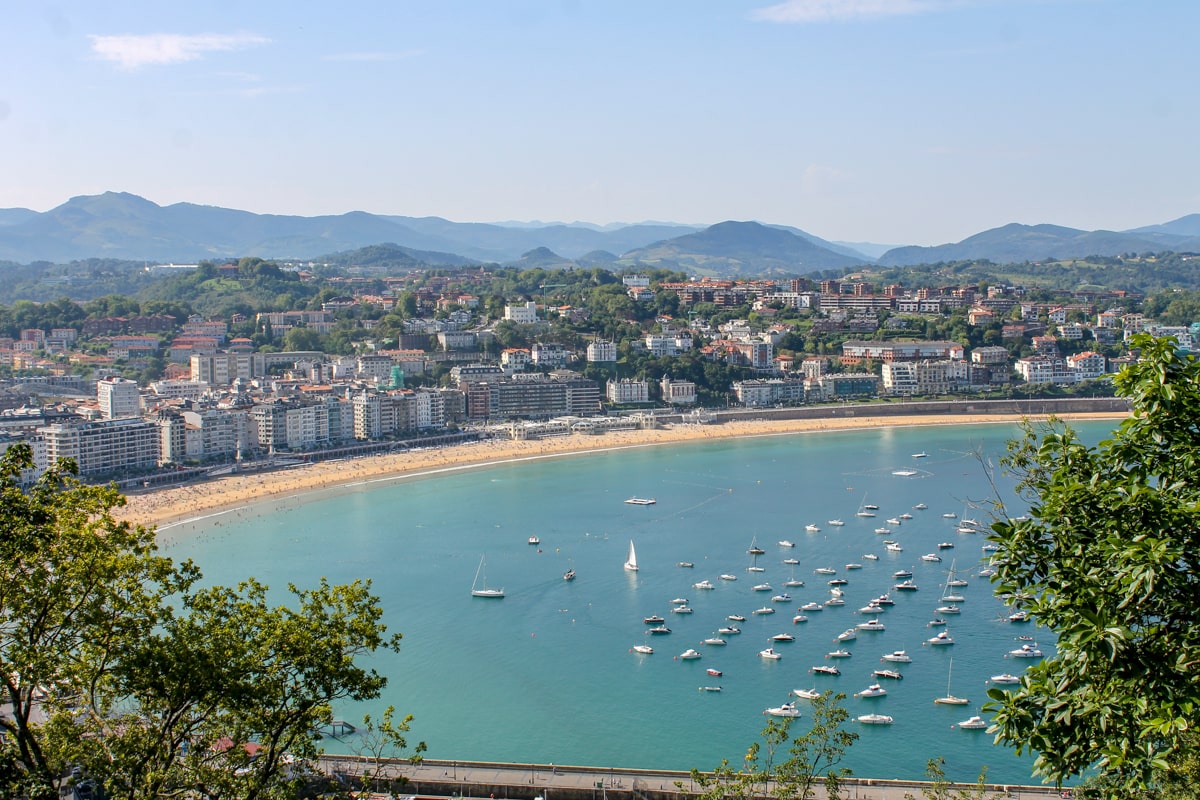
Some would consider San Sebastián one of the most beautiful towns in Spain and Lisa can see why.
When she lived in Bilbao she visited San Sebastián quite a few times and really enjoyed the vibe of the town (and having a beautiful beach so close). Don’t forget to eat some delicious Pintxos since San Sebastián is especially known for them!
The drive from Logroño to San Sebastián takes around 2 hrs by car, and between 2 and 5 hrs by public transport .
Since you are travelling between two smaller cities the connections are not that great and we would recommend planning ahead to compensate for this.
Accommodation in San Sebastián : San Sebastián is one of the most expensive towns in Spain and very popular among luxury travellers.
So, don’t be surprised if accommodations seem a little more expensive overall. That said, you can still find a great place to stay that suits your budget and style if you’re not looking for luxury.
Check here for hotels in San Sebastián .
Specifically, you can check out Casual de las Olas San Sebastián . This hotel is a bit further from the old town and beach but makes up for it in sleek decor, breakfast, and air conditioning.
If you want more of a laid-back guesthouse feel, check out Talaia HT . This authentic and cozy guesthouse is located in the heart of the old town – and has public parking nearby .
If you are looking for a hostel, you can find great hostels across San Sebastián here . Wherever you book, our advice is to book early to find deals and generally save money when booking.
Must-see Attractions in San Sebastián :
- Urgull Hill
- Plays de La Concha
- San Sebastián Cathedral
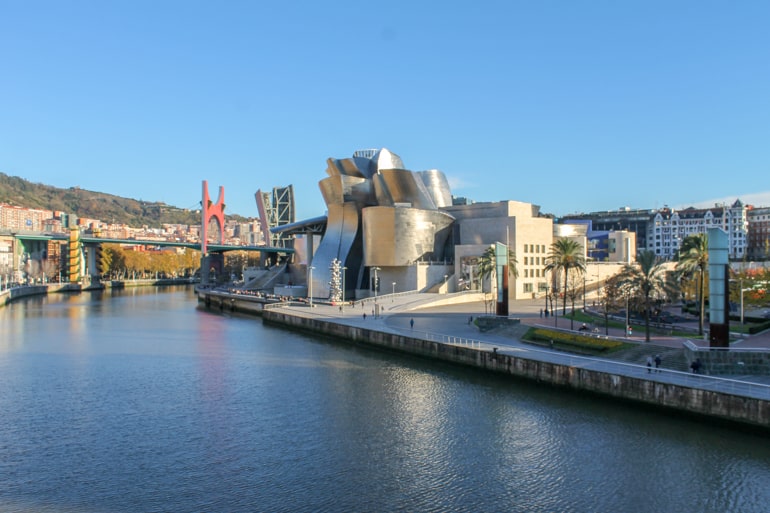
Bilbao has to be one of Lisa’s favourite Spanish cities. Not because it is especially beautiful, but because she lived there for a few months and it felt like home from the beginning. If you get the chance, take the metro to one of the beaches – you won’t regret it!
The drive from San Sebastián to Bilbao is a short and beautiful one as you will drive through some mountainous regions. By car it’ll take you approximately 1 hr 15 min and by bus the journey will be around 1,5 hours .
Bilbao also marks the end of this 5 day Northern Spain itinerary.
Bilbao is a good city to fly out of as it is one of the biggest cities in the region and well connected to bigger airports in other European cities. To get to the airport you can simply take the Airport bus from the bus station at San Mames.
Accommodation in Bilbao : Since Bilbao is a bigger city there is a wider variety of accommodations available.
Check here for apartments and hotels in Bilbao .
Specifically, Hotel NH Bilbao Deusto is a bright and simple hotel with buffet breakfast and private underground parking . Lisa had friends stay there and liked it. It’s not right in the heart of the city centre – but across the water from the Guggenheim Museum!
If you want to stay right in the heart of old town Bilbao, you should definitely check out Ercilla Hotela . This is a very stylish and popular hotel with an amazing rooftop terrace, lounge, also onsite parking , and traditional Basque food in the restaurant!
If you are looking for a cheaper place to stay, Bcool Hostel is a very “cool” hostel in Bilbao. In general, remember to book accommodations closer to the city centre/the river since the rest of Bilbao can be quite hilly!
Must-see Attractions in Bilbao:
- Guggenheim Museum
- The Old Town (Casco Viejo)
- Zubizuri Bridge
*Just so you know, we have a whole detailed guide on Bilbao things to do !
Spain Itinerary 5 Days – Southern Spain Itinerary
If you would like to explore Southern Spain instead of the north, then we would recommend the following 5-day Southern Spain itinerary.
Generally, the south is a little bit warmer than the north so maybe don’t try to do this trip in the middle of the summer heat as it can be quite exhausting!
The itinerary is just over 600 kilometres with a total driving time between 7 and 8 hours depending on your mode of transportation.
Spain Itinerary 5 Days – Southern Itinerary Overview
- Day 1: Málaga
Day 2: Day trip to Granada
- Day 3: Marbella
- Day 4: Cádiz
Day 5: Seville
Day 1: málaga.
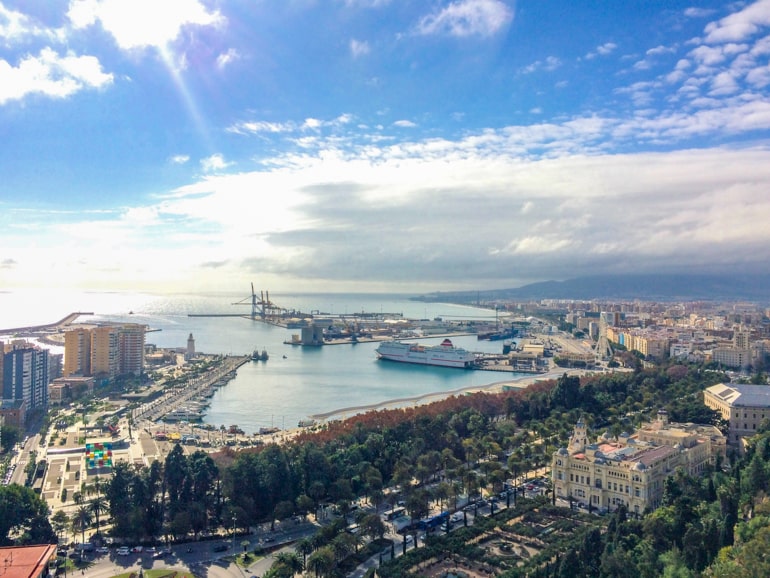
We are starting this itinerary in Málaga since it is an easy airport to fly in from other parts of Europe.
When Lisa arrived at the airport the first time she was actually kind of shocked to see that all the signs were written in German as well.
Needless to say, Málaga is a very popular destination among German tourists. It’s also an interesting city to visit in the wintertime !
Lisa didn’t like the city that much (as in wouldn’t want to live there), but it is definitely worth exploring for a day or two. It is also quite easy to get from the airport to the city centre by public transport. You can find your rental car from Malaga here .
Accommodation in Málaga: Malaga is a popular tourist destination in the south of Spain and so there are lots of different accommodation options. That said, apartment rentals are a very popular option.
Check here for apartments or hotels in Malaga .
Specifically, if you want a hotel, check out Hotel Boutique Teatro Romano . This minimalist design hotel is bright and clean and offers an excellent breakfast while being located right in the heart of the city centre.
If you are planning to stay in Malaga a bit longer, check out Apartamentos Nono . Located close to the beach and a quick walk to the city centre, these apartments have kitchenettes for smaller meals, terraces, and onsite private parking .
If you are searching for a hostel, Malaga has lots. You can search for hostels in Malaga here . When visiting Malaga with a friend, Lisa stayed at Casa Al Sur Terraza .
Even though it’s a “hostel”, it’s a popular place to stay in Malaga. They have private rooms and a lovely rooftop terrace. She and her friend stayed in a private room and loved it!
Just remember for this itinerary, wherever you book you will need to stay for 2 nights !
Must-see Attractions in Málaga:
- Alcazaba Palace
- Picasso Museum
- Cathedral of Málaga
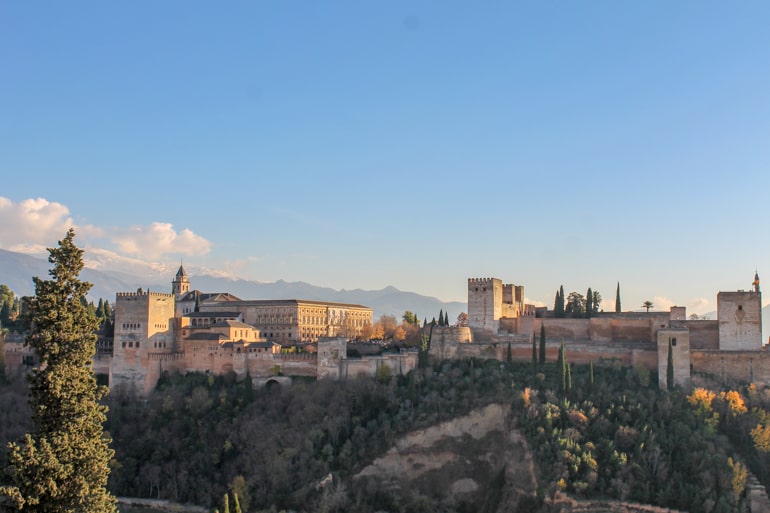
Today you’ll take a day trip to Granada. If you decided to rent a car you can do this by car, but then have to find parking in Granada. Lisa and her friend took the bus to Granada which was pretty easy to do since there are frequent buses throughout the day.
In Granada, you HAVE to go see La Alhambra. Make sure to book your ticket in advance (since there is only a limited amount of spots per day).
Lisa and her friend had to pick up her tickets at an office in the city before going to the actual attraction. Double-check your ticket since you might have to do that, too!
The journey from Málaga to Granada is approximately 1.5 hrs by car and 2 hrs by bus .
Accommodation in Granada: You won’t need a place to sleep in Granada since you’ll be returning to Málaga at the end of the day.
But IF you are curious – check out Hotel Granada Center or Granada Five Senses Rooms & Suites for two great hotels in the heart of the historic city centre!
Must-see Attractions in Granada:
- Alhambra Palace
- Albaicín District
- Cathedral of Granada
Day 3: Marbella
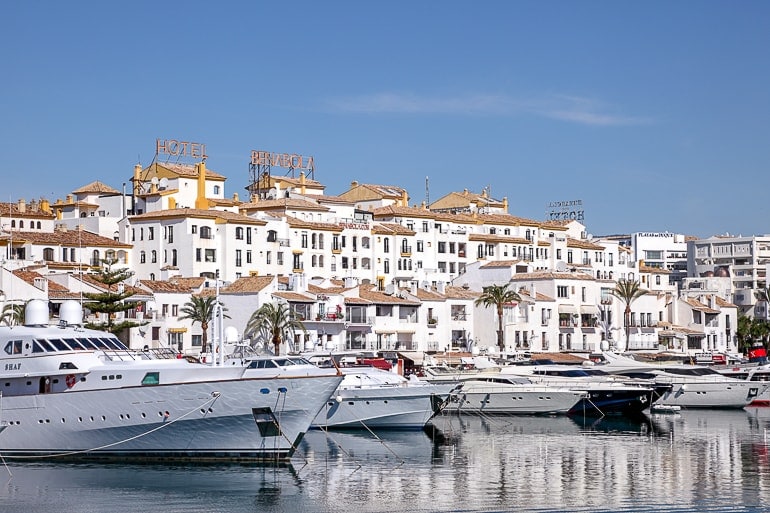
On the third day of this 5 day Southern Spain itinerary, you’ll drive from Málaga to Marbella. Marbella is a city by the water and part of the well know Costa del Sol. It is one of the most popular tourist cities in the region mainly due to its nice beaches and climate.
Since Marbella is quite close to Málaga the drive won’t be long – giving you more time to explore the city and relax at the beaches. The journey takes approximately 1 hour by car (there are different routes some of which include toll roads) and 1.5 hours by bus .
Accommodation in Marbella : Since the tourism industry is quite developed in Marbella, there are lots of amazing sunny accommodations to choose from.
Check here for hotels and apartments in Marbella .
Specifically, Paloma Blanca Boutique Hotel is a gorgeous (and affordable) boutique hotel with breakfast and free private parking onsite.
If you are looking for more of a beach resort, Amàre Beach Hotel Marbella is a beautiful all-inclusive adult-only beachside resort with breakfast, spa, pool, amazing views, and more!
Must-see Attractions in Marbella:
- The Old Town of Marbella
- Avenida del Mar
- Puerto Banús
Day 4: Cádiz
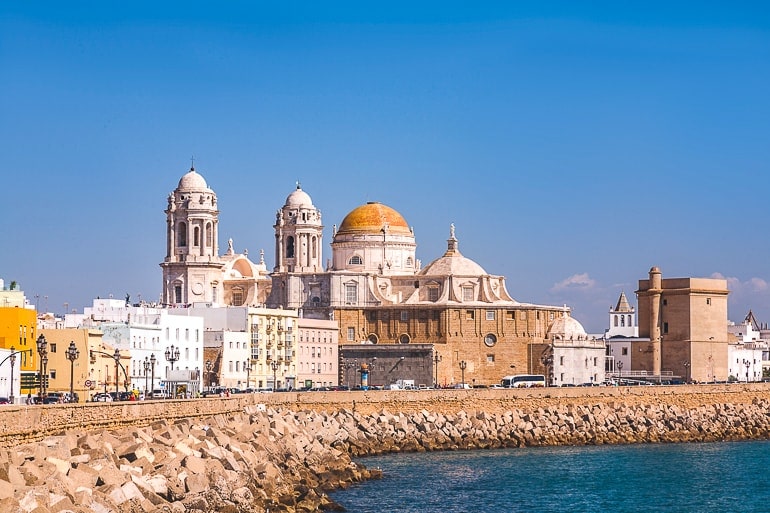
Cádiz is often considered a hidden gem in Spain. Lots of people who have been there seem to love it and Lisa is dying to visit the city.
Fun fact: Some think of Cádiz as the oldest continuously inhabited city in Western Europe. It is just slightly smaller than Marbella with lots of attractions waiting to be explored.
Driving from Marbella to Cádiz by car will take you approximately 2 hours including a toll road and slightly longer if you want to avoid toll roads.
You’ll drive along the coast for a while and could consider stopping along the way. Another option would be to make a pit stop in Gibraltar which you will pass along the way.
Unfortunately, Marbella and Cádiz do not seem to be connected well by public transport and travel between the two cities would involve going back to Málaga and/or through Sevilla (or Seville as the English like to call it).
If it is too much of a hassle for you to get from Marbella to Cádiz, consider skipping it and going straight to Seville instead.
Accommodation in Cádiz: Even though Cádiz is a smaller city, there are plenty of places to stay.
Check here for hotels and apartments in Cádiz .
Specifically, Hotel Boutique Convento Cádiz is a gorgeous hotel in the old town (close to the beach) with a great breakfast and private parking nearby .
Alquimia Albergue-Hotel is a cool and cozy hotel (also in the city centre) close to the beach and also with parking nearby. As for hostels, Cádiz does have quite a few hostels with amazing ratings. You can check here for hostels in Cádiz .
Must-see Attractions in Cádiz:
- Cádiz Cathedral
- Fortress San Sebastian
- Plaza de San Juan de Dios
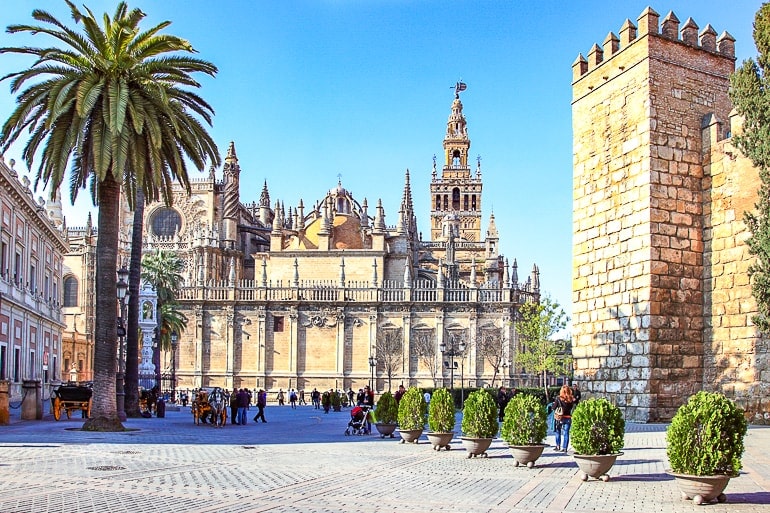
Seville is another popular destination in Spain and is often considered one of the hottest cities of the country. Therefore we would not recommend going there during July and August if you don’t like extreme heat (Lisa definitely doesn’t).
It is a beautiful city with lots of attractions to check out so be sure to have a good amount of time for exploring. If you don’t end up going to Cádiz, there is more than enough to do in Seville to keep you busy for two days!
Driving from Cádiz to Seville will take you approximately 1.5 hours by car and just slightly longer (1 hr 45 min) by bus . Seville also marks the end of this Southern Spain trip as it has a big airport which makes it super easy for you to fly back home.
Accommodation in Seville : Seville is a bigger and very popular city so there is no shortage of great accommodation options.
Check here for apartments and hotels in Seville .
Specifically, you have to see Petit Palace Puerta de Triana . This very trendy and cool design hotel offers a buffet breakfast and is located right in the city centre close to top attractions.
If you want a more historic stay, Hotel Simon is a more simple and authentic hotel. It’s located in a historic building, also does breakfast, and is also located in the heart of the city centre.
Neither of the above hotels offers parking – but few in the city centre of Seville offer onsite parking (or even public parking nearby).
If you are looking to have parking available, then you can check out La Parada del Marqués . It’s a beautiful guesthouse/hotel also centrally located and offers breakfast options and good connections to public transit!
If you are looking for a hostel, you can search for hostels in Seville here . Again, since Seville is so popular we would advise booking ahead – especially during the high season!
Must-see Attractions in Seville:
- Seville Cathedral
- Plaza de España
Spain Itinerary 7 Days
If you have slightly more time to explore Spain, we have also created two 7-day Spain itineraries for you. You’ll see that once again we give you two options since seven days are – in our opinion at least – still not enough to see the whole country.
Therefore, you’ll find a 7-Day Western Spain Itinerary and a 7-Day Eastern Spain Itinerary below. As always, feel free to modify them to make them fit your exact plans!
Spain Itinerary 7 Days – Western Trip
For this itinerary, the total driving time would be around 14 hours and the distance would be around 1300 km .
These estimates account for the Toledo day trip (and back to Madrid) AND finishing with ONE of either Seville OR Malaga from Córdoba. So, in theory, it could be shorter or longer than we have indicated here on the map!
We’ve already covered some of the places above, but we will mention the important parts again to make it easier for you to plan your exact trip.
Please note that we won’t actually include any places on the west coast of Spain – that would be a whole other trip in itself. Your 7-Day Western Spain Itinerary could look something like this:
Spain Itinerary 7 Days – Western Trip Overview
Day 1: Bilbao
Day 2: burgos.
- Day 3: Salamanca
- Day 4: Madrid
- Day 5: Madrid / Day trip to Toledo
Day 6: Córdoba
Day 7: seville or málaga.
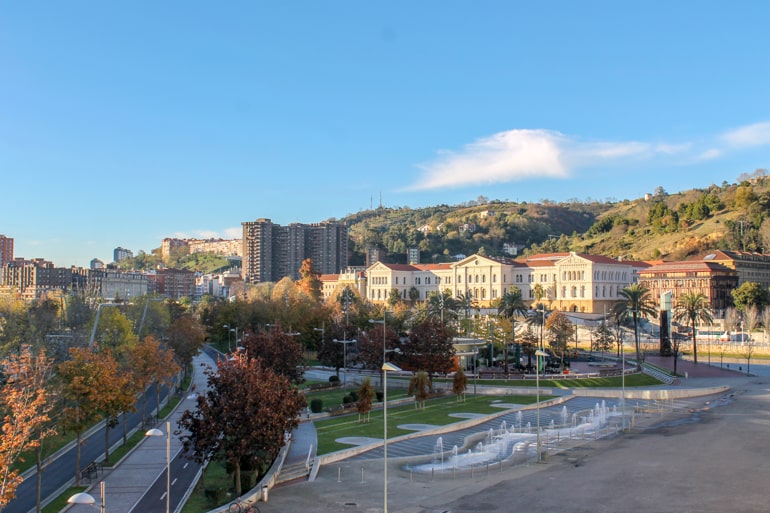
Similarly to how we ended the five-day itinerary in Bilbao, we’ll start this itinerary there as it is a relatively easy airport to fly into from other places in Europe. If you’re starting your longer Spain trip, you can find your rental car in Bilbao here .
Make sure to use your time to explore the Casco Viejo (the Old Town) and walk along the river! There are some great Pintxo places in the Old Town that you should absolutely check out!
Accommodation in Bilbao : Bilbao is a larger city so there’s quite a variety of accommodations available.
Check here for hotels in Bilbao .
Specifically, Hotel NH Bilbao Deusto is a bright and simple hotel with good breakfast and underground private parking . Friends of Lisa stayed there and said they enjoyed it. It’s close to the river across from the Guggenheim Museum but still a quick walk to the old town.
To stay in the heart of old town Bilbao, you have to see Ercilla Hotela . This is a very stylish and popular hotel with a lovely rooftop terrace and lounge, onsite parking , and they even serve traditional Basque food!
As for hostels, Bcool Hostel is a very “cool” hostel in Bilbao. In general, remember to book any hotels or accommodations somewhat closer to the city centre/the river because Bilbao can be quite hilly around the edges!

Burgos might not be a city that is immediately on your radar for places to visit in Spain but we would recommend a stop there on your way south.
Lisa visited Burgos with friends on a day trip from Bilbao so she knows how easy it is to get there. Burgos is a nice city but since there is not a ton to see, one night is the perfect amount of time in our opinion.
Getting from Bilbao to Burgos takes approximately 1.5 hours by car and 2 hours by bus .
Accommodation in Burgos : Burgos is not an overly big city, but you can still find lots of great accommodations.
Check here for hotels in Burgos .
Specifically, Hotel Puerta de Burgos is a popular, trendy, and affordable hotel with private underground parking at the hotel. This makes it a great option if you have a car because it’s a little further from the centre (still quite close) and just off the motorway.
Another great hotel closer to the city centre/attractions is NH Collection Palacio de Burgos . This is an elegant hotel with a great breakfast and private parking, too.
If you want to stay in a hotel that physically faces the famous Burgos Cathedral, check out Hotel Mesón del Cid !
Must-see Attractions in Burgos:
- Burgos Cathedral
- Las Huelgas
- Museum of Human Evolution
Day 3: Salamanca
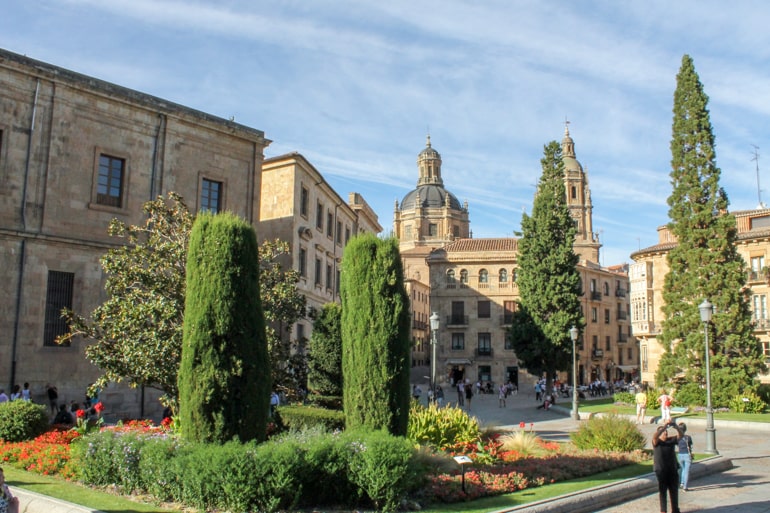
From Burgos, your journey continues to Salamanca – another one of Lisa’s favourite cities in Spain. Salamanca is sometimes called “The Golden City of Spain” and you’ll understand why.
The many sandstone buildings get illuminated beautifully by the sun – making it appear golden. Be sure to bring your camera because you’ll want to use it in Salamanca. Our tip: Cross the river to get amazing photos of the cathedral.
Getting from Burgos to Salamanca is easy and will take approximately 2.5 hours by car or 3 hours by bus .
Accommodation in Salamanca: Salamanca has lots of great accommodations in the city.
Check here for hotels in Salamanca .
Specifically, Hospes Palacio de San Esteban is an authentic-style hotel in the city centre with an incredible breakfast and onsite private parking .
If you are looking for a very affordable hotel with views of the Cathedral, Hotel San Polo is for you. The popular hotel is in a location that doesn’t get much more central! There’s no parking available – making it great if you travel by bus and train only.
When Lisa visited Salamanca on a weekend trip, she stayed in a hostel with friends close to the Old Town and loved it. You can check out the good selection of hostels in Salamanca .
Must-see Attractions in Salamanca:
- Salamanca Cathedral (Old + New)
- Plaza Mayor
- Salamanca University
Day 4: Madrid
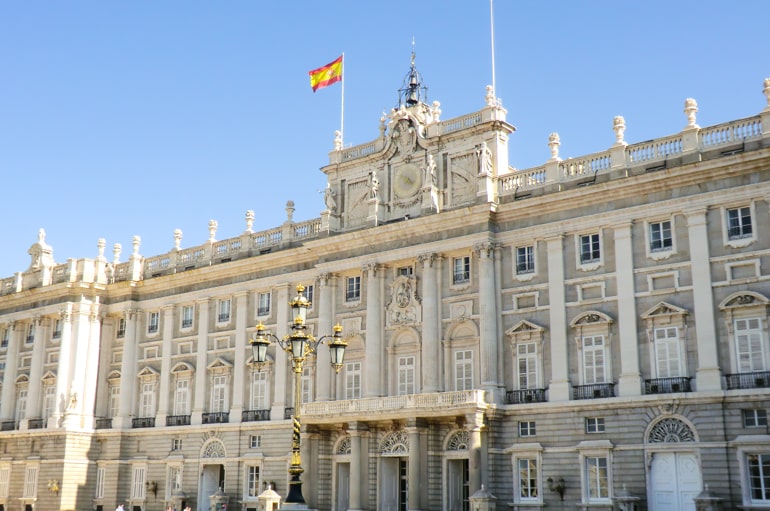
Since Madrid is the capital of Spain you shouldn’t miss it on your itinerary. Conveniently it is also quite close and easy to get to from Salamanca.
Since there is so much to see in Madrid one day to explore might not be enough for you. That’s why you might opt for spending two days in Madrid instead.
Lisa has been to Madrid two times now and still hasn’t seen everything there is to see. But at least you’ll get a good sampler!
As mentioned, getting from Salamanca to Madrid is easy. The journey will take approximately 2 hrs 12 min by car (including a toll road) and 3 hours by bus .
Madrid’s main bus station is actually underground which is kind of cool and caused a lot of confusion for Lisa and her friends when they tried to find it the first time.
Accommodation in Madrid : Being the capital city of Spain, Madrid is a popular city with lots and lots of accommodation options. Keep in mind that Madrid has many “hostals” which are technically guesthouses but are basically hotels.
Also, if you have a car don’t be surprised if parking is in a public lot for a high fee – that’s just Madrid.
Check here for apartments and hotels in Madrid .
Specifically, you might want to check out Room007 Select Sol . This charming and trendy hotel is right in the heart of the city, has air conditioning, and serves breakfast at a cafe next door!
If you are looking for a simple stay right in the centre, check out Hostal Madrid . This authentic guesthouse is so centrally located with top attractions and a metro station around the corner.
It’s such good value for money that the two times Lisa travelled to Madrid she actually stayed here both times!
Should you be on the hunt for an actual hostel, you can check here for hostels in Madrid . Keep in mind wherever you book, you will be booking accommodation for two nights.
Must-see Attractions in Madrid:
- Museum Reina Sofia
- Puerta del Sol
Keep in mind we have a whole separate detailed guide on amazing things to do in Madrid !
Day 5: Madrid or Day trip to Toledo
As mentioned, you might opt to spend another day in Madrid since there is so much to see.
If that’s the case read our Madrid guide linked above to get more recommendations. Alternatively, you could opt to go on a day trip to Toledo, a beautiful small city not too far from Madrid.
If you don’t want to drive there yourself, you can choose to book a day tour which includes a tour of Toledo among other things. If you want to drive yourself the journey will take you approximately 1 hour by car and the same amount of time by bus .
Must-see Attractions in Toledo:
- Toledo Cathedral
- Monasterio de San Juan de los Reyes
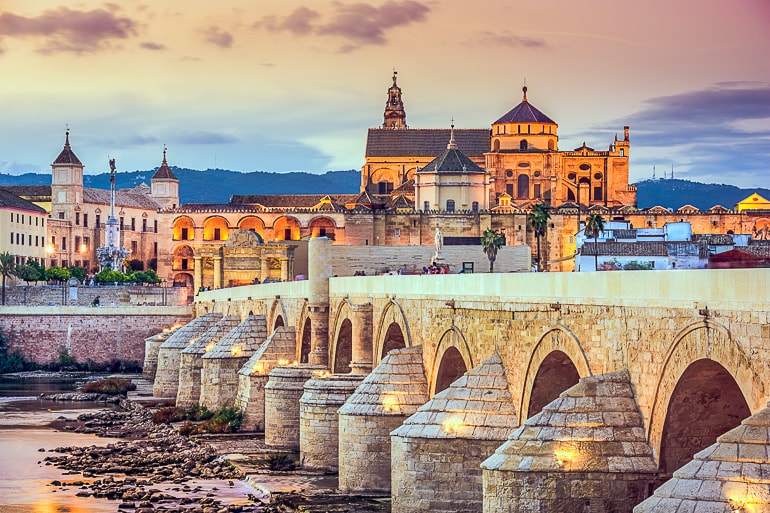
The next day you will drive to Córdoba, a city in Andalusia known for its famous flower street – among other things of course. There is a lot of history to be found in Córdoba so consider taking a walking tour if you want to learn more about it.
This is one of few routes where you will actually be faster taking public transport as if you were to drive yourself since there is a good train connection between Madrid and Córdoba.
Driving by car takes approximately 4 hours while the journey by train would be slightly shorter with 2 hrs 15 min .
Accommodation in Córdoba : If you’re looking for a hotel, there are lot of options to choose from.
Check now for hotels in Córdoba .
Specifically, Maciá Alfaros is an authentic hotel located right in the heart of the city centre with an incredible swimming pool and easy parking onsite.
Hotel Cordoba Center is an elegant hotel located outside the heart of the centre. It’s still very walkable to the centre, is very close to the train station, and has a rooftop pool with amazing views!
There are quite a few hostels with very good ratings in Córdoba so you can check here for hostels in Córdoba .
Must-see Attractions in Córdoba:
- Mosque–Cathedral of Córdoba
- Alcázar de los Reyes Cristianos
- Historic Center of Córdoba
For this itinerary, you can decide in which city you would like to end your trip. For some, it might be more convenient to fly out of Seville while for others Málaga might be the better option. So it’s really up to you and your preference!
The journey from Córdoba to Seville takes approximately 1 hr 40 min by car and 45 min by train . The time it takes to get from Córdoba to Málaga isn’t much longer with 1 hr 50 min by car and 50 min by train .
Accommodations in Seville : As mentioned above, Seville is a popular city so there is always accommodations to choose from.
Specifically, check out Petit Palace Puerta de Triana . This trendy design hotel offers a buffet breakfast and a really great location in the city centre.
For a historic stay, Hotel Simon is a more simple and more authentic hotel. It’s located in a historic building, does breakfast, and is also located in the city centre.
Neither of the above hotels have parking – but fewer properties in Seville offer onsite parking (or even public parking nearby).
If you are travelling by car and want parking available, then check out La Parada del Marqués . It’s a beautiful guesthouse/hotel also centrally located with breakfast options and good connections to public transit!
If you want a hostel stay, you can search for hostels in Seville here . Regardless of what type of accommodation you book, Seville is popular so we would advise booking ahead – especially during the high season!
Accommodation in Málaga: Malaga is a popular destination in the south of Spain with lots of different accommodation options. That said, apartment rentals are very popular.
Specifically, for hotels, you can check out Hotel Boutique Teatro Romano . This design hotel is bright and clean and offers breakfast while being located right in the heart of the city.
If you are planning for a longer stay, check out Apartamentos Nono . Located close to the beach and a quick walk to the city centre, these apartments have kitchenettes, terraces, and onsite private parking .
If you want a hostel, Malaga has lots. You can search for hostels in Malaga here . When visiting Malaga with a friend, Lisa stayed at Casa Al Sur Terraza .
Even though it’s a “hostel”, it’s a popular place – with private rooms and a lovely rooftop terrace. Her and her friend stayed in a private room and loved it!
Spain Travel Itinerary 7 Days – Eastern Trip
If the other 7-day Spain itinerary doesn’t really appeal to you and you would like to stay closer to the coast, maybe this itinerary is more to your liking. The driving time would be just shy of 11 hours and would be approximately 1000 km driving distance !
Spain Itinerary 7 Days – Eastern Trip Overview
- Day 1+2: Barcelona
Day 3: Valencia
- Day 4: Alicante
- Day 5: Murcia
Day 6: Granada
Day 7: málaga, day 1 + 2: barcelona.
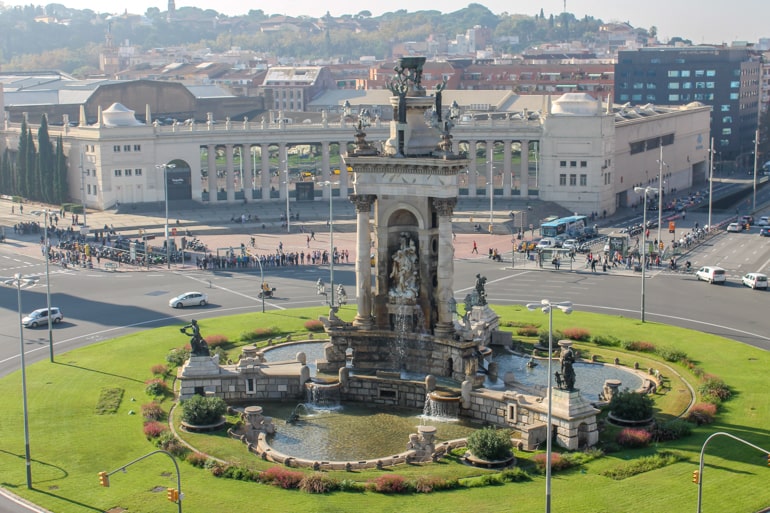
Once again, this itinerary starts in Barcelona since it is one of the easiest airports to fly into. Since you have a little bit more time with this itinerary you’ll stay in Barcelona for two days.
There is lots to see so you still won’t see everything, but definitely more than in just one day. To then continue on with this itinerary through Spain, you can find your rental car in Barcelona here .
Accommodation in Barcelona: As mentioned above, there are lots of hotels and apartments in Barcelona.
For hotels, you might like Catalonia Born Hotel with a boutique style and rooftop pool close to the beach in the city centre.
If you travel by car, Sallés Hotel Pere IV is an affordable hotel with spa in the heart of the city with a private parking garage .
As for hostels, you can check here for Barcelona hostels . We liked Kabul Hostel . Wherever you stay, remember to book in advance because the city does fill up and it can get expensive! And remember, you’ll be staying at this place for two nights .
- Las Ramblas
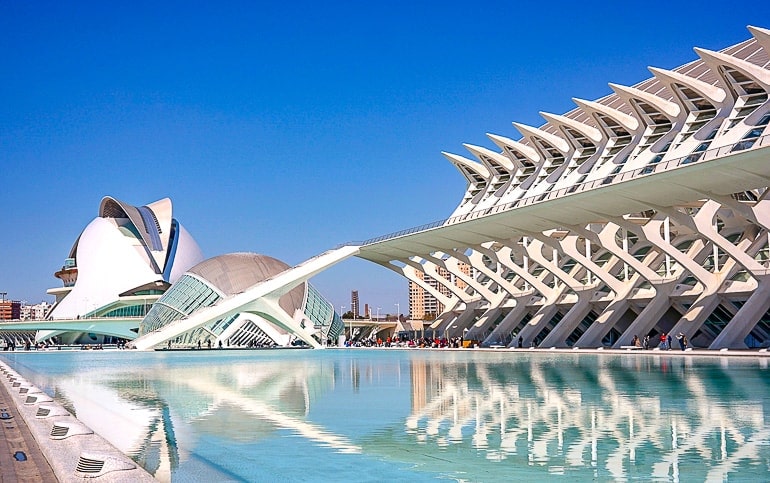
The third day of this Spain itinerary will take you from Barcelona to Valencia which is another city on Lisa’s favourite list.
It was actually the first Spanish city she visited and she fell in love with the city and its people right away. Her favourite part is that there is a huge part in what was formerly a river that stretches through a big part of the city.
In order to get from Barcelona to Valencia, you’ll drive along the coast for 3.5 hours by car and around 3 hrs 15 min by train.
Accommodation in Valencia: Since Valencia is a bigger city, you are sure to find accommodations that work for you.
Check here for hotels in Valencia .
Specifically, Petit Palace Ruzafa is a bright and boutique hotel right in the city centre.
They offer healthy breakfast options and free bike rentals. There’s no parking making this a great hotel for those travelling without a car.
If you want a place right on the beach, check out Hotel Miramar . This cool beachfront hotel has a bar and restaurant right downstairs and has paid parking onsite . If you are looking for a hostel, you can check here for hostels in Valencia .
Must-see Attractions in Valencia:
- City of Arts and Science
- Lonja de la Seda
- Cathedral of Valencia
Day 4: Alicante

Alicante is a popular holiday town that lots of Europeans visit to enjoy the nice weather and the beaches. Maybe you have heard of the name Costa Blanca?
Alicante is part of that exact region. When you’re there don’t forget to check out some of the nice beaches – but of course, there are also lots of other things waiting to be explored.
Getting from Valencia to Alicante won’t take overly long. The drive will take approximately 2 hours by car and 1.5 hrs to 2.5 hours by train or bus respectively.
Accommodation in Alicante: Alicante is a popular city due to its great location on the coast.
Check here for hotels in Alicante .
If you want to stay directly on the beach, Hotel Almirante is a bright and stylish hotel with breakfast buffet. It’s a bit farther from the city centre, but there is free onsite parking if you have a car.
If you want more of a resort style, Melia Alicante is also located right on the beach with stunning views over the water. It’s much closer to the centre of the city and has good amenities (pool), paid parking next door, and a really good breakfast!
You can also find a good mix of hostels in Alicante. In any case, don’t forget to book ahead in the summertime since it can get very crowded.
Must-see Attractions in Alicante:
- Castle of Santa Barbara
- Casco Antiguo (Old Town)
- Beaches such as Playa Postiguet
If you’re heading for Alicante to get some sunshine, we’ve got a guide on things to do and see in Alicante that includes some great food tips for you to check out!
Day 5: Murcia
Murcia is a city in the southeast of Spain and the capital of the region with the same name. Travellers who don’t know much about Spain (yet) might not have heard of the city before but this doesn’t mean it is not worth a visit.
The drive from Alicante to Murcia is quite short with 1 hr by car and 1 hr 10 min by bus . This will give you a good amount of time to explore the university city and get a rest from all the driving.
Accommodation in Murcia: Since Murcia is a less touristy city you’ll find great places to stay and (generally) fewer crowds.
Check here for hotels in Murcia .
Specifically, the Hesperia Murcia Centro is a clean and modern hotel right in the city centre near the Cathedral. There’s also private onsite parking and a tasty breakfast.
If you want to stay closer to the coast – you could stay in Cartagena (about 30 minutes away from Murcia). Here, check out NH Cartagena – with bright, sea views and parking all in a great location.
Must-see Attractions in Murcia:
- Murcia Cathedral
- Floridablanca Gardens
- Monteagudo Castle
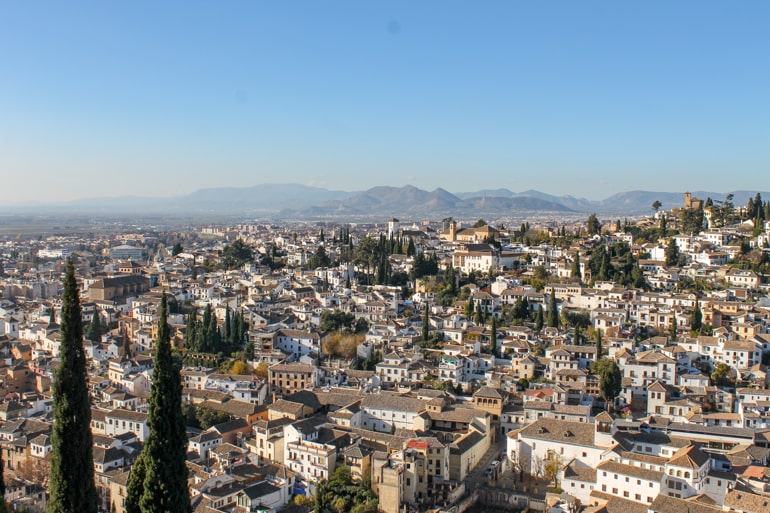
From Murcia, your journey will continue to Granada, a city which we have mentioned quite a few times by now so we won’t go into details again. If you haven’t yet, make sure to get your Alhambra tickets in advance!
Driving from Murcia to Granada will be a slightly longer trip with 2 hrs 45 min by car and around 3.5 hrs by bus .
Accommodation in Granada: Since Granada is a popular travel destination, many accommodations are available.
Check here for hotels in Granada .
Specifically, Hotel Granada Center is a VERY popular hotel with great breakfast, a very central location, and private underground parking onsite .
Also situated in the city centre is Granada Five Senses Rooms & Suites – a sleek and modern hotel with small rooftop pool with great views of the historic old town! If you are looking for a hostel, you can check here for hostels in Granada .
Since we have mentioned Málaga countless times above, there is not much to add. As you probably know by now Málaga has a great airport to fly out of so this is where this 7-day Eastern Spain itinerary ends.
The journey from Granada to Málaga is approximately 1,5 hrs by car and 2 hrs by bus .
Accommodation in Málaga: Malaga is a popular tourist destination in Spain so there are lots of available accommodations – with apartments being the most popular.
For hotels, check out Hotel Boutique Teatro Romano . This minimalist design hotel is bright and offers a great breakfast while being located right in the city centre.
For longer stays, check out Apartamentos Nono . Located close to the beach and to the city centre, these apartments have kitchenettes for small meal prep, terraces, and onsite private parking .
If you are searching for a hostel, you can search for hostels in Malaga here . When visiting Malaga with a friend, Lisa stayed at Casa Al Sur Terraza .
It’s a popular place to stay in Malaga with private rooms and a great rooftop terrace. She and her friend stayed in a private room and really liked it!
Spain Itinerary – 14 Days
This road trip would be a beast. As planned above with the scheduled day trips you’d cover around 2600 kilometres .
The driving time would be around 27 hours and 30 minutes – but of course, this varies by traffic and which day trips/stop days (beach days) you opt to take, etc.
If you swung down to Gibraltar at the end and then went to Granada and Malaga, it could very well be a tad longer.
You should also consider the price of renting a car for two weeks to see if there are any companies that offer discounts!
Compare prices for your car rental from Bilbao here .
Since you have read about most of these places in some of the itineraries above we’ll keep this one short.
Our version is written from north to south, so from Bilbao to Málaga. As with most of our itineraries, you can reverse the direction if you feel like it So, to really see the whole country, your updated 14-day Spain itinerary might look something like this:
14-Day Spain Itinerary Overview
- Day 2: Day trip to Santander, Vitoria-Gasteiz or Beach Day
- Day 3: Donostia-San Sebastián
- Day 4: Zaragoza
Day 5+6: Barcelona
Day 7: valencia, day 8+9: madrid.
- Day 10: Toledo or Córdoba
Day 11: Seville
- Day 12: Seville or Day trip to Cádiz/ Gibraltar
- Day 13: Málaga (or Granada)
- Day 14: Málaga
Once again we are starting this itinerary in Bilbao since it is an easy city to get to. There are quite a few things to see and delicious foods to try so with this itinerary you have slightly more time to explore the city!
Accommodation in Bilbao: Once again, Bilbao is a bigger centre in Spain so you’ll find lots of accommodations to suit many different styles and budgets.
Specifically, Hotel NH Bilbao Deusto is a bright hotel with breakfast and underground private parking . Friends of Lisa stayed here and enjoyed it. It’s the river from the Old Town – but it’s a nice area and a quick walk to everything.
To stay in the centre of Bilbao’s historic old town, check out Ercilla Hotela . This is a very stylish hotel with a great rooftop terrace/lounge, onsite parking , and food onsite, too.
If you are wanting a hostel, Bcool Hostel is a great option in Bilbao. Just remember: when booking any accommodations in Bilbao, try to book in the centre or near the river since the edges of the city can be very hilly!
Since the next day in this itinerary is a day trip we’d suggest booking your accommodation in Bilbao for two nights !
Day 2: Day Trip to Santander, Vitoria-Gasteiz or Beach Day
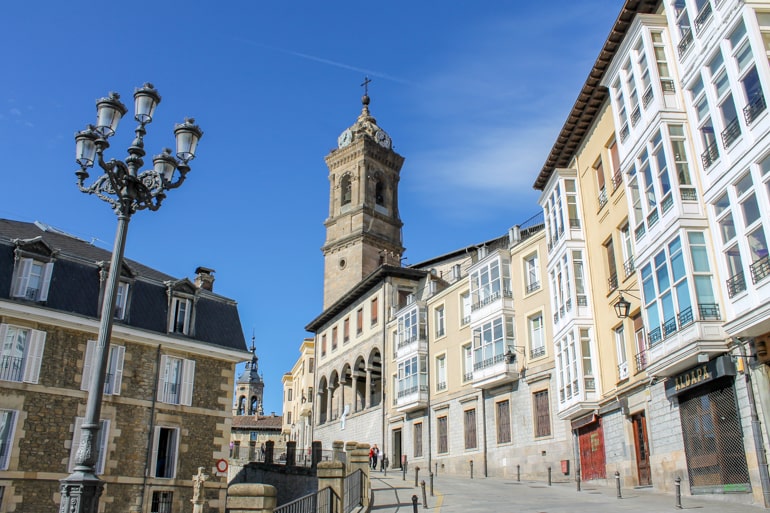
To give you the chance to see a bit more of the region we recommend a day trip to either Santander or Vitoria-Gasteiz, the capital of the Basque Country.
Alternatively, you can also opt to spend the day at the beach if the weather is nice (more on that below!) or use the time to see more of Bilbao.
Getting to Santander from Bilbao takes approximately 1 hr 15 min by car and 1.5 hrs by bus . The journey to Vitoria-Gasteiz is slightly shorter, taking approximately 1 hr by car and the same amount of time by bus .
Must-see Attractions in Santander:
- Palacio de la Magdalena
- Centro Botin
- Sardinero Beach
Must-see Attractions in Vitoria-Gasteiz:
- Catedral de Santa María
- Iglesia de San Miguel
If you opt for a beach day instead, we would recommend Sopelana beach. It is easy to reach by metro. Just take the line no 1 in the direction of Plentzia and get off at the Sopelana stop.
From there you can either walk or take the bus to the beach. It’s Lisa’s favourite beach in the Bilbao area since it looks beautiful and is not too crowded. It’s also a great stop to try some surfing.
Day 3: Donostia-San Sebastián
The next stop on your 14-day Spain itinerary is San Sebastián – a city we have already mentioned before. Beautiful beaches and delicious pintxos await you!
The drive from Bilbao to San Sebastián takes around 1 hr 15 min by car and 1.5 hrs by bus . There are very frequent buses by lots of different operators between these two cities.
Accommodation in San Sebastián : San Sebastián is one of the more expensive towns in Spain. It’s also very popular among luxury travellers. So, don’t be surprised if accommodations seem a little more expensive overall.
Specifically, check out Casual de las Olas San Sebastián . This hotel is a bit further from the old town and beach but makes up for it with sleek decor, breakfast, and air conditioning.
If you want more of a laid-back feel, check out Talaia HT . This authentic and cozy guesthouse is located in the heart of the old town – and has public parking nearby .
If you are looking for a hostel, you can find hostels across San Sebastián here . Wherever you book, our advice is to book accommodations early. Generally, you save money when doing that.
Day 4: Zaragoza
Day 5 of this itinerary will take you to Zaragoza, a city mentioned in the 5 day Northern Spain itinerary. The drive will be a bit longer but you’ll still have enough time to check out some of the attractions Zaragoza has to offer.
Driving from San Sebastián to Zaragoza will take approximately 2 hrs 45 min by car (including a toll road) and around 4 hrs by bus .
Accommodations in Zaragoza: Zaragoza is a smaller city but there are still lots of really great accommodation options.
Specifically, check out Hotel Sauce . This bright hotel is located right in the city centre and has buffet breakfast, air conditioning, and private parking onsite for those with a car in Spain!
If you want a hotel with a rooftop pool, Hotel Palafox is for you! Also situated right in the heart of the city, the hotel has a unique decor, city views, a nice breakfast, and also has parking and air con!
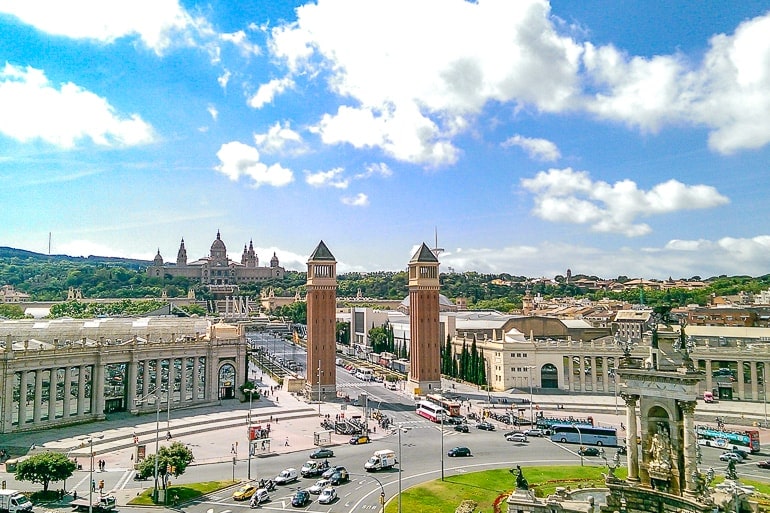
A tour across the country wouldn’t be complete without including Barcelona. Since there is so much to see you’ll be spending two nights in the city to give you enough time.
The drive from Zaragoza to Barcelona will take you approximately 3 hrs 10 min by car (includes a toll road), 3.5 hrs by bus and 1.5 hrs by train .
Accommodation in Barcelona : As mentioned above, you’ll find loads of great hotels and apartments in Barcelona.
If you are looking for a hotel, check out Catalonia Born Hotel with a boutique style and rooftop pool in the city centre (also close to the beach).
If you travel by car, Sallés Hotel Pere IV is a lovely and affordable hotel with a spa that is located in the heart of the city and has a private parking garage onsite .
As for hostels, you can check out Barcelona hostels here. Specifically, we enjoyed Kabul Hostel . Hostel or hotel – just remember to book early because Barcelona is a popular city. Also remember that for this itinerary, you’ll be staying over for two nights .
And we’re back in one of Lisa’s favourite cities. The drive from Barcelona to Valencia will be a bit longer but it is worth it (in our opinion at least).
Driving from Barcelona to Valencia will take around 3.5 hrs by car (including a toll road), 3 hrs by train and 4 hrs 15 min by bus .
Accommodation in Valencia: Since Valencia is a bigger city, you’ll find accommodations that work for your style and budget.
Check now for hotels in Valencia .
Specifically, Petit Palace Ruzafa is a boutique hotel very much in the lovely city centre. They offer healthy breakfast, free bike rentals, and no parking – making it great for travellers without a car!
If you’re looking to stay right the beach, you’ll likely love Hotel Miramar . This cool beachfront hotel has a bar/restaurant right downstairs, ocean views, and has paid parking onsite . If you want to stay in a hostel, you can check now for hostels in Valencia .
Must-see Attractions in Valencia:
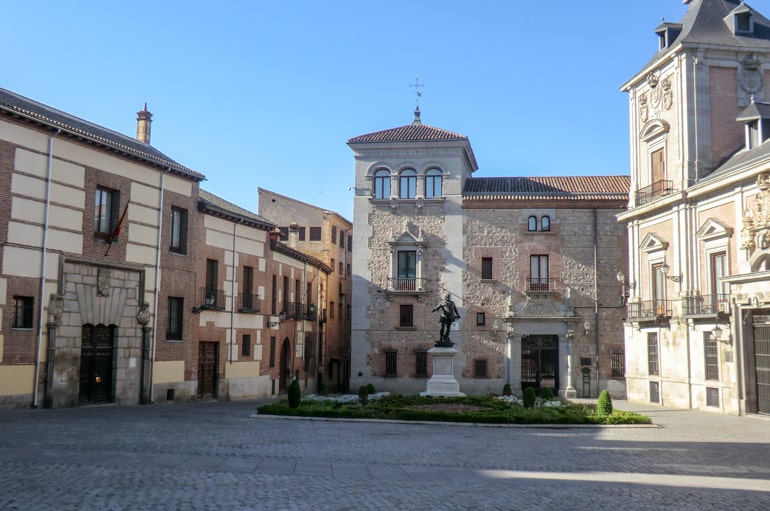
Of course, you can’t forget about the capital of the country when going on a trip through Spain.
Since there is so much to see and do you will spend two nights in Madrid. This will also give you some time to recover from the long driving days you’ve had.
Driving from Valencia to Madrid takes approximately 3.5 hrs by car and slightly less than 2 hrs by train .
Accommodation in Madrid : Being the capital city of Spain, Madrid is a popular city with lots of accommodations.
Keep in mind that Madrid has “hostals” which are technically guesthouses but are basically hotels. Also, parking can be very expensive per day but that’s just Madrid for you.
Specifically, check out Room007 Select Sol . This charming and trendy hotel is right in the heart of the city, has air conditioning, and serves breakfast at a cafe next door. You are very much in the city centre here!
If you are looking for more of a guesthouse stay right in the centre, check out Hostal Madrid .
This authentic accommodation is so centrally located with attractions and the metro close by. It’s good value for money – the two times Lisa travelled to Madrid she actually stayed here both times!
Should you want an actual hostel, there are loads of hostels in Madrid. You can check here for hostels in Madrid . Keep in mind wherever you book, you will be booking this accommodation for two nights if you are following this itinerary.
*We have written in-depth about many of the attractions you can visit in Madrid in our things to do in Madrid guide!
Day 10: Toledo or Córdoba
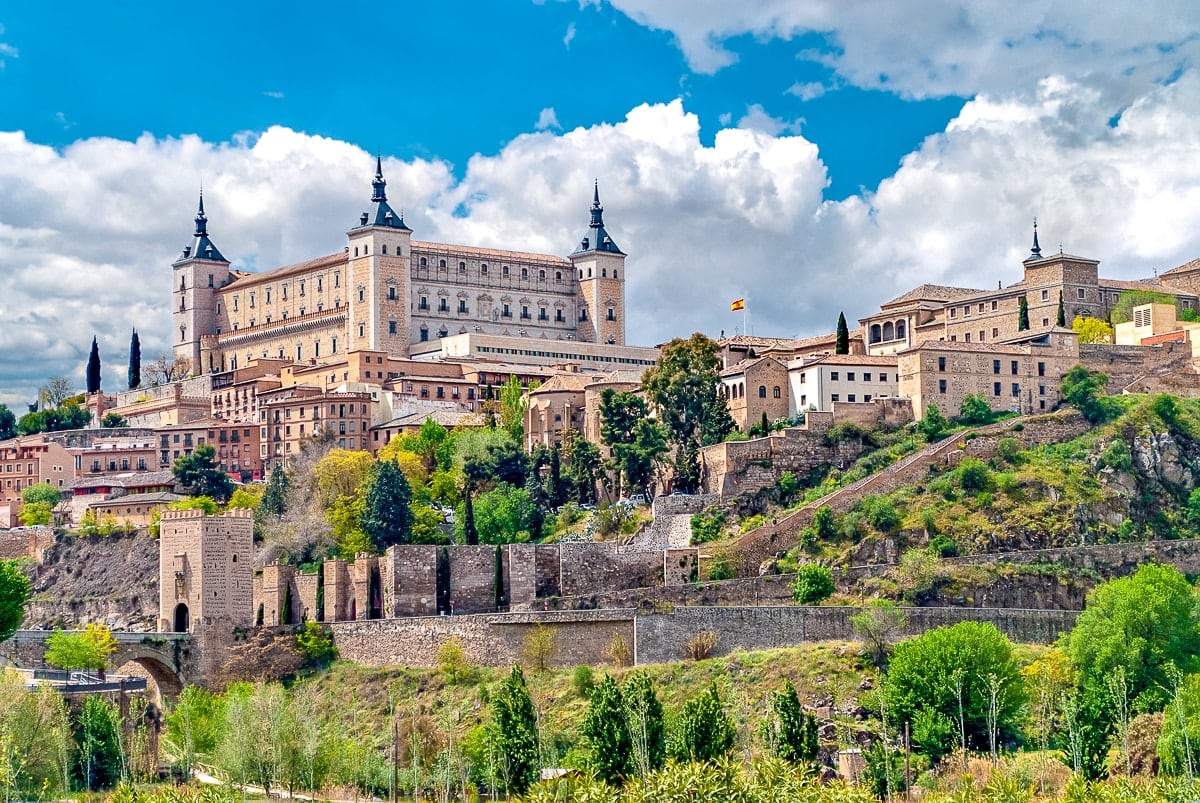
For the next stop on your itinerary, you can decide where you would like to stop. From Madrid you are driving further south and both Toledo and Córdoba would be great options for a stop on the way to Seville.
The drive from Madrid to Toledo will be short and only take an hour by car or bus . The drive from Madrid to Córdoba is a lot longer and takes approximately 4 hrs by car and 2 hrs by train .
While this drive would be longer, your drive the next day would be significantly shorter from Córdoba than from Toledo.
Accommodation in Toledo: If you choose to stay in Toledo, you can check here for hotels in Toledo .
Specifically, you have to check out Hotel Santa Isabel – an authentic and charming Spanish hotel in the heart of the city with an incredible rooftop terrace, good breakfast, and private parking under the hotel if you need it.
Accommodations in Córdoba: If you end up in Córdoba, you can check now for hotels in Córdoba .
Specifically, Maciá Alfaros is an authentic hotel located right in the heart of the city with a nice swimming pool and parking onsite.
Hotel Cordoba Center is an elegant hotel located just a short walk to the centre. It’s location is very close to the train station – and there is a lovely rooftop pool with city views!
There are also many hostels with very good ratings so you can check here for hostels in Córdoba .
On day 11 you will drive from either Toledo or Córdoba to Seville – a city we have mentioned multiple times now because it is very much worth the visit.
If you ended up staying in Toledo, it’ll take you 4.5 hrs by car and 4 hrs by train to get to Seville. If you stayed in Córdoba it’ll only take you 1.5 hrs by car and 45 min by train to get to Seville.
Accommodation in Seville : As we have mentioned above a bunch of times, Seville is a big and popular city so you’ll have no shortage of accommodations to pick from.
Check here for hotels in Seville .
Specifically, we like the look of Petit Palace Puerta de Triana . It’s a trendy design hotel with a buffet breakfast located right in the city centre close to top sights!
If you want more of a “historic stay”, Hotel Simon is a simple and authentic hotel located in a historic building!
They also do breakfast and are also located in the city centre. So you know: neither of the above hotels have parking – but not that many hotels in the city centre offer onsite parking (or even nearby public parking).
If you have/rent a car and need parking available, we’d say check out La Parada del Marqués . It’s a beautiful guesthouse/hotel also quite conveniently located but they also have parking, breakfast options, and good connections to public transit!
Should you be looking for a hostel, you can search for hostels in Seville here .
Again, since Seville is very popular so we would advise booking any accommodations ahead of time – especially during the high season! Remember, you’ll stay for two nights if you follow this itinerary!
Day 12: Seville or Day trip to Cádiz/ Gibraltar

Since there is a lot to see and do in Seville, you have the option to stay another day to explore more of what the city has to offer.
If you’d prefer to see a different place you can consider day trips to either Cádiz or Gibraltar. Know that Gibraltar is not officially part of Spain but belongs to the United Kingdom instead.
It’ll take you around 1.5 hrs by car or train to get from Seville to Cádiz. To get from Seville to Gibraltar it’ll take between 2 and 3 hrs by car .
There does not seem to be any public transport between Seville and Gibraltar since it is another country, but you can participate in an organized tour from Seville to Gibraltar .
Must-see Attractions in Gibraltar:
- Rock of Gibraltar
- Great Siege Tunnels
- The Old Town
Day 13: Málaga (or Granada)
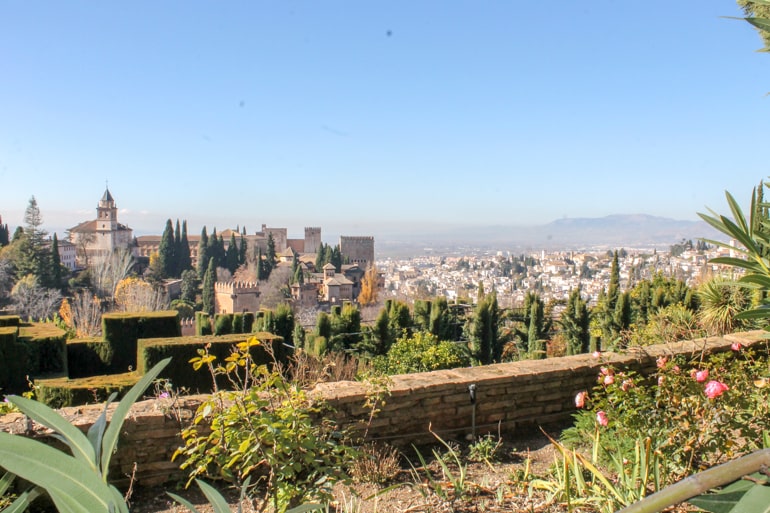
On your second to last day of this itinerary, you will drive from Seville to Málaga, a route we have mentioned quite a few times by now up above.
If you really wanted to visit Granada you could also drive there instead. You could then make the trip to Málaga at the end of the day or the next day.
The journey from Seville to Málaga will be approximately 2.5 hrs by car and 2 hrs by train. Whatever city combo you choose, just remember to book the right amount of nights in cities (one or two) for the end of your itinerary (keeping in mind where you fly out)!
Accommodation in Málaga: As a popular city in the south, Malaga has lots of places to choose from when it comes to accommodation options.
For hotels, have a look at Hotel Boutique Teatro Romano . This lovely design hotel offers breakfast – and it’s very centrally located in the heart of the city!
For an apartment rental (maybe for a longer stay), check out Apartamentos Nono . Located close to the beach and a quick walk to the city centre, the apartments have kitchenettes, terraces, and private parking onsite (if you travelling by car).
Malaga also has lots of hostels if you like. You can search for hostels in Malaga here . Lisa stayed at Casa Al Sur Terraza when travelling to Malaga with a friend.
For a “hostel”, the Casa is a very popular place to stay with private rooms and a sunny rooftop terrace. Lisa and her friend booked a private room and enjoyed it!
Accommodation in Granada: Since Granada is popular, many accommodations are available.
Specifically, Hotel Granada Center is a VERY popular hotel with a great breakfast, a very central location, and private underground parking onsite if you have a car.
Also situated in the city centre is Granada Five Senses Rooms & Suites – a modern hotel with a small rooftop pool with views of Granada’s old town! If you want to book a hostel, you can check here for hostels in Granada .
Day 14: Málaga
And this is the end of your two weeks Spain itinerary. Once again Málaga is the city you fly out of since there are lots of great flight connections to other places in Europe.
Alternatively, you could also stay in Seville and visit Málaga on a day trip if the airport in Seville works better for you.
Things to Consider When Travelling in Spain
Before you dive into Spain trip planning, you’ll want to consider a few details. From the currency they use (the Euro) to the weather, public transport, and the best time to visit, we cover a few key areas below to help you prepare.
Best Time of Year to Visit Spain
Spain is a destination that can be visited year-round – you just have to set your expectations right. Lisa visited Malaga with a friend in December and it was quite warm but of course not warm enough to go swimming.
Since the country is quite big and has a diverse geography, there are actually a lot of different climate zones in Spain. Generally, the summers are hot and dry while the winters are mild and quite rainy.
The average maximum temperature for July and August is 30 °C and 17/16 °C in December and January. However, this can vary greatly depending on which city you are visiting (e.g. Granada is always a little bit colder).
We would recommend that you avoid the south – especially Seville – and Madrid in July and August since it can get VERY hot.
And according to Lisa’s Spanish teacher in Bilbao, it would probably also be a good idea to avoid visiting the Basque country during the winter months since it can rain a lot.
In our opinion, the perfect months for visiting Spain would be from March to June and September to the end of October.
Public Transportation in Spain
Spain has a very well-developed long-distance bus system. Lisa was especially impressed by that since in Germany long-distance buses didn’t exist until a few years ago and sometimes it can still be a bit chaotic or unclear.
In Spain, almost every major city has an actual bus station (and not just a signpost). One of the biggest bus companies in Spain is Alsa .
Lisa has used them quite a few times when living in Spain (to go from Madrid to Bilbao for example) and always had a pleasant experience.
In addition to buses, Spain also has a pretty good rail system. You can check the train connections and prices on the RENFE website here .
We would recommend that you always check both buses and trains as sometimes they take approximately the same amount of time and the bus can be significantly cheaper.
In a few areas (such as parts of the Basque country), the buses can be actually a lot faster than the train.
You can reach all of the places mentioned in these Spain itineraries with public transport.
So if you don’t feel comfortable with renting a car in a foreign country you can still follow all of these itineraries. The bus and train stations are often very centrally located so it shouldn’t be a hassle to get into the centre in any of the cities.
Car Rental in Spain
If you would like to rent a car and make these itineraries a road trip that is a great option, too.
Driving in Spain is generally pretty safe – but it can get a little crazy in bigger cities like Barcelona or Madrid. Spaniards also like to speed – but if you are a confident yet careful driver then this shouldn’t be an issue.
Since Spain is such a popular destination, there are lots of different rental car agencies available. Make sure to read the fine print about additional costs in case there are any issues.
You can compare prices for your Spain trip with this handy comparison tool .
In Spain, there are quite a few toll roads which start with an ‘AP’ in the name. If you want to avoid paying tolls you can often find a road that runs in a similar direction.
Generally, your driving time will be longer if you avoid toll roads but you never know which hidden gems you come across on your way.
Travel Insurance for Spain
When visiting Spain you – and especially when renting a car – should get travel insurance.
While you’ll probably be fine, accidents do happen (and Spaniards are more reckless drivers than in other countries) and they can be expensive. That’s why we always travel with insurance.
If you live in a European country and have European health insurance, you can get the blue EU Health insurance card with which you are covered in emergencies. If you don’t have that option, we recommend that you get private travel insurance.
Related Posts
If you are planning your visit to Spain, check out our other posts on travelling, working, and studying in Spain!
- 12 Need to Knows When Travelling to Spain for the First Time
- 11 of The Most Beautiful Cities in Spain
- 17 of the Top Attractions in all of Spain
- Catalonia Road Trip Itineraries
And there you have it – 5 epic itineraries around Spain! Whether you need 5 days or 14, we think you’ll have lots to work with to plan that perfect trip. Lisa is so happy to be able to provide you with her knowledge of the country.
There is still so much to cover – but we think that these itineraries are a great starting point – you may even do the routes as is and see how they go!
As always, Happy Waddlin’, – L&E
- Compare flights on Skyscanner
- Check for Hotel Deals or Book A Hostel
- Get A Rental Car (depending on the destination)
- Research plug types and possibly get a travel adapter
- Go over our packing list
Pin it for later!

As an Amazon Associate we earn from qualifying purchases.
Destinations
Privacy policy
Disclaimer & Affiliate Disclosure
Terms of use
© 2024 Creativlier Media Inc.

3 Weeks In Spain Itinerary
DISCLAIMER: This post might have links to travel services and products that we enjoy. We might make a commission from it at no extra cost to you.
Popularly known as one of the most visited countries in Europe, Spain offers its annual 82 million tourists with all grace and satisfaction. Evidently, the number of tourist arrivals in Spain just keeps growing every year with people who are keen to visit beaches, go hiking, explore ancient towns, and try out local dishes.
So, what is your reason for visiting Spain? Is it to treat yourself to local Spanish cuisine? Or perhaps to experience its rich history and culture through its beautiful architecture? Or maybe you want to experience its natural beauty and the Mediterranean coastline? The good news is – Spain has all these.
Travelling to Spain for an extended time is recommended. There are so many things to see or do throughout your tour.
This itinerary for 3 weeks in Spain should be enough to cover the best that Spain has to offer, especially for first-time visitors. We have prepared this itinerary to plan your trip seamlessly and conveniently.
If you want to visit other countries in this region, check out our 3 weeks in South Europe itinerary or do a trio adventure and go to Italy, France, and Spain for 3 weeks .
THINGS TO KNOW BEFORE GOING TO SPAIN
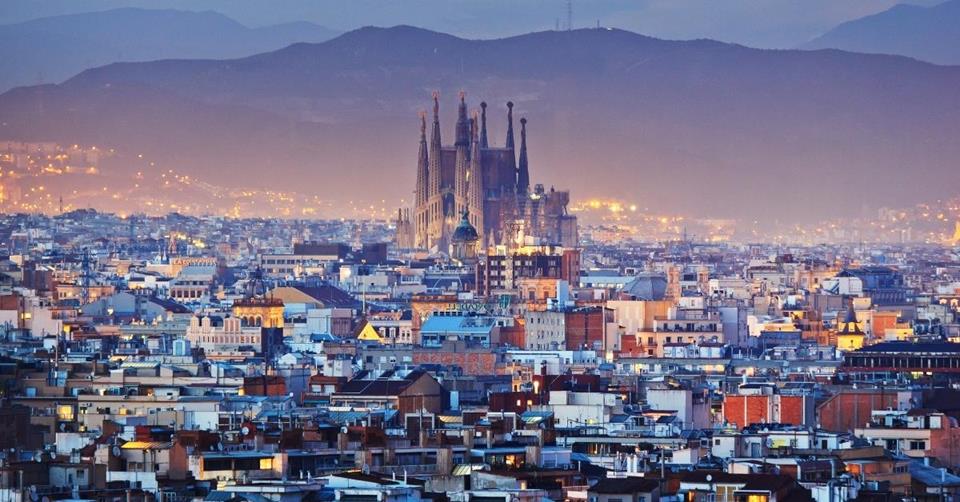
When you travel to Spain, it is important to learn basic Spanish phrases to make communication easier. Some can speak English, but some may not know the language at all. It is also important to know that drinking directly from the tap is safe. And tipping isn’t a big deal, so you are not required to leave a tip unless you are thrilled with the service.
As with any major tourist destination, pickpocketing can be an issue. Make sure you keep an eye on your belongings at all times. If it’s your first time travelling alone, check out our article on how to stay safe if you are travelling solo .
Here are more tips so you can better plan and write your 3-week itinerary . These tips will help you visualise and start having clarity on what your vacation will look like.
When is the best time to go to Spain
Choosing the best time to visit Spain can be a challenge since it is a great year-round destination. You generally decide the best time to go according to what you want to see or do. Each season offers a uniquely enjoyable experience, so you need to plan accordingly.
Spring (March to May) and fall (September to November) are the best times to go. This will provide you with good weather to enjoy the natural beauty and scenery of the country.
You can also expect fewer crowds (compared to winter and summer). And with fewer crowds, you can expect to find cheaper accommodations than when you book at other times of the year.
- Peak/summer season: June to August
- Heavy rains between September to January
- Winter season: December to February
One major holiday to remember when deciding when to go to Spain is Holy Week. During La Semana Santa , not only many businesses are closed, and locals not working, but there are parades and events surrounding this public holiday.
Make sure to book your hotel and other arrangements in advance if you plan to go during the Holy Week because it’s a peak season and last-minute booking will be expensive and challenging.
Are 3 weeks enough for Spain
3 weeks in Spain is perfect. You can visit historical sites, the beach, and even go for a hike or two. The country is also well-connected with flights and buses or trains, making travelling between cities or islands much easier. 20 days is plenty, and you won’t run out of things to do or feel like you have to cram everything and are always on the go.
If you’ve ever been to Spain or if you’re travelling here with your family and looking for something unique place to go to and spend your three weeks, perhaps this list of the best Spanish islands for families can be helpful. You can choose between popular spots and a tranquil peninsula to enjoy a peaceful atmosphere.
Average cost of 20 days in Spain
Plan to spend around $2,000 for a 3-week trip in Spain if you prefer to stay in a mid-range hotel and eat often. Accommodation costs you the most during your trip, around $40-$60 a night for a decent double room. Eating out in a m id-range restaurant will be about $7 to $12 per meal .
For those who want to t ravel more budget-wise, $1,200 could do it by staying in dorm rooms and eating street food most of the time. If your hostel has a kitchen, that could also cut costs. For l uxury spenders, around $3,500 will be an excellent budget if you plan to book five-star hotels and fancier restaurants.
These numbers don’t include your flight to and from Spain and are calculated for one person. For couples or a pair of friends travelling, you could save some money by sharing a double room.
What to pack
Knowing what to pack for Spain will depend on what time of the year you want to go. The country enjoys a Mediterranean climate, meaning the winters are mild with some rain, while the summers are hot and dry. When you visit during the summer, opt for casual and lightweight clothes to keep you cool.
It can get quite cold during winter in Spain, skiing is even possible here in the parts of the Pyrenees region. It is important to pack lightweight layering items such as cardigans and sweaters. The winters are not harsh, but it can get chilly at night.
We have a series of packing lists. Check out our packing for a 3-week trip . We also have a summer trip packing list , and of course, a packing list for winter .
How to get around
Getting around Spain is relatively easy. The best way to travel from one Spanish city or town to another is by train, especially while you are on the mainland. The high-speed train is called AVE(Alta Velocidad), a convenient way to travel between cities.
You can also rent a car and drive on your own since Spain has a pretty straightforward policy regarding recognising international driver’s licenses. However, remember that most vehicles in Spain are programmed with a stick (aka manual gear). You can, of course, find automatic cars, but they get booked up quickly.
Buses are also easy and cheaper but can be slower, while traditional taxis are everywhere. The use of ride-hailing apps is also common, and domestic flights will come in handy when moving between islands.
Spain has the same visa policy in place as any other Schengen State member (EU). This means that visitors with passports from most parts of the Americas, Oceania, Malaysia, Singapore, South Korea, Japan, and some parts of the Middle East can enter and travel around Europe for 90 days in every 180-day calendar.
US Citizens can travel to Spain for leisure or business purposes without a visa with a maximum stay of 90 days. The only requirement is that your passport must be valid for 6 months (during the time of travel). Also, it must have at least one blank page.
In some cases, a return airline ticket and enough funds are required. Aside from US citizens, the following passport holders do NOT need a visa to travel to Spain: Members of the European Union, Switzerland, Iceland, Norway, Canada, most parts of Latin America, Japan, South Korea, Malaysia, Singapore, New Zealand, Australia, and some regions of the Gulf countries and Central Asia.
For others not mentioned, the visa must be applied in advance. You could submit your application as early as 6 months in advance.
Travellers with passports from EU-member or part of Schengen States have indefinitely freedom of movement in Spain. Other passport holders must arrange their travel visa for Schengen through the Spanish Embassy or Consulate near you.
Package tours
Sometimes planning is overwhelming, and you really want a vacation where you can simply show up at the airport, and the fun begins. In that situation, I love booking package tours. In such tours, the travel agency book and arrange everything for you. This includes accommodations, activities, restaurants, transportation, and a knowledgeable guide.
Below is a list of exciting tours for 15 to 22 days. Let’s say you have 20 days of vacation, and you want to be easy but leave you time to do your own thing. Go book the 15 days, then you have 5 days of exploring on your own.
Other travel tips
Booking your travel arrangements can be overwhelming. There are simply too many options, and comparing them to one another is a daunting and time-consuming task. I was planning my Central Europe itinerary last night, and it is just a few minutes to book the accommodation I want and the flights I need.
I was also able to make a decision quickly because I know that some of the travel sites I use offer a flexible cancellation policy. Here’s a list of the websites and tools I use for any travel-related services. Perhaps, you might find them helpful and easy to use as well.
MUST-SEE PLACES IN SPAIN (pinned map)
Click the enlarge button on the top right corner. Credit: map data: Google
3 WEEKS IN SPAIN ITINERARY
Spain is home to many beautiful cities and towns that are worth exploring for various reasons. Whether you want to enjoy culture, nature, or history, you will be spoiled for options. Use this guide, so you know what to see or do for each destination in Spain.
If you enjoy your trip to Spain, perhaps you want to spend 3 weeks in Italy next time or a trip to France . For people on a budget, here’s our list of how to travel to Europe in 3 weeks on a budget .
Day-to-day overview
- Day 1 : Arrive in Barcelona. Arrange a private transfer to your hotel or take the airport shuttle bus . Pick up your rental car here at the airport if you plan to drive yourself. Get yourself a local sim card with data and local currency.
- Day 2-3 : Explore Barcelona and plan some day trips, get the Hola card for public transport .
- Day 4: Travel from Barcelona to Valencia by bus , train , plane, or drive.
- Day 5-7 : Discover Valencia, and don’t forget to enjoy the beach.
- Day 8 : Travel from Valencia to Madrid by bus , drive, train , or plane .
- Day 9 to 11 : Explore Madrid and plan some day trips from here.
- Day 12 : Get to Seville from Madrid by train , plane, bus , or drive.
- Day 13 to 14 : Discover Seville, and make sure to go to a flamenco bar.
- Day 15 : Travel to Malaga or Granada, which is around 2 hours by driving or 2.5 hours by bus ( Malaga / Granada ).
- Day 15-17 : Explore Granada or Malaga.
- Day 18 : Fly to Tenerife or Gran Canaria or Ibiza.
- Day 18-21 : Enjoy the island life and plan some relaxing days.
Barcelona for 4 days
Barcelona is probably the most popular city visited by tourists in Spain. It is known for its iconic architecture and beautiful Mediterranean location. It is rich in culture with a wide array of the iconic architect Gaudi’s works to explore. Barcelona is an ideal destination to start your 3 weeks in Spain trip, especially if you want to kick it off by relaxing on the beach and soaking up in the Mediterranean Sea.
Getting to Spain is very easy, there are two main destinations you can plan to start your trip – Barcelona and Madrid. Barcelona is as famous as Madrid, with non-stop flights from various cities in the US and Canada to Barcelona via American Airlines, Delta Airlines, Lufthansa, or Air Canada. The Josep Tarradellas Barcelona-El Prat International Airport in Barcelona is the central hub of flights and the second busiest airport in Spain.
Things to do in Barcelona
- Get a public transport pass – look at the price
- Mount Tibidabo
- Barceloneta Beach
- Basilica de la Sagrada Familia – skip the online and explore with an audio guide or combine with Parc Guell
- Barcelona Aquarium – suitable for young children, buy your ticket in advance
- Palau de la Musica Catalana
- Park Güell- get your ticket in advance , there’s a limit per day ticket sold for Parc Guell
- Casa Batllo
- Enjoy tapas and wine – book a walking tour
- Bogatell Beach/Playa de Bogatell
- Magic Fountain of Montjuic – ride a round-trip cable car
- Museo Picasso de Barcelona
- Explore Montserrate – join a half-day tour
- Trio-day trip and cover Spain, France, and Andorra – check the itinerary
- Walk around Barri Gotic
- Go kayaking and snorkelling in Costa Brava – book an affordable tour
Accommodations in Barcelona
- Affordable: Unite Hostel or Factory Hostel
- Mid-range: Sixties Ramblas or Violeta Boutique
- Luxury: Vincci Gala or Ohla Barcelona or ME Barcelona
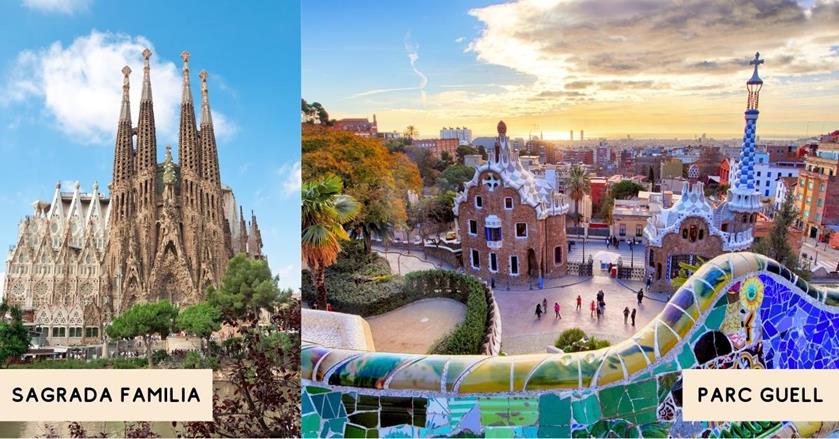
Valencia for 3 days
Best known as the home of paella, Valencia is the home of luscious Spanish dishes. But aside from introducing the world to this culinary delight, there are more reasons to visit Valencia in Spain. Valencia is another Spanish coastal town 348 km (216 miles) south of Barcelona.
Taking a stroll through its old town will enable you to marvel at the colonial architecture. But Valencia is also home to many futuristic architectural features, such as the world-famous Valencia City of Arts and Sciences. Spending 3 days in Valencia is plenty, although 2 days is possible if you want to add that one day to another city.
To get to Valencia from Barcelona, you can either drive your rented car for 3 hours and 40 minutes or take the train , the journey is around 3 hours or by bus is about 4 hours. You can also book a direct 1-hour flight.
The best way to get around Valencia is by using public transportation. You can also rent a bicycle or buy yourself this useful hop-on hop-off bus ticket which stops at major attractions in Valencia.
Things to do in Valencia
- La Lonja de la Seda
- Oceanografic – perfect for young children, get your entrance ticket
- Albufera Natural Park
- La Ciutat de les Artes i les Ciencies de Valencia
- Cuevas de San Jose – sign up for a half-day guide tour
- Mercado Central
- Plaza de la Virgen
- Hike and swim at Montanejos – book a group tour
- Bioparc Valencia
- Torres de Serranos
- Playa del Saler
- Sail on a Catamaran Cruise – check the tour price
- The medieval town of Requena
- Enjoy wine and tapas tasting in an 11th-century historical monument – check this trip
- Join a cooking class
Accommodations in Valencia
- Affordable: Hostal Antigua Morellana or Colors Rooms
- Mid-range: Ad Hoc Carmen or Venecia Plaza Centro
- Luxury: Vincci Lys or Petit Palace Plaza de la Reina
Madrid for 4 days
3 weeks in Spain without visiting its capital is incomplete especially if it’s your first time here. Madrid is the artistic centre of Spain. Proof of that is the concentration of art galleries located in various parts of the city that showcase the works of Picasso and Velazquez. It is also home to a wide range of vibrant neighbourhoods that offer the best tapas and pubs to check out at night.
Madrid is located right in the centre of Spain, about 346 km (215 miles) northwest of Valencia. There are a few ways to get to Madrid from Valencia. You can book a direct 2-hour flight from Valencia Airport to Adolfo Suárez Madrid-Barajas Airport. You can also get to Madrid by train from Valencia with Avlo in 2 hours or by car, which takes nearly 4 hours.
Once you get to Madrid, you can easily move around on foot and use public transport. If you prefer a more convenient way to travel around, a push bike might be more suitable for you or you get a hop-on hop-off bus ticket with stops at the most popular attractions.
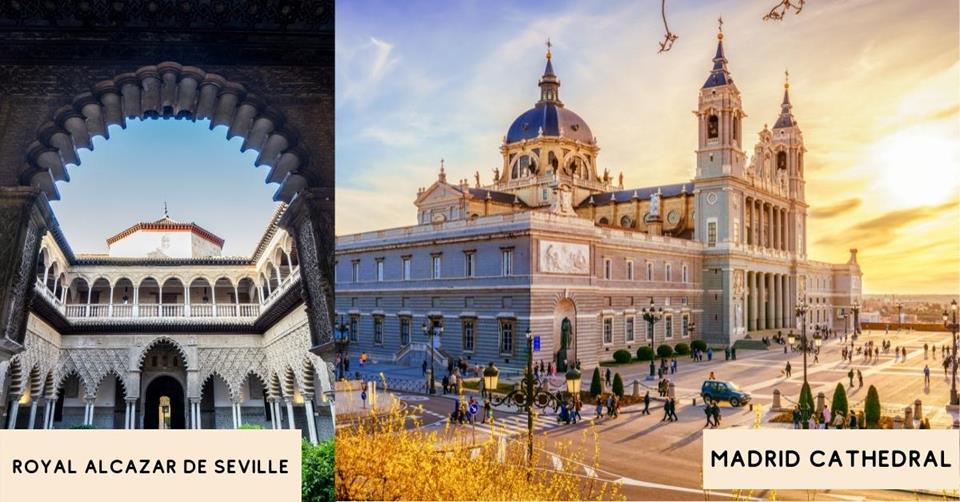
Things to do in Madrid
- Royal Palace – get your fast-access ticket
- Plaza Mayor
- Museo Nacional del Prado – purchase your ticket in advance
- Parque Natural de Peñalara and Sierra de Guadarrama National Park
- Visit Real Madrid’s Stadium (Santiago Bernabéu Stadium) – join a Bernabeu Stadium tour
- Buen Retiro Park and the Crystal Palace
- Puerta del Sol
- Fuente de Cibeles and Gran Via
- Temple of Debod
- Basilica de San Francisco el Grande
- Enjoy wine and tapas tasting – join a group tour
- Puerta de Alcala
- Watch a flamenco show with dinner
- National Museum of Romanticism
- Day trip to Avila and Segovia and visit historical sites or go to Toledo with a local guide
Accommodations in Madrid
- Affordable: Olblanc Plaza de Espana or Hostal Arrate
- Mid-range: II Castilla Madrid or Hotel Liabeny
- Luxury: Pestana CR7 Gran via Madrid or Palacio de Atocha
Seville for 3 days
Located within the province of Andalusia in Spain, Seville is best known for its flamenco culture. You can find plenty of flamenco bars in town. You can also visit many historical landmarks and museums to glimpse the town’s past.
The architectural landscape of Seville offers a mix of the old and the new, creating a beautiful contrast in the cityscape. If you prefer to see this region of Spain, perhaps a Southern Spain road trip would be an ideal adventure for you.
Seville is 532 km (330 miles) south of Madrid. You can book a direct train between Madrid and Seville called Renfre/AVE. The trip will take a little offer of 2.5 hours, you can also drive, which is about a little over 5 hours. A direct flight will take about an hour from Adolfo Suárez Madrid–Barajas Airport (MAD) to Seville Airport (SVQ).
Things to do in Seville
- Royal Alcazar of Seville
- Catedral de Seville
- Punta Umbria Beach
- Cascadas del Hueznar
- Real Alcazar
- Parque de Maria Luisa and Plaza de Espana
- Barrio de Santa Cruz
- Museo del Baile Flamenco
- Real Maestranza de Caballeria de Sevilla
- Palacio de la Condesa de Lebrija
- Metropol Parasol
- Torro del Oro
Accommodations in Seville
You can also check this list of best boutique hotels in Seville with swimming pools.
- Affordable: Hostel A2C or Pension Javier
- Mid-range: Hotel Casona de San Andreas or Cool Sevilla Hotel
- Luxury: Hotel Rey Alfonos X or Hotel Dona Maria
Granada or Malaga for 3 days
The city of Granada is like a Disney fairy tale that came to life. It is filled with cobblestone streets, snow-capped mountains, and enchanting fortresses. It is also notable for the abundance of Islamic art and architecture.
Granada’s excellent and unique identity sets it apart from many other Spanish cities. For this reason, the destination makes it a worthy addition to your 3-week itinerary in Spain. This city is known for its “free tapas” culture if you love tapas. If you sit in any restaurant, bar, or visit someone’s home, there are free tapas for everyone.
On the other hand, Malaga is another seaside city in the south of Spain. There are spectacular beaches, historical monuments, and varied museums. Pablo Picasso was from Malaga, when you explore the city, you’ll definitely see how proud this city of him is through displaying his art.
Both Granada and Malaga are on the east of Seville. Malaga is 205 km (127 miles) southeast of Seville, while Granada is 250 km (155 miles) east of Seville. A car will only take 2.5 hours to reach Granada from Seville and 2 hours to Malaga. There are direct trains to both cities from Seville but no direct flights to both cities.
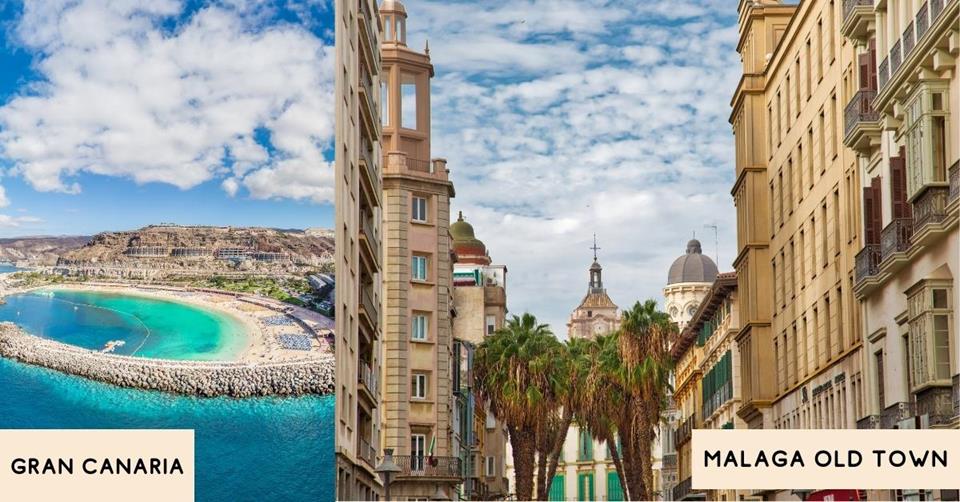
Things to do in Malaga and Granada
Since Granada and Malaga are not too far, you can easily plan day trips from both cities. You can also explore Malaga’s must-see spots on a 2-hour segway guided tour .
- Alhambra (G)
- Sacromonte (G)
- Alhambra (G) – check the tour price or do a day trip from Malaga
- Nasrid Palaces (G)
- Enjoy a flamenco show in a cave restaurant – book your table
- Salobreña Beach
- Sierra Nevada National Park
- Alcazaba de Malaga
- Torre Vigía De Cerro Gordo – sign up for a snorkelling and kayak tour
- Malaga Old Town/Marbella Urban Wall
- Boat trip to Paseo de Los Delfine – check the price
- Jardin Botanico-Historico la Concepcion
- Caminito del Rey – book a guided tour to cross the suspension bridge
- Playa de la Malagueta
- Museo Picasso Malaga – get your ticket with an audio guide tour
- Centre Pompidou Malaga
- Do tapas tasting – join a walking tour
- Festival de Malaga
- Day trip to Gibraltar – book a day trip including a St Michael Caves visit
Accommodations in Malaga
- Affordable: COEO Pod Hostel or Hotel Zeus
- Mid-range: Petit Palace Plaza Malaga or Be Mate Malaga Centro
- Luxury: Soho Boutique Castillo de Santa Catalina or Vincci Seleccion Posada del Patio
Accommodations in Granada
- Affordable: Urban Dream Nevada or Pension Venecia Gomerez
- Mid-range: Nest Flats Granada or Room Mate Leo
- Luxury: Candil Suite Origen or Hospes Palacio de Los Patos or Palacete (adults only)
Tenerife or Gran Canaria or Ibiza for 3 days
The best way to finish off your 3 weeks in Spain vacation is by visiting its most fabulous and beautiful islands in the northern part of Africa. West of the Sahara desert is the islands of Tenerife and Gran Canaria. Apart from magnificent beaches, these two islands also offer the best hikes in Spain and vibrant nightlife.
As one of the most popular destinations for holidaymakers in Spain, Tenerife is located in the Canary Islands. It is well-known for its natural beauty. The most notable feature of Tenerife is its volcanic peaks that create lunar landscapes and otherworldly natural features. It is also home to some of the country’s most unique geological gems.
However, Tenerife is a big island for a limited time. So, it’s best to decide which part you prefer. Whether it’s Tenerife North or South, either should work since both have their own airport to get in and out back to mainland Europe.
Gran Canaria, on the other hand, is a fantastic location for water sports and exploring nature, and it’s one of the most LGBTQ+-friendly across all of Europe. Spend your day either doing active sports or simply lying on the beach, enjoying a book, and drinking fresh coconuts.
Ibiza is not in the Canary Islands; it’s located east of Valencia. It’s well-known that Ibiza is an exciting destination when it comes to nightlife and all-night rave parties. It’s very suitable for young travellers and everyone who enjoys parties and delicious cocktails. If you just want a quick peek at Ibiza, you can also simply book a trip when you are in Valencia.
Getting to Gran Canaria or Tenerife
Tenerife has 2 major airports, Tenerife North (TFN) and Tenerife South (TFS). You should be able to get on a direct flight from Malaga both to the north and south, if not, you might have to connect in Madrid. The travel time is between 3-7 hours, depending on the connection.
Gran Canaria only has one airport (LPA), to get here from Malaga, you can get on a direct flight which is about 2.5 hours.

Things to do in Gran Canaria
- Pico de las Nieves
- Reserva Natural Especial de las dunas de Maspalomas
- Go scuba diving – book a tour
- Playa Puerto Rico
- Drive an ATV – enjoy a tour
- Roque Nublo
- Enjoy a submarine tour – read the reviews
- Palmitos Park
- Sign up for a morning cruise – check the price
Accommodations in Gran Canaria
- Affordable: La Hoyilla Hostel or Mountain Hostel Finca La Isa
- Mid-range: La Cason Canaria or Hotel Rural Hacien del Buen Suceso
- Luxury: Hotel the Lumm or Hotel Cordial or Wavia Hotel (adults only)
Things to do in Tenerife
- Lago Martianez
- Playa de Las Teresitas
- Mount Teide National Park
- Siam Water Park – get your tickets
- Whale and dolphin watching
- Museum of Science and the Cosmos
- Fuerteventura – do a 4×4 tour
- Cueva del Viento
- Masca Village
- Tabaiba Shipwreck/Pecio de Tabaiba
- Bajamar Natural Pools/Piscina Natural de Bajamar Teneriffa
- Sign up for a whale and dolphin watching tour or do a kayak tour while looking for dolphins and turtles
Accommodations in Tenerife
- Affordable: Albergue San Jose de Los Llanos or Hotel Las Canadas
- Mid-range: Hotel Adonis Plaza or Alua Tenerife
- Luxury: Hotel Hacienda del Conde or Gran Melia Palacio de Isora Resort & Spa
Things to do in Ibiza
- Join an all-inclusive boat party
- Platja de Cala Xarraca – Paul
- Cala Salada
- Platja d’en Bossa
- Cala Benirras
- Cala Bassa – book a 6-hour boat trip around Ibiza
- Cala d’Hort
- Ses Salines
- Hike Camino Al Faro De Moscater
- Faro de Punta Grossa
- Tore de Companitx
- Castell d’Elvissa/Castle of Ibiza
- Book a snorkelling and SUP paddle tour
Accommodations in Ibiza
- Affordable/Mid-range: Hotel Florencio or Lux Isla
- Luxury: Aparthotel Duquesa Playa or THB Los Molinos (adults only)
MUST-TRY SPANISH DISHES AND DRINKS
During your trip for 3 weeks in Spain, make sure you try the local dishes. You can taste so much food and see which ones are your favourite. The best way to do this is either by joining an affordable food tour or visiting at least 2-3 restaurants in each city you explore.
Spain has a rich culinary history. Many of the tourists who come to Spain seek out one of its many culinary specialities to get a taste of its rich culture. The dishes reflect the natural produce of the region where they come from and its cultural tradition. Discover the best dishes that you need to try when in Spain.

As the traditional and most popular dish in Spain, Paella is a rice dish cooked with various ingredients. It showcases local produce and fresh catch of the day.
Arroz Negro (or paella made with squid ink) is one of the most sought-after kinds of Paella. But you can also find seafood paella or paella Valencia, among other varieties of this dish.
Churros are fried, sugary sticks, probably Spain’s most notable dessert. This crunchy pastry is often dipped in hot chocolate or fudge. If you are looking for a dessert to cap off your meal, it is recommended that you order one.
As a dish that is made with ripe tomatoes, garlic, olive oil, cucumbers, and peppers, Gazpacho stands as one of the best Spanish cuisines. All of these ingredients are blended to create a smoothie-like consistency. This dish is best served cold and is perfect for summer. It is also a great dish to try for vegans and vegetarians.
Spanish Croquetas
The Spanish croquet is another must-try dish when you travel to Spain. This dish is Spain’s version of fried balls, but instead of meat, this can also be made with vegetables.
When looking for vegan options in Spain, make sure to ask for the meatless croqueta. They are served in various restaurants in Spain and meat. It is replaced with mushrooms, pine nuts, spinach, or blue cheese.
SUMMARY OF 3-WEEKS IN ITINERARY
Spain will spoil your senses with the most delicious food, best sights, and remarkable attractions you won’t find elsewhere. Spain is rich in history, medieval architecture, delicious dishes, fantastic beaches, and endless outdoor activities, you won’t run out of things to do in Spain.
If you are looking for a great beach destination for a 3-week vacation , make sure to consider Spain, and the destinations recommended here. I hope that you found this 3 weeks in Spain itinerary helpful.
SAVE THIS TRAVEL ITINERARY ON YOUR PINTEREST:
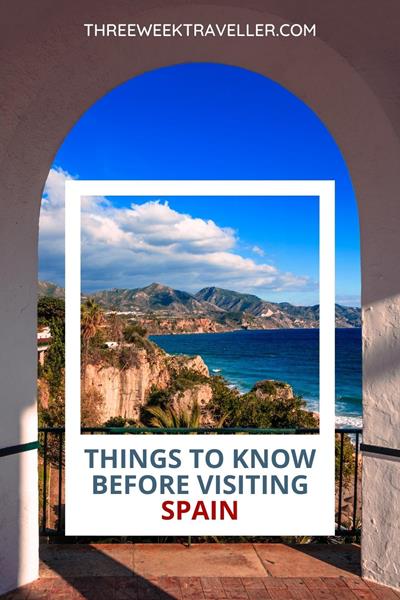
Are you sure you want to delete this route?
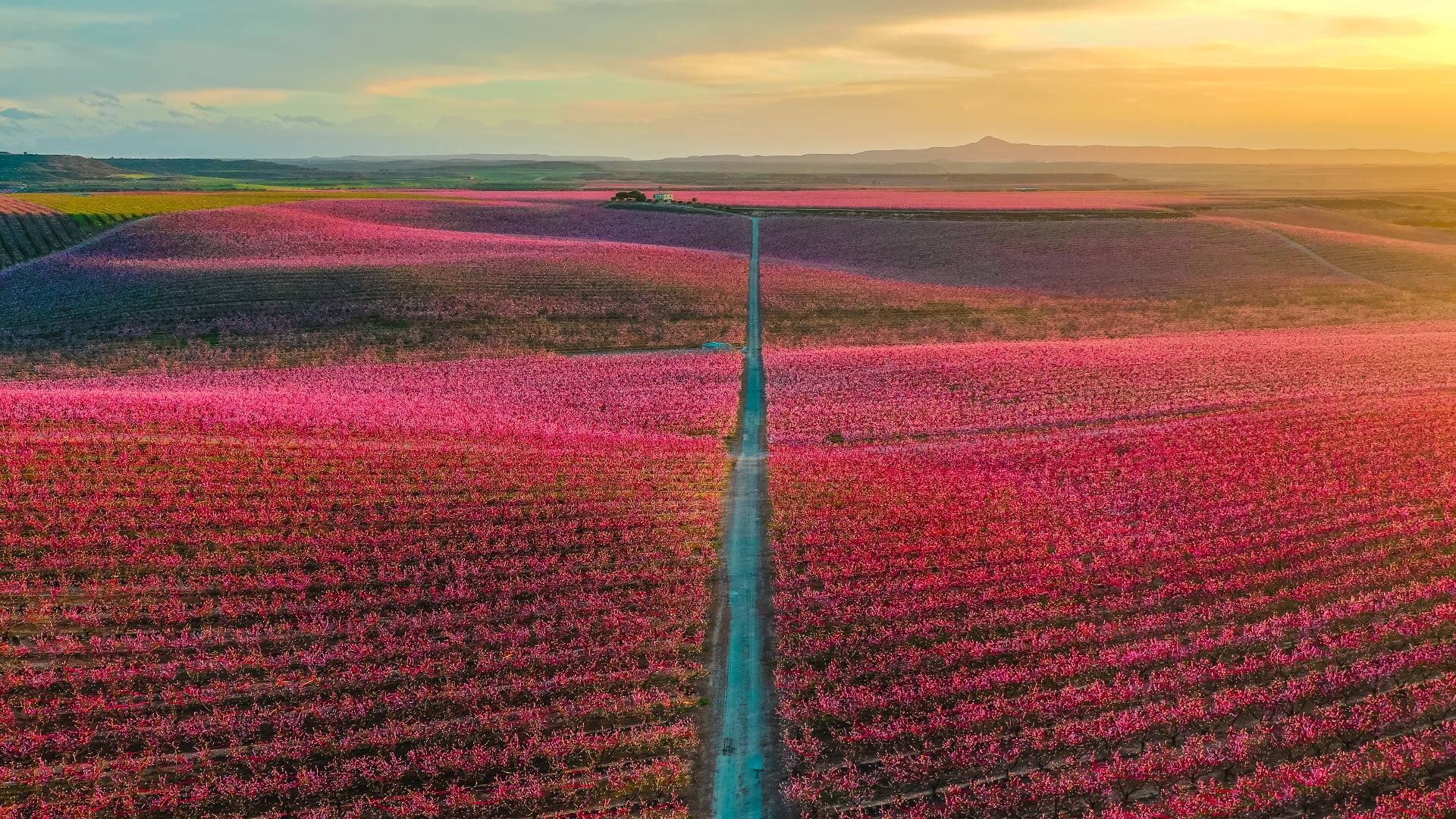
Route planner
Create your own plan for your trip to Spain with a route to suit your requirements
How to get around in Spain by train, plane, bus or boat
Jun 26, 2023 • 5 min read
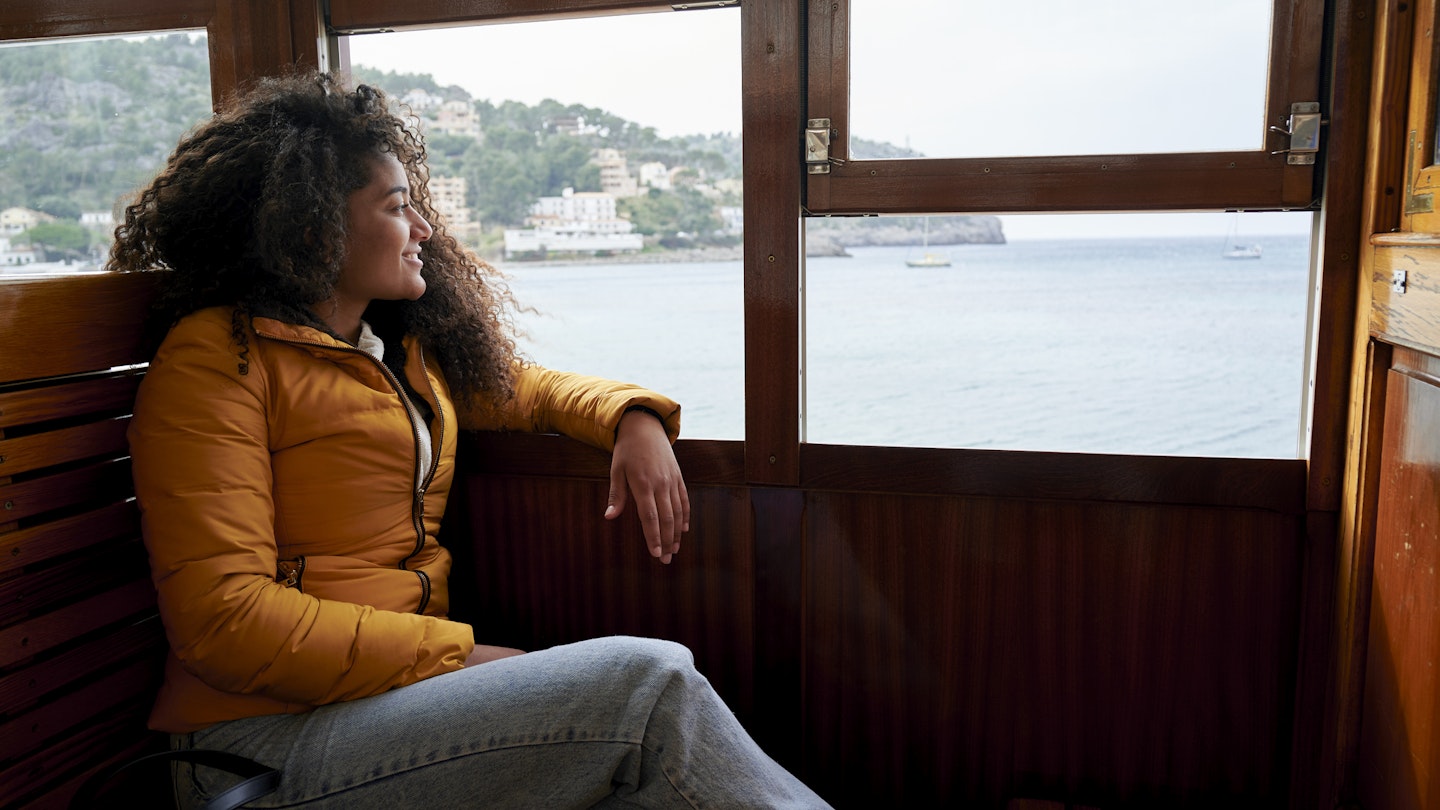
The train is a quick and efficient way to travel around in Spain © F.J. Jimenez / Getty Images
Criss-crossing destinations around Spain , whether by land, air or sea, is easy and convenient due to Spain’s efficient multi-modal public transport infrastructure, which has also been upgraded significantly over recent years.
Spain also gets high marks for universally accessible travel . Visitors with reduced mobility can move around fairly easily compared to other European countries. The country’s public transport infrastructure, such as trains, buses and terminals, has been designed for accessibility, offering specially designated spaces and adapted features for people with disabilities and anyone with mobility challenges, young and old alike.

Get around with ease on Spain's train network
RENFE is Spain’s national railway company that runs about 5000 trains each day across the country. The best and fastest way to travel long distances in Spain is by taking the AVE (Alta Velocidad Española) , which uses Madrid as its principal terminal and travels to many of the country’s principal cities.
AVE trains are comfortable, efficient and incredibly fast. Traveling up to 310km (192.6 miles) per hour, it connects Madrid to Barcelona — over 600 kilometers away — in a mere 2.5 hours.
The RENFE Alvia trains, which connect the northern cities and regions to Madrid, are also high-speed trains with stops along the way. The RENFE Avant mid-distance high-speed trains or the Media Distancia (mid-distance) trains are the most time-savvy option for nearer day-trip destinations.
The most recent addition to RENFE’s fleet are the high-speed, low-cost Avlo trains with tickets. This is the best option for passengers with reduced mobility — all entrances to their carriages are at platform level and feature H seats for travelers in wheelchairs, as well as adapted toilets for people with disabilities.
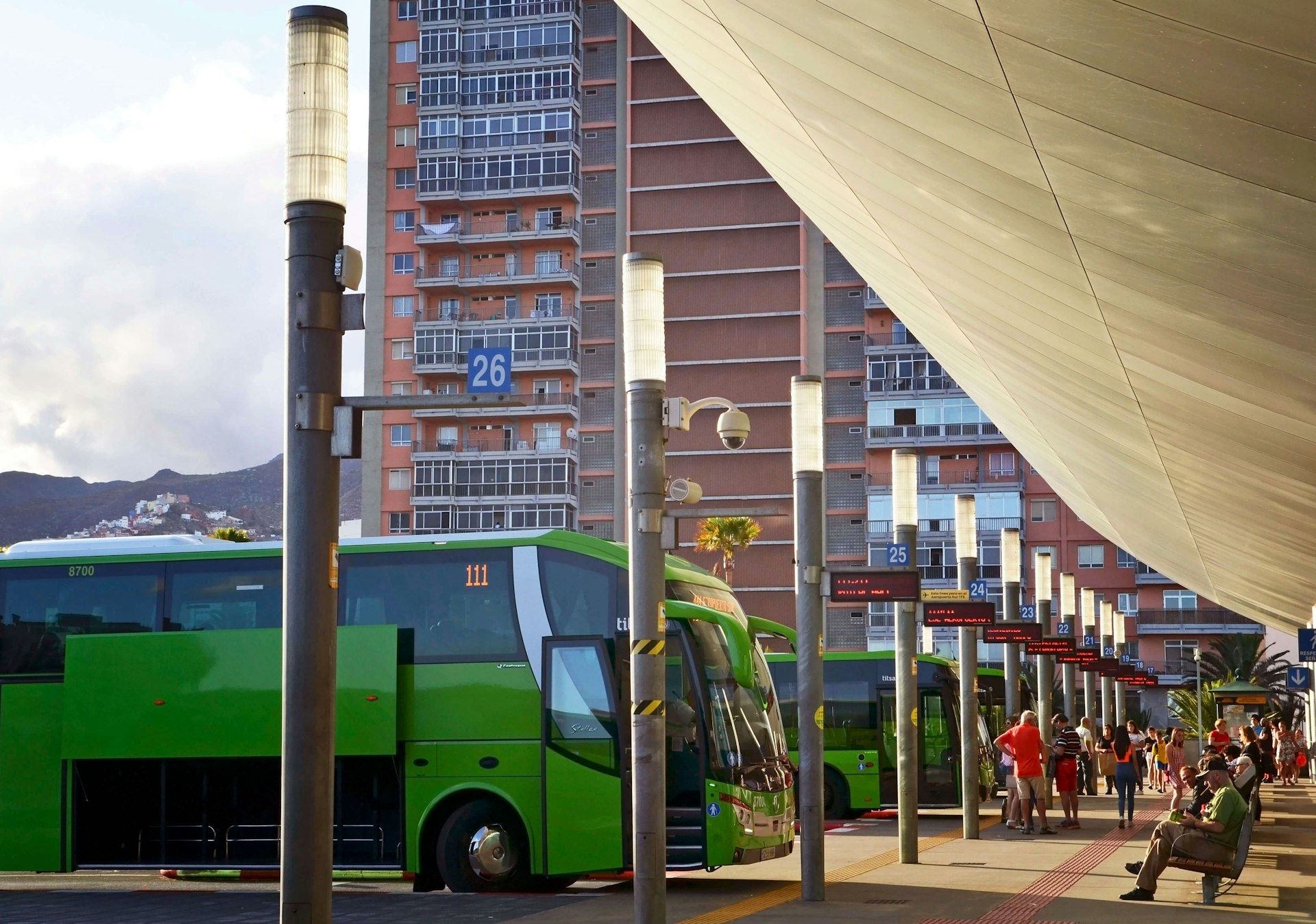
The bus is the best if you're on a budget
For budget-conscious travelers, the bus is the best way to move around Spain if you don’t mind the longer travel times. It’s also the preferred way for locals to get around, given its convenience, economical ticket prices and connections to smaller towns where trains do not pass.
There are several bus service providers in every Spanish city, and many of these fleets offer quite a comfortable ride with reclining seats and wifi on board to make traveling over long distances a smooth and pleasant experience.
While tickets can be directly purchased from the bus driver, it is best to reserve and buy them in advance. Keep in mind that the most popular routes and times tend to get full pretty quickly.
Tip for finding a bus service To find out which bus services are in operation at your departure point, Movelia.es provides the most comprehensive information on available national bus routes (and even international ones), schedules and purchasing, and has multiple language options.
Planes are best for Spain's outlying islands
Flying is the quickest way to travel around Spain, and the best option to get to its outlying archipelagos — and hotspot tourist destinations, the Balearic Islands east of the peninsula or the Canary Islands in the Atlantic. Spain has regular domestic flights operating across its nearly 60 airports; the principal ones are Madrid’s Adolfo Suárez Madrid-Barajas Airport and Barcelona’s El Prat Airport.
Iberia Airlines is Spain’s national carrier that regularly offers reasonably priced tickets if you book in advance. Its low-cost brand Vueling , which regularly codeshares with Iberia, also offers several domestic daily flight options with affordable fares.

Take the slow route – travel around Spain by boat
Many of Spain’s top cities and islands are also important cruise ports, including Barcelona, Cádiz, Valencia, Ibiza, Palma de Mallorca, and Las Palmas (Canary Islands). If time is not an issue, traveling by boat or ferry across from the Peninsula across the Mediterranean or Atlantic waters is a pleasant, albeit drawn-out, travel experience. This is also the best option if you wish to take your car, motorbike or bicycle on board.
Spain’s main shipping lines, Baleària and Trasmediterránea , offer regular trips from main cities in the peninsula as well as hourly connections in the Balearic Islands (between Ibiza, Mallorca, Formentera and Menorca) and the eight main islands of the Canaries. Passengers have the option to book seats or cabins with beds.
Go green with Spain's carpooling services
Car-sharing services are a popular and environmentally-friendly mode of transport for getting around Spain’s cities or regional towns. BlaBla Car is the most popular service that allows you to book car-share rides to several points around Spain. If you’re in the driver’s seat and seeking some company (or wish to share the gas bill), you can also publish your own rides, pick-up points and prices on the BlaBla Car website.
Not only is this a cost-effective way to travel long distances , but it’s also a great way to meet locals (and practice your Spanish!).
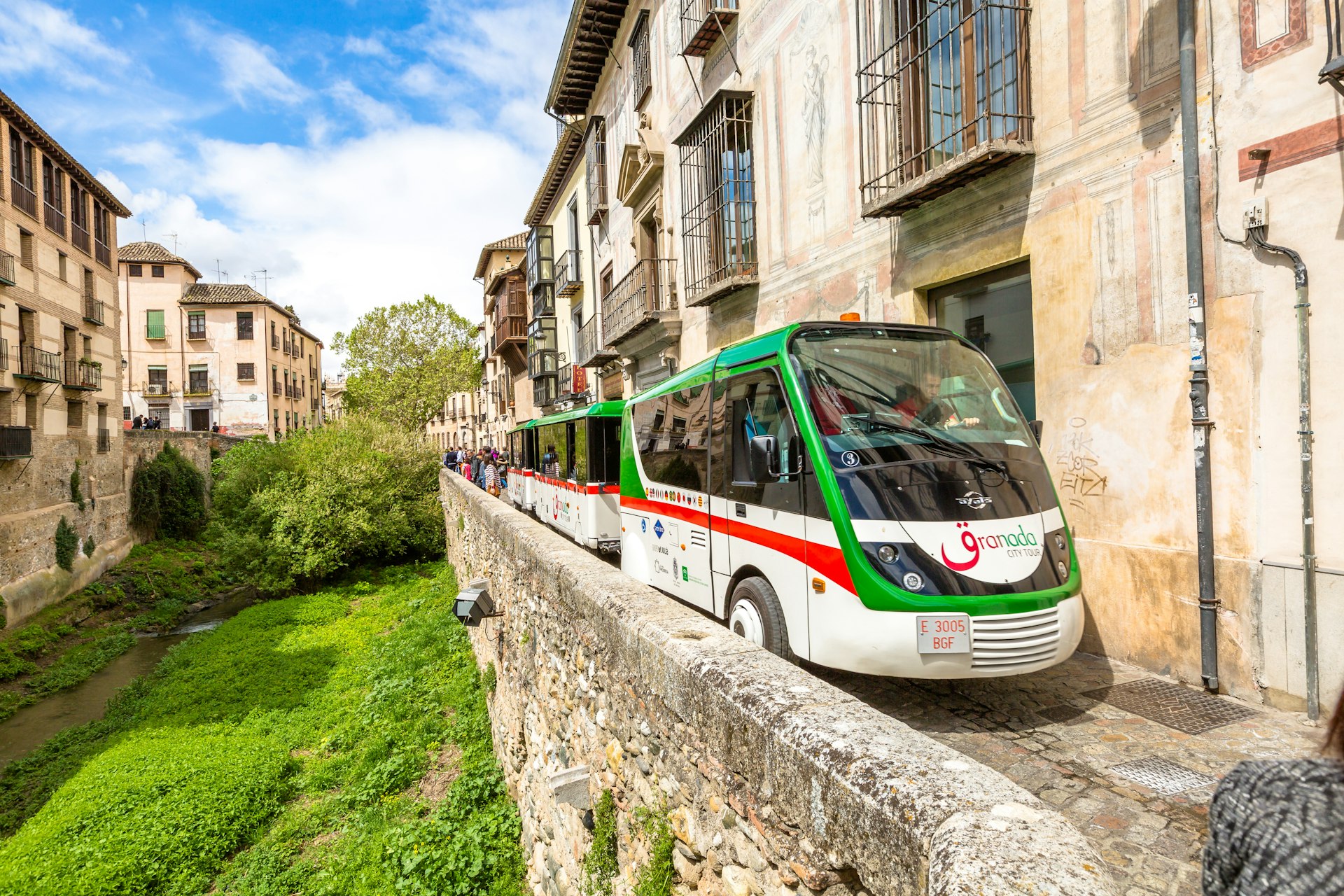
Accessible transport options in Spain
People with reduced mobility will find Spain a highly accessible and inclusive travel destination. All Spanish airports provide passengers with disabilities or reduced mobility free assistance services, from the moment you land to security and border controls and luggage collection. These services can be requested in the AENA (Spain’s state-owned airport operator).
If you are traveling by train, RENFE’s Atendo is a free service that passengers can request assistance in transiting between stations, boarding and disembarking train carriages.
In Spain’s main cities, such as Madrid and Barcelona , terminals and stations are largely designed to give passengers full autonomy. Madrid’s Metro , for example, has installed universal accessibility features in all its stations, with over half of all stations fully accessible with lifts and ramps for wheelchair access. In addition, step edges are reinforced, and elevator signs and handrails have Braille markings.
Barcelona’s entire metro (except for two out of a total of 165 stations) is accessible and has advanced features such as directional devices for blind people and luminous door devices on trains. Local city buses have also been adapted for accessible travel, with tilts, ramps, and reserved spaces for wheelchair users and baby carriages, as well as Braille-embossed stop buttons.
This article was first published Aug 26, 2021 and updated Jun 26, 2023.
Explore related stories

Festivals & Events
May 3, 2024 • 6 min read
Here’s everything you need to know about the tomato-throwing extravaganza that takes place every August in Spain.
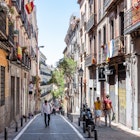
Apr 30, 2024 • 4 min read

Apr 19, 2024 • 10 min read

Apr 3, 2024 • 15 min read

Mar 31, 2024 • 6 min read

Mar 25, 2024 • 6 min read
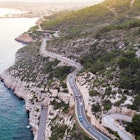
Mar 13, 2024 • 7 min read

Mar 8, 2024 • 17 min read

Mar 2, 2024 • 7 min read

Feb 28, 2024 • 3 min read

Southern Spain Itinerary: 10 Days in Andalucía
Last Updated on November 27, 2023
by Maggie Turansky
Disclaimer: This article contains affiliate links. That means if you click a link and make a purchase, we may make a small commission. As an Amazon Associate we earn from qualifying purchases. For more information, see our privacy policy.

Planning a southern Spain itinerary can seem a bit overwhelming when you consider all of the incredible places to visit in this vast and diverse region. Boasting vibrant cities, sleepy beach towns and everything in between, heading to Andalucía is never a bad idea.
Known for its diverse landscape, fantastic cuisine, historic cities, and laid-back culture, Andalucía is one of the most popular and sought-after regions in the country. As one of the largest autonomous regions in Spain, Andalucía is filled with a complex history and culture unique to the rest of the country.
If you’re wondering what to see when spending 10 days in Southern Spain, then look no further. We have had the pleasure of spending months exploring this incredible region over several years and have gained a wealth of knowledge about travelling there.
Table of Contents
Best Time to Visit Southern Spain
Before we get into the logistics of our itinerary, we need to discuss the best time of year to visit this sunny region.
A good portion of Andalucía is blessed with over 300 days of sunshine per year and, outside of the high Sierra Nevada mountains, the weather will rarely ever get cold enough for it to freeze or snow.
Because of this, Andalucía (and the Costa del Sol in particular) is a popular winter destination for northern Europeans looking to escape the cold, dark weather of their home countries.
However, while the months between November and March are certainly warmer than virtually anywhere else on the continent, nights can still get chilly and you are more likely to have some rainy days.
However, if you plan to visit Andalucía in the summer months, you can expect some of the hottest temperatures in Europe, with some towns repeatedly being subjected to temperatures over 40°C (104°F).
While many hotels, apartments, and tourist sites are air-conditioned and many of the towns are equipped to handle such high temperatures, it can be uncomfortable to visit during the peak summer months.
Arguably the best time to undertake an Andalucía itinerary is in the shoulder seasons of March-May and September-November. It is during these months where the weather is at its best — mild yet warm and sunny — and tourist numbers haven’t reached their peak.

How Many Days in Southern Spain?
Now that we’ve determined which time of year is best to go to Spain, we need to figure out how many days you need for your itinerary for southern Spain.
While it might seem that one region of a country wouldn’t require all that much time to explore, you would be quite wrong to assume this of Andalucía.
The region is vast, encompassing multiple major metropolitan areas and various sub-regions and provinces. Each city, town or village that you will visit in Andalucía will have its own unique character that will beg you to explore more.
However, if you don’t have a lifetime just to devote to exploring one region of one country (like everyone else), plan to set aside at least ten days for your trip.
In ten days, you can see a lot of the region without being too rushed and really get a feel for the culture and history. While you likely won’t have time to visit every city and town of interest in Andalucía, 10 days is enough to give you a very good feel for the region.
If you have a bit longer to spend, then the absolute ideal amount of time to spend in Andalucía would be about 2 weeks. This will allow you to visit all of the major metropolitan areas of the city and get a little bit off the beaten path.

Getting To & Around Andalucía
Spain is home to a number of different international airports and there are lots of options when it comes to your itinerary.
The largest airport in Andalucía is located in Málaga and there are countless connections across Europe and further afield here. Flying into Málaga is a good option for those following the Costa del Sol route below.
There are also airports in Seville and Granada, though they are less trafficked. You can find connections across Europe – particularly into Seville – however, you may find it easier to fly into Madrid and then take the fast train to Seville, depending on where you’re coming from.
Once in Spain, it is also necessary to figure out how to get from one destination to another as you explore the region.
While many people like to hire a car and head out on a Southern Spain road trip itinerary, having your own rental car isn’t entirely necessary. The stops on this route are all easily accessible by bus or train (though booking trains and buses in advance is a good idea!) and each city itself is quite walkable.
If planning on taking a number of trains, a train pass can be incredibly good value. If you’re from outside of Europe, you can view Eurail Spain Passes here . Alternatively, if you’re from the EU, you can view Interrail Spain Passes here.
Where you might find a car more helpful during this Andalusian route is if you want to go on some more off-beat day trips that don’t have frequent or easy connections via public transport.
If you’re thinking of renting a car in Spain, we recommend using Rentalcars.com to find the best rates. It can also be worth taking out a third-party insurance policy with iCarHireInsurance to avoid paying higher fees through the rental car agency.

10-Day Southern Spain Itinerary
Day 1 – seville.
The capital of Andalucía, no itinerary would be complete without a stop in the dynamic and historic city of Seville. One of the most beautiful cities in Spain, Seville has a ton to offer tourists and it is one of the best cities to get to know the unique culture and history of Andalucía.
Seville is the fourth-largest city in Spain and therefore is an easy starting point for a route through southern Spain as it is well connected both because if its international airport and frequent buses and trains from all major Spanish cities.
Due to its size and historical significance, there are also a lot of things to do in Seville that you can easily spend 3 or more full days exploring the city. Plan to spend a couple of days in the city itself, checking out all of the incredible sites.
On your first day, plan to get your bearings – a great way to do this is by going on a free walking tour! Of course, you cannot miss the incredible Seville Cathedral , which takes some time to explore.
Make sure to wander through the gorgeous streets or take a walking tour of Barrio Santa Crus, which was the former Jewish Quarter of Seville. And, finally, end your day by taking in the sunset from the Metropol Parasol – known locally as “Las Setas.”
No visit to Seville is complete without hopping around a few tapas bars and this is an excellent thing to do your first evening in Andalucía!

Where to Stay in Seville
Hotel Bécquer – This centrally located hotel is a great choice if you’re travelling on a mid-range budget but want to be close to all of the action. They have numerous clean, comfortable rooms available and they also have a wonderful rooftop pool and terrace to take the edge off of those warm Seville days.
Monte Triana – Located in the vibrant Triana neighbourhood, this swanky boutique hotel is on of the highest-rated in Seville. Located within a 15-minute walk of all of the top sights of the city and close to some of the best tapas bars in Seville, they have a number of luxurious rooms available.
Onefam Catedral – If you’re travelling solo or have a tight Spain travel budget , this hostel is an excellent choice. It is one of Seville’s highest-rated hostels and it is located within easy walking distance of sites like the Cathedral and the Alcázar. They have a range of dorms and private rooms available and the staff organises social events and activities.
Not quite what you’re looking for? Click here to browse for more hotels in Seville!
Day 2 – Seville
On your second day in the capital of Andalucía, take the time to dig a bit deeper and enjoy some more of the incredible sites that Seville has to offer.
Start your day by exploring the Mercado de Triana on the other side of the Guadalquivir River – this is a great area to wander through on its own, but the market is something special.
And you absolutely cannot miss the Real Alcázar – this takes a few hours to explore and it is so wonderful and worthwhile. The architecture is absolutely stunning, as are the tranquil gardens to be found here.
You also should ensure to visit the iconic Plaza de España, one of Andalucía’s most beautiful town squares.
And end your day with a visit to a flamenco show – Seville is one of the birthplaces of this artform and there are plenty of tablaos where you can experience it!

Day 3 – Ronda
After spending two full days in Seville itself, now it’s time to head out on a day trip. One of the most popular options is to visit Ronda , a beautiful whitewashed village in the hills of Andalucía.
You can reach Ronda via bus (which is the easiest route if going by public transport), via car in about 2 hours or join an organised day trip.
Ronda is known for the incredible Puente Nuevo, a gorgeous and impressive bridge that cascades over the river gorges it sits above. But there is more to this town than the bridge. You can also tour the bullfighting ring, see beautiful churches like the Iglesia de Santa María la Mayor or even visit the old Arab Baths.
Ronda also has plenty of great bars to have a bite to eat in that serve up traditional cuisine from this area. In general, it’s a great day trip option.

Day 4 – Cádiz or Jerez de la Frontera
On your fourth day in Seville, it’s another great opportunity to head out and explore a nearby town. One of my favourites would be the gorgeous coastal city of Cádiz , which is located only about 1.5 hours by train from Seville.
Here, you can visit the beautiful Cádiz Cathedral and experience the find Camera Obscura at the Torre Tavira. There are also some cool, historic castles to take in, like the Castillo de San Sebastian. Cádiz also has its own unique cuisine with some incredible eateries, so this can be a great opportunity to head out on a food tour.
Alternatively, you could also visit the city of Jerez. This is located just a bit north of Cádiz and about 1 hour on the train from Seville.
Jerez is known as the cradle of sherry and is a fantastic place to visit for fans of this fortified wine. When you visit Jerez, make sure to pop into a bodega or two to learn about (and taste) all varieties of Spanish sherry – from fino to amontillado to oloroso. Of course, there are also incredible places to eat in Jerez, so it’s a great place for foodies!

Day 5 – Córdoba
After spending your first four days of this itinerary in Seville, it’s time to head to another historic city in Andalucía: Córdoba.
While many visitors to the south of Spain tend to only treat Córdoba as a day trip from Seville , the city is much better experienced in the two days I have allotted in this route through Andalucía.
Córdoba is located only about 45 minutes by train from Seville, so you can enjoy a relaxed morning without feeling the need to be rushed and get moving.
Once you arrive in Córdoba, spend your first day getting your bearings in the city and wandering through the incredible and beautifully preserved old Jewish Quarter. Of course, if it interests you, you could opt to go on a walking tour (free or paid) to get more historical context here.
At one point, Córdoba was considered to be the most important city in Western Europe and it was the head of one of the most advanced civilizations of its time during the Moorish rule of Spain.
Therefore, there are centuries, if not millennia, worth of history to explore in Córdoba and though it’s historical centre might be small, it is much better enjoyed at a slower pace.
It’s also a great idea to visit the Alcázar de los Reyes Cristianos in Córdoba. Though not as impressive as the one in Seville, it’s still worth taking in and seeing more of the Moorish architecture and learning about the history here.

Where to Stay in Córdoba
Hesperia Córdoba – This comfortable boutique hotel, located on the banks of the Guadalquivir River, is a great place to stay if you are travelling on a mid-range budget. They have a range of modern, clean and comfortable rooms and also include a rooftop pool to take the edge off of a hot Córdoba day.
Puerta de la Luna – This small hostel is a fantastic option for solo and budget travellers alike. They have great common areas, a range of both dorm and private rooms, and even have a rooftop terrace to chill out on.
Not quite what you’re looking for? Click here to browse other hotels in Cordoba!
Day 6 – Córdoba
Córdoba is perhaps most famous for its marvellous Mezquita-Catedral, a massive Moorish mosque-turned-cathedral in the centre of town. The monument is one of the most-visited in Andalucía and is a shining example of the Mudéjar architecture so common throughout this region and country as a whole
The Mezquita is certainly a can’t-miss sight in Córdoba, but it does get very busy which is why I recommend trying to get there as early as possible. That is why it’s ideal to visit the Mezquita on your first full day in Córdoba, rather than the day before when you first arrive.
After taking in the Mezquita, take the time to get lost in the gorgeous streets of Córdoba, visit the Mercado de la Corredera which is located below the plaza of the same name, and enjoy the city’s laid-back tapas culture.
This is also an excellent opportunity to take advantage of some regional cuisine that hails from Córdoba – particularly salmorejo , a cold tomato soup that is similar to gazpacho.

Day 7 – Granada
The penultimate stop on this itinerary is the incredible city of Granada , one of the best places to visit in all of Spain.
Tucked high in the Sierra Nevada, in 1492, Granada was the last city to fall to the Catholic monarchs during the Reconquista. Because of this, Granada’s Islamic roots and history seem somehow more pronounced than in other Spanish cities or cities in Andalucía altogether.
Much like Córdoba, Granada is perhaps most famous for its iconic monument: the Alhambra. The fantastic Moorish palace, summer house, and fortress is a sight to be seen and is one of the best examples of Islamic architecture in the world.
From Córdoba, it will take about 1.5 to 2 hours to reach Granada depending on the route you choose. So you don’t feel too rushed, spend your first day in the city getting the feel for everything and exploring the Albaicín and the historical centre of the city.
Start off in the central area of Granada, first visiting the gorgeous Granada Cathedral and the nearby Monasterio de San Jerónimo. Then, make your way up the hill to the UNESCO-listed Albaicín.
Getting lost in the incredible Albaicín neighbourhood, which was once the city’s Arab quarter, is one of the highlights of visiting Granada. There is something beautiful to explore around every corner. And, if you want an excellent place to see the sunset, head to the Mirador de San Nicolas – it’s popular for a reason!
Spend your evening bouncing between some of Granada’s bars – here you can get a free tapa with a drink order and it’s one of the best experiences to have while in the city!

Where to Stay in Granada
Hotel Rosa D’oro – This hotel, located in the heart of Granada along the tranquil River Darro is an excellent place to base yourself in the city. They are located within easy walking distance of all of Granada’s main attractions, have a range of comfortable rooms available, and breakfast is included in the room rate.
Hotel Los Tilos – Centrally located close to everything Granada has to offer, this hotel is a great place to rest your head in the city. They have numerous rooms available, a rooftop terrace with excellent views of the city and the surrounding mountains, and breakfast is included each morning.
El Granado Hostel – If you’re travelling solo or on a budget, then this hostel is a fantastic accommodation in Granada. Located in the heart of the Albaicín, they have a range of dorm and private rooms available, numerous common areas, and they organise social events each evening.
Not quite what you’re looking for? Click here to browse more Granada hotels!
Day 8 – Granada
On your second day in Granada, it’s time to visit the main attraction – the Alhambra. The Alhambra complex is massive and it will take the better part of half a day to do the area justice, so make sure that you’re aware of that.
It’s also essential to book your visit to the Alhambra well in advance, as it can be booked out early and you may not be able to see some of the areas you wanted without having to join a guided tour.
After visiting the Alhambra, head to one of Granada’s more unique areas – Sacromonte. This traditional Roma neighbourhood is made up of cave dwellings, and it’s a place where some people living alternative lifestyles still live today.
If you want a truly spectacular view, then hike up to the San Miguel Alto Viewpoint, which is a bit of a trek but well worth it.
End your time in Granada by bouncing around various tapas bars again – it really never gets old!

Day 9 – Málaga
The final stop on this Southern Spain itinerary is in the lively coastal city of Málaga . Málaga is a wonderful city to visit and it is a great place to relax by the coast while still taking in some history.
It’s also located only about an hour from Granada and, as home to a high-traffic international airport, a logical place to end this itinerary.
Spend your first day wandering around and getting to know the city. It has a lively, metropolitan vibe that is definitely different from the cities you’ve visited previously.
Make sure to visit the gorgeous Alcazaba which towers over the city and, also, wander around the Roman Theatre that is located directly below.
Of course, you must visit the Picasso Museum while here. This was the birthplace of the famous artist and it’s worth taking in some of the incredible works while visiting the city.

Where to Stay in Málaga
Hotel Sur Málaga – This centrally-located hotel is a wonderful place to stay in Málaga, situated within easy walking distance to all of the best museums and attractions. They have a range of air-conditioned, clean, and comfortable, rooms available and it is the ideal place for couples. There is also breakfast available for an additional charge.
Madeinterranea Suites – This is a great hotel if you’re after a little bit of luxury on your trip to Málaga. There are numerous spacious and comfortable rooms available, a restaurant on site (complete with room service!), and a fantastic breakfast included in the room rate. They also can organise an airport shuttle.
The Lights Hostel – This hostel is one of the highest-rated and a great option for solo travellers or if you’re on a budget in Malaga . They have a range of dorm and private rooms available and a hearty breakfast available at an additional cost. They also organise social events in the evenings.
Not quite what you’re looking for? Click here to browse other hotels in Málaga!
Day 10 – Málaga
Spend your final day exploring more of beautiful Málaga. Begin your day at the massive Mercado de Atarazanas where you can take in a lot of delicious local produce. Then, make your way to the Museo del Vino which, if you don’t understand Spanish, means the Museum of Wine!
You can also take some time to lounge at Playa de Malagueta, the main beach in the city. Or, if you want to explore a cool, hip area with lots of street art, then make sure to wander around the lovely Soho neighbourhood.

Have More Time?
If you have more time in the area, then you can continue exploring past Málaga and visit more of the Costa del Sol. There is a lot more to this area than just Malaga or Marbella and it’s worth taking the time to visit some of the smaller coastal towns.
The town of Estepona is just lovely, as is the nearby beachy city of Marbella . Both are worth visiting if you’re on the Costa del Sol.
Of course, it’s also very popular to go on a day trip to Gibraltar , the British Overseas Territory is easily reached from Málaga and it’s a unique experience to visit!

No matter where you choose to visit on your southern Spain itinerary, you are sure to leave with fond memories of an enriching and historical experience.
Are you planning a trip to Andalucía? Have any questions about this itinerary? Let us know in the comments!

Related Posts:

The Perfect One Day in Pamplona Itinerary

10 Things To Do In Tarragona: A One Day Itinerary

The Perfect 2 to 3 Days in Girona Itinerary

About Maggie Turansky
Maggie is a co-founder and writer for The World Was Here First. Originally from the US, she has lived in five different countries and has travelled to dozens more, both solo and with her partner, Michael. She particularly loves exploring Spain and spending time in the Caucasus and the Baltics. Read more about Maggie
is easy to put together a side trip to Morocco while in the south of Spain ?
Yes, it’s very common for travellers to add on a visit to Morocco when in the far south of Spain 🙂
Hi Maggie This is a great post. I’m planning a trip to this region and would like to visit Seville, Cordoba and Cadiz. I would be flying into and out of Malaga but don’t want to stay as I’ve seen it and Granada on a previous trip. I’m wondering would it be best to get a train or bus from Malaga to Seville and use it as a base to take trips to Cordoba and Cadiz or go from Malaga to Cordoba – Seville- Cadiz- Malaga? Thanks
Seville makes for a good base for exploring both Córdoba and Cádiz but all three cities have enough to do to keep you occupied for more than a day each. So it really depends on how much time you have and if you want to move accommodations a few times during your trip or not. 🙂
This is a wonderful resource and I’m so glad I found it!
I’m in the very early stages of planning a 10 day trip (Sevilla, Cordoba, Granada) with my parents in 2023. I’m thinking a September trip might be a great idea before the end-of-year holiday travel begins.
How early do you think we should start booking travel/lodging? And it’s probably too hard to guess with the ever-changing COVID precautions.
Hi Camille, thanks so much for your comment! I would personally wait until your trip is only a few months out before booking – but hopefully, things are a bit more clear when it comes to planning travel in the future.
We are planning 4.5 weeks in Spain & Portugal next May 2020-flying into Barcelona (but not staying there this timeas we were there last year) and then out of Madrid. We will be hiring a car and our rough plan is to head up the Costa Brava from BCN, then across to San Sebastian (not much time to expolre the Pyrenees unless we cut out other areas?) and along the northern coast (inland or mountains – or a mix?) to Santiago de Compostela, then down through Portugal via Porto, Coimbra to Lisbon and then Algarve region to Andalucia then back up towards Madrid, seeing Toledo, Salamanca and some rural spots inbetween. I know we’ll be moving fairly quickly but we just spent weeks in the balkans with a car and found if we had some 3 night breaks in more popular stops, we were happy with some overnights in between. Would you say this is do-able in the time and any unmissable places to stay a few days on the way, or pass through to check out main sights? I like your destination info and presentation and used it for our Balkans trip too so any feedback would be much appreciated.l I then have a week extra so am thinking I’ll get a Spanish rail pass and base myself in Madrid to do trips out from there or maybe return to an area for 4-5 days R&R after all the driving! Cheers & Merry Xmas ?
Thanks for your comment, Lyndie! Sounds like you’ve got quite a busy trip planned but if you’re hiring a car, I don’t see why it shouldn’t be doable. Unfortunately, we haven’t travelled as much in Catalonia or Northern Spain (yet!) so I can’t be of much help in that regard. Hope you have a great time, though!
Thanks for all your interesting information! It has been useful in the beginning stages of my planning to see how long to stay in each town.
Glad it’s helped, Claudia! Hope you have a great trip 🙂
Leave a Comment Cancel reply

IMAGES
VIDEO
COMMENTS
The best areas to rent a car are for Andalucía's hill towns (Arcos, Ronda, and more, in southern Spain), Camino de Santiago (east-west route in northern Spain), and Cantabria (chunk of north-central coast with beaches, mountains, and prehistoric cave replica), where sparse public transportation limits the efficiency of your sightseeing.
9. Road trip around Mallorca. 5 days, 175 miles. Lazy. 10. The full circle - A complete road trip around Spain. 35 days, 2,800 miles. Challenging. Whether you want a relaxing drive along the coast or drive around the entire country of Spain, here are the 10 amazing options for a Spain road trip to pick from.
Plan your dream road trip through Spain with this epic Spanish road trip itinerary! I'll show you how to spend a perfect 3 weeks in Spain travelling from Barcelona to Seville, plus everything you need to know about renting a car to self drive in Spain.. I was part-way through planning a six-week Eurotrip with my partner when I became fixated on visiting Spain.
Madrid - Segovia - Salamanca - Zamora - León - Valladolid - Penaranda del Duero - Madrid. This fantastic seven to ten day Spain road trip itinerary through the land of frontier castillos and roads that stretch into the distance for miles will take you across the high plateaus and rugged mountains of central Spain.
Northern Spain Road Trip Itinerary. Road Trip Through Tenerife (Canary Islands) Road Trip Through Catalonia (Catalunya) Road Trip Through Central Spain. Driving the Balearic Islands. Road Trip Along Spain's East Mediterranean Coast. Road Trip Across Galicia. Road Trip Around the Basque Country.
2. Andalucía road trip. Best road trip for getting close to Spain's Moorish past. Malaga- Seville; 471km (293 miles), allow 5 days. Southern Andalucía is the only European region that has both Mediterranean and Atlantic coastlines, linked by the Strait of Gibraltar.
Itinerary outline. How to get around. Barcelona. Madrid. Córdoba. Seville. More. One of the fascinating aspects of Spain is how each of its regions can truly feel completely different. Regions like Galicia, Basque Country, and Catalonia even have their own unique identities and languages.
The Ultimate Spain Road Trip Itineraries: Routes, Sights, Guides, Maps And More. Last Updated: January 2, 2024. From San Sebastian's world-famous food scene and the attractions of Barcelona, to the incredible museums of Madrid, history of Granada and beaches on the Costa del Sol, this Spain road trip has it all!
This 14-day tour takes you through the best Spain has to offer. Days 1-3: Admire Modernista marvels in Barcelona. So many Spanish trails begin in Barcelona, Spain's second-biggest city and one of the coolest places on earth. You'll need at least three days to explore the main attractions here, including nightlife and restaurants.
Views over Zaragoza's skyline, a good starting point for a Northern Spain road trip. 📍 Google Maps Route | 🛣️ End-to-End Length: 611 miles (11 hours driving) | 🗺️ Highlights: Zaragoza, Donostia-San Sebastian, Bilbao, Santander, Gijon, Lugo, Santiago de Compostela . The Northern Spain road trip is a long route that covers 600 miles through seven cities.
Spain Road Trip Itinerary. Day 1: Fly from London to Malaga and pick up rental car. Day 2 - 4: Malaga and some gems of Andalucia. Day 5: Drive to Valencia via Granada. Day 6 - 7: Explore Valencia and get bruised by tomatoes in Bunol and coloured by red wine in Valencia. Day 8: Drive to Figueres.
Best Spanish Road Trips in the Mainland Costa Brava. By Naomi from Probe Around the Globe. Route: Circular road trip from Barcelona. Days: 3. Escape Barcelona and go for a slower-paced life with one of the most scenic drives in Spain! A road trip around Spain's Costa Brava region is perfect for discovering sandy beaches, a rugged coastline, great food, culture, and history!
Day 4: Head south to Seville. Sunshine, sour orange trees, flamenco, and some of the most fascinating architecture in Europe await in the next part of this Spain itinerary: welcome to Andalucia. This is one of our favorite regions in Spain, and it always seems to keep drawing us back. READ NEXT.
A comprehensive budget travel guide to Spain with tips and advice on things to do, costs, ways to save, accommodation, and more. ... and finding your way through the actual labyrinth that is the city's ... (500 miles), you need around a month to complete the entire route. The mostly flat Camino is best done in May¬-June or September ...
Day 5: Granada. Next on our itinerary is a short stop in another Andalusian gem, Granada. Though you could spend several days discovering all the sights of Granada, there's really only enough time on this trip for a single day here. Start your day in the city center at Granada Cathedral.
Driving in Spain: Things to Know. The Best Road Trip Routes in Spain. Galicia. Cantabria & Asturias. Basque Country. Catalonia. Barcelona to Madrid. Mediterranean Coast: Catalonia to Andalusia. Ruta de la Plata: Northern to Southern Spain.
Southern Spain Road Trip: Stop 1 - Madrid. Kick off your trip in Spain's amazing capital city. Madrid is somewhere I often think is underrated as it gets pigeon-holed as the business hub of the country. However, it has a lot of charm and some incredible places to visit too.
The south of Spain is all about Andalusia, with classic cities such as Seville, Granada, Cordoba, Jerez and Cordoba to visit. Eat classic tapas, drink sherry and explore Spain's centuries-long relationship with Islam at the Mezquita in Cordoba or the Alhambra in Granada. Plus there's also the beaches of the Costa del Sol .
Spain Itinerary - 14 Days. This road trip would be a beast. As planned above with the scheduled day trips you'd cover around 2600 kilometres. The driving time would be around 27 hours and 30 minutes - but of course, this varies by traffic and which day trips/stop days (beach days) you opt to take, etc.
Average cost of 20 days in Spain. Plan to spend around $2,000 for a 3-week trip in Spain if you prefer to stay in a mid-range hotel and eat often. Accommodation costs you the most during your trip, around $40-$60 a night for a decent double room. Eating out in a m id-range restaurant will be about $7 to $12 per meal.
Create your own plan for your trip to Spain with a route to suit your requirements. ... With our digital brochures and guides, you will be able to discover the best of our cuisine, culture and fiestas. The weather. Check the average temperatures and the hours of sunshine in different areas and the clothing you should wear according to the season.
The best and fastest way to travel long distances in Spain is by taking the AVE (Alta Velocidad Española), which uses Madrid as its principal terminal and travels to many of the country's principal cities. AVE trains are comfortable, efficient and incredibly fast. Traveling up to 310km (192.6 miles) per hour, it connects Madrid to Barcelona ...
Day 1 - Seville. The capital of Andalucía, no itinerary would be complete without a stop in the dynamic and historic city of Seville. One of the most beautiful cities in Spain, Seville has a ton to offer tourists and it is one of the best cities to get to know the unique culture and history of Andalucía. Seville is the fourth-largest city ...